An Approaching Storm - Colored Pencil Drawing
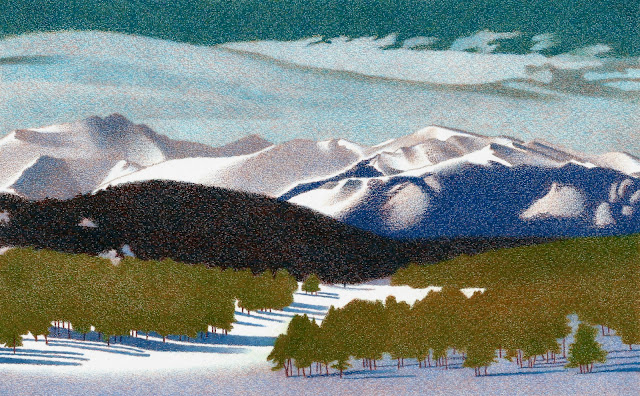 "An Approaching Storm" Colored Pencil
"An Approaching Storm" Colored PencilIn the midst of an already grievous winter, an approaching storm gradually extinguishes the landscape’s last sliver of light. The inclement weather rushes in aggressively as it envelopes the magnificent range of rugged peaks.
Extending across the page, a strip of turquoise sky is still visible above the embattled scenery. It won’t be long, though, before a cloak of cool-gray smothers the valley in a shroud of deep snow.
The high mountains assume a defiant posture as their sharp edges tear through the soft atmosphere, creating patches of bare rock. The kaleidoscope of broken terrain sparkles in blue-violet before the impending storm’s onset.
The forested foothills are distinguished by three different, overlapping tiers of conifers. As the woodland ramparts recede into the distance, the wintery colors gradually become several shades bluer.
The wide, white meadow sweeps across the foreground, its smooth surface decorated with elongated shadows. The same purple found in the snowy summits is carried down below into the very bottom of the composition.
The naturalistic drawing features muted colors laid down with a heavy hand in order to express the austere beauty displayed before a big storm. Even during the worst weather, the hidden blue sky is still there, waiting to be revealed.
If you can summon the strength to allow for patience, faith and fortitude, light eventually overcomes the darkness. Once the clouds disperse, the sun’s comforting rays warm the earth and that lost, blue sky is finally found.
Touch the Clouds - Colored Pencil Drawing
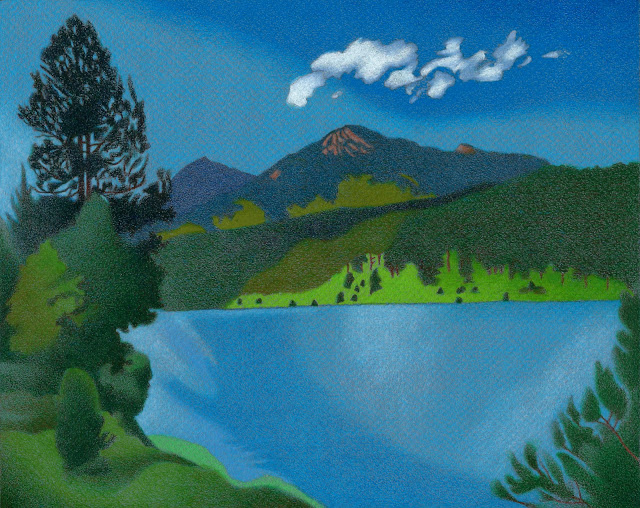 "Touch the Clouds" Colored Pencil
"Touch the Clouds" Colored PencilAn arching vault of powder-blue sky is reflected below on the surface of Evergreen Lake. The behemoth mountain known as Bergen Peak towers above, straining with all its might to touch the clouds.
The pyramidal-shaped summit pierces the atmosphere but the ambitious endeavor falls far short of the billowy cluster of vapor. Magically linking heaven and earth, the wispy cloud floats overhead as its transient contour traces the shape of the mountain ridge.
The solemn landscape delivers a spiritual message basking in the supernatural glow of divine light. The elements are conjured with mysterious edges that are softened by the vibrations generated from a kaleidoscope of stippled colors.
The lower foothills are arranged in a simple pattern described by descending layers of woven color that cascade down to the water’s edge. Glittering white waves are represented by milky tones that are scrubbed softly across the reservoir’s textured surface.
Superseded by a tall, dark pine, a swath of dense underbrush creates a curving overlook that anchors the lower left corner of the page. Directly opposite, the suggestion of more wilderness is blurred into the foreground, balancing the composition.
A late monsoon has transformed the summer into an unusually wet season. Persistent thunderstorms settle into the area every afternoon relieving the drought-stricken corridor, creating a fertile valley of green and blue.
The cool hues contradict the comfortably warm evenings experienced during this time of year. Although at night when it’s completely quiet, a faint whisper comes sweeping down from the big peaks betraying the cold winter that is preparing to arrive soon.
Dark Self-Portrait - Colored Pencil
 "Dark Self-Portrait" Colored Pencil
"Dark Self-Portrait" Colored PencilComposed in a somber shadow of murkiness, the resulting work is a dark self-portrait. A sliver of illumination creates a streak of highlights that defines the firm structure of an antique face.
The side sunk in deep shadow is described by a limited palette of gold, orange and dark brown. Soft shading is employed to graduate from one tone to another evoking an aura of still calm.
The understated mood and stingy color scheme is inspired by the work of the masters of old. Another experiment in line, form, color and chiaroscuro and less a study in the psychology of the sitter.
Thin, wavy hair tops a high forehead that has been wrinkled by time. Searching intensely for the essential features, black eyes are set into deep sockets below a sharp brow ridge.
A broad nose casts the darkest shadow that blends seamlessly into the ochre cheek. The stern mouth is delineated by reddish lips that dissolve into a prominent jowl.
The pinkish ear is more translucent and anchors the hefty jawline that curves down into a notched chin. The weight of the skull is supported by bulbous neck muscles that converge just above the shirt collar.
Steeped in realism, this picture is still conceived with elements of intentional exaggeration. Not just a portrait, it’s an experiment in light and shade, modeling form and composing analogous colors.
Self-Portrait with Green Background - Colored Pencil Drawing
 "Self-Portrait with Green Background" Colored Pencil
"Self-Portrait with Green Background" Colored PencilA self-portrait more concerned with the possibilities of line and color and less preoccupied with character and psychology. The picture is merely a sheet of textured paper covered by drawn forms that are filled with pencil pigment.
The head’s deep shadow sculpts the rigid structure of the face while an array of golden hues attempts to express a glowing inner-light. The pink nose, ruddy ear and indigo eyes add some allure to the numinous color scheme.
Thick strands of dark hair curl across a high forehead while tufts of muted gray are streaked into the sideburn. Accentuating the intense glare, sharp line work represents the many wrinkles and weathered features.
The biggest gamble is the verdant background that is quilted from a puzzle of interlocking shapes. The various shades of green contrast strongly with the earthen flesh, creating a vibration between the complementaries.
Searching for stability, the intention is not to achieve a photographic likeness or to evoke a specific personality. The purpose is to experiment with color and form while observing the effects that result from placing certain hues side by side.
Portrait of Lukas - Colored Pencil Drawing
 "Portrait of Lukas" Colored Pencil
"Portrait of Lukas" Colored PencilEmerging from a violet void, the Portrait of Lukas is carefully rendered with flecks of unblemished gold. The intentionally soft shading reflects the gentle temperament of an innocent soul.
Invoking interest in this idyllic representation of adolescence is the tension created by contrasting the precise modeling of the face with the flattened grid pattern defining the much simplified shirt.
The deep, blue-violet background forms a strong complement with the child’s pale, yellow-orange complexion. The sparkling tones expressing the naive character of someone so full of life.
Influenced by his avocations, the heavy-handed line work, disentangled hair and detailed eyes is Anime inspired. A callow presence during disarray - like a kite in a hurricane or a ray of sunshine during a storm.
Cult of the Sun - Colored Pencil Drawing
 "Cult of the Sun" Colored Pencil
"Cult of the Sun" Colored PencilWarm, autumnal sunshine permeates the interior of Poudre Canyon, illuminating a kaleidoscope of dazzling colors. The splendid scene is set ablaze with an array of fiery tones that are barely balanced by the rolling, blue river.
Sturdy stands of yellow cottonwood brace both sides of the composition as patches of gray-green define their leafy profile. A line of bushes arcs into the middle ground, graduating in size, shape and color where its termination is reflected on the creek’s surface.
The rugged shallows are littered with polished stones of slate and orange while some of the bigger boulders, protruding from the deeper channel, create whitewater waves. Across the way, a pile of rubble cascades down to the far shoreline.
The steep slope is covered by an astonishing blanket of interwoven flecks of pure color that are blended by the observer’s eye. Clinging to this incredible hillside tapestry are scattered clusters of burning brush and rocky outcrops.
Set upon the crest of this high ridge is a naturally carved temple complex of sculpted columns, turrets, spires and pinnacles. The broad face of the main edifice is bleached by bright sunshine creating rigid, violet shadows.
This monumental landscape, gouged into the mountains, evokes a certain enchantment that inspires the visitor to search for more. The sense of wonder and amazement is overwhelming to the point of spiritualism.
For thousands of years the comforting, cyclical predictability of day, night, seasons and years has cast a spell over impressionable human beings. Some ancient religions were based on such ideology but many of their beliefs have been lost over time.
The Cult of the Sun would have faithfully worshiped this ethereal kingdom that is so saturated in divine purity. This unassuming bend in the gorge is eternally blessed to be flooded by two of the most powerful, life-giving forces on earth - sunlight and water.
The Great Blue - Colored Pencil Drawing
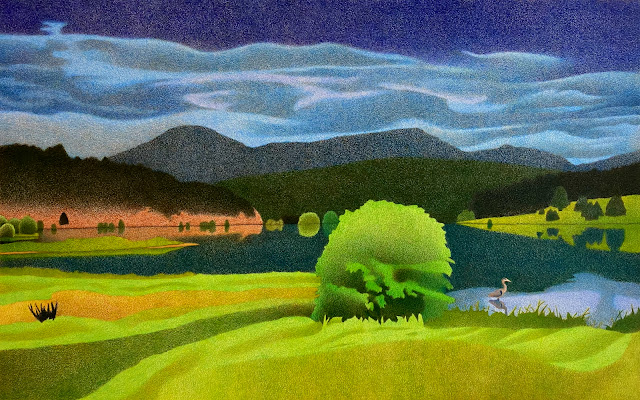 "The Great Blue" Colored Pencil
"The Great Blue" Colored PencilIt’s late summer in the foothills and a great blue heron is hunting quietly along the shoreline of Evergreen Lake. The chaos generated by the passing storm from just minutes ago has receded and a peaceful calm has overtaken the watery habitat.
The bird’s image is mirrored on the surface of the smooth reservoir just as the undulating landscape is a reflection of the billowy sky overhead. Above, a churning wave of bulbous clouds streams across the troubled firmament while below, a sea of tussled grasses rushes into the lower marshland.
The meadow, lake, mountains, forest and sky are described similarly so as to unify these elements into a coherent whole. The shared color and soft shading transcends the harsh reality into a more pleasing aesthetic.
The dim light knows no boundary so a certain murkiness pervades the entire atmosphere, narrowing the range of hue and contrast. The somber palette is relieved by a few flecks and passages of pure orange, creating subtle vibrations of complementary color.
Layers of pigment create a stippled texture that covers the entire surface from top to bottom. Tiny hints of the pale surface buried underneath still show through giving a slight sparkling effect to the finished piece.
The background peaks form a melted skyline that is just beyond the reach of outstretched pine trees. The surrounding woodland’s ragged edge descends all the way down to the lake’s steep banks.
The sweeping folds in the sky are a woven tapestry of embroidered colors based on slate and ochre. Ribbons of grass are matted to the furrowed terrain that radiates throughout the lower foreground.
An isolated bush occupies this frontal space, its dark shadows undercutting the suggestion of lush foliage. Its simplified form is loosely defined by an irregular contour of lost and found edges.
The reservoir’s placid surface is the result of a calm void left in the wake of passing bad weather. Once the turbulence subsides, the local inhabitants re-emerge trading dampened spirits for a more lively resolve.
Even though it’s not warm and sunny, a dreary day sometimes displays a certain beauty not observed under any other circumstances. The falling rain is a connection between heaven and earth where the much needed moisture cleans and nourishes the landscape as well as the soul.
Sandhills Sunset - Order Emerges Out of Chaos
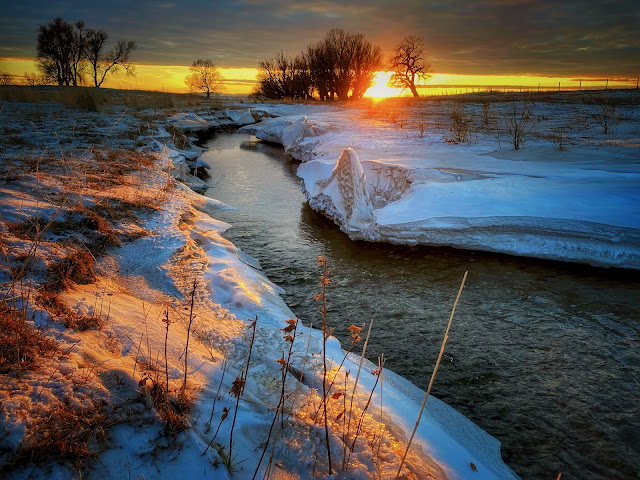 Sandhills sunset
Sandhills sunsetChristmas time on the prairie and the weather conditions are brutal due to heavy snow, high winds and horrific cold. The annual winter trek to western Nebraska has been transformed into an arctic expedition.
After a week of natural destruction, the storm subsides and a breathtaking sunset seals the covenant. A cautious trudge along the frigid creek reveals the stark aftermath of such a powerful system.
The tortured landscape is a curious blend of harshness and beauty created by the unique forces from above. The low light creeping through the forest enhances the surreal atmosphere of peace and quiet.
The charcoal-colored trees form haunting silhouettes that frame the deep perspective generated by the rolling Sandhills. Spanned by delicately arched snow-bridges, the crooked waterway recedes into the distance.
The sharp stream-bank is steepened by deep drifts that slide dangerously into the frigid water. Bergs of strange shaped ice are strewn all over accenting a frozen landscape reminiscent of the far north.
Up on the hill, a lonely homestead appears out of the fading light like a ghostly apparition. It’s the only sign of civilization during this epic moment in nature when order miraculously emerges out of chaos.
In sharp contrast to the drama displayed by a solemn countryside, the inflamed sky is infused with fiery colors. The warm tones stretch across the horizon offering comfort and relief from the difficulties of the past few days.
The tumultuous storm proved to be fleeting and in its wake unveiled a bright new day. In the same fashion the past twelve months of ups and downs have concluded opening the way for a blessed new year.
 A breathtaking sunset
A breathtaking sunset Haunting Silhouettes
Haunting Silhouettes A solemn landscape
A solemn landscape The waterway recedes
The waterway recedes A lonely homestead
A lonely homestead A stark aftermath
A stark aftermath A tortured landscape
A tortured landscape A blend of harshness and beauty
A blend of harshness and beauty A happy new year
A happy new yearLake Marie - An Arena of Beauty
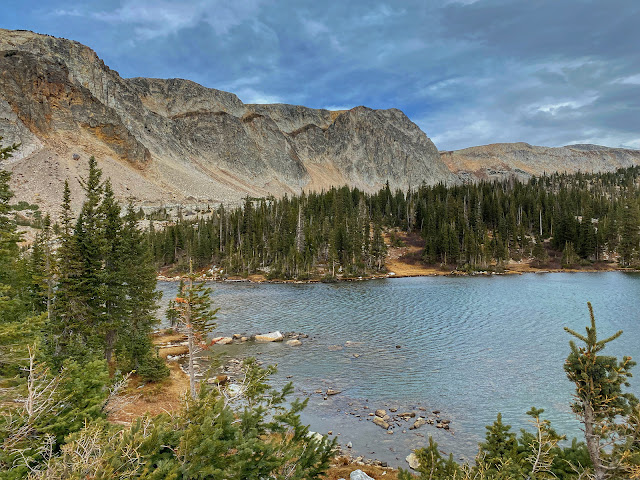 Lake Marie, Wyoming
Lake Marie, WyomingLying north of the border in the state of Wyoming, a graceful wilderness area is known as Medicine Bow. Lake Marie is the elegant centerpiece of this picturesque arrangement of rugged peaks.
It’s late autumn and this normally snowy range is illuminated by an impressionistic palette of purple and orange. The high altitude reservoir of rippling water is sparkling blue on this wind-blown morning.
Draining out of the tarn, a foamy stream cascades over a steep precipice and flows through a constricted gorge. The lower landscape is blanketed by fuzzy patches of dark forest.
The airy realm above is a rocky kingdom composed of sheer cliff-walls that form an imposing backdrop. A steep pathway ascends to the spiny crest where the panoramic views of the tundra are expansive.
During this mild interlude between the seasons, activity comes to a halt and a certain calm pervades the environment. The incredibly quiet ambiance only reinforces the sensations experienced when confronted with extreme remoteness.
Farther up on the flats there’s a stone tower overlooking the intimidating atmosphere where feelings of vulnerability and insignificance are intensified. The final, high pass is a spectacular arena of beauty showcasing raw nature at its finest.
 An elegant centerpiece
An elegant centerpiece Late autumn
Late autumn Sheer cliff-walls
Sheer cliff-walls A picturesque arrangement of peaks
A picturesque arrangement of peaks Rippling water
Rippling water A foamy stream
A foamy stream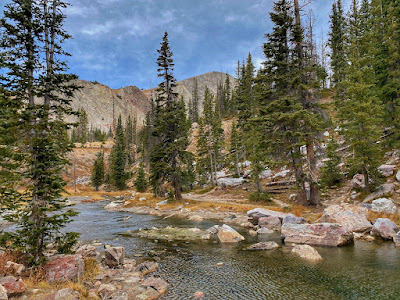 Extreme remoteness
Extreme remoteness Medicine Bow Wilderness
Medicine Bow Wilderness A constricted gorge
A constricted gorge The tundra is expansive
The tundra is expansive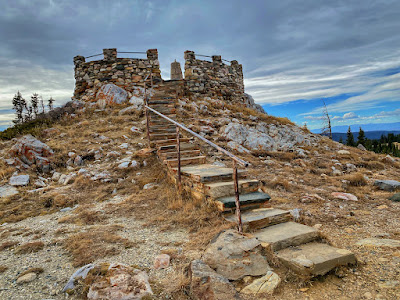 Stone Tower Overlook
Stone Tower OverlookPoudre Canyon - An Awesome Realm
 Poudre Canyon
Poudre CanyonGashed into the northern Front Range Foothills, Poudre Canyon is a steep drainage that’s as picturesque as it is rugged. A braid of blue water snakes through the tortuous chasm while flowing down to the lowlands.
At its most shallow in the autumn, the Poudre River reveals the multitude of rocks and debris normally submerged below the surface. The lazy current and quiet solitude evoke a peaceful atmosphere of extreme tranquility.
Sinewy cottonwoods fringe the banks and the golden foliage, flickering in the morning sunlight, is even more brilliant when set against the cobalt sky. The trees cast transparent shadows that sneak passively across the coarse terrain.
The gorge is boxed in by steep walls that have been eroded into a spectacular arrangement of jagged peaks, pinnacles and spires. Peering up from within the ravine, the ridge line is described by an impressive, sawtooth profile.
A lonely road contours the winding refuge as it gradually ascends the narrow pass to its wind-blown summit. From here the scenery suddenly changes and a wide vista opens up to a treeless plateau.
Down the backside is a big meadow known as North Park where high mountains ring the expansive grassland. Full of birds and wildlife, the wetland valley is the perfect culmination to a long day navigating the trail.
The countryside’s warm colors reflect the pleasant climate of late summer while postponing the advancing gray. It won’t be long before winter descends on this northern environment and heavy snows make entry into this awesome realm virtually impossible.
 A pleasant climate
A pleasant climate A picturesque drainage
A picturesque drainage Quiet solitude
Quiet solitude Transparent shadows
Transparent shadows A multitude of rocks and debris
A multitude of rocks and debris A torturous chasm
A torturous chasm Shallow in the autumn
Shallow in the autumn An awesome realm
An awesome realm Jagged peaks, pinnacles and spires
Jagged peaks, pinnacles and spires A lazy current
A lazy current A wind-blown summit
A wind-blown summitPrairie Solstice - Colored Pencil Drawing
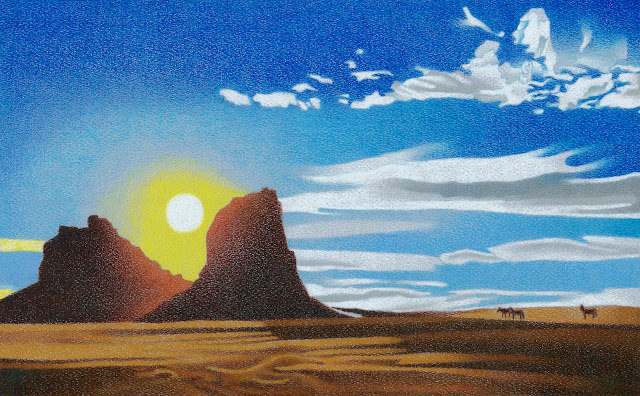 "Prairie Solstice" Colored Pencil
"Prairie Solstice" Colored PencilRising starkly above a sea of dried prairie grass, a pair of megalithic landmarks are backlit by the setting sun. It’s the first day of summer so on this special day the solar disk splits the giant rocks, flooding the atmosphere with yellow light.
A long, dark shadow is unfurled across the undulating terrain, reinforcing the permanence of the mysterious landscape. Grazing peacefully, a few horses are the only creatures to bear witness to the incredible ambience associated with this yearly event.
Citron luminescence radiates into the sky creating a gradient of color that extends from teal to blue-violet. Modulated by soft shading and broken edges, a web of silky clouds is spun across the crystal-clear firmament.
It’s an idyllic vision of a peaceful pastureland set in a remote section of the Great Plains. The reticent countryside of rolling hills is a place where the awesome power of nature is unmasked every day.
The landscape, weather and wildlife that define this place are sometimes still exhibited in a primitive state. The untouched and untainted innocence of the spacious wilderness inspires a creative imagination.
The striking contrast between the characteristics of each season results in a calendar of yearly events that is engraved in the mind. One of the most anticipated is the comforting, predictable return of light and warmth guaranteed by the annual summer solstice.
Days of Glory - Colored Pencil Drawing
 "Days of Glory" Colored Pencil Drawing
"Days of Glory" Colored Pencil DrawingIt’s the early 1900s and Bridgeport, Nebraska is a fledgling community basking in the sunshine of its glory days. The town is known as “Trail City, USA” because it sits on or near many trails of the Old West including the Oregon, California, Mormon, Pony Express and Sidney-Black Hills trails.
Back in 1876, Henry T. Clarke built a bridge across the North Platte River just three miles upstream from the current site of Bridgeport. This overpass improved the link between Sidney and the booming, gold-mining settlements in the Black Hills.
The exchange of goods and precious metals between the two regions flourished for about a decade. During that time a loose-knit medley of early settlers established Camp Clarke, a small village located near the river.
The actual town of Bridgeport was officially founded as a railway station by the Burlington Railroad in 1900. After the coming of the trains, the population increased dramatically and in 1908 Bridgeport was promptly awarded the seat for newly created Morrill County.
Later, an ingeniously designed irrigation system brought a surplus of life-giving water to the thirsty plains. There is no doubt that this labyrinth of water works contributed greatly to the success and growth of the local farms and ranches.
This preparatory drawing commemorates those early years during the development of the city. The image will be scaled up and reproduced as a sign to be installed on the side of an old train car at the Pioneer Trails Museum in Bridgeport, Nebraska.
This design is not meant to be a precise, photographic reproduction of that time but more an expression of the excitement evoked by the modernization of the American frontier and reflected by the futurist art movement. It celebrates dynamic movement, color and composition.
The underlying structure is based on multiple perspectives that offer unusual, but more interesting viewpoints not observable under normal conditions. The color, though naturalistic, is amped up a bit and the composition is flooded with diagonals.
A modern marvel of gleaming silver, the stylized, steam locomotive charges into the foreground guided by tracks of timber and iron. The station stop, composed of crimson-roofed adobe outbuildings, is matter-of-factly identified as Bridgeport.
Exhaust from the smokestack streams through the air towards the iconic water tower and fades into the atmosphere where clouds drift over the purple Sandhills. The bright red lettering is hand-drawn and charmingly compliments the golden border that encloses the scene.
The town of Bridgeport has continued to evolve into a thriving, prosperous community but in a lot of ways it has remained the same. Just as it did over a 100 years ago, the economy still depends on agriculture, government and the railroad.
Despite all of the technological advancements, many residents still embrace the town’s rich history. Most people agree that no matter what happens in the future, there will never be a time so illustrious as those original days of glory.
 Installed on the side of a train car
Installed on the side of a train carAgate Fossil Beds - A Land That Time Forgot
 Agate Fossil Beds
Agate Fossil BedsUnearthed in the panhandle that is western Nebraska, the Agate Fossil Beds are a fascinating monument documenting ancient history. From the associated museum, a steep, 3-mile trail leads up to Fossil Hills where the old dig site can still be seen.
At the end of the dinosaurs, 65 million years ago, this area was a tropical lowland and mammals began to emerge. Volcanic activity was intense and a range of mountains started to form in the west while the climate became cooler and drier, transforming the region into a great savanna where immense herds of animals grazed on lush grasses.
Common species on the prairie were Palaeocastor - a dry land beaver, Moropus - a distant relative of the horse, Menoceras - a three-foot-tall rhino and Stenomylus - a tiny gazelle-camel. Carnivores evolved to prey on these plains-dwellers the most notorious of which were Daphoenodon - a fearsome beardog and Dinohyus - a terrible hog endowed with bone-crushing teeth enabling it to scavenge the remains of other grassland animals.
Millions of years later and the mature Rocky Mountains were a barrier blocking moist air from reaching the broad plains. It wasn’t long before the high steppe became distressingly arid, causing vegetation to wither and water sources to evaporate.
About 20 million years ago a severe drought ravaged the vicinity and thousands of creatures, gathered around the pitiful water holes, perished from starvation. The countless skeletal remains produced bone beds that were soon buried in a mixture of silt, sand, ash and water.
By the 1880s wind erosion had begun to reveal the carnage and rancher James Cook discovered a few petrified bones protruding conspicuously from the earth on his property. Academics were notified and the site became a sensational paleontological discovery.
Thousands upon thousands of fossils were retrieved, catalogued, studied and pieced together, enlightening scientists with a plethora of valuable information about the Miocene Epoch. The field work is presently discontinued so visitors with the fortitude to make the hike up the hill have virtually unlimited access to the remarkable bone beds.
The trek begins by crossing a skinny ribbon of blue water known as the Niobrara and ascends the treeless slopes to the summit. It’s super hot in the summer but it’s worth the effort because the valley view from the top is distinguished by unsurpassed beauty.
The literal sea of grass is broken by coulees, ravines, draws and eroded cliffs that resemble pinnacles, spires and turrets. It’s not long before the extreme isolation and expanse of awesome landscape begin to instill feelings of precarious vulnerability. It truly is a land that time forgot.
 Fossil Hills
Fossil Hills Niobrara River
Niobrara River A vast grassland
A vast grassland Hiking to the summit
Hiking to the summit Agate Fossil Bone Bed
Agate Fossil Bone Bed A sensational discovery
A sensational discovery A sea of grass
A sea of grass Thousands of fossils were retrieved
Thousands of fossils were retrieved Erosion revealed the bones
Erosion revealed the bones Unsurpassed beauty
Unsurpassed beauty Land that time forgot
Land that time forgotSan Antonio Riverwalk - A Historic Oasis
 San Antonio Riverwalk
San Antonio RiverwalkSummer in south Texas is sweltering but if your looking for respite from the brutal heat, the Riverwalk in San Antonio is a historic oasis. The vibrant town center is a melting pot of diverse history, culture and cuisine.
Man-made canals branch off from the main stream creating a labyrinth of narrow passageways that circulate through the district. Picturesque bridges built in creative shapes and sizes span the water at convenient intervals.
Situated below street level, the tributary flows past shops, restaurants and galleries, offering something for everyone. Statues stand above gardens of exotic flora, filling alcoves that appear at every bend.
Steamy mornings on the path are bathed in hazy light and the creek, reflecting the surrounding foliage, is colored green. As the day warms up, the search for shade begins so the buildings’ shadows become comfortable breezeways.
The architecture encompassing the area is a curious blend of old and new as glittering superstructures are interspersed with antique churches and cabins. The most fascinating of these being the Alamo, an undisputed icon of the American frontier.
The somber evenings gradually get more lively after dark when revelers party well into the night. Even at this late hour, a trail of ambient lighting leads the weary tourists through alleyways back to their rooms.
The arduous journey through some of the most remote territory in the United States was worth the effort in order to reach such a unique destination. The activities and excursions enjoyed during a visit to the Lone Star Republic will always be remembered.
 A historic oasis
A historic oasis Statue of San Antonio
Statue of San Antonio Morning on the path
Morning on the path Hazy light
Hazy light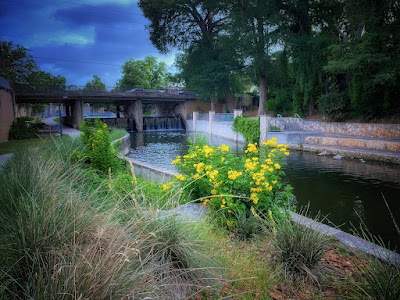 Somber evenings
Somber evenings Small churches
Small churches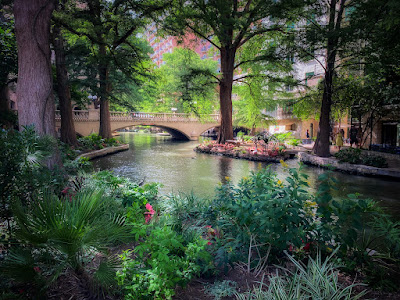 Exotic flora
Exotic flora Modern architecture
Modern architecture Below street level
Below street level Water reflects the green foliage
Water reflects the green foliage Picturesque bridges
Picturesque bridges Texas will always be remembered
Texas will always be rememberedDesert Gateway - Colored Pencil Drawing
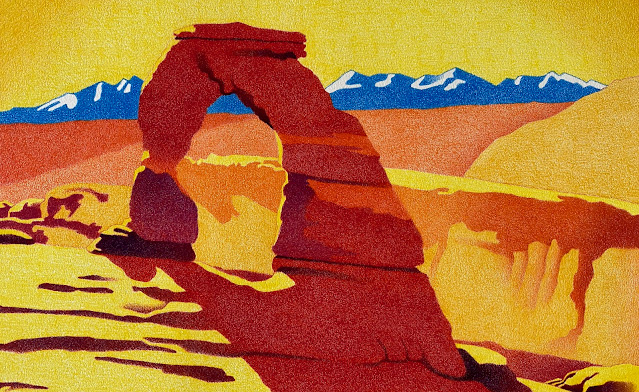 "Desert Gateway" Colored Pencil
"Desert Gateway" Colored PencilOffering sanctuary from the furnace of sweltering heat, a chain of blue mountains streaks across the background of a fiery landscape. The desolate environment is stark, harsh and lonely.
Despite its beauty, the desert is a brutal place that can bring your demise at any moment. Not only is the severe climate and rugged terrain a problem but a sudden snake bite can be deadly.
The wide open space is broken by terraces of escarpment that appear more red as they recede. Applied with precision, smooth gradations mask the rugged nature of this rocky netherworld.
The bleached shelf in the foreground is bathed in a bright yellow made even more vibrant by the violet shadows. Yet, the most shocking aspect is the shimmering sulphur sky that results from a mid-summer sun.
This non-naturalistic expression is not designed to display superficial accuracy. The arid plateau is too straightforward to tether with complicated details so a more symbolic approach is necessary.
Protruding from a broad ridge, an extraordinary portal to the mountains beckons the lost soul to come closer. This desert gateway is delicately chiseled out of crimson-colored sandstone.
A fine example of natural architecture, the maroon doorway allows passage from this plane of existence to the mountainous region in the next. A lofty realm brimming with cool air, clear water and lush gardens awaits.
Summer Snowstorm - A Startling Rebellion
 Summer Snowstorm
Summer SnowstormAfter about a week of warmer weather, summer’s first glimmer was promptly extinguished by winter’s last gasp. The cold front swirled into the area disrupting the local inhabitants’ annual activities.
It was just days before the unofficial start to summer when an intransigent snowstorm pummeled the foothills into a deep freeze. The startling weather rebellion was a dramatic turn of events that shocked the unsuspecting ecosystem.
The sturdy pine trees were cemented with a plaster of heavy, wet snow, bending limbs almost to their breaking point. The greening meadows were buried under immense drifts that swelled like waves in a great, white sea.
Down at the recently thawed lake, the black water contrasted sharply with the frosted marshland. The fresh inkwell captured faithful reflections of the entombed valley’s stark beauty.
Low hanging clouds skimmed across the summits of background peaks creating an imposing atmosphere. The intimidating effect conjured by the surreal scene was tempered by a veil of glossy mist.
An aura of down-hearted light permeated the somber landscape infusing compositions with an icy vignette. The tranquility associated with the aftermath of such a storm was an invitation to endure its hostility.
A brisk wind and bitter cold only added more discomfort to this unusual grievance. I was convinced that the possibility of more snow didn’t exist but the resiliency of winter in the mountains has proved me wrong, again.
 Winter's last gasp
Winter's last gasp A cold front swirled in
A cold front swirled in A startling rebellion
A startling rebellion A deep freeze
A deep freeze A snowstorm pummeled the foothills
A snowstorm pummeled the foothills A fresh inkwell
A fresh inkwell Down-hearted light
Down-hearted light A frosted marshland
A frosted marshland Low hanging clouds skimmed across summits
Low hanging clouds skimmed across summits The valley's stark beauty
The valley's stark beauty The resiliency of winter
The resiliency of winterEarly Spring Evergreen -A Great Blue Evening
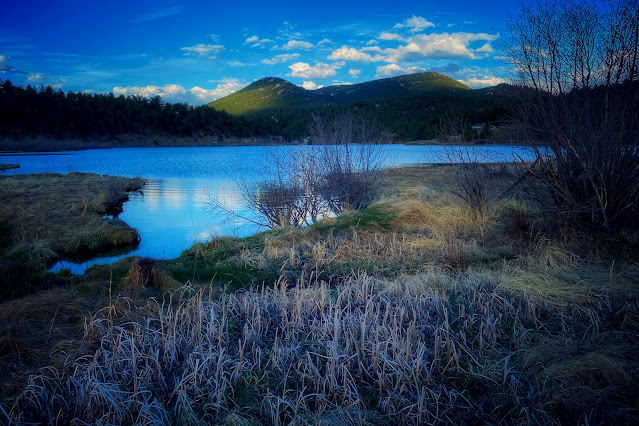 Early Spring Evergreen
Early Spring EvergreenErected along the grassy shoreline, a statuesque heron hunts discreetly in the evening light. The virtuous, great blue displays extraordinary patience while stalking prey in the muddy shallows.
It’s barely spring at Evergreen Lake so there’s not much activity except for an occasional ruckus raised by the red-wings. While I was in the vicinity, I never witnessed the great blue take a stab at anything edible so I hope she wasn’t overly famished.
Crumpled under heavy snow for most of the winter, the dusky marshland is slowly creeping back to life. Most of the barren trees are just now starting to sprout buds at the tips of their limber branches.
The surrounding mountains are impressive as ever after shedding their white blanket. The ring of high hills creates a sequestered valley enclosing an Edenic landscape bursting with both flora and fauna.
Because of the dramatic cloud cover, fading rays of sunshine strike the slopes at unusual angles. The peaks appear to glow, creating an inviting ambiance that hasn’t been experienced in months.
It’s getting late and as the hour slips into the blue, that heron is still frozen in place but now she’s almost imperceptible in the dark. After such a long time trudging through deep snow, it’s nice to meander on firm ground and rediscover the lake during its annual resurrection.
 Stalking prey in the shallows
Stalking prey in the shallows A statuesque heron
A statuesque heron Hunting discreetly
Hunting discreetly Red-wings raise a ruckus
Red-wings raise a ruckus An inviting ambiance
An inviting ambiance Trees are still barren
Trees are still barren Fading rays of sunshine
Fading rays of sunshine A dusky marshland
A dusky marshland An annual resurrection
An annual resurrection
As Above, So Below - Colored Pencil Drawing
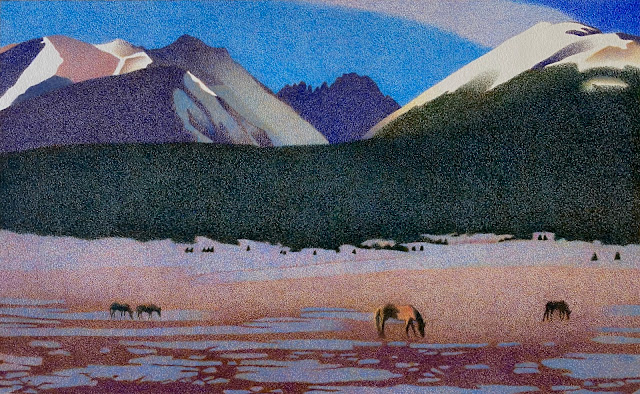 "As Above, So Below" Colored Pencil
"As Above, So Below" Colored PencilDuring winter’s dusk, an infinite field of celestial blue domes the serene landscape. A silky cloud sweeps over the snow-covered summit, conjuring an atmosphere of timeless peace.
As above, so below, where the sky’s serenity is reflected by the vast expanse of violet pastureland. A few horses graze on the short-grass stubble, evoking a feeling of pure contentment.
Looming over the transcendent valley, jagged peaks engrave a rugged profile out of the gloaming sky. Some last beams of fading light streak across the southern slopes, blending the realm of heaven with earth.
Soon, the constellations will fill the sky with a web of sparkling stars that blaze through the long night. Quilted into the high plain, endless patches of crusted snow melt into the mountain scenery.
The mountains at dusk are a foreboding barrier so sacrificing detail for clarity creates a more ethereal effect. The softer edges ease the tension and enhance the already somber mood.
The mountain tops form a bridge with the firmament creating a gateway to another world where Shangri-La exists. Despite the chaos and confusion of this world, some sanctuaries still survive and this alpine paradise is one of them.
Mapping the connection between the upper and lower realms is an ancient tradition that still influences my work today. Observing the visible overhead and translating its essence on the ground is the mission.
Unraveling the mysteries of the cosmos through acquaintance with nature is an arduous task. It’s impossible to reproduce the eternal but by accepting the challenge, safe passage during the long journey is assured.
The Vernal Equinox - More Heavy Snow
 The vernal equinox
The vernal equinoxHeralding the supposed start of spring, the vernal equinox is marked by more heavy snow. The struggle continues as southern storms wheel into the foothills leaving huge drifts and bitter cold in their wakes.
As the wet flakes finally stop falling, the pine forest interior is a perfect place to experience the frosty aftermath. Somehow, these defiant trees manage to survive in the difficult climate that defines this area.
Smothered under oppressive clouds, the forest is more silver than gray with hints of color that flicker in rebellious light. The trees are cloaked in an encrusted web of thick snow that binds to the needles like cement.
Limber trunks and branches bow under the immense pressure of excessive weight but they never break. The dark, frozen woodland always seems to bounce back after the elusive blue skies return.
The storm’s dispersal is certain to compose spectacular scenery as the mountain peaks start to jut out of a veil of smoky mist. The warmer air escapes and clear, cold air floods in refreshing the landscape.
The quick-hitting, fast-melting storms that occur this time of year are a precursor to the notorious mud season. The sure signs of transformation are everywhere, confirming that the predictable cycle of nature is right on schedule but it still feels like winter to me.
 Heralding the start of spring
Heralding the start of spring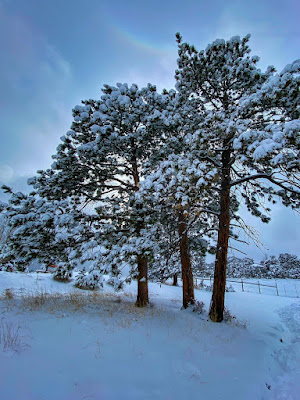 The vernal equinox
The vernal equinox More heavy snow
More heavy snow Defiant trees
Defiant trees Under oppressive clouds
Under oppressive clouds A frosty aftermath
A frosty aftermath Hints of color
Hints of color An encrusted web
An encrusted web Bowing under pressure
Bowing under pressure A frozen woodland
A frozen woodland Cloaked in snow
Cloaked in snow Still feels like winter
Still feels like winterSpirit of Winter - Colored Pencil Drawing
 "Spirit of Winter" Colored Pencil
"Spirit of Winter" Colored PencilThis time of year, a never ending cycle of storms sweeps down from the mountains burying the foothills in a frozen tomb. The ice cold essence seeps into your aching bones and the chill doesn’t thaw until late spring.
Despite the season’s harshness, the artist is lured into an attempt to capture the mysterious poetry evoked by such an austere landscape. In defiance of the somber setting, a palette of unexpected hues is required to accomplish the task.
Interred in eternal snow, a woodland valley is hauntingly diffused with the spirit of winter. Jutting out of the ground, dark menhirs are scattered across the meadow, making the composition’s structure seem monumental.
The deserted cabin is evidence of a recurring saga about the struggle between this area’s inhabitants and the environment. A phantom peak, pyramidal in shape, complements the strict geometry of the shelter.
The faltering shack is gradually being reclaimed by the land so its ragged edges melt into the surrounding hillside. It’s sloped roofing still bears a snowy load and horizontal details are scratched into the dressed timber.
An irregular border of branches is glistening with wet flakes while providing a necessary counter-balance with the other elements. The different pieces fitting together to create a swirl of interlocking shapes.
The constellation of pine tree pillars forms a natural gateway to the silvery heavens above. During this solstice dawn, a dark rift in the clouds suggests a portal to the very heart of an infinite universe.
The place is often overlooked by some who boldly march towards tomorrow. For me, it’s sacred ground where remnants of our predecessors are preserved, a memory of yesterday we should never forget.
Midwinter Blues - A Sea of Snow
 Midwinter Blues
Midwinter BluesIt’s midwinter and it won’t stop snowing as Evergreen is experiencing one or two storms every week. During small interludes, warmer weather generates some melting but, overall, the big drifts continue to grow.
On clear days, the subzero temps are brutal but the sun’s clean rays infiltrate the forest causing the trees to sparkle. The giant pine cast deep blue shadows that undulate across the wavy surface of the sea of snow.
Last summer the lively marshland was brimming with activity as the place is popular with both people and wildlife but now it’s as still as a cemetery. If you can withstand the elements, there is a certain peace that can only be found in such winter haunts.
Monolithic Bergen Peak quietly overlooks the grandeur of a frozen landscape paralyzed by the bitter cold. The mountain’s stoic expression reveals a permanence that’s reassuring during these ever-changing times.
While buried under feet of white powder, life struggles to survive as the wild animals and birds wander into town searching for food and shelter. We all share a harsh, common condition as we trudge through another day during this icy monsoon.


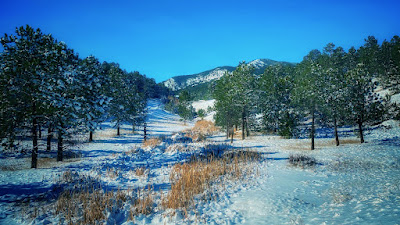







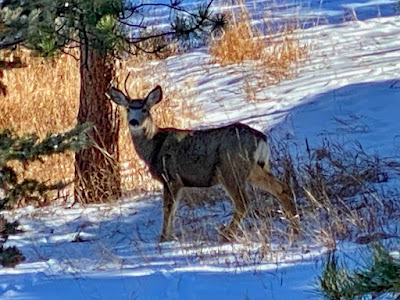

Green Creek Winter - Pioneer Strength
 The green creek
The green creekIt’s winter on the Green Creek but there’s not even a dusting of snow to distinguish the dark season. An icy breath circulates through the solemn labyrinth of barren trees that arch across the deep ravine.
The stream’s designation is derived from the mossy undergrowth that ordains the water’s vibrant coloring. The little oasis winds through a desolate prairie whose harsh environment leaves unfortunate victims in its wake.
The rugged pastureland is littered with historical remnants of more difficult times. The multitude of unearthed artifacts symbolize the strength of the pioneers who still endure this region’s volatile climate.



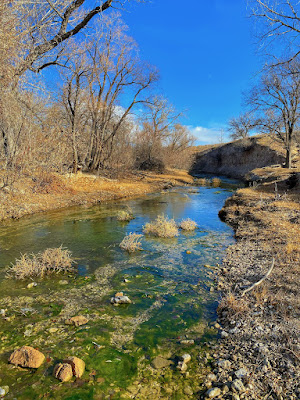




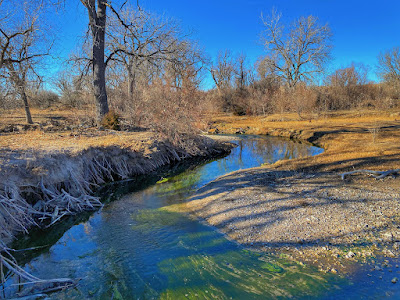










Bergen Peak from Evergreen Lake - Colored Pencil Drawing
 "Bergen Peak from Evergreen Lake" Colored Pencil
"Bergen Peak from Evergreen Lake" Colored PencilA swift breeze sweeps across the surface of Evergreen Lake sending ripples through the reservoir’s vivid reflections. It’s springtime in the foothills so fresh greenery is on display but the willow brush and aspen trees are not yet in full bloom.
The whole Bear Creek Valley has come back to life and Bergen Peak looms over the scene, its north face cradled by a web of branches and pine needles. The reinvigorated forest reaches to the water’s edge where a slender tree leans into the vibrant landscape.
After enduring a perpetual winter of deep freeze, the vernal atmosphere raises the spirit to a higher level of longing. Like the small cloud drifting across the drawing’s page, nothing stays the same as nature seems to thrive in constant change.
Evergreen Lake Trail - A Glowing Marshland
 Evergreen Lake Trail
Evergreen Lake TrailTracing the irregular contour of a scenic watershed, Evergreen Lake Trail is a looping artery centered in the heart of the foothills. On a hazy, autumn morning the water’s smooth surface faithfully reflects an unusually emerald-colored sky.
Other anomalies also occur as the pall of silence evokes an eerie sensation that is unexpected after such a boisterous summer. During this seasonal transformation, the marshland glows with a sheen of vibrant color more vivid than years past.
Surprisingly this watery world has remained fluid well into the onset of another mild winter. The predictable cycle of annual weather seems to have shifted so traditional patterns arrive later than normal, leaving the local inhabitants in a state of bewilderment.

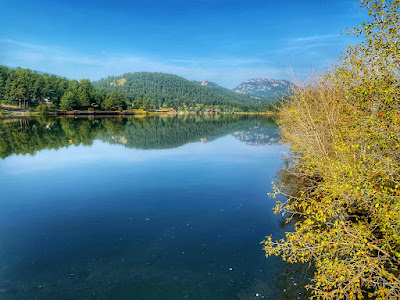





Bergen Park Trail - Waiting Anxiously for Winter
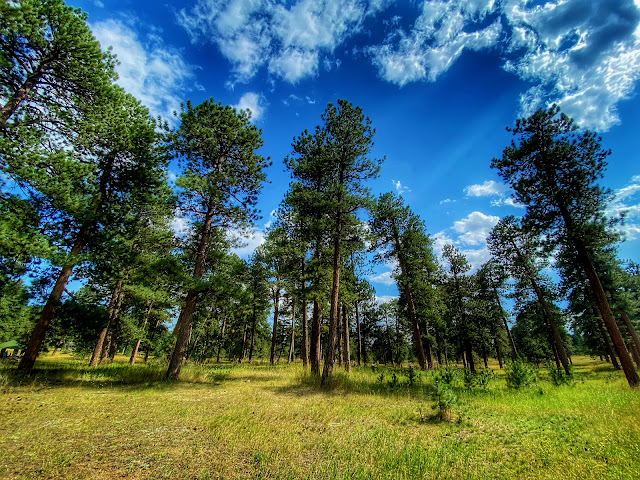 Bergen Park Trail
Bergen Park TrailThe Bergen Park Trail is a distinct walkway that circumnavigated a very old swath of ponderosa pine forest. The giant trees blot out the sun but some especially resilient rays of light pierce the canopy of sharp needles.
The subtle luminescence is responsible for the soft shadows that creep across the summer’s last tufts of tall grass. At the southern section of the green belt, the scenery opens up where a pair of little ponds reflects the scenic backdrop.
This mild season seems eternal as there has been hardly a hint of the snow that normally adorns the landscape this time of year. We will wait anxiously for the first big storm that generates the winter weather to which we’ve become so accustomed.
 Bergen Park
Bergen Park Circumnavigates old pine
Circumnavigates old pine Ponds reflect the backdrop
Ponds reflect the backdrop Mild season seems eternal
Mild season seems eternal Waiting for a storm
Waiting for a stormFounders Trail - An Understated Niche
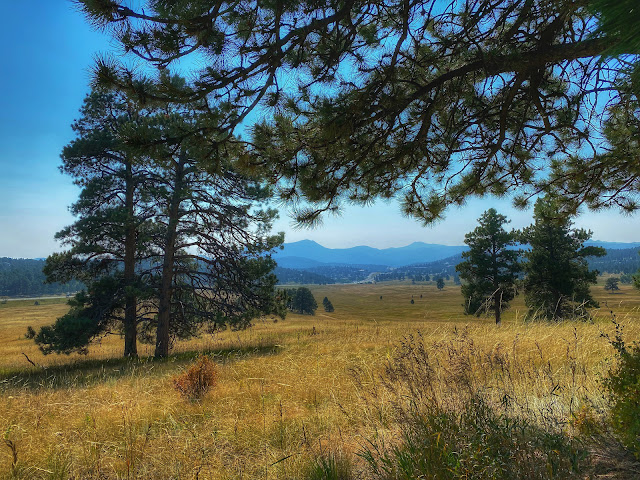 Founders Trail
Founders TrailStretching through the middle of Elk Meadow, a rugged pathway ascends gradually to the base of Bergen Peak. I don’t know for certain who founded the Founders Trail but I do know it’s a place where authentic beauty can be found.
A dispersion of isolated pine trees acts as a gateway to a golden grassland tussled by autumn’s persistent breeze. The stoic guardians are important compositional elements adorning the foreground of fleeting snapshots.
The easygoing excursion leads you through a mountain landscape steeped with ever-changing scenery. The tranquil passage exists as an understated niche, branching away quietly from the mainstream.
 Isolated pine trees
Isolated pine trees A golden grassland
A golden grassland A gateway
A gateway A rugged pathway
A rugged pathway An understated niche
An understated niche Ever-changing scenery
Ever-changing scenery Bergen Peak
Bergen Peak Authentic beauty
Authentic beauty Branching away quietly
Branching away quietlyElk Meadow - The Cycle of Life
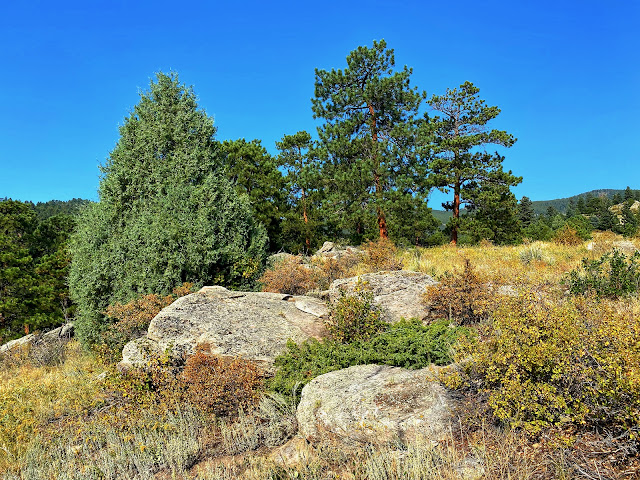 The cycle of life
The cycle of lifeAfter this fall’s first snow, pleasant reflections of more comforting times wrestle with an overwrought mind. The former glory of a vivacious Elk Meadow and its adjacent woodland is now nothing but a bittersweet memory.
The graceful grassland battled to the very end but eventually succumbed to powerful, natural forces beyond the season’s control. The unsuspecting landscape was swept into a futile murkiness by an icy gust determined to steal an innocent soul.
The difficult trauma induced by such transitional change can only be overcome by the passage of precious time. The cycle of life is a callous certainty responsible for happiness and heartbreak but in either case we must possess the strength to carry on.
 Pleasant reflections
Pleasant reflections Vivacious elk meadow
Vivacious elk meadow Bittersweet memories
Bittersweet memories An unsuspecting landscape
An unsuspecting landscape Graceful grassland
Graceful grassland Transitional change
Transitional change The passage of time
The passage of time Happiness and heartbreak
Happiness and heartbreak The cycle of life
The cycle of life The strength to carry on
The strength to carry on
The Ranch - A Hard Life
 The ranch
The ranchIt’s a smoky dusk in western Nebraska and as the spectral light begins to dissipate, the checklist of laborious chores comes to completion. Life on the ranch is hard as illustrated by battered grain bins and ragged hay bales but at least it’s not winter when the weather is brutal.
The rhythm of life revolves around the horse as this beast of burden is indispensable to running a successful cattle ranch. This important work animal must be properly cared for from head to hoof, attending to its nutrition, hygiene and exercise.
Weathered boots adorn the fence posts, signifying the passage of another tough year while the smoldering, prairie sunset marks the conclusion of summer. As darkness descends on the home place, the work day comes to an end and the peacocks go to roost.
 The horse is indispensable
The horse is indispensable Peacocks go to roost
Peacocks go to roost Ragged hay bales
Ragged hay bales Prairie sunset
Prairie sunset A hard life
A hard life Life revolves around the horse
Life revolves around the horseDenver Zoo - A Relaxed Atmosphere
 A relaxed atmosphere
A relaxed atmosphereOn a lazy, summer day at the Denver Zoo, we trekked across the grounds observing animals during their afternoon slumber. Too hot to engage in activity, most of the creatures we saw slept innocently in their comfortable confines.
It always makes me feel bad to see wild animals held captive but in many cases it’s an unfortunate but necessary circumstance. The enclosures’s exotic inhabitants were well cared for and appeared content as they exhibited a friendly, playful attitude.
I enjoyed roaming around the gardens because I could practice taking pictures in a more controlled environment. I was intent on capturing portraits and usually a theme develops which in this case was sleeping animals.
After a busy morning rooting in the mud, red river hogs slept as hard as they live and the king of beasts looked vulnerable as he was laid out casually on a bed of lush grass. In a more touching display, two, tired otters were curled up quietly in a circular position.
While in the reptile sanctuary, seeing sleeping snakes was scary and back outside, observing a kangaroo out cold was just a little bit weird. Big animals, like the elephants and a rhinoceros, dozed during the daylight and came to life during the cool before dark.
All in all, visiting the place during such a peaceful calm made for a pretty laid back afternoon. It was a good day as I walked several miles, shot lots of photos and inspired by the relaxed atmosphere, went home and took a nap.
 King of beasts
King of beasts A peaceful calm
A peaceful calm Practice taking pictures
Practice taking pictures Elephants dozed
Elephants dozed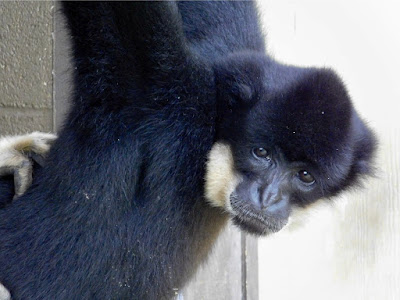 Animals seemed content
Animals seemed content Kangaroo out cold
Kangaroo out cold Capturing portraits
Capturing portraits Sleeping innocently
Sleeping innocently A good day
A good day A touching display
A touching display Snakes are scary
Snakes are scaryEvergreen Lake Summer - A Gleaming Eden
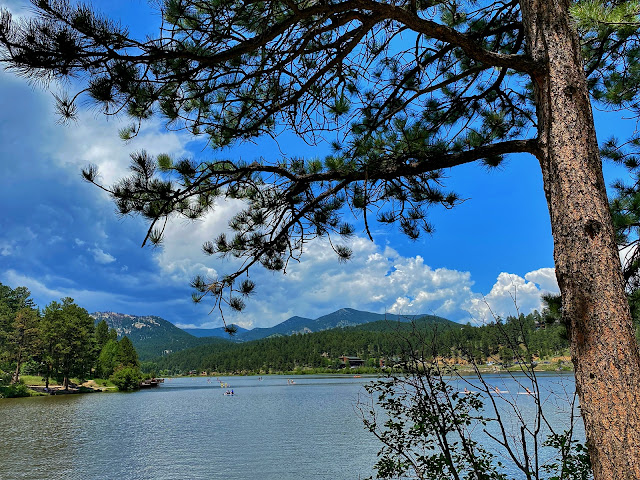 Evergreen Lake summer
Evergreen Lake summerDuring the summer, Evergreen Lake is a gleaming eden treasured by floating waterfowl, rainbow trout and the great blue heron. Below the dam, a bountiful garden of wildflowers bursts forth, displaying nature’s full color spectrum.
The biggest draw is the plethora of birds that inhabit this area during the year’s warmest months. The lively reservoir is home to cormorants, geese, blackbirds, swallows, sparrows, hummingbirds, hawks and bald eagles.
The region’s wildest weather is funneled through Bear Creek Canyon so some of the most surreal clouds can be seen reflected on the surface of the lake. The forest creeps down to the water creating interesting compositions with branches shaped to follow the contour of Bergen Peak.
The popular park is a place that has something to offer everyone so the usage gets pretty heavy. That’s why summer isn’t necessarily my favorite season - I like this place in the winter, after a storm, when the only noise is the sound of silence.
 Wild weather
Wild weather Surreal clouds
Surreal clouds Bear creek
Bear creek Garden of wildflowers
Garden of wildflowers A popular park
A popular park Below the dam
Below the dam Interesting compositions
Interesting compositions Full color spectrum
Full color spectrum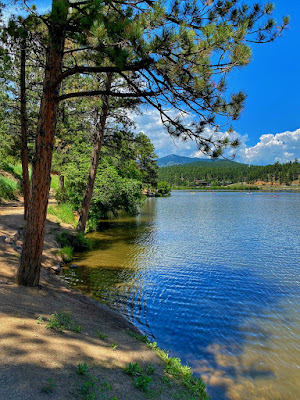 A gleaming eden
A gleaming eden A plethora of birds
A plethora of birdsDedisse Park - A Niche of Paradise
 Dedisse Park
Dedisse ParkThe eastern most section of Dedisse Park is a sliver of lost wilderness overlooking the heart of Evergreen, Colorado. Picturesque reflections, mirrored in the sparkling blue reservoir below, circulate through the memories of all those who visit.
A dense forest of mature pine is wrapped around the hillside offering tranquility and shade from the scorching, summer sun. This niche of paradise is little known even to locals who have inhabited the area for a long time.
A steep ascent to the pinnacle of the park rewards the climber with astounding views of the surrounding foothills. As fleeting thoughts come and go, the crest of this rocky outcrop is the perfect place to focus on the clouds and clear a busy mind.
 A lost wilderness
A lost wilderness Sparkling blue reservoir
Sparkling blue reservoir Astounding views
Astounding views Little known to locals
Little known to locals The heart of Evergreen
The heart of Evergreen A niche of paradise
A niche of paradise
Elk Ridge Trail - A Scenic Backbone
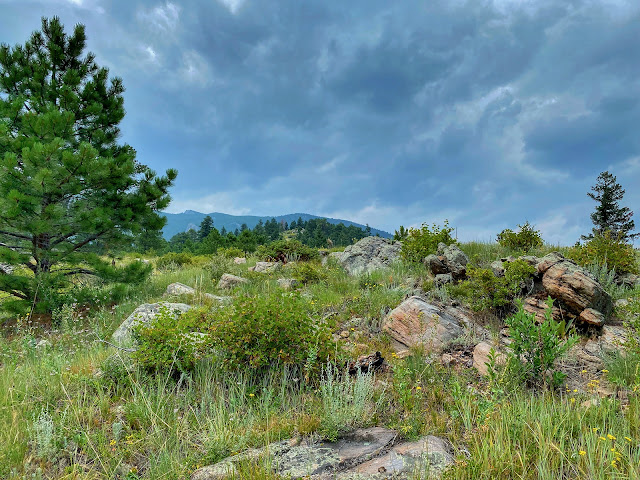 Elk Ridge
Elk RidgeSecluded in Bergen Peak’s purple shadow, a writhing dirt path snakes it’s way through a tall grass meadow. From the wavy elk pasture, you can see Elk Ridge’s dark spine curve above a dense forest of ponderosa pine.
The narrow crinkle of rocky trail is a scenic backbone that bridges the flatland with the big mountain’s steep slopes. This year an assortment of yellow wildflowers sprout from the rich turf, glittering like gold medallions in the summer sunlight.
Tall, leaning trees testify to the power of strong wind gusts that blow intermittently across the open sections of the rugged buttress. Blue clouds churn overhead promising precipitation but the atmosphere is too hot so it doesn’t rain at all.
From the summit of the natural crease in the land, the edges of pyramidal peaks in the distance are softened by a smokey haze. The current season is fleeting as during the lazy descent, departing bluebirds, turning aspen leaves and floating thistle seed hint at an early autumn.
 A tall grass meadow
A tall grass meadow A scenic backbone
A scenic backbone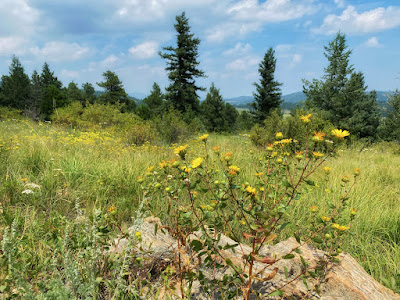 Glittering like gold
Glittering like gold Yellow wildflowers
Yellow wildflowers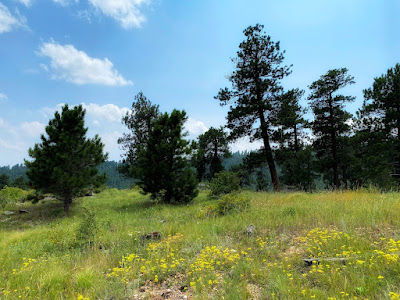 Leaning trees
Leaning trees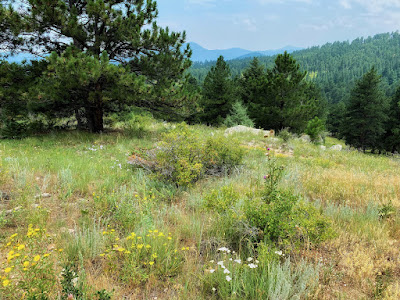 A smokey haze
A smokey haze Churning, blue clouds
Churning, blue clouds Ponderosa pine
Ponderosa pine Secluded below Bergen Peak
Secluded below Bergen Peak Hints of an early autumn
Hints of an early autumnHorses - How the West was Won
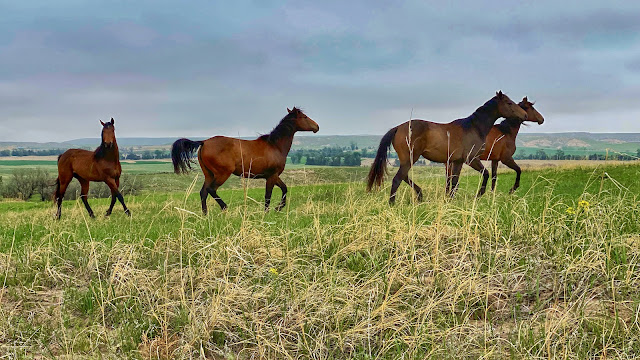 Horses
HorsesOut in the panhandle of western Nebraska, where the desolate Sandhills assimilate into the North Platte River Valley, horses seem to outnumber the sparse human population. Circles of corn are scattered throughout the fertile basin but the rugged highlands are reserved as pastureland for cattle and horses.
Sometimes I see them as a solitary creature lost in a vast sea of prairie grasses but usually these social animals are observed in small herds. Horses are curious by nature so sometimes they approach the fence line in order to investigate strange visitors.
Horses spend most of their time grazing contentedly in their idyllic environment but sometimes they become quite playful as they run, buck and roll with enthusiastic delight. Horses are an indisputable symbol of the Great Plains and a beautiful reminder of their importance in how the West was won.
 Small herds
Small herds Horses outnumber people
Horses outnumber people North Platte River Valley
North Platte River Valley Lost in a sea of grass
Lost in a sea of grass Symbol of the Great Plains
Symbol of the Great Plains Grazing contentedly
Grazing contentedly Curious by nature
Curious by nature
Mount Vernon Creek Trail - A Forest of Peace
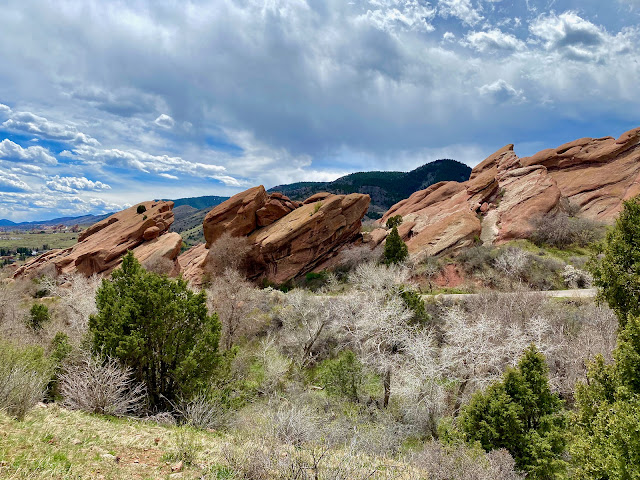 Mount Vernon Creek Trail
Mount Vernon Creek TrailThe Mount Vernon Creek Trail is an outlying pathway tracing the outer contour of Red Rocks' frontier boundary. It’s early spring so there’s not much foliage but the barren trees stand out sharply against vermillion crags.
While trekking over the rolling terrain, several little streams come tumbling down out of the foothills and flow discreetly into the Mount Vernon. Up out of the valley and a stunning array of sandstone formations dominate the diverse landscape.
During the delightful descent, a hidden gulch is chock full of flowering bushes featuring blossoms of pure white. Back down in the bottomlands far from the crowds above, we follow the cottonwoods and soon find ourselves in a place that feels like our own, little forest of peace.
 Diverse landscape
Diverse landscape Sandstone formations
Sandstone formations Barren trees
Barren trees A stunning array
A stunning array Rolling terrain
Rolling terrain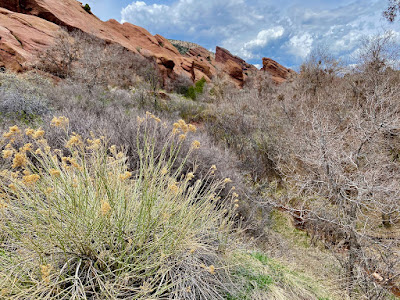 Early spring
Early spring Flowering bushes
Flowering bushes Vermillion crags
Vermillion crags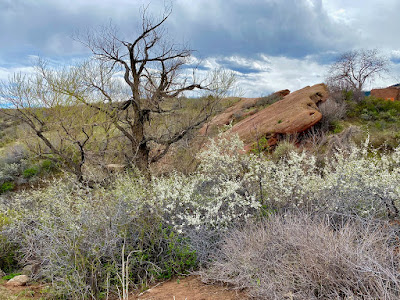 White blossoms
White blossoms The frontier boundary
The frontier boundary A forest of peace
A forest of peace Mount Vernon Creek valley
Mount Vernon Creek valley A little stream
A little streamPetroglyphs - Remarkable Artwork
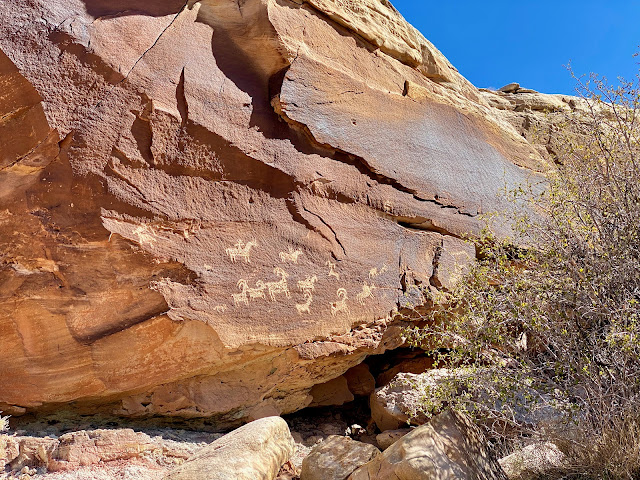 Petroglyphs near Moab, Utah
Petroglyphs near Moab, UtahNear the town of Moab, Utah if you keep your eyes open, you might see rock art carved by Native Americans hundreds of years ago. The most conspicuous sites are where the symbols are carved out of dark rock panels revealing light-colored graphics.
As opposed to painted Pictographs, Petroglyphs are scratched or incised into the brown, desert varnish. The abstract images are exceptionally concise but that simplicity is what evokes such a powerfully honest expression.
The meaning behind these mesmerizing works is not exactly known but the artists who created them must have been revered for their magical powers. It is an extraordinary thing to be in the desert hiking through a remote arroyo and stumble upon an ancient gallery of remarkable artwork.
 Rock art
Rock art Symbols carved out of dark rock
Symbols carved out of dark rock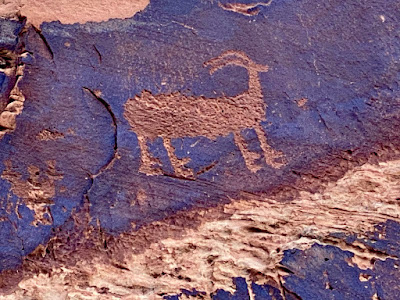 Scratched into the desert varnish
Scratched into the desert varnish Mesmerizing works
Mesmerizing works Light-colored graphics
Light-colored graphics Abstract images
Abstract images An extraordinary thing
An extraordinary thing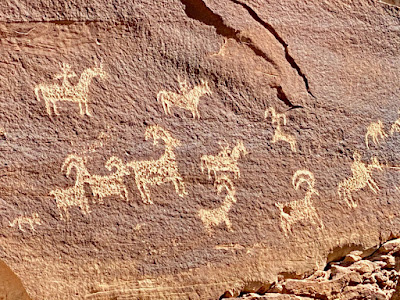 Exceptionally concise
Exceptionally concise An honest expression
An honest expression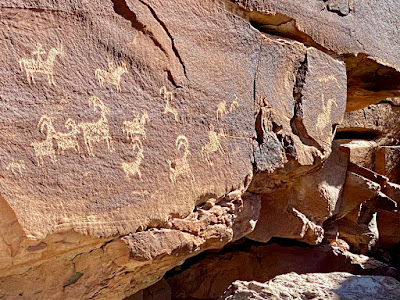 Remarkable artwork
Remarkable artwork
Mountain Storm - Colored Pencil Drawing
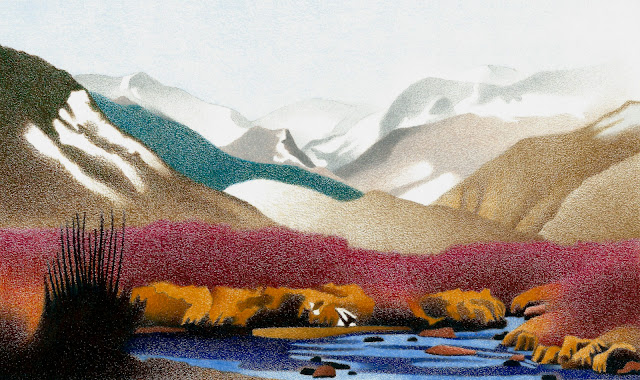 "Mountain Storm" Colored Pencil
"Mountain Storm" Colored PencilIt’s an early winter morning and a mountain storm is funneled by a string of ghostly peaks into a remote river valley. It’s the first big tempest of the season so it won’t be long before the view vanishes behind a squall of heavy snow.
Trickling through a maze of wine-colored willow-brush, the lazy river is oblivious to the deteriorating weather conditions. The black shrubs anchor the foreground into place and bookend the wide value range this landscape displays.
Illuminated in a murky ambiance, this vista is characterized by soft edges and subtle gradations, requiring a soft touch to reproduce. More realistic than my recent pieces, this drawing still retains a certain romanticism with life in the West.
Dead Horse Point - Edge of the World
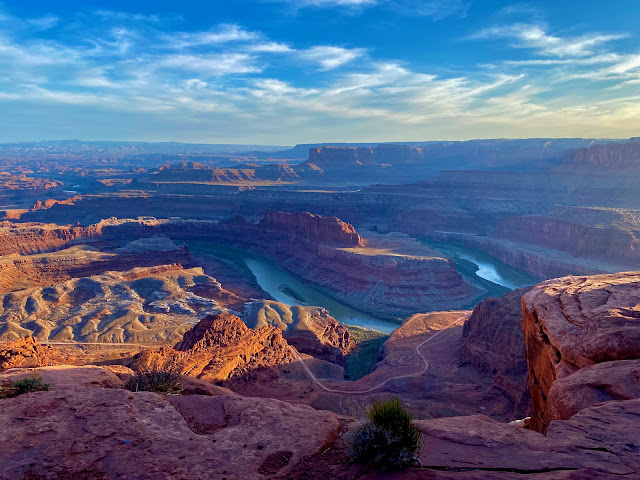 Dead Horse Point, Utah
Dead Horse Point, UtahSoaring above the Colorado River and Canyonlands National Park, Dead Horse Point is a photographers paradise featuring sublime subject matter. While hiking along the rim’s irregular contour during the evening, the violet shadows shift restlessly across the staggered buttes.
The day’s last sunlight is filtered through a veil of thin clouds, creating dramatic conditions that are infused into the intricate pattern of wild escarpments. The vast expanse weaves luminance, color and form into a bountiful vista of visual delight, overloading the senses.
Deeper into dusk, things become more simple and obscure as the distinct shapes lose their edges and melt into a blue atmosphere. I’m not exactly sure how this place got its startling name but I do know that while occupying a remote overlook on the point, it feels like your standing at the edge of the world.
 A photographer's paradise
A photographer's paradise Violet shadows
Violet shadows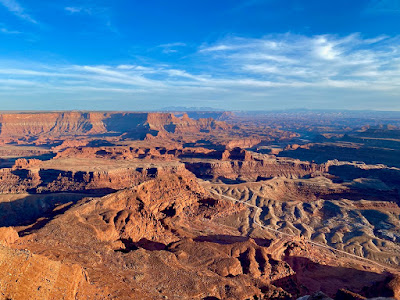 Wild escarpments
Wild escarpments Last light
Last light Bountiful vista
Bountiful vista Visual delight
Visual delight A blue atmosphere
A blue atmosphere Dramatic conditions
Dramatic conditions Vast expanse
Vast expanse Edge of the world
Edge of the world
Evergreen Summer - Emerging From a Frozen Darkness
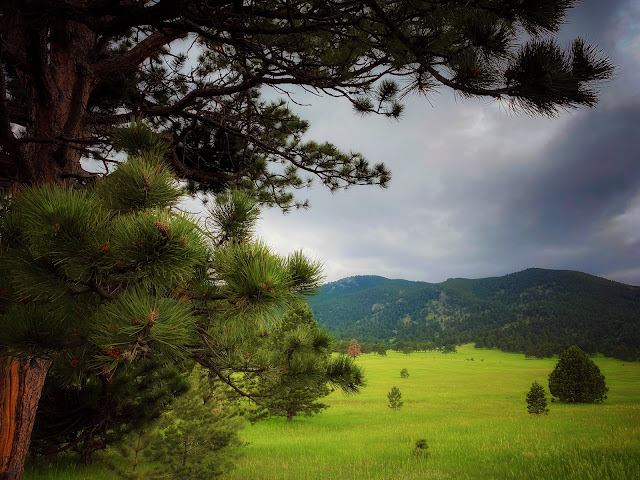 Evergreen Summer
Evergreen SummerAfter enduring one of the coldest and snowiest spring seasons on record, it’s only natural that the start of this summer has been cool and wet. The continuous monsoon has been somewhat of a blessing as the parched foothills have suffered from a terrible drought that has lasted for several years.
Streaming down from snow packed summits, Bear Creek is running high and fast as it has filled Evergreen Lake to the brim. There isn’t a more picturesque place in the state when the reservoir is permeated by a mixture of drizzled moisture, breaking clouds and fading light.
When not shrouded in mist, Bergen Peak glistens with a sheen of fresh color that seems to give the mountain a supernatural glow. Thriving from the rainy weather, the lush, green meadows have experienced a profusion of wildflowers, songbirds and hungry elk.
Finally emerging from a frozen darkness, the Renaissance of good fortune has transformed the landscape into a lively ecosystem. One of the things I admire most about nature is the plant and animals’ ability to unflinchingly adapt to constant change.
Speaking of change, Impression Evergreen will be undergoing a slight makeover in regards to the delivery of emailed posts to subscribers. My current provider, Feedburner, is going away in July so I joined a new provider called Follow.it. Follow.it will send out my blog posts to anyone who follows Impression Evergreen by email.
If you have subscribed to Impression Evergreen by email you don’t have to do anything different but the delivery may not look the same so I wanted to let everyone know about the change. Follow.it is a free service that has some extra features that will allow you to control how content is delivered.
If you’d like to learn more about the content provider, Follow.it, please check out their site here: https://follow.it/about
 Emerging from darkness
Emerging from darkness The monsoon has been a blessing
The monsoon has been a blessing A supernatural glow
A supernatural glow Animals adapt to change
Animals adapt to change A picturesque place
A picturesque place Bergen Peak glistens
Bergen Peak glistens It has been cool and wet
It has been cool and wet Lively ecosystem
Lively ecosystem Good fortune
Good fortuneArches National Park - Wild Scenery
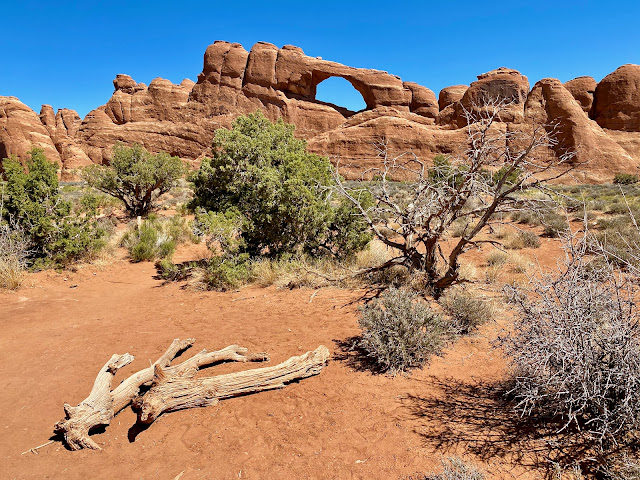 Arches National Park
Arches National ParkArches National Park is one of the most fascinating places on earth and exceedingly more spectacular than I had imagined. Upon ascending to the top of a high plateau, a gateway of rock towers welcomes you to a world of canyons, cliffs, valleys, mountains, gardens, caves, pinnacles, spires, hoodoos and arches.
The diversity of scenery is staggering as the rugged terrain seems to transform at every turn. Discovering the Delicate Arch takes you off the main road but a grueling hike up to its secluded location is well worth the effort.
From the rim of a lofty overlook, a fiery furnace of red crags has consolidated on a ridge, creating a sandy terrace of inhospitable textures. At the far, northern end of the park, there is a forbidding yet intriguing zone of arches known as The Devils Garden.
An area called The Garden of Eden is an unbelievable section of formations that will take your breath away. With names like Balanced Rock, Window Arch, Turret Arch, Double Arch, and The Parade of Elephants, you can only imagine what a delight the sculptures are to behold.
The region is like something you’ve never seen before but despite its remote setting, it’s a popular destination as outdoor enthusiasts arrive in droves. Arches is one of the most accessible and beloved hotspots but the park is massive so it’s easy to find a place of solitude to contemplate the wilderness that surrounds you.
 A fascinating place
A fascinating place Dune valley and Mountains
Dune valley and Mountains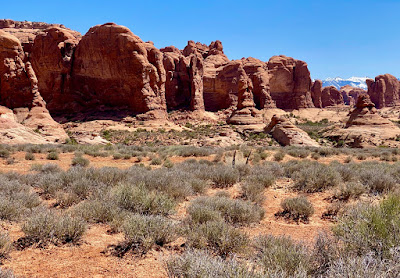 Parade of Elephants
Parade of Elephants The Gateway
The Gateway Rock towers
Rock towers Rugged terrain
Rugged terrain Furnace of red crags
Furnace of red crags Diversity of scenery
Diversity of scenery Inhospitable textures
Inhospitable textures An intriguing zone
An intriguing zone Takes your breath away
Takes your breath away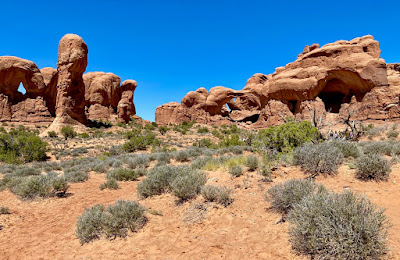 A popular destination
A popular destination Unbelievable formations
Unbelievable formations Delightful sculptures
Delightful sculptures More spectacular than I imagined
More spectacular than I imagined A remote setting
A remote setting Window Arches
Window Arches Turret Arch
Turret Arch A place of solitude
A place of solitudeBlue Inlet - Colored Pencil Drawing
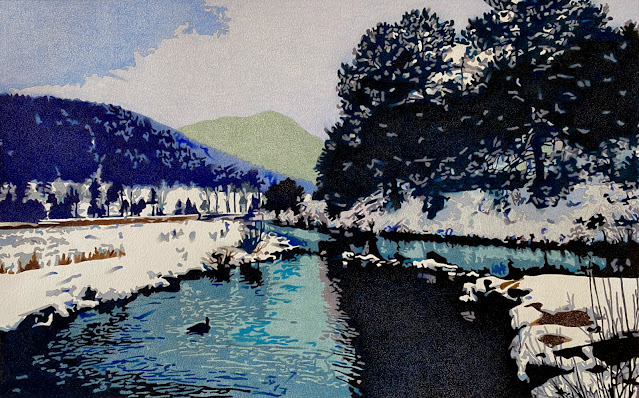 "Blue Inlet" Colored Pencil
"Blue Inlet" Colored PencilIt is a late spring morning at Evergreen Lake and a potent storm has blanketed the foothills with wet snow. The only living creature bearing witness to the extraordinary landscape is a Canada goose, drifting quietly across the water’s rippled surface.
The blue inlet is defined by the irregular contours of dark reflections that mirror the surrounding pine forest. This cold channel meanders through a snowy marsh painted white but dappled with squiggly, gray shadows.
A mountainside’s choppy ridgeline descends into the narrow valley creating an effective backdrop for the stand of pale aspen trees. In the far background a jade-colored peak offers just a touch of warmth to the otherwise cool, color scheme.
This wilderness expression is an enigmatic puzzle of interlocking shapes that vibrate from the contrast generated by passages of flat and shaded chroma. The solemn composition is crackled with facets of pigment that are layered, burnished and smudged.
Lingering innocently well through the aftermath, powder-edged clouds begin to disperse into the celestial sphere above. Carefully transcribing the challenging subtleties of a complex weather event is effective therapy for an unsettled mind.
Delicate Arch - Enlightenment Achieved
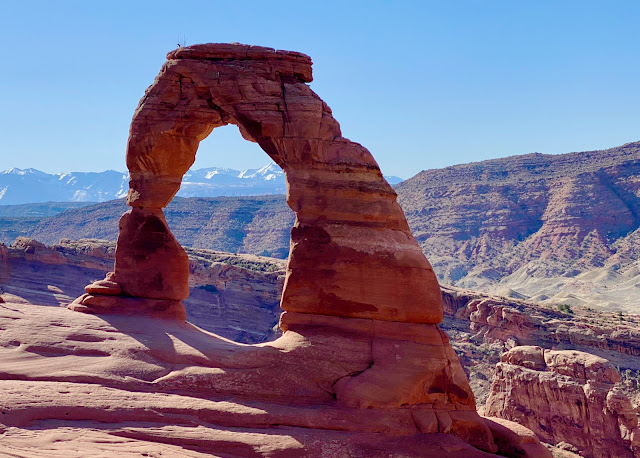 Delicate Arch
Delicate ArchThe Delicate Arch is tucked away in an eroded, natural amphitheater that includes sweeping views across a vast expanse to the La Salle Mountains. Reaching Utah’s most iconic landmark requires strenuous effort as the two mile trek to the spectacular location is almost entirely uphill.
With a shape more sturdy than delicate, the heavy set vault is truly a masterpiece of nature’s erosional engineering. The rigid, orange rock contrasts sharply with the soft, blue sky, creating artistic compositions from every available angle.
Reaching the summit of this unique environment is worth the effort because the difficult journey through time instills appreciation for the desert’s beauty. Hordes of hikers stream through this area but not even the enthusiastic crowds can diminish the enlightenment achieved by attaining this Mecca on the Mesa.
 A strenuous effort
A strenuous effort A two mile trek
A two mile trek A journey through time
A journey through time Desert beauty
Desert beauty Mecca on the Mesa
Mecca on the Mesa Erosional engineering
Erosional engineering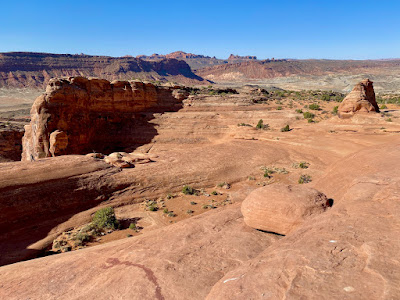 A natural amphitheater
A natural amphitheater Hordes of hikers
Hordes of hikers A heavy set vault
A heavy set vault Artistic compositions
Artistic compositions An orange rock
An orange rock An iconic landmark
An iconic landmarkUtah Desert - A Lonely Landscape
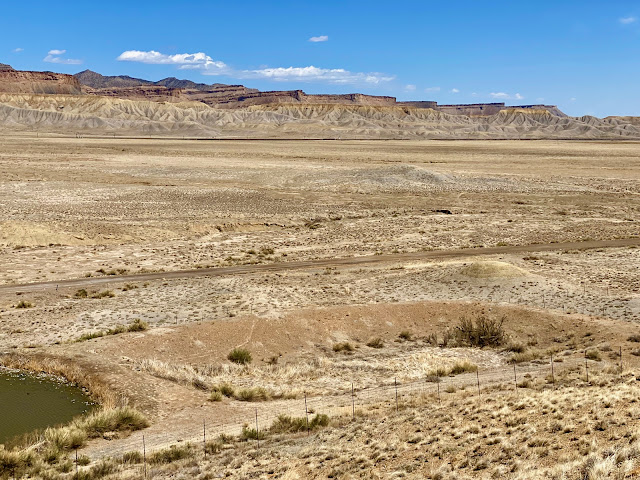 The Utah desert
The Utah desertEastern Utah’s vast desert country is a lonely landscape that appears to be devoid of any type of life. The treeless terrain is tinted yellow as the otherworldly environment of rock and dirt exhibits a certain stark beauty.
Forming a rigid backdrop, a range of striated book cliffs punches into a boundless, blue sky. Anything but flat, the trails are a rollercoaster of ups and downs, offering panoramic views from the summits of sandy overlooks.
Utah is an absolutely gorgeous state with some of its most spectaculars places preserved as National Parks. Passing through this arid backcountry may seem dull at first but if you look closely, there is an understated charm in the vast expanse of hazy buttes painted with colors of soft pastel.
 A lonely landscape
A lonely landscape Treeless terrain
Treeless terrain Panoramic views
Panoramic views Stark beauty
Stark beauty Understated charm
Understated charmSnowstorm at Stagecoach Park - Still in the Ice Age
After months of record breaking snowfall during March and April, the cold streak continues into the middle of May. The frigid beauty revealed in the aftermath of a freak snowstorm betrays the dreary weather experienced this spring.
As usual dawn is shrouded in mist and you can see your own breath as glassy, white ice encases the shocked landscape. The trees are particularly hard hit but they display a defiant resolve to defeat the unexpected elements.
Stagecoach Park is barely recognizable because of the low-lying clouds that cause reduced visibility. The field’s sturdy fence line seems to extend from an impressive pine all the way into absolute nothingness.
After about a day of such nonsense the blue sky opened back up and an impatient sun went to work releasing winter’s almost unclench-able grip. Even the park’s iconic landmark, Bob the Dinosaur, has grown weary of this eternal, glacial event as it feels like we’re still in the last Ice Age.
Frigid beauty
Cold streak continues
The fence line extends into nothingness
Unexpected elements
The trees are hard hit
Dreary weather
Defiant resolve
Still in the last ice age
Grizzly Creek - A Resilient Watershed
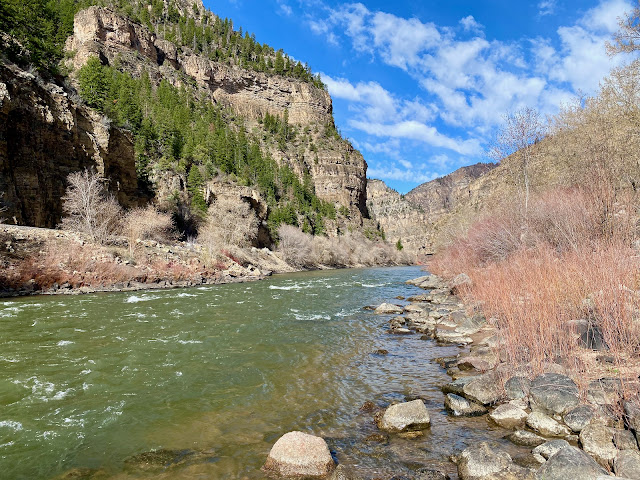 |
| Grizzly Creek |
Smack dab in the middle of spectacular Glenwood Canyon, Grizzly Creek tumbles down out of the wilderness and collided with the Colorado River. The beautiful confluence occurs within the sheer walls of steep cliffs adorned by a variety of high country botanicals.
The rocky creek bed is a complicated conglomeration of boulders, snags and whitewater, revealing an array of sights, sounds and textures. A far away mesa dominates the view but its full profile is partially obscured by the imposing evergreens that tower above the pathway.
The scene of last summer’s devastating fire, the scars are still visible but the burn zone is beginning to blend into the vigorous greenery, concealing the catastrophe. Even after such an awful disaster, the watershed remains resilient as Mother Nature has begun to heal her wounds.
 |
| A spectacular canyon |
 |
| Out of the wilderness |
 |
| Evergreens tower above |
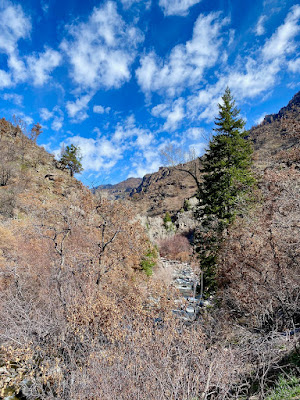 |
| High country botanicals |
 |
| Beginning to heal |
 |
| A complicated conglomeration |
 |
| An array of sights, sounds and textures |
 |
| A beautiful confluence |
 |
| A mesa dominates the view |
 |
| A resilient watershed |
Elk in the Meadow - Emanating Tranquility
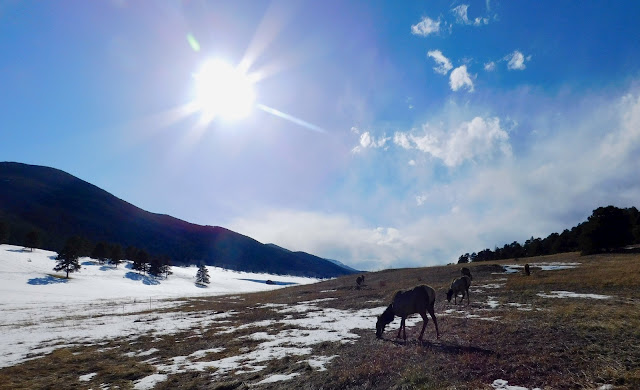 |
| Elk in the Meadow |
It’s a crisp spring evening and a modest herd of scraggly elk has emerged from the woodland to forage in the meadow. The sun’s rays are strained through a thin veil of clouds creating a milky haze that softens sharp edges.
The wild animals are scattered across the hillside, their dark silhouettes observed in all manner of activity. Most are grazing contentedly but a few are on the move and a couple are curious about the stranger who has invaded their habitat.
Intermingled with the furry, brown beasts is a flock of mountain bluebirds who sweep about nervously, their plumage glowing brightly in the low light. It’s an idyllic scene emanating tranquility and the spirit of optimism as this new season cautiously begins.
 |
| Foraging in the meadow |
 |
| Mountain bluebirds intermingle |
 |
| Wild animals |
 |
| Scattered across the hillside |
 |
| Dark silhouettes |
 |
| An idyllic scene |
 |
| Curious about the stranger |
 |
| Spirit of optimism |
Flatirons Overlook - A Powerful Impression
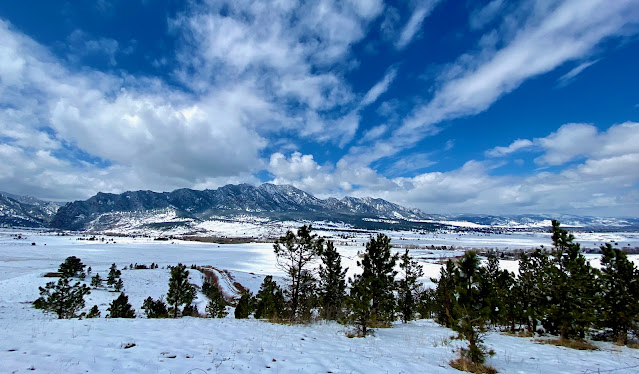 |
| Flatirons Overlook |
After a seemingly endless week of bitter cold and unrelenting snow, the fog has lifted revealing a pristine landscape plastered with white powder. Seen from a lofty overlook, Boulder’s mighty Flatirons glitter beautifully in the late morning light.
The unusual peaks rise vertically from the end of the receding valley where their sharp shapes are jigsawed into the distant horizon. Streaming across the blue sky, the clouds explode like fireworks celebrating the sun’s triumphant return.
There is just enough saturation to make this vivid scene succeed but a more monochrome reflection might add drama to the already spectacular tableau. Processing the pictures in order to express the power of the impression is almost as interesting as experiencing the place in person.
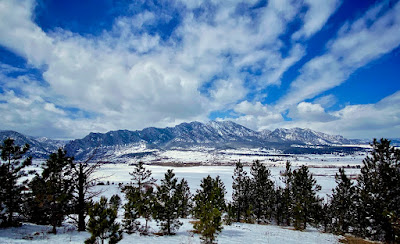 |
| A pristine landscape |
 |
| Late morning light |
 |
| A spectacular tableau |
 |
| A monochrome reflection |
 |
| A powerful impression |
 |
| Clouds explode like fireworks |
Snowy Sangre de Cristos - Someplace I'd Rather Be
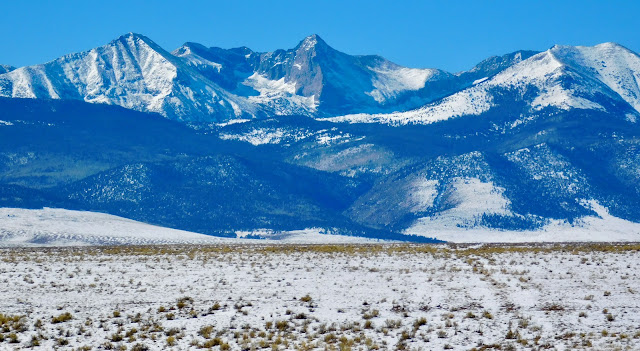 |
| Snowy Sangre de Cristos |
As the setting, winter sun makes its swift descent, the snowy Sangre de Cristos shimmer like a smokey, blue mirage. The peaks’ jagged silhouette is traced by a glowing contour, exaggerating the mountains’ awesome size and power.
Scattered throughout the Wet Mountain Valley, abandoned homesteads offer sentimental value to the romantic, western landscape. Reinforcing the peaceful ambiance, horses graze happily in their pastures of paradise.
Don’t be frightened by the mountains’ harsh nature and rugged features but let their irresistible magnetism draw you in. While navigating through the inevitable turmoil of a busy life, I catch myself reminiscing about these incredible crags and how they’re someplace I’d rather be.
 |
| Sangre de Cristo Range |
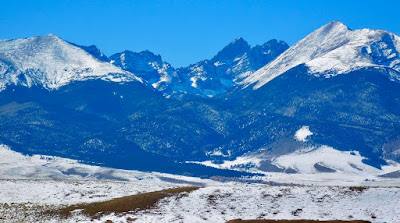 |
| Incredible crags |
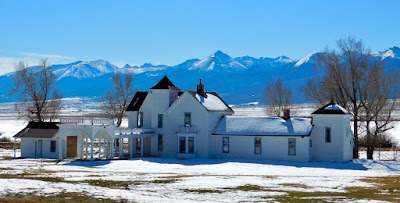 |
| Sentimental value |
 |
| Someplace I'd rather be |
 |
| Awesome size and power |
 |
| A jagged silhouette |
 |
| Rugged features |
 |
| Peaceful ambiance |
 |
| A blue mirage |
 |
| An abandoned homestead |
 |
| Grazing horses |
 |
| Wet Mountain Valley |
Big, Big Snow - The Gray Season
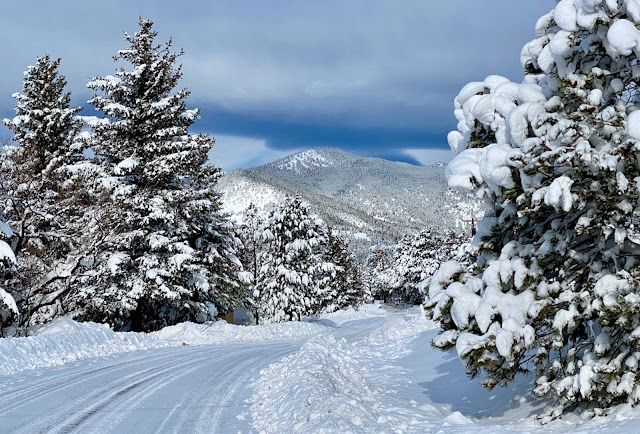 |
| Big, big snow |
It’s the middle of March and nature has not unexpectedly unleashed a furious blizzard that has buried the foothills with big, big snow. A sparkling Bergen Peak overlooks the aftermath from its lofty position.
The pyramid-shaped monolith dominates the landscape and becomes the center of interest in the Cezannesque composition. The pine trees are completely wrapped in cloaks of heavy, wet snow that cling to the conifers like glue.
Shot from a different perspective, the peaks portrait is enhanced by a unique border of branches and laurel. The mostly monochrome mountains are quite dramatic but after a season of gray, I’m anxious to experience the first colors of a much needed spring.
 |
| Middle of March |
 |
| A furious blizzard |
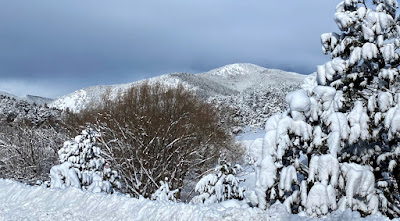 |
| Bergen overlooks the aftermath |
 |
| Pine trees are wrapped in snow |
 |
| Bergen Peak dominates the landscape |
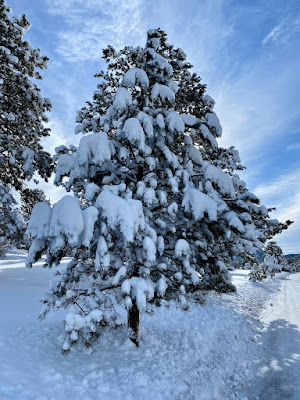 |
| Buried in snow |
 |
| Anxious for Spring |
 |
| Season of gray |
 |
| A Cezannesque landscape |
Cold, Blue Creek - An Extraordinary Wandering
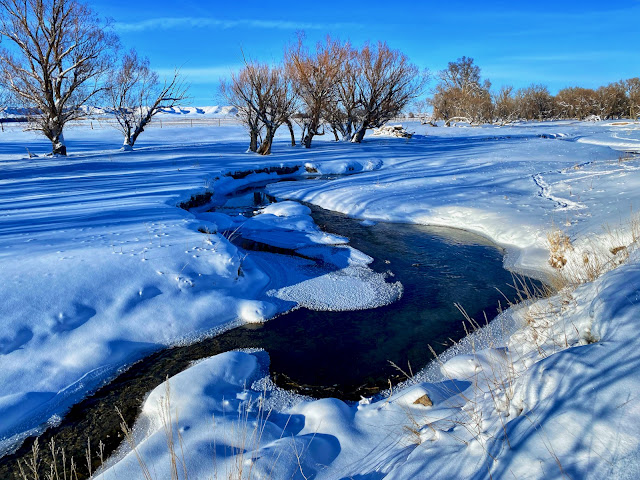 |
| Cold, blue creek |
It’s brutally frigid on the Arctic plain but a cold, blue creek rushes defiantly through a field of icy florets. Freshly fallen snow has created a deep embankment smoothed over by persistent winds.
Providing a warm note, reddish trees are gathered in clusters that are scattered throughout the winter pasture. At 22 degrees below zero, there isn’t another living creature to be seen, making the extraordinary wandering even more memorable.
The intense storm has cleared out but even a dazzling sun can’t warm up the cushion of cold air that has filled the void left behind. The stream of transparent indigo flows in a series of sharp s-curves through a vast country of desolation. Life on the prairie is hard.
 |
| Brutally frigid |
 |
| Deep embankments |
 |
| Icy florets |
 |
| Freshly fallen snow |
 |
| A dazzling sun |
 |
| An indigo stream |
 |
| Cushion of cold air |
 |
| Desolate country |
 |
| Life on the prairie is hard |
 |
| Reddish trees |
Red Mountain Range - Colored Pencil Drawing
 |
| "Red Mountain Range" Colored Pencil |
The Red Mountain Range sweeps southward across desolate ranch land where a barren tree sets the scale. It’s sunrise and the blue light has been scattered so crimson is the only color permeating the all-powerful peaks.
The snow-covered summits are still mostly in shade but the first highlights melt into a sun-bleached sky. The rugged chain is architectural in form as the violet shadows delineate the exciting shapes.
The remarkable geometry is drawn into the bottom lands where the snowy pastures are divided by horizontal bands of ochre agriculture. The dark foreground is a rough-hewn hedge of tall grass and sagebrush.
Visiting this site has inspired an artistic experiment about how best to express the transcendent nature of these mystical mountains. The series has come to an end but I’m not sure a satisfying conclusion has been achieved so further investigation may be required in the future.
Red Pyramid - Colored Pencil Drawing
 |
| "Red Pyramid" Colored Pencil |
Constructed miraculously by the powerful forces of nature, the Red Pyramid is an extraordinary edifice rising above a remote, desert plateau. The sacred structure embodies magnificence as its eternal grandeur has survived the flow of immeasurable time.
A symbol of rural culture, the perfectly shaped monolith is a meaningful monument venerated by the region’s local inhabitants. Majestic and complex, the mysterious peak is a unique source of intellectual and social power.
Steeped in divine superstition, the supernatural landscape is inextricably linked with the celestial. Echoing dignity and inspiring awe, the spiritual summit is a magical place to worship the unreachable mountain gods.
Red Alpenglow - Colored Pencil Drawing
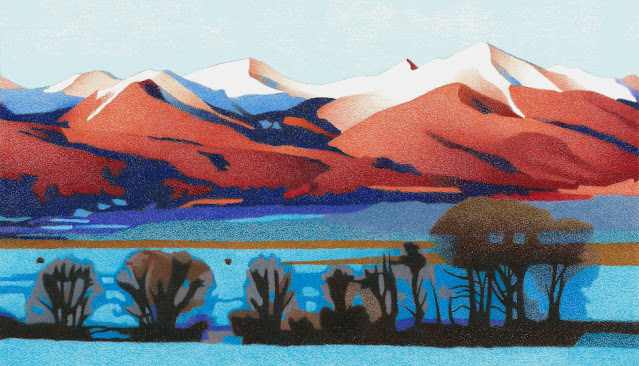 |
| "Red Alpenglow" Colored Pencil |
Down in southern Colorado a string of snow-covered mountains looms over a broad, ranchland valley. It’s just before dawn and the sun’s rays are streaming into the atmosphere where the light is reflected onto the peaks, creating a red alpenglow.
The drawing’s obscure foreground is still frozen in a state of mystic shadow. A stand of dark trees stretches across the page as the strange silhouette is outlined in blue, emphasizing the scene’s surreal essence.
The snowy pasture gradually gives way to the rosy cordillera where the shapes are defined by passages of delicate shading. Devoid of all detail, the white summits melt into a bleached sky, confirming the mountains’ sacred connection with heaven.
Rather than race to faithfully record the fleeting nature of a transitory sunrise, it seems like there must be something much deeper. An expressionistic approach releases the artist to pursue a more personal interpretation that depends on a certain truth through exaggeration.
Northport Blues - A Comforting Tapestry
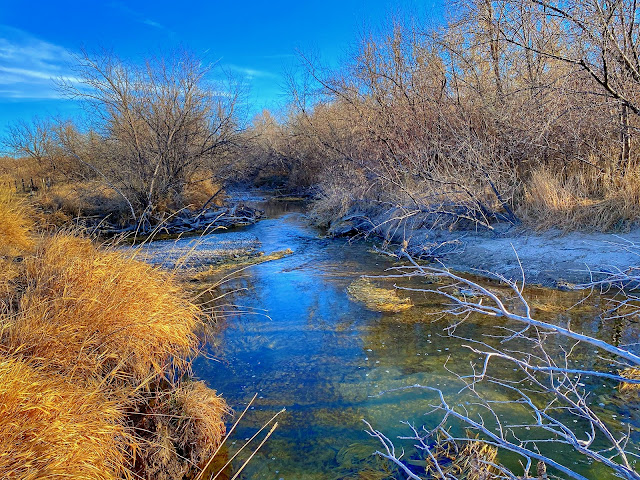 |
| Northport Blues |
Located on the distant side of the river, Northport is concealed in the faraway Sandhills of western Nebraska. From a high overlook, the idyllic valley is a comforting tapestry woven together from cottonwood trees, corn fields and cattle pastures.
While out on the prairie wandering with the pack, it feels like you can march a million miles without ever seeing another soul. We accompany a little creek as it makes a lonely journey through remote ranch land until the confluence with the doleful North Platte.
A herd of horses grazes near the riverbank but their curiosity is perked by the stranger who approaches their barbed fence line. Broncos are more prevalent than people as they are an important part of the very fabric that binds this frontier society.
The region has been in a terrible drought but as a result, dry air allows warm light to infiltrate the peaceful vale. With not even a patch of snow, there is no White Christmas but on this special evening while roaming around at sunset, the remarkable landscape glitters in silver and gold.
 |
| Glitters in silver and gold |
 |
| An idyllic valley |
 |
| Warm light |
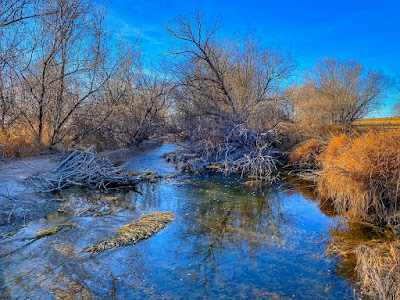 |
| A remarkable landscape |
 |
| A lonely journey |
 |
| A peaceful vale |
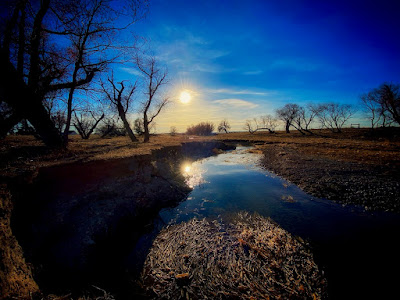 |
| Remote ranch land |
 |
| Wandering with the pack |
 |
| Horses bind society |
 |
| The doleful North Platte |
 |
| Horses graze near the riverbank |
 |
| The faraway Sandhills |
 |
| A comforting tapestry |
Sprague Lake Winter - Colored Pencil Drawing
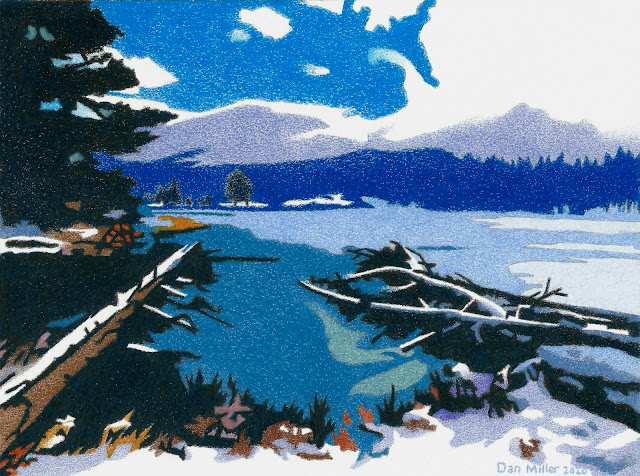 |
| "Sprague Lake Winter" Colored Pencil |
“Through art we can change the world.” ~ #twitterartexhibit
It’s a rough day in the Rocky Mountains but some of the prettiest hues on the planet can be seen at lonely Sprague Lake. A breaking storm gradually reveals a dynamic landscape distinguished by rugged beauty.
Concealed in a remote corner of Glacier Gorge, the reservoir is graced with coarse grandeur. During a tenacious winter, arctic weather crashes through the valley creating a callous environment.
A relentless force of frigid cold has infiltrated the turquoise tarn, freezing it solid. Casualties of an immortal west wind, the remains of fallen timber are strewn along the obscure shoreline.
Applied with a single layer of pure pigment, an icy palette of predominately blue emphasizes the already melancholy mood. The broken trees are angled in such a way as to exaggerate perspective lines, producing the illusion of deep space.
The solemn wilderness is topped by primordial peaks that melt into the celestial sphere. The speedy sketch attempts to express the harmony of color and composition found in nature, encouraging the artist to transform this ideal onto a grander scale.
Sprague Lake Winter is my contribution to the upcoming Twitter Art Exhibit: Cheltenham. This unique event is an international exhibition of original postcard art supporting The Leukaemia and Intensive Chemotherapy Fund.
LINC is a local charity that supports patients and families fighting blood cancer.
“We try to be their lifeline by offering emotional support, their relief by providing financial grants, their comfort by funding extras for the isolation side rooms and the breakthrough by funding research into potential new treatments ...
We can only be all of these things for patients and families if people choose to be the LINC too. Despite the reduced charitable fundraising opportunities during the lockdown, LINC has continued to be there for our patients. Money raised will enable LINC to fund the posts of two clinical psychologists who work to help patients cope with a cancer diagnosis as well as the added complications and fear of COVID. It is people like you who make this possible.” ~ LINC
Proceeds from TAE21 will enable LINC to continue to provide emotional and financial support for people receiving intensive chemotherapy.
Twitter Art Exhibit: Cheltenham is the twelfth installment of this open, international exhibition of handmade postcard art for charity, donated by artists from around the world.
Social media plays a major role in the Twitter Art Exhibit. It is their intention to tweet, share and promote contributing artists to thank them for their participation, and to make this event a success for all involved.
The event will be highly publicized and well attended by art buyers and enthusiasts, members of the press, local artists and the TAE community.
For more information, please check out this link: Twitter Art Exhibit
Guardians of Snow - Colored Pencil Drawing
 |
| "Guardians of Snow" Colored Pencil |
It’s the morning after a potent storm and Bergen Peak is a silvery citadel commanding a sparkling valley. Sprawled out below a turquoise sky, the backcountry landscape is blanketed by an encumbrance of fresh powder.
A ridge of supple conifers forms an impenetrable maze protecting the secluded kingdom from the busy world beyond. The Guardians of Snow glitter in the pristine surroundings, creating a vibrant mosaic of dark shadows and white highlights.
Up close, the forest is an abstract arrangement of nebulous shapes filled with a combination of flat and shaded hues. Blue, violet and gray are stippled across the page in free-flowing passages of pure pigment, exaggerating winter’s icy palette.
The somber color scheme betrays the glorious mood evoked from trudging through deep drifts just after dawn. Not even the frigid cold that grips the foothills can dampen the festive mood permeating a coming new year.
Canyon of Fire - Colored Pencil Drawing
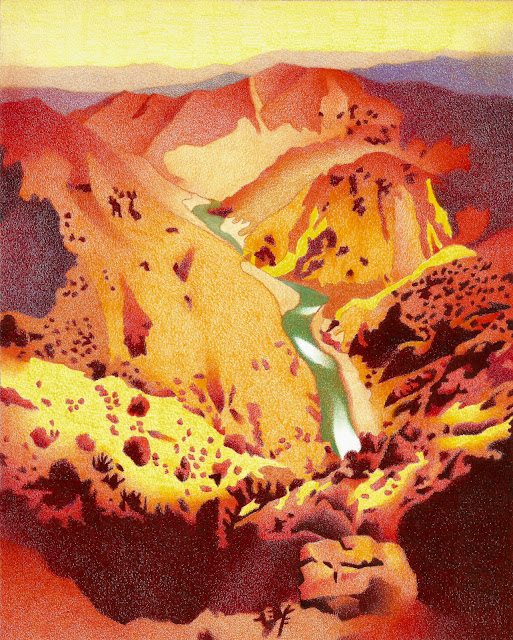 |
| "Canyon of Fire" Colored Pencil |
It’s summer on the desert plateau and an acid-green river slices through a blazing gorge. The ecosystem is an unbearable furnace where frustrated flora somehow survives the fierce environment.
A sweeping arrangement of enigmatic shapes is smudged into the picture’s foreground. The intentional smear inspires experimental effects that become contagious to the rest of the composition.
A garish-yellow sky radiates sour light that flashes through the infernal chasm. The sulfur peaks in the distance are softened by a subtle wash of smoky-violet haze.
Engraved into sandstone, the Canyon of Fire can only be conjured by a violent color fusion of ochre, mineral and tuscan. The Devil’s Abode dares the visitor to venture ever deeper into dangerous territory.
This rugged Ravine of No Return is riddled with a hostile array of yucca, cholla and prickly pear. Trapped in a boiling abyss of vertical walls, a steep slide of saffron offers a glimmer of hope for liberation from this savage landscape.
Sangre de Cristo Sunrise - Light Conquers Darkness
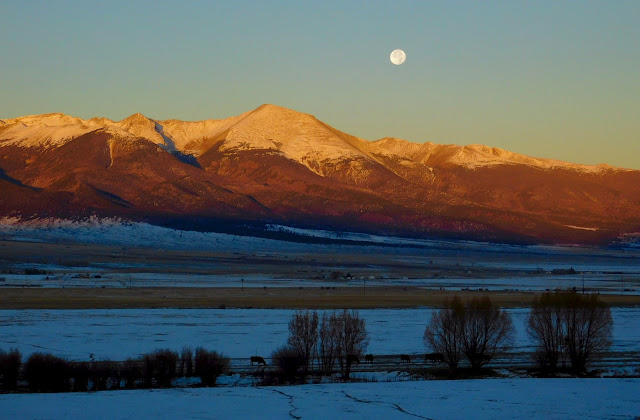 |
| Sangre de Cristo sunrise |
Winter nights in the high country are obscure, eternal and inclement and the inkwell of black firmament is glittered with a profusion of silver pinpoints that contradict the startling silence. It’s a beautifully eerie combination of contentment and discomfort.
Down in southern Colorado, there’s a mountain range that’s as rugged as it is remote. Rising out of a desert situation, the chain of needle-sharp peaks extends all the way into New Mexico, transporting its picturesque allure across state lines.
The mountains are called Blood of Christ and if you ever witness a Sangre de Cristo sunrise, you’ll understand why. Just before dawn, the first solar rays are reflected off of snowy summits, creating a rosy alpenglow that astonishes the retina.
The steady transformation unfolds even more dramatically when a setting, full moon shines brightly in a purple sky. The crimson sierras come into full relief as the forceful contrast between light and shadow defines the surreal shapes.
After the pinkish atmosphere gradually dissolves, a basin full of life begins to emerge. Cattle graze peacefully in a swale of vast grassland while a herd of mule deer gather around a pleasant reflection pond.
Making the trek to explore a region untainted by progress is a much need respite from complicated circumstances. Morning in the Wet Mountain Valley demonstrates an observable truth - even during times of turmoil, light conquers darkness.
 |
| Winter nights are eternal |
 |
| Full moon shines brightly |
 |
| Beautifully eerie |
 |
| Extending to New Mexico |
 |
| Rosey alpenglow |
 |
| Picturesque allure |
 |
| Needle-sharp peaks |
 |
| Surreal shapes |
 |
| Forceful contrast |
 |
| Blood of Christ |
 |
| The transformation unfolds |
 |
| A peaceful swale |
 |
| The atmosphere dissolves |
 |
| A basin full of life |
 |
| A pleasant reflection pond |
 |
| Morning in the valley |
 |
| Light conquers darkness |
Bishop Castle - Not for the Faint of Heart
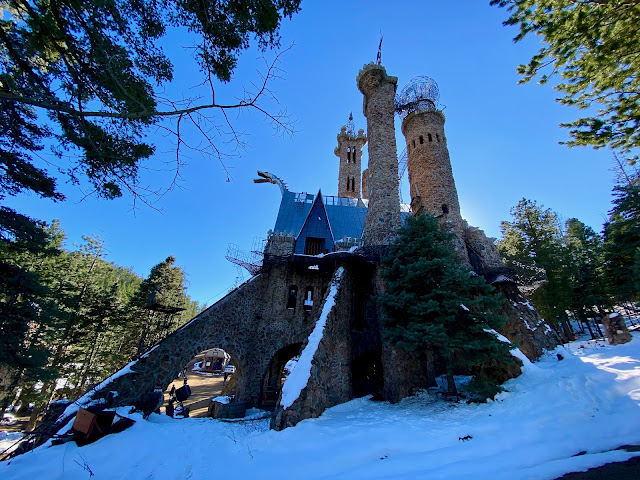 |
| Bishop Castle |
Rising out of Colorado’s remote Wet Mountain Range, Bishop Castle is a royal symbol of hard work, creativity and perseverance. Jim Bishop began building this unfinished, medieval fantasyland 60 years ago while using nearby rock and timber so the fortress blends neatly into the local environment.
The scary keep is designed to shoot straight skyward as a labyrinth of stone and iron ascends to dizzying heights. Not for the faint of heart, a strenuous climb up a spiral staircase is required to reach the summit of this monster house.
Once you reach the top, vertigo sets in and things begin to sway as intermittent gusts of cold air make your balance unsteady. The acrophobic experience is exacerbated by open windows, suspension bridges, exposed ledges and sketchy railings but the views are incredible.
Back down in the lower bowels of the austere bastion, a grand ballroom is illuminated by a series of beautiful stained-glass windows. Interesting details can be found throughout the citadel, enticing visitors to explore every nook and cranny.
From the outside looking up, the sheer scale of the structure begins to sink in, making you feel thankful to have both feet on the ground. The most fascinating piece is the fierce dragon that guards entry into this magical kingdom. Armed with a steely gaze, the silver serpent warns all who dare to approach - ENTER AT YOUR OWN RISK!
 |
| Rising out of the Wet Mountains |
 |
| An austere bastion |
 |
| Grand ballroom |
 |
| A silver serpent |
 |
| Spiral staircase |
 |
| Stained-glass windows |
 |
| Enter at your own risk |
 |
| Vertigo sets in |
 |
| Incredible views |
 |
| Acrophobic experience |
 |
| Monster house |
 |
| Medieval Fantasyland |
 |
| A scary keep |
 |
| A labyrinth of stone and iron |
 |
| A royal symbol |
High Country Clouds - Colored Pencil Drawing
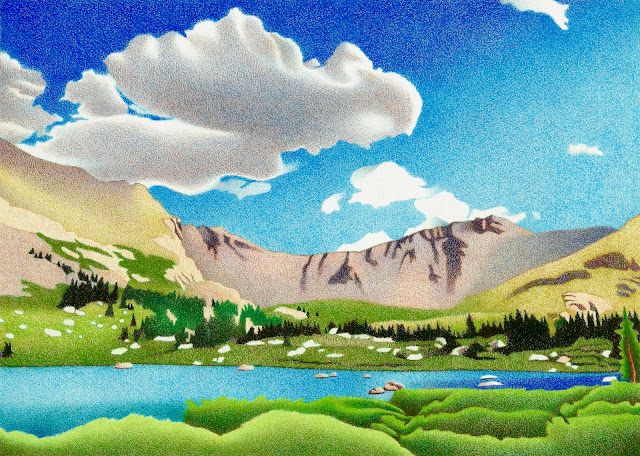 |
| "High Country Clouds" Colored Pencil |
It’s a perfect, summer day in Colorado’s Front Range where soft clouds drift across a hard wilderness that’s constructed from wood, rock and water. The remote cirque is set below a string of jagged giants who don’t possess even a trace of snow.
As is usual in the alpine environment, a dense thicket of verdant willows inhabit the outskirts of a pristine, glacial tarn. The surface of the ice-cold reservoir shimmers from a placid wind that rushes into the valley from the west.
The high country clouds are beginning to gather and their choppy shapes reflect the rugged contour of the mountain peaks that occupy space far below. The naturalistic vision is portrayed in a more accurate, traditional manner concerning line, shading, perspective, composition and color.
The subtle hues, observed in thin air, are a woven tapestry of the three primary colors, resulting in an endless gradation of gray. A delicate mix of ochre, pink and cerulean creates lively shadows that continuously sweep across an extraordinary landscape.
Lake Minatare - Something Surprising
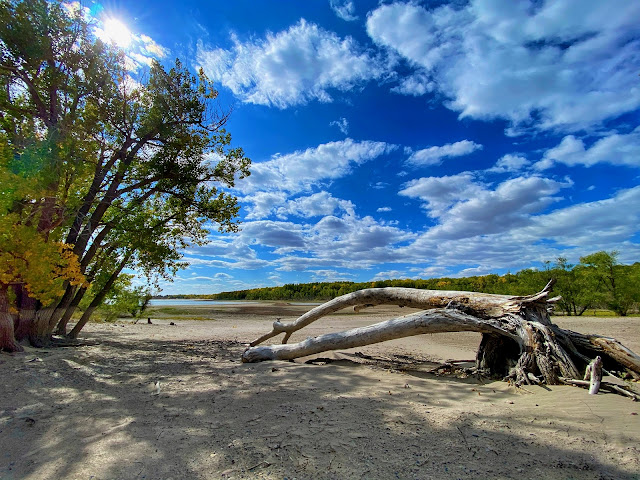 |
| Lake Minatare |
Built on the edge of Nebraska’s sandhills, Lake Minatare is a secluded oasis of clear water and dense woodland. More than a century old, the remote refuge is an irrigation reservoir supplying water to the North Platte Valley farmers.
The great, blue aqua fir is encircled by a hedge of cottonwood trees that glow dazzling yellow in the fall. A terrible drought has shrunk the shoreline, exposing a wide gap of white sand and a narrow land bridge.
Gazing out on the beach from within an exotic forest, gives the scene a strange, tropical feel. It’s hard to believe such a lush, riparian environment exists in the arid plains of the Great American Desert.
Overlooking the horseshoe-shaped bay, a line of rugged buttes creates an incredible backdrop for the unique landscape. Towering above the point of a narrow peninsula, a full-sized lighthouse seems out of place as it shines over a landlocked prairie paradise.
During a breezy autumn, big clouds are blown across the sky, creating moving shadows that glide silently over the rolling ground. Many miles from the main road, the area is a place of unsurpassed beauty which is something you might find surprising to exist in this - The Land of Corn.
 |
| A remote refuge |
 |
| Full-sized lighthouse |
 |
| Rugged buttes |
 |
| A unique landscape |
 |
| Dense woodland |
 |
| A prairie paradise |
 |
| A breezy autumn |
 |
| Unsurpassed beauty |
 |
| Great, blue aqua fir |
 |
| An oasis of clear water |
 |
| A terrible drought |
 |
| A lush environment |
 |
| An exotic forest |
Three Sisters Park - A Marvel to Behold
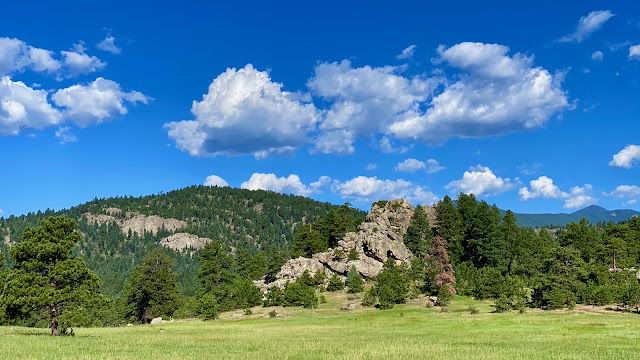 |
| Three Sisters Park |
Settled below the eastern slopes of Elephant Butte, there is a quiet quadrant in Three Sisters Park that features a rocky pathway which loops through a stark woodland. Earlier this summer, during a morning jaunt, the peace and tranquility of this lesser-known locale was readily apparent.
On the move by daybreak, the sun’s deliberate diffusion of clear light gradually transformed the look of the lush landscape. Shadows and luminance flickered through the forest creating an effect that fostered delight.
From the trail’s highest point, an open overlook offered unobstructed views of the landmark trio of rocky spires. Jutting into a powder-blue sky, the changing works of art are continually sculpted by wind, rain and ice.
One of the most interesting aspects of the area was the existence of old structures symbolizing the spirit of the pioneer west. I’m certain the evidence confirms that this wilderness, chock-full of wildlife, history and solitude, has always been and will continue to be a marvel to behold.
 |
| A trio of rocky spires |
 |
| A quiet quadrant |
 |
| Changing works of art |
 |
| A rocky pathway |
 |
| Wilderness solitude |
 |
| Clear light |
 |
| A lush landscape |
 |
| The pioneer west |
 |
| Settled below Elephant Butte |
 |
| A marvel to behold |
Arkansas River Canyon - A Cauldron of Fire
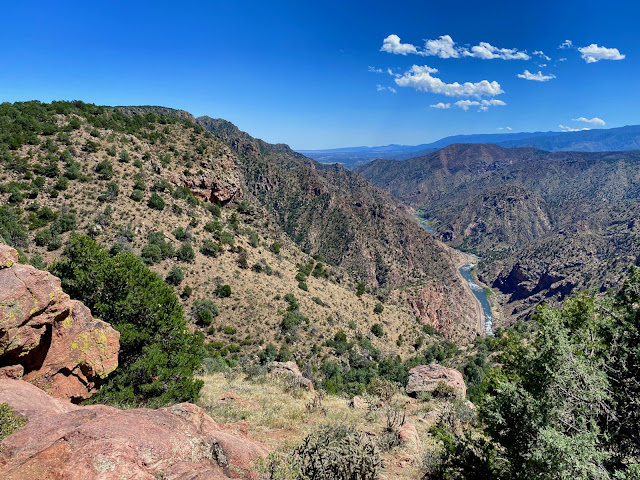 |
| Arkansas River Canyon |
Conceived in some of Colorado’s highest country, the Arkansas River rushes down through its namesake valley. Upon leaving the state, it continues an incredible journey across the southern plains until its confluence with the Mississippi River.
Near Cañon City, at one of its most volatile sections, the Arkansas’ whitewater rapids are threaded through a chasm of devastating beauty. The timeless crevice is sliced out of red earth and its jagged, rock walls are defined by eternal shadows of violet-blue.
While wandering up to the rim of this royal gorge, a satanic sun scorches the savage landscape. The devil’s domain is a vicious mixture of greasewood, cactus, yucca and sagebrush brewed in a cauldron of fire.
Upon reaching the cliff edge, the true elevation becomes an awesome reality whose dizzying concept is difficult to comprehend. The tiny ribbon of blue, winding its way through a graveyard of broken spires and collapsed structures, seems so far away.
Descending into this hellish environment from our milder, mountain climate is a stark revelation burned into a thirsty mind. Unfairly denounced as desolate, this mystical habitat is home to extraordinary plants and animals, instilling in me the utmost respect for life at the desert’s fringe.
 |
| Devastating beauty |
 |
| A timeless crevice |
 |
| The rim of a royal gorge |
 |
| An awesome reality |
 |
| Stark revelation |
 |
| A satanic sun |
 |
| The Devils's domain |
 |
| A hellish environment |
 |
| A cauldron of fire |
 |
| A savage landscape |
 |
| Difficult to comprehend |
 |
| A mystical habitat |
 |
| Life at the desert's fringe |
 |
| Denounced as desolate |
Ghost Horse - Colored Pencil Drawing
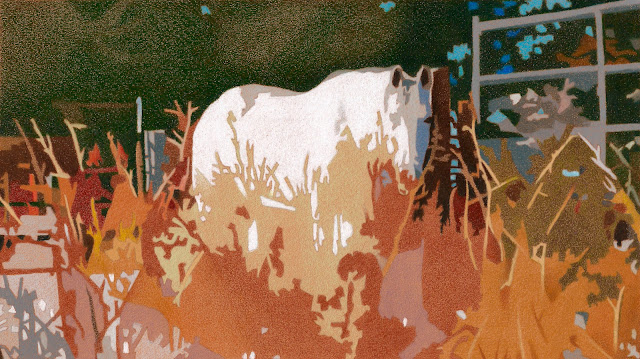 |
| "Ghost Horse" Colored Pencil |
Floating out of an eerie windbreak, a white apparition confronts the viewer face-to-face. It’s a piercing dawn in the Sandhills as the ghost horse haunts a prairie hacienda.
The pale wraith is peaceful and harmless as it drifts through a moat of tall grass. Trying to bridle him, a rough-hewn stockade is suggested by an irregular grid of interlocking, geometric shapes.
Defined by a steel-blue shadow, the phantom’s head is the portrait of simplicity. His shaggy, winter robe is conveyed by the purest of white with touches of cool gray smudged into the shape.
With the rapid rise of technology, automation and manufacturing, we creep ever closer to becoming the ultimate, urban civilization. It’s heartening to come home to western Nebraska where vast tracts of ranch land scenery can still be found, summoning the resilient spirit of the Old West.
Helms Lake - Into the Abyss
 |
| Helms Lake |
Ensconced in the granite bowl of a spectacular gorge, Helms Lake is an aqueous repository of visually stunning scenery. The soaring tarn lies tacitly above tree line but still far below a fortress of towering peaks.
The difficult journey to this remarkable, alpine refuge begins in a forest of lodgepole pine and progresses through tremendous groves of radiant aspen. A cascade of icy snowmelt traces the trail and the comforting sound of rushing water placates the soul.
It’s a dim aurora as the morning light yearns to infiltrate the dense interior of the primeval wilderness. The diverse geography is a succession of tiered plateaus creating a grand staircase that culminates in a basin of otherworldly beauty.
While straining upward through different life zones, the tenacious trees gradually become more stunted and twisted before suddenly giving way to a glorious tundra. A maze of willows insulates the remote reservoir, creating a buffer between a rugged world and smooth water.
Piercing the placid surface, a cavalcade of large boulders is strewn haphazardly within the pond’s oval border. The cold water is clear like glass as it perfectly reflects the gathering clouds, painting the picture of an approaching storm.
During the descent, light rain comes down as well - offering some relief from the unusually unbearable heat in the high country. Following a brisk creek out of the big valley, numerous, single-log bridges are perilous crossings bringing us closer to home.
Back in the bottomlands, it’s a paradise for wildlife because of the vast bounty of food, water and shelter. Bighorn sheep graze across the lower meadows, red squirrels dominate the woodland, moose tread through the marsh and marmots scurry near rocky outcrops.
The unforgettable expedition was a strenuous trek that pushed personal stamina to its maximum limit. It was worth the colossal effort as Helm’s Lake sits in an isolated abyss shielded by sawtooth peaks while confirming faith in the healing power of pristine nature.
 |
| Moose in the marsh |
 |
| Yellow-bellied marmot |
 |
| Paradise for wildlife |
 |
| Morning light yearns to infiltrate |
 |
| Cascade of snowmelt |
 |
| An alpine refuge |
 |
| Perilous bridge |
 |
| Rushing water |
 |
| A big valley |
 |
| A brisk creek |
 |
| A rugged world |
 |
| Primeval wilderness |
 |
| A strenuous trek |
 |
| Diverse geography |
 |
| Glorious tundra |
 |
| A maze of willows |
 |
| Ensconced in a granite bowl |
 |
| A soaring tarn |
 |
| The cold water is clear |
 |
| Cavalcade of boulders |
 |
| Stunning scenery |
 |
| Gathering clouds |
 |
| An isolated abyss |
 |
| Pristine nature |
Abert's Squirrel - Give and Take
 |
| Abert's Squirrel |
Some years I barely see them at all but this summer the Abert’s Squirrel has been unusually conspicuous. They have allowed me to document, through photography, their delightful behavior.
The younger ones are especially curious and playful as they scurry down within arm’s length, taunting me to come closer. If I resist the dare, they continue to close the gap but if I make the slightest twitch, they rocket back to the tree trunk.
Exhibiting no fear of heights, the mature adults perch safely on tree limbs high above the forest floor. Early mornings are spent on the ground cautiously collecting pinecones for breakfast.
The large, bushy tail and long ear tufts are the distinctive features of this endearing creature. Compared to the rowdy, little red squirrel, who thinks it owns the forest, the Abert's is quite charming.
A story about the simple life of a squirrel may seem tedious but we can learn much from its interesting and complex partnership with the ponderosa pine tree. Also known as the tassel-eared squirrel, it is strictly confined to ponderosa pine forests.
The tree provides not only a home but also most of its diet. In exchange for food and shelter, the squirrel spreads fungal spores around the tree that are beneficial to the pine's health.
The squirrel has to manage its fragile resource wisely because if the exploitation becomes too extensive, the tree will go into defense mode. It will produce extra terpenes (chemicals that give pines their scent) to ruin the squirrel's appetite.
The tree's reaction evicts the squirrel but at the cost of reduced vitality and a slower growth rate. In other words, they need to get along in order for each species to thrive. Just like any prosperous relationship between plant and animal there must be some give and take.
 |
| They have been unusually conspicuous |
 |
| Delightful behavior |
 |
| Curious and playful |
 |
| They scurry down the tree |
 |
| Taunting to come closer |
 |
| Quite charming |
 |
| Large ear tufts |
 |
| It manages its resource |
 |
| Tassel-eared squirrel |
 |
| Confined to a ponderosa pine forest |
 |
| Give and take |
Forest Bison - Buffalo Calves
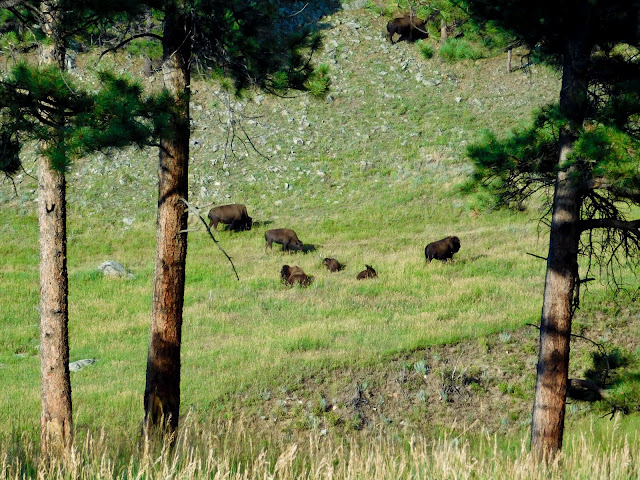 |
| Forest Bison |
An enduring symbol of the Great Plains, the American Bison was driven to the brink of extinction during Westward Expansion. After a modest recovery, they can now be found in a woodland that adorns Colorado’s Front Range foothills.
The mountain herd roams through a labyrinth of sharp slopes, draws, gulches and ravines that comprise Genesee Park. There is lots of activity at the forest’s edge where this year’s spirited younglings kick, buck, run and play from dawn until dusk.
Born in May, the precocious devils are born into the world big and agile. The whole congregation is pretty protective and the cows collectively take care of the calves for about a year.
They are reddish-orange at birth but their coloring gradually deepens in concert with the development of their fierce independence. On this warm summer evening, the different individuals engage in various behaviors such as resting, grazing and rock climbing.
The easy-going adults move efficiently through the timber as they’ve adapted wonderfully to their high altitude home. Even during the harsh winter, these confident creatures bulldoze through deep snow and conquer the steepest hills.
Taking his cue from the long shadows that creep across the landscape in low light, the dominant bull guides his scruffy flock into a deep valley. Vanishing below an array of pale peaks, the last of the buffalo fades quietly into the gloaming like a dark apparition.
 |
| Found in a woodland |
 |
| An enduring symbol |
 |
| Calves are born in May |
 |
| A deep valley |
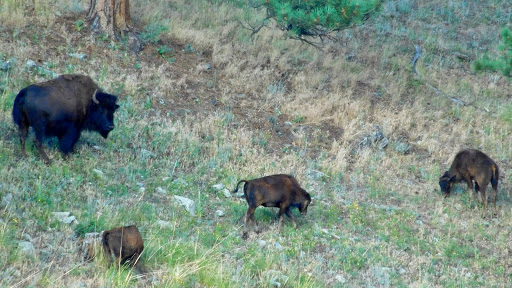 |
| They kick, buck and play |
 |
| They are reddish-orange at birth |
 |
| They've adapted wonderfully |
 |
| The whole congregation is protective |
 |
| A bull guides his flock |
 |
| Resting calves |
 |
| An array of pale peaks |
 |
| Genesee Park |
Blue Bergen Peak - Colored Pencil Drawing
 |
| "Blue Bergen Peak" Colored Pencil |
Below a blue Bergen Peak, the late winter landscape is a clash of complementary colors, changing seasons and converging perspectives. The spirited mood is heightened by stylized shapes, gradual shading and the application of dense pigment.
Burning under a bright sun, the fiery field in the foreground blazes across the picture plane from crimson red to Spanish orange. The confusion of excessive detail has succumbed to a smooth gradient of analogous colors.
A stubborn remnant from a recent storm, a drift of deep snow lingers in the shadows of a troublesome gulch. Patches of still more snow are scattered across the vermillion grassland that recedes into the distance.
A remarkable pine tree explodes into the composition from the right, dwarfing the other elements during its desperate call for attention. It’s vibrant foliage is an organic swirl of light and shadow that is splayed out into the air.
The sky is broken into two tiers of different compartments separated by a soft-edged line. Pockets of lucid atmosphere show through the bulky tree’s canopy, allowing birds to fly through freely.
Bergen Peak’s boxy profile is painted with blue which designates it to the background. Its dark value sneakily compresses the space, creating a tension that adds subtle drama to the scene.
Another in the Bergen Peak series, this drawing is more expressive as it displays artistic license with flowing contours and saturated color. The mountain is a beautiful, local landmark whose perfection is impossible to reproduce but it’s intense magnetism has issued a challenge that is too strong to resist.
The Wapiti's World - Elk Calves
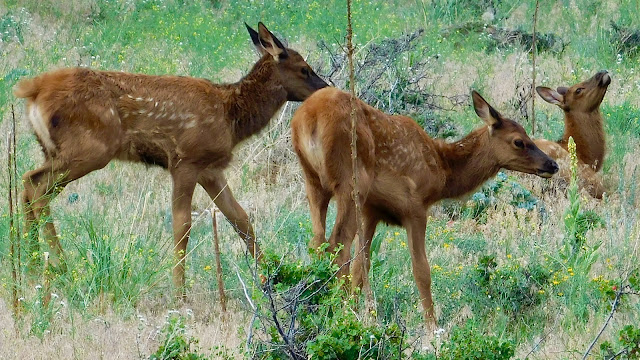 |
| Elk Calves |
Rocky Mountain Elk are the undisputed symbol of Evergreen, Colorado where they roam freely from one end of the community to the other. Their annual movements are synchronized with the seasons, becoming an integral part of the natural rhythm of life that exists in the Front Range Mountains.
Yearly events staged by the local weather, flora and fauna are predictable benchmarks offering some comfort during these uncertain times. Trustworthy examples featuring all kinds of wildlife occur like clockwork and sometimes the display is quite spectacular.
The great elk rut in the fall is one such spectacle when massive bulls fight for possession of a harem of breeding cows. During the winter, the herd congregates en masse while struggling to survive harsh conditions worsened by deep snow, frigid temperatures and a meager food supply.
Returning in the spring, the haggard animals look gaunt and shaggy but after a few weeks of gorging on fresh grass, their form becomes sleek and well-nourished. This is when the pregnant cows break from the group and give birth to rambunctious little ones.
By the middle of summer, the elk population explodes with the sudden arrival of so many white-spotted calves. Unable to stay still, the babies are up and moving almost immediately, exploring their wondrous surroundings.
Just like any happy kid, they squeal with delight - running, kicking and bucking while playing in a field of tall grass. Craving some much needed rest, the exhausted mothers are remarkably tolerant of the childish antics that swirl around them.
As the elk calves grow stronger, the cycle continues and soon the bulls’ haunting calls will fill the air, foretelling the first snow. Disheartening as it may be with the planet currently turned upside down, it’s nice to know that the wapiti’s world remains the same.
 |
| Middle of summer |
 |
| Wondrous surroundings |
 |
| Unable to stay still |
 |
| Undisputed symbol of Evergreen |
 |
| Annual movements |
 |
| Happy kids |
 |
| The population explodes |
 |
| A predictable benchmark |
 |
| White-spotted calves |
 |
| Rambunctious little ones |
 |
| The mothers are tolerant |
 |
| Childish antics |
 |
| A trustworthy example |
 |
| The cycle continues |
 |
| The wapiti's world remains the same |
Mountain Basin, Summer - Colored Pencil Drawing
 |
| "Mountain Basin, Summer" Colored Pencil |
This unforgettable landscape is located in Colorado’s southwestern mountains where during the summer, winter snowmelt is washed through a deep basin. The tapestry of varied terrain is a fantasyland featuring willows, wildflowers and a dazzling waterfall.
Soaring over the incredible scene, jagged peaks possess a pinkish hue in the afternoon’s soft ambiance. The mellow light creates elongated shadows that define the fantastic shapes inhabiting the scenic valley.
The luminous blue sky is reflected in the thread of clear creek that carves a pathway through dense underbrush. A precipice of golden cliffs forms a steep stairwell that descends all the way down to the water’s edge.
Slabs of white snow still cling to the rock wall that encloses the wondrous canyon, betraying the fleeting nature of the dry season. Before long, the moraine will be concealed under a thick layer of glacial ice but this sketch is a sensitive reminder of a joyful, summer evening spent in the San Juans.
Bergen Gulch - A Discreet Wetland
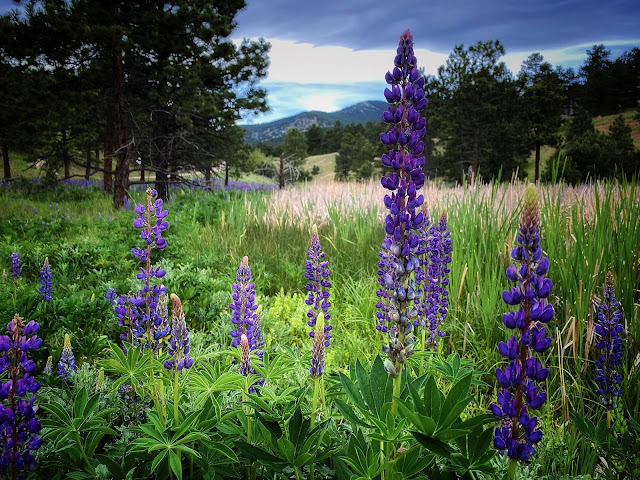 |
| Bergen Gulch |
Settled below the southern slopes of Bergen Peak, Bergen Gulch is a discreet wetland that supports flowers, birds and wildlife. This time of year the cattails are beginning to ripen and the lupine are in full bloom so blackbirds and elk engage in a territorial dispute over the bountiful land.
Filling the discreet ravine, the large-leaved lupine are massive plants whose ladder-like blossoms climb towards the sky. The hungry wapiti are anything but gentle as they tromp through the purple field, consuming a huge swath in a single sitting.
The little red-wings have fledged so while they’re learning to fly, their protective parents aggressively dive-bomb anyone who happens to wander into the area. The conglomeration of chickadees, juncos and nuthatches is small but noisy as the busy birds scour the ponderosa pine for anything edible.
Branching off from Bergen Peak’s most beautiful side, the muddy drainage, depending on the season, varies from a trickle to a deluge. The small valley is surrounded by steep hills, littered with fallen logs and broken by rocky ground, making nimble footing a necessity.
After the chaos of completing another week, the serenity from spending time in nature is sought but there is difficulty finding somewhere secluded. During the summer, when the main parks are occupied by lots of people, this place always seems to be pretty quiet.
 |
| Southern slopes of Bergen Peak |
 |
| A discreet wetland |
 |
| Lupine are in full bloom |
 |
| Large-leaved |
 |
| Massive plants |
 |
| Ladder-like blossoms |
 |
| Elk territory |
 |
| Bountiful land |
 |
| Hungry wapiti |
 |
| Spending time in nature |
 |
| In a purple field |
 |
| The place is pretty quiet |
 |
| Consuming a huge swath |
Summer Light and Shadows - A Somber Vignette
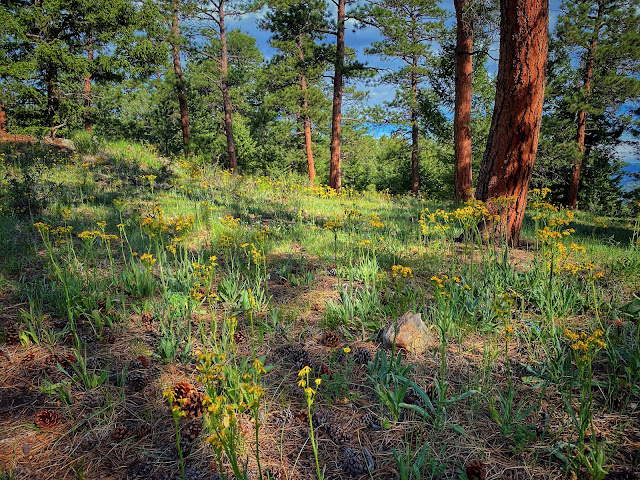 |
| Summer light and shadows |
During this season, when the weather is warmer and the days are longer, the foothills landscape is defined by distinctive summer light and shadows. Evenings are particularly special because beams from the setting sun pilfer through cloud congregations, resulting in a rather dramatic effect.
At dusk, the mountains turn blue and the trees in the meadow, before casting long shadows across the undulating field, are traced by a luminance that glows. Delicate wildflowers become translucent when their obscure niche is struck by the fading radiance.
Sunsets at the lake are magnificent because now water, which reflects the glorious scenery, has been added into the equation, expanding your viewing pleasure. The peaceful ambiance becomes even more soothing when the rain settles in and, rather than induce melancholy, the muted atmosphere germinates solutions to perplexing problems.
The blossom garden is bursting with optimism as the wind-blown flowers dance joyfully across the preserve of fresh greenery. The gorgeous grounds are a cheerful place to linger because ebullient portraits can be composed from out of the darkness of a somber vignette.
 |
| The weather is warmer |
 |
| Fading radiance |
 |
| Distinctive light and shadows |
 |
| Delicate wildflowers |
 |
| Forest dawn |
 |
| Evenings are special |
 |
| Beams pilfer through clouds |
 |
| A dramatic effect |
 |
| Bursting with optimism |
 |
| An obscure niche |
 |
| Dancing joyfully |
 |
| An ebullient portrait |
 |
| Blossom garden |
 |
| Blue mountains |
 |
| Peaceful ambiance |
 |
| Gorgeous grounds |
 | ||
A cheerful place
|
 |
| Traced by luminance |
 |
| Viewing pleasure |
 |
| Soothing rain |
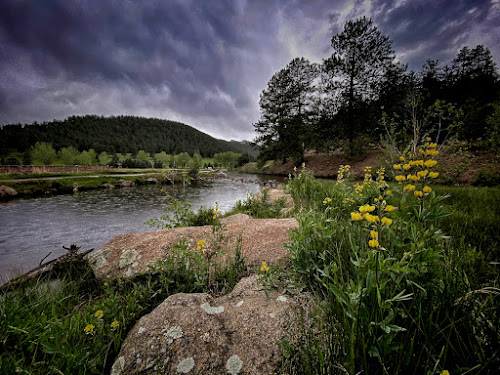 |
| Muted atmosphere |
 |
| Induced melancholy |
 |
| A somber vignette |
 |
| Fresh wildflowers |
 |
| Luminance |
Roxborough State Park - Garden of Providence
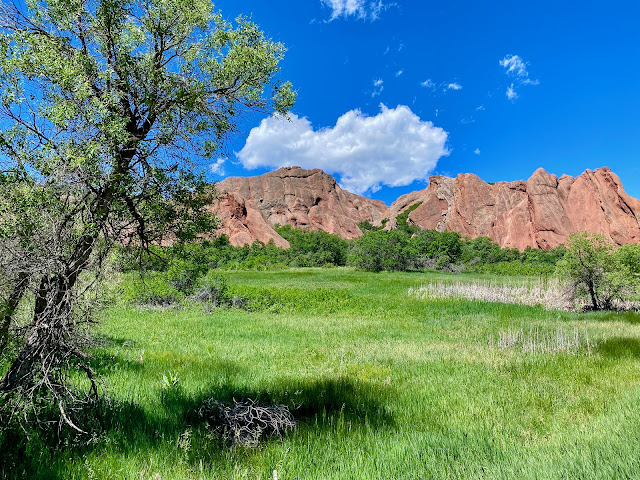 |
| Roxborough State Park |
Situated at a geological flash point where the prairie meets the mountains, Roxborough State Park is a study in contrast between shapes, textures and colors. Sharing space in this rare environment, smooth, angular, red rocks shoot skyward from out of a bed of broken, nebulous, green scrub-brush.
The spectacular esplanade is positioned below the Front Range on a narrow plateau overlooking the South Platte River wetlands. A long string of jagged peaks recedes into the distance and fuses with a solid plate of brilliant, blue sky.
During the summer, sweltering heat is stifled by a taut breeze that gusts through a labyrinth of dense woodland, open meadows and vermillion spires. The isolated Eden is unpopulated by human presence and it is mostly deserted except for a plethora of butterflies, a few deer and a pair of hawks circling overhead.
The highlight of the preserve is a deep chasm named Fountain Valley where the inspiring views from an overlook are expansive. Once inside the slender gorge, sandstone towers surround the hiker, cutting off any connection with the outside world.
Long, blue shadows define the rocks’ surreal shapes in the low, morning light. Down in the lower end of the canyon, near the historic Henry Persse Ranch, an incredible formation is called Washington Rock because it actually looks exactly like George Washington’s profile!
Willow Creek is a diminutive gulch that drains this natural city of crimson crags and leads the visitor back down to a tamed grassland. Similar landscapes along the corridor are known as Garden of the Gods and Garden of Angels but after my experience in this Garden of Providence, I’ve discovered it to be just as divine.
 |
| Prairie meets the mountains |
 |
| A study in contrasts |
 |
| An isolated Eden |
 |
| A rare environment |
 |
| A long string of jagged peaks |
 |
| A spectacular esplanade |
 |
| Sandstone towers |
 |
| Crimson crags |
 |
| Washington Rock |
 |
| Fountain Valley |
 |
| A narrow plateau |
 |
| Surreal shapes |
 |
| Labyrinth of dense woodland |
 |
| Garden of Providence |
The French Quarter - Heart-wrenching Beauty
 |
| The French Quarter |
The French Quarter in New Orleans is chaotic, dirty, dark, decadent, debased, lurid, raucous, salacious, shocking, unrestrained and wild, and I love it. The old market is a potent potpourri of people, sights, sounds and smells that overload your senses in a way you’ve never experienced before.
A modest family man, I resist the temptation to partake in the public depravity proceeding all around me. Instead, I melt into the dank alleyway and take photographs of the eclectic architecture and outrageous activities.
The rowdy neighborhood is overcrowded with excited revelers who have apparently overcome their natural inhibitions. Visitors hang over the wrought iron railings while impromptu parades march through the streets, impeding the progress of any automobiles crazy enough to enter the fray.
The din of this extravagant absurdity is drowned out by the live music that explodes from every orifice in the locale. The exuberant mixture of melodies is a simmering stew celebrating the diversity of different cultures.
This historic district of debauchery is steeped in superstition where the practice of necromancy is an esteemed vocation. It makes sense because the bizarre behavior exhibited by tourists in this City of Sin can only be explained by the mastery of witchcraft.
If you look closely, there are scenes of heart-wrenching beauty like the horse-drawn carriage clopping over textured streets below buildings of defiant dignity. Colorful flowers burst forth from every nook and cranny, and lush gardens of tropical foliage are topped by exotic palm trees.
Tall structures rise above narrow corridors obstructing my view of the sky creating claustrophobic anxiety for someone used to wide-open spaces. The funky feel is exacerbated by the garish colors and eye-popping signage adorning every store front.
Fifteen years after Katrina ravaged the gulf coast, scars from that horrendous storm can still be seen. Ever since Andrew Jackson saved the settlement from British occupation, the city of New Orleans has suffered several catastrophes but the resilient citizens have always found a way to recover and rebuild.
Spanned by a sparkling, silver bridge, the muddy Mississip is home to pelicans, seagulls and cargo ships of all shapes and sizes. Life on the bayou couldn’t be more foreign to me as I’m accustomed to the thin air and deep snow characteristic of the Rocky Mountains.
With the summer season suddenly unfolding, my hopeful itinerary is penciled in to go west. I don’t know if I’ll ever make it back to the Mississippi River Delta but if I don’t, I will always have unforgettable memories of the time I did spend in the Big Easy.
 |
| Narrow corridors |
 |
| The old market |
 |
| A potent potpurri |
 |
| Necromancy is esteemed |
 |
| Historic district |
 |
| Extravagant absurdity |
 |
| Exuberant mixture |
 |
| Eclectic architecture |
 |
| Horse-drawn carriage |
 |
| Andrew Jackson is a hero |
 |
| Entering the fray |
 |
| A funky feel |
 |
| Cargo ships |
 |
| Sparkling, silver bridge |
 |
| Memories of the Big Easy |
Elk Meadow Mornings - Environmental Healing
 |
| Environmental Healing |
While we struggle to maintain some sense of normalcy, nature is thriving evidenced by cleaner air, clearer water, active wildlife and bountiful birds. This spring, trails leading into the backcountry are deserted so the environment is healing at a noticeably accelerated pace.
Shackled by a strict quarantine, I spend my mornings traipsing through Elk Meadow with a camera slung over my shoulder before sheltering in place the rest of the day. The daily routine begins in a spacious meadow and expands gradually into a lively woodland.
Some days are more photogenic than others but in general there has been a plethora of engaging creatures. Right at the forest’s edge is where most of the action occurs because the animals can easily withdraw into the nearby safe haven.
Elk and mule deer graze out in the open on shoots of new grass while up in the ponderosa pine trees, red and Abert’s squirrels scamper from branch to branch. One morning I crossed paths with a curious coyote which was remarkable because they're not normally seen in broad daylight.
A diverse variety of bird species are building nests and I’ve been thrilled to see juncos, jays, nuthatches, chickadees, flickers, robins, sparrows and a Say’s phoebe. Down in the valley proper, in the shadow of big peaks, red-tailed hawks soar over a vast grassland that supports a profusion of bluebirds and meadowlarks.
Over the last few weeks, bulbous clouds have unleashed a stream of unpredictable weather ranging from fierce blizzards to torrential rainfall to searing heat. Mostly this difficult time has been an excruciating season of hope, inspiring a spirit of rebirth and new growth.
We have learned a great deal during the prolonged hiatus and a positive result from this unusual experience is that we can apply an enlightened perspective to starting over. I believe the population will eventually recover from this devastating disease but our society will never be the same.
 |
| Say's Phoebe |
 |
| Coyote |
 |
| Red squirrel |
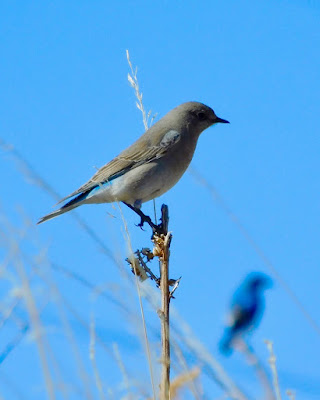 |
| Mountain bluebirds |
 |
| Western bluebird |
 |
| Mountain bluebird |
 |
| Northern flicker |
 |
| Mule deer |
 |
| Mule deer at the forest's edge |
 |
| Mule deer |
 |
| Mountain chickadee |
 |
| Western bluebird |
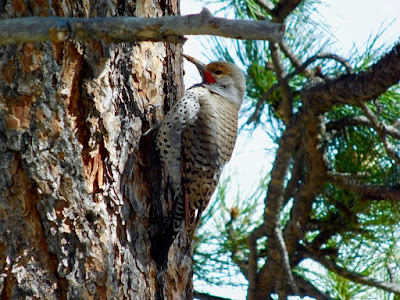 |
| Northern flicker |
 |
| Stellar's jay |
 |
| American robin |
 |
| Vesper sparrow |
 |
| Western meadowlark |
 |
| Western meadowlark |
 |
| Abert's squirrel |
 |
| Abert's squirrel |
 |
| Rocky Mountain elk |
 |
| Rocky Mountain elk |
 |
| Western terrestrial garter snake |
 |
| American bison |
 |
| Red-winged blackbird |
 |
| Red-winged blackbird female |
 |
| Barn swallow |
 |
| Northern flicker |
 |
| Prairie lizard |
 |
| Wilson's snipe |
 |
| Broad-tailed hummingbird |
 |
| Song sparrow |
 |
| Canada geese |
 |
| Variegated fritillary |
 |
| Mule deer |
 |
| Brewer's blackbird |
 |
| Broad-tailed hummingbird |
 |
| Mule deer |
 |
| Dark-eyed junco |
 |
| Barn swallow |
Elk Meadow Mornings - Phenomenal Light
 |
| Phenomenal Light |
A long time ago at the outbreak of a confusing contagion, the foothills were pummeled by a big, spring snow. The morning after, Elk Meadow was interred in an arctic valley of ice.
Dawn had broken clear and cold as the storm quickly dissipated, revealing the faint contour of Bergen Peak. Frosted pine decorated the hillside, windswept drifts choked the gulch and strong sunlight resulted in an effect of phenomenal light.
The moody, gray sky was stubborn and it would not submit to the comfort of clarity for long. Foretelling desperate times ahead, the temperamental weather sullied the already dark mood.
The restless clouds were constantly shifting shapes, creating an unsettled panoramic vignette that tempered any sense of optimism. They converged and closed back in, crushing a hopeful spirit while erasing the skyline from view.
A second wave steam-rolled over the pass and we suffered the foreboding atmosphere in silence. Blue skies had made a brief appearance leading us to believe the storm was over but as the clouds reconvened, we discovered that it was really just beginning.
 |
| Pummeled by snow |
 |
| Phenomenal light |
 |
| Arctic valley of office |
 |
| Add caption |
 |
| Blue skies over Bergen Peak |
 |
| A hopeful spirit |
 |
| A dark mood |
 |
| Tempermental weather |
 |
| Frosted pine |
 |
| A foreboding atmosphere |
 |
| Spring snow in the foothills |
 |
| A decorated hillside |
 |
| Windswept gulch |
 |
| Snow-dusted boulders |
 |
| It was just beginning |
Potomac River - Colored Pencil Drawing
 |
| "Potomac River" Colored Pencil |
It is a sultry, summer evening in the Blue Ridge Mountains and the Potomac River drifts wearily through the West Virginia wilderness. Situated here, at the confluence with the Shenandoah, Harper’s Ferry is a historical village associated with Southern succession and the Civil War.
Squeezed into a spectacular gorge, the patriotic waterway encourages a slower pace notwithstanding its proximity to the bustle of big city life. The jungle environment is bursting with flowers and foliage that seem to be thriving despite the searing heat and tremendous thunderstorms.
An old railroad bridge, lush green hills and a purple sky are reflected faithfully across the surface of shallow water. The sharpest contrast occurs below the train trestle where the drawing’s darkest shadows are juxtaposed next to the sunniest highlights, creating some drama in the otherwise serene setting.
Patches of color close in value are paired with soft gradients that do not necessarily describe form but become design elements that unify the whole. A tapestry of cheerful pigment fills an abstract arrangement of organic shapes that when fused together give the impression of a bucolic scene.
Finally a dark silhouette of foreground vegetation frames the composition, creating a window into an unfamiliar, eastern landscape. While walking down the Appalachian Trail, contemplating a countryside so different from home, the conclusion must be that the beauty discovered in this place is just as divine as that found on the western frontier.
Simplicity - The Greatest Adornment of Art
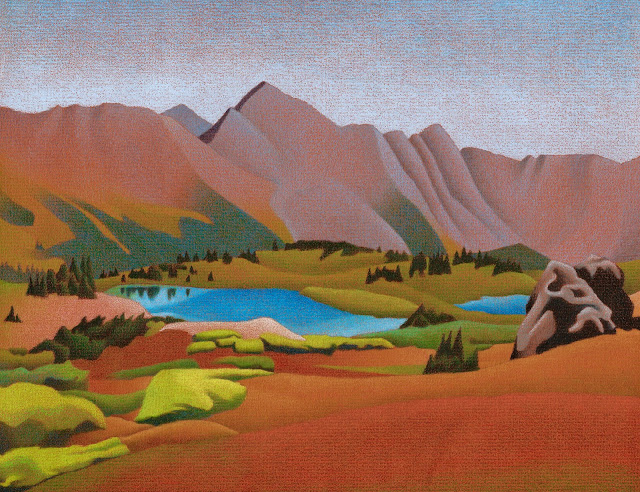 |
| Simplicity |
“As I grew older, I realized that it was much better to insist on the genuine forms of nature, for simplicity is the greatest adornment of art.” ~ Albrecht Durer
Evergreen, Colorado is that magical place situated over the rainbow. Upon arriving 22 years ago, we discovered a land of silvery aspen where bluebirds fly, red foxes hide and each morning begins with a golden sunrise. Away from the confusion of suburbia, I found more time to simplify my work. The true essence of nature became obvious.
To simplify is difficult. I like to choose a motif and use all of my senses in a thorough examination. Observe the subject intensely and memorize the attractive, essential features. My camera is an indispensible tool in the process. It’s a digital eye that freezes a fleeting moment in time.
I have steep reverence for nature so when I wander alone into a remote wilderness, it’s a spiritual experience transporting me closer to heaven. In order to create an honest representation of the image fixed in my mind, the scenery is simplified while using bold contours and coloring. My drawings are heartfelt expressions depicting the grandeur of the American West.
Spectacular landscapes are much harder to break down because in my enthusiasm to replicate the scene, the inclination is to include every detail. Unfortunately when that happens, the soul of a place becomes lost and the expression becomes complicated and troublesome to grasp.
When drawing a tree, I try not to reproduce every branch and needle. I employ techniques in regards to pencil pressure and color blending while at the same time stylizing the essence of a solitary pine. I break the tree’s complicated shape down into its basic elements, exaggerate the color and capture its personality in an effort to create a more expressive piece of art.
If I’m lucky, I’ll dream about a work in progress. Then it’s almost as if the simplification becomes interwoven into the subconscious. In technical terms, the art theory is surprisingly simple. More contrast and colors equals complex, while less contrast and colors equals simple.
I’ve learned much from a deep appreciation of art history. The first cave paintings are sophisticated simplifications that exhibit a graceful elegance. Creating beautiful abstractions by eliminating unnecessary details while preserving the spirit of the whole is something artists have been striving to achieve ever since.
The temptation to emulate my artistic heroes is irresistible but my artist-father preached from the pulpit of originality. He urged me to stay true to myself and not be influenced by what others are doing. I was challenged to develop interpretations unspoiled by imitation, criticism and greed.
My approach is not formulaic. It’s been a matter of accepting and embracing my natural style while resisting the ever-changing, fashionable trends. An eternal mystery to me is how an emotion conceived in the heart emanates into an eager left hand where it’s delivered by pencil point for all to see.
Spending many years painting commercially to please a fickle audience, I was caught up in the competitive affectations of photorealism. A fascinating movement but if executed improperly the results can be cold and lifeless. I chose to follow my heart and returned to a little box of wooden crayons.
I’ve spent the past couple of decades laboring to uncover a nice middle ground between photo-realism and abstraction. In order to achieve this, I’ve spent countless hours studying nature, art history, science and religion but mostly I’ve worked on drawings. I’ve experimented with different compositions, color schemes and paper, hoping to arrive at a more personal interpretation.
I began listening to the old masters from the past. Albrecht Durer admitted, “As I grew older, I realized that it was much better to insist on the genuine forms of nature, for simplicity is the greatest adornment of art.”
Hans Hoffman instructed, “The ability to simplify means to eliminate the unnecessary so that the necessary may speak.”
Vincent Van Gogh revealed, “How difficult it is to be simple!”
The simplification of my style has been a gradual, uncalculated transformation. An arduous process chocked full of confusion, doubt and failure but in the end it’s worth it. For a humble truthseeker like me, it’s been a revelation to discover that the simplest things in life are often the truest.
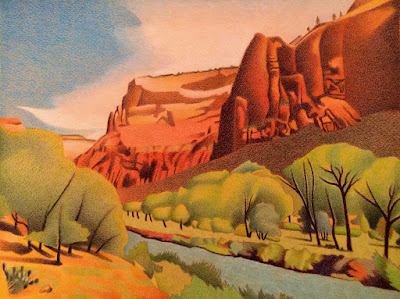 |
| A deep reverence for nature |
 |
| The soul of a place |
 |
| Eliminate the unnecessary |
 |
| Embracing my natural style |
 |
| Grandeur of the American West |
 |
| A middle ground between realism and abstraction |
 |
| It is difficult to be simple |
 |
| An arduous process |
 |
| Beautiful abstractions |
 |
| A revelation |
 |
| Stylize the essence |
 |
| Exaggerate the color |
 |
| Countless hours studying nature |
Animas Forks - Colored Pencil Drawing
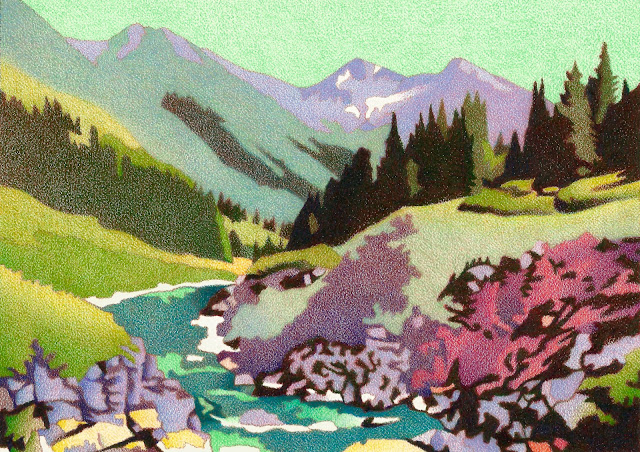 |
| "Animas Forks" Colored Pencil |
It’s a warm, summer evening in the San Juan Mountains near Silverton, Colorado where the Animas Forks River is born above the tree line. The turquoise torrent cascades down through a rock-hewn canyon of purple cliffs and into a spectacular basin entombed by towering peaks.
A few rows of dark trees are scattered diagonally across the wide open tundra. A sulphur sun streams golden rays through a verdant sky, bathing the surreal scene in ethereal light.
The color choice is influenced by the high altitude where the blazing orb sears through thin air, tinging the atmosphere with sulphur which gives the sky its green cast. Notice how swirls of this emerald color are reflected in the river current below.
Flush with the optimism that comes from fine weather, the bright highlights sparkle with intensity. Notice how the same colors are being used in different areas of the drawing. Carrying common pigment into multiple places across the surface is an effective way to unify the composition.
The entire picture is composed from patches of flat color which deliver a powerful effect similar to woodblock printing or a stained-glass window. By doing a bit of shading, though, the static atmosphere is transformed into a more dynamic work of art. The soft gradations indicate the direction of light and define the different forms.
For no other reason than sheer joy, the pure yellow is injected into the composition, reminding the viewer that this humble drawing is merely a simple arrangement of abstract shapes and cheerful colors. These exciting hues more honestly express the awesome beauty of summertime in the mountains.
Like a beating heart, the earthen core permeates the landscape with a mineral warmth from the inside out. More than a century ago, this fragile environment was devastated by man’s greedy quest for precious metal and some of the unhealed slopes still bear scars.
Known for its raucous past, the historical location is now literally a ghost town. After spending time in this magnificent wilderness, I know one thing for certain - the wealth extracted from these mountains, today, is measured in beauty instead of silver and gold.
If you would like to read a step-by-step tutorial about how this drawing was created please check out this issue of Carrie Lewis' CP Magic Magazine.
Golden Hawk - Colored Pencil Drawing
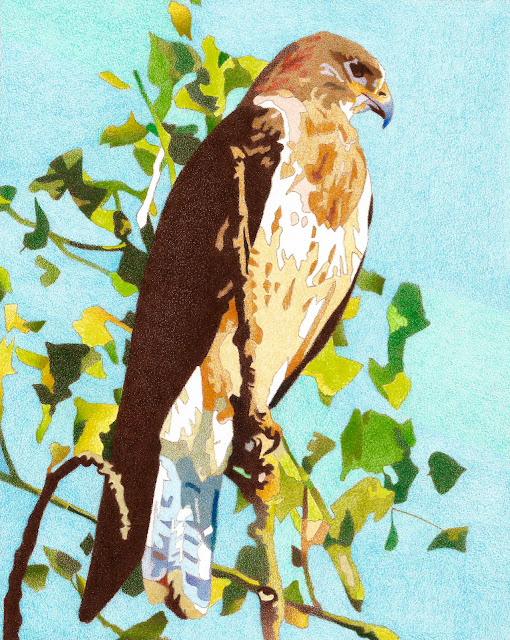 |
| "Golden Hawk" Colored Pencil |
Perched on a high throne decorated with a wreath of autumn leaves, a golden hawk gazes over a vast empire. The royal color scheme of blue and gold is applied in patches of similar value, resulting in a posterized portrait.
Highlights and shadows are downplayed as the abstract contours exaggerate the drawing’s obvious two-dimensionality. The resplendent creature is static and solid suggesting a timeless permanence that symbolizes confidence, power and freedom.
This piece does not portray a specific individual but it is more of a generic representation of a dazzling species that is so often overlooked. The monarch’s feathers are barely insinuated and the tail stripes are reduced to a simple pattern.
The long, dark wing is devoid of detail, the ochre bib promotes a sand-colored chest and the yellow feet, equipped with sharp talons, melt into the mosaic of foliage. Cut out of a powder-blue sky, the noble profile of a bronze head is adorned with a curved, violet beak.
This memorable recollection of a frozen moment from the past has been transcribed onto a single sheet of white paper. The animal’s dignified spirit expressed by a compact arrangement of interlocking shapes and multi-layered pigment.
Shining Mountains - Colored Pencil Drawing
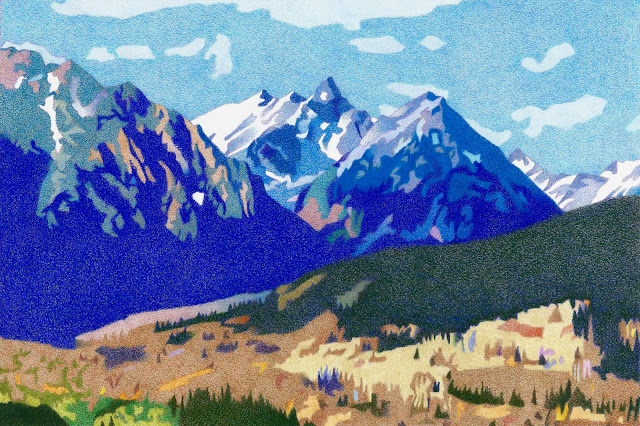 |
| "Shining Mountains" Colored Pencil |
It’s late fall as first light seeps across the Great Divide and floods into the Blue River Valley, illuminating a celestial kingdom. Rising out of this divine realm, the Shining Mountains sparkle like jewels and their jagged profile serrates a docile sky.
The ethereal incandescence reveals a royal tapestry of woven colors that conveys a spiritual loftiness unique to one of Colorado’s most pristine wilderness areas. The golden peaks are modeled by a jigsaw of sharp-edged shadows of the purest violet-blue.
In the field, a barren aspen grove and a few dark trees are scattered remnants of autumn’s last breath. The bronze meadow sits somberly below snow-dusted summits that glimmer with multi-facets of hope.
This merciful period of reflection offers precious time to prepare for the difficulties that lay ahead. The melancholy season’s cold air blows with indifference forcing the high country inhabitants to respond with unyielding perseverance and patience.
The gleaming alps suggest a forbidding tone concerning the hardships suffered during an everlasting winter. An unwavering faith in the predictable cycle of nature is necessary in order to believe these broken hills will someday be brought back to life.
White Bergen Peak - Colored Pencil Drawing
 |
| "White Bergen Peak" Colored Pencil |
It is daybreak after a big storm and a white Bergen Peak is like an apparition rising out of an undulating field. Blanketed by fresh snow, the mountain’s bulky form is defined by sharp, gray shadows.
A dormant grove of ochre aspen clings to the pale behemoth’s lower slope while dark trees dot the valley floor in the distance. A receding ridge line is set at an angle as it cuts through the middle of such spectacular scenery.
Cast as the center of interest, a ponderosa pine creates a striking profile against a backdrop of open air. It’s curving, crimson trunk is topped by a bright green canopy whose beautiful blue shadows melt into the heavens.
As the moisture dissipates, an ominous, cobalt-colored sky gradually gives way to sparkling cerulean. A flood of warm sunlight sets the grassland on fire as interlocking shapes of red, yellow and orange sweep across the foreground.
The barrage of bad weather is just beginning so it won’t be long before this whole landscape is buried beneath deep snow. Autumn is on its last gasp but the colorful season is going out in a blaze of glory.
Elk Meadow Mornings - Chasing Bluebirds
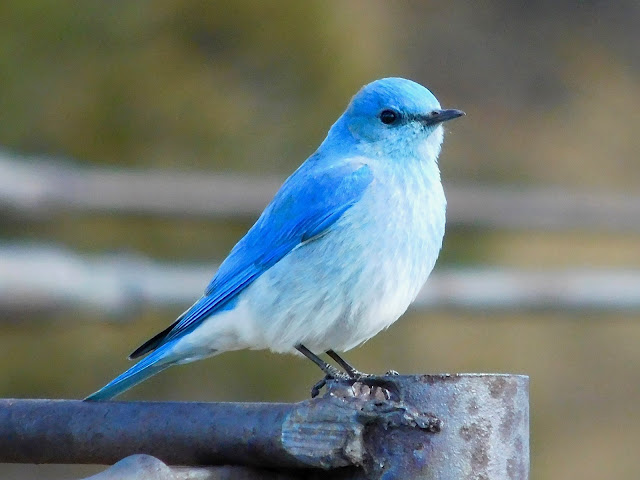 |
| Chasing bluebirds |
During this wearisome time, my early mornings have been spent in Elk Meadow chasing bluebirds. It is early spring in the foothills so the steep trails are slick and muddy and Bergen Peak’s rocky summit is still laced with everlasting snow.
Most of the summer residents are back including the red-winged blackbirds that nest just above waterline in the cattail marsh located at the lower end of the park. The lonely pathway is completely quiet except for the chorus of conspicuous calls made by the elusive inhabitants of this isolated grassland.
Nuthatches make a tapping sound as they peck into the bark of ponderosa pine while northern flickers claim territory by emitting their distinctive call from the tree’s top. The sweetest song heard in the countryside is the beautiful melody sung by the western meadowlark and that unique warbling sound made by mountain bluebirds in flight attracts my attention to their variable landing zones.
This season their has been such a profusion of bluebirds that it is as if the sky has shattered and tiny bits have rained down on earth, splashing into our drab meadow. Their photogenic profile captured in low light only enhances their legendary stature as one of America’s most beloved birds.
The female bluebirds have dull coloring that provides protection during the nesting season but the eligible males display bright plumage making them easy to spot. Many of the bluebirds like to congregate on the iron fence attached to an old, abandoned barn.
At first, they were wary of my daily incursions through their habitat and they got spooked by the slightest movement. Over time, day after day, I have gradually earned their trust as they have come to accept my recurring presence, allowing me to observe their most profound behavior.
When hunting, the bluebirds perch on mullein stalks and cock their heads sideways while listening for prey. Once they have acquired a target, they swoop down to the ground and pluck a juicy earthworm from the moist soil.
The mountain bluebirds generously share their grassland territory with robins and western bluebirds. These two red-breasted species exhibit identical behavior as the mountain bluebirds but their sparse populations are segregated into smaller pockets within the spacious field.
Mountain bluebirds dislike cold, cloudy days but they love warm, sunny days so that is when they are most active. Springtime in the Rockies is notorious for its fickle weather as a fierce blizzard can strike at any time before official summer.
Mountain Bluebirds expect this harsh weather and have learned to adapt to the heavy snow and frigid temps that occur this time of year. Maybe we can learn something from how they respond to a disruptive hardship - they retreat to the safety of a cozy nest box and shelter in place until the storm has passed.
 |
| A profusion of bluebirds |
 |
| They congregate around a barn |
 |
| They swoop to the ground |
 |
| They love the sun |
 |
| Hunting for earthworms |
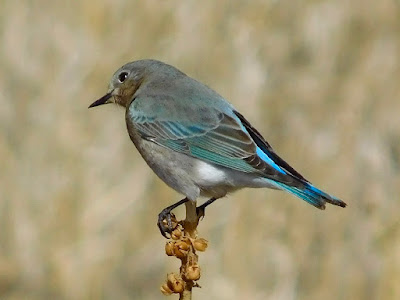 |
| They cock their heads and listen |
 |
| Dull coloring provides protection |
 |
| Bright blue plumage |
 |
| A beloved bird |
 |
| A photogenic profile |
 |
| Captured in low light |
 |
| Western bluebird |
Clash of the Seasons - A Skirmish of Bad Weather
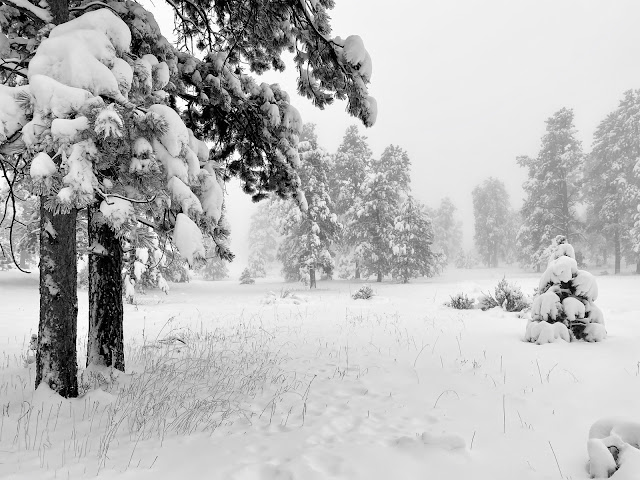 |
| Clash of the Seasons |
While the world is at war with an invisible virus, we have been witness to a dramatic clash between our two most volatile seasons. It is a classic battle between Good and Evil as impatient Spring tries to usher out an unwilling winter.
A couple of weeks of warm weather almost wiped out the last pieces of evidence betraying the dark season. Not surprisingly, on the first day of spring, a fierce blizzard destroyed the early vestiges of calm.
The next morning was bleak as rising temperatures mingled with moist atmosphere, resulting in a veil of condensed fog. Objects close-up appeared with crystal clarity but as the field of vision expanded, the shapes disintegrated into a screen of nothingness.
Wet snow had poured down quietly through the night and accumulated into a heavy pile at least a foot high. The tall pine trees wilted and bowed under the pressure of tremendous weight while smaller ones were smothered in a blanket of flakes.
The steely sunrise absconded with any semblance of color, leaving in its wake a solemn wilderness of sober gray. The feeling of isolation conjured up by the forlorn forest only exaggerated the heightened state of solitude.
Within a few days, the snow had melted and the skirmish of bad weather was all but forgotten. Still sequestered in place, we yearn for a smooth transition between the rival seasons and pray for a swift resolution to the World’s current crisis.
 |
| Clash of the seasons |
 |
| An unwilling winter |
 |
| A fierce blizzard |
 |
| A bleak morning |
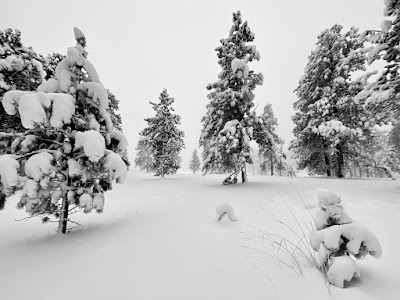 |
| A solemn wilderness |
 |
| A state of solitude |
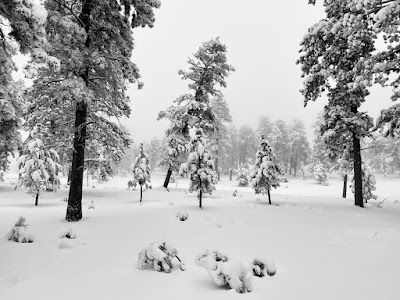 |
| A forlorn forest |
 |
| Isolation |
 |
| Smothered in a blanket |
 |
| Condensed fog |
 |
| Crystal clarity |
 |
| Yearning for a smooth transition |
Somber Light - A Dreary Month
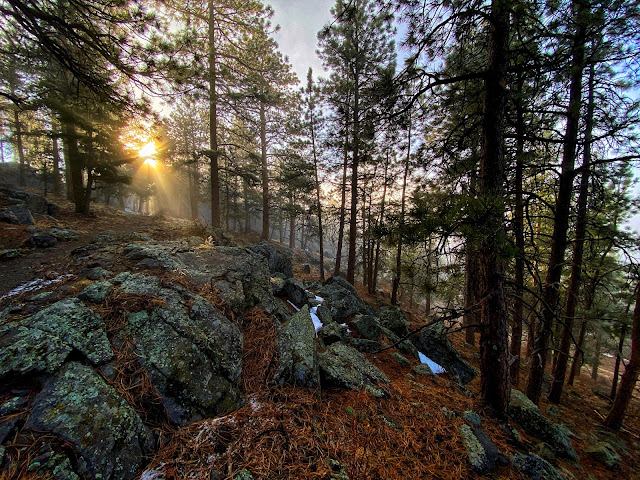 |
| Somber light |
March has been a dreary month distinguished by somber light, ill weather and a deadly virus. During this muddy stretch, we usually get most of our sleet and snow but this year it has been all rain and drizzle.
The clocks were struck ahead so twilight is later but the dawn is diffused by a morning mist that cloaks the landscape in a depressing aura. The individual shapes are broken into receding planes that gradually disappear into a blank slate of firmament.
The sun strains desperately to filter its first light into an eerie woodland shrouded by dense fog. Some of the rays are funneled through narrow passages between the trees creating surreal beams that flood the forest floor.
The desaturated colors are dull, the black mountains are buttressed by a tawny meadow and slags of gray snow slide across the scene. The interior is filled with a thick atmosphere of soupy moisture that softens every sharp edge.
Citizens have been asked to disperse, interact socially from beyond a certain distance and refrain from unnecessary activity. The State of Emergency is an unprecedented time of dramatic cancellations and closures that have broken life down to its basics.
Extremely superstitious and a devout believer in Karma, I could never take lightly the lethal ramifications of a global pandemic. I have learned long ago to never underestimate the power of nature so if I’m not out alone in the wilderness, you’ll find me confined in a necessary quarantine.
 |
| Surreal beams of light |
 |
| Rays are funneled through passages |
 |
| An eerie woodland |
 |
| Black mountains |
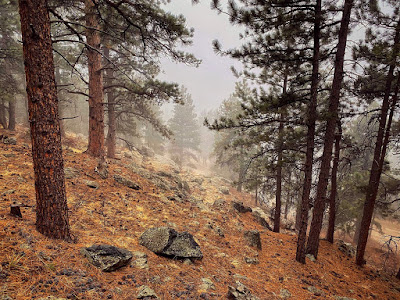 |
| Morning mist |
 |
| Shrouded in dense fog |
 |
| Receding planes |
 |
| A depressing aura |
 |
| A dreary month |
 |
| A State of Emergency |
 |
| Alone in the wilderness |
Butterflies - Colored Pencil Drawing
 |
| "Butterflies" Colored Pencil |
“Through art we can change the world.” ~ #twitterartexhibit
It’s an incredible morning in September as a profusion of painted lady butterflies migrate leisurely through the Front Range Foothills. Their fluttering course seems to be at the mercy of a fickle breeze that blows down from the snow-covered divide.
During the fall, the mountain landscape is ablaze in fiery color and the sudden arrival of so many butterflies stirs even more spicy tones into the mix. Out of the thousands passing through, a pair has paused to pollinate on a purple, Scotch thistle.
Intentionally constructed to be a little bit larger than life, this close-cropped composition lends the scene its dramatic sense of immediacy. The tiny niche in nature’s garden is an enlarged, abstract arrangement of hard-edged shapes and saturated color.
The pure pigment is brightened by the black outlines that encompass the separate sections much like a stained-glass window. A deep violet shadow spreads across the petals forming a dark value that pushes the travelers into sharp relief.
This rare, migratory phenomenon is one of nature’s great spectacles, displaying unparalleled beauty and an air of mystery. These carefree, little creatures have only a short time to spend on earth because their average life span is just a couple of weeks.
During their abbreviated existence on this planet, the painted lady butterflies dash about with a joyful enthusiasm. When contemplating the impending future, take your cue from these breathing works of art and always try to live your life to the fullest.
Butterflies is my contribution to the upcoming Twitter Art Exhibit: Myrtle Beach. This unique event is an international exhibition of original postcard art supporting Horry County Disabilities and Special Needs.
HCDSN is dedicated to providing services and supports, to individuals with Intellectual Disabilities, Autism and Head and Spinal Cord Injuries all the while ensuring the person is at the center of services delivery. Their philosophy of person centeredness is aimed at helping individuals with disabilities to become the very best version of themselves.
This is accomplished through vocational training, community employment, day services, advocacy, social and recreational opportunities, community involvement and through unleashing their creative spirit and passion through art.
The art program is designed to promote self-expression, social interaction and the development of peer relationships through various art classes. The program began with art lessons and has evolved to include pottery classes with the local Art Museum.
Improvement in hand eye coordination, visual acuity and self-esteem has been witnessed by so many of the individuals who participate. Individuals with significant intellectual and physical challenges have realized significant emotional and personal growth through their involvement in the arts.
Proceeds from TAE20 will enable Horry County Disabilities and Special Needs to develop and extend the art program to offer additional art classes but enhance the individual’s opportunity to also engage in statewide community art exhibitions.
Twitter Art Exhibit: Myrtle Beach is the tenth installment of this open, international exhibition of handmade postcard art for charity, donated by artists from around the world.
Social media plays a major role in the Twitter Art Exhibit. It is their intention to tweet, share and promote contributing artists to thank them for their participation, and to make this event a success for all involved.
The event will be highly publicized and well attended by art buyers and enthusiasts, members of the press, local artists and the TAE community.
For more information, please check out this link: #twitterartexhibit
The Bald Eagles of Barr Lake - An Idyllic Home
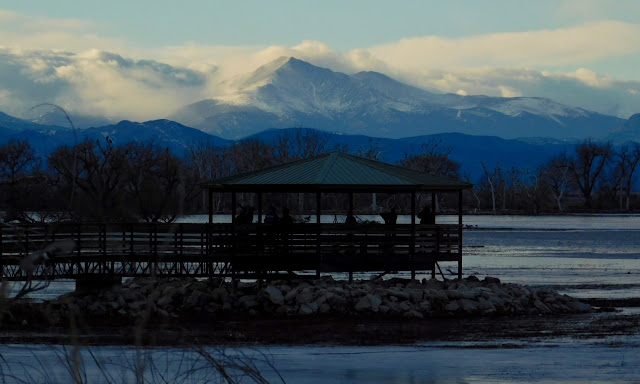 |
| The Gazebo Boardwalk at Barr Lake |
Bald Eagles nest and breed in the North but in the fall many of them migrate south and inland searching for a milder climate. They prefer to spend the winter months in tall trees near a large body of open water where they can survive on fresh fish.
Barr Lake is the perfect haven for these majestic birds of prey as they flock to this oasis on the eastern plains more than one hundred strong. Since it is the non-breeding season, the eagles are more tolerant of human incursion into their habitat, allowing you to catch a glimpse of what their life is really like.
Surrounding the reservoir, a barren forest of writhing, twisted, tortured cottonwoods is the perfect place for the birds to perch and gaze down upon their awesome domain. They are built to withstand the cold but on the chilliest days, they remain motionless on the tallest treetops.
When the weather warms, the eagles become more active and social and that is when their entertaining antics are fun to watch. Big, aggressive adults steal catches from seagulls or even from one of their own while others saunter clumsily along the ice line scanning the water for food.
The most spectacular part of their sudden liveliness is the aerial display of playful soaring, diving and tussling. Their vocalizations seem to express the sheer joy to be blessed with the incredible ability of masterful flight.
Come February, a large contingent of migrants arrives from the South and when combined with the residents, it is possible to identify more than one hundred unique individuals in a single day. It is an exciting place to be when the sleepy habitat begins to come back to life.
Other bird species are on their way but the bald eagles are leaving soon as they must fly to their northern breeding grounds. There is a mated pair, though, that returns to Barr Lake every spring where they make the same, enormous nest their idyllic home.
 |
| They saunter on ice |
 |
| The adults are aggressive |
 |
| They are more active and social |
 |
| It's possible to see 100 different eagles in one day |
 |
| The eagles are tolerant |
 |
| They perch in the treetops |
 |
| The habitat is coming to life |
 |
| Playful soaring. Photo by Lukas Miller |
 |
| An aerial display. Photo by Lukas Miller |
 |
| Masterful flight. Photo by Lukas Miller |
 |
| Barr Lake is a haven |
 |
| Tortured cottonwood trees |
 |
| The reservoir is partially frozen |
 |
| An awesome domain |
 |
| It's fun to watch the eagles |
 |
| An idyllic home |
Winter Storm Kade - Small Flakes, Big Snow
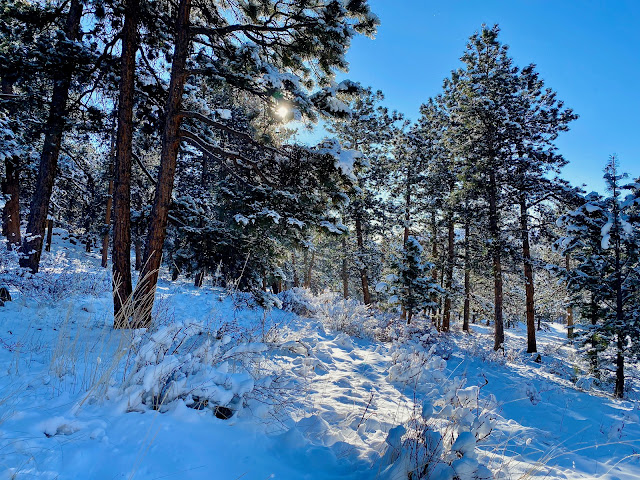 |
| Winter Storm Kade |
Just hours after a furry groundhog in Pennsylvania prophesied a swift spring arrival, a brutal winter storm hammered the foothills in Colorado. It was a classic example of the old adage - Big flakes, small snow. Small flakes, big snow.
The tiny snowflakes poured like rain through a bitterly cold night, resulting in a smothered landscape buried below deep snow. The crystalline powder was piled into fragile drifts that shifted in a brisk wind.
After experiencing our least snowiest January in 50 years, the blizzard was a stunning slap in the face, snapping us back into the reality of winter conditions in the mountains. The glorious daybreak was punctuated by a bright sun whose sleek rays leaked through the branches of a dense woodland.
The low, diffused light spread throughout the forest creating a curious combination of fluorescence and shadow. Seen across the valley from a high vantage point, Bergen Peak was a regal monarch robed in white, a frozen monument revealing the true power of the most recent weather system.
Trudging through the labyrinth of timber, rock and ice on such an extraordinary day was an exhilarating experience. The slippery descent emptied into an isolated meadow where a dilapidated homestead was a weather-beaten tribute to all of the resilient inhabitants of the Rock Mountains.
 |
| A brutal winter storm |
 |
| Small flakes, big snow |
 |
| A smothered landscape |
 |
| Crystalline powder |
 |
| A glorious daybreak |
 |
| Low, diffused light |
 |
| Light leaked through the dense woodland |
 |
| Snapped back to reality |
 |
| An extraordinary day |
 |
| A regal monarch |
 |
| A dilapidated homestead |
Mule Deer Morning - Always a Thrill
 |
| Mule Deer Morning |
The local wildlife is becoming more active because the morning light is brighter and the winter weather is warmer. The forest is slowly waking to the sound of flickers, chickadees, nuthatches and woodpeckers.
Recently, while walking through a drowsy woodland, I stumbled across a small herd of deer. I found them on a rocky hillside foraging for brush, branches and anything else they could find.
They were a tight-knit bunch of females and yearlings and they were unconcerned by my presence. Because hunting is not allowed in the area, they tolerate the intrusion of humans into their domain.
If anything, the mule deer were intensely curious as they contemplated my activity. I remained quiet and still and watched while they gracefully negotiated the mountain’s rugged terrain.
Fortunately, I was able to document this intimate encounter. I had my phone with me so I was able to take some pictures and get a quick video in order to capture their extraordinary movement.
The muleys gradually made their steep ascent up to the ridge and vanished from my view. It was a fleeting interaction with an animal that is considered quite common but for me, an unexpected path-crossing with these impressive creatures is always a thrill.
 |
| A rocky hillside |
 |
| They were curious about my activity |
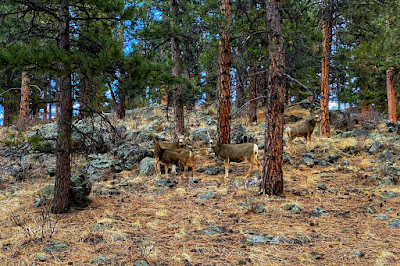 |
| An intimate encounter |
 |
| Impressive creatures |
 |
| They made a steep ascent |
In the Meadow - Below Bergen Peak
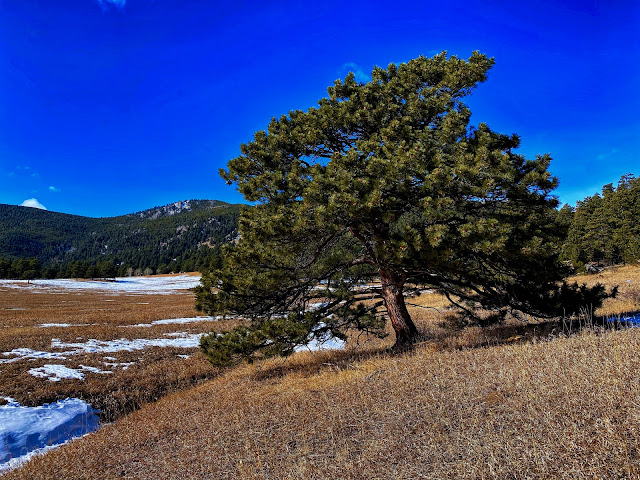 |
| Below Bergen Peak |
It is a brisk sunrise in the meadow below Bergen Peak where the solemn monarch presides over the forlorn foothills. Scattered haphazardly across the golden field, ponderosa pine are lonely sentinels overseeing any approach.
After a month of mild weather, most of the snow has melted but there are a few drifts that still survive in the shadows. On this clear winter morning, wispy white clouds are blown across a cobalt blue sky.
The muddy trail, set upon a tilted plain, is a gradual incline that is quite grueling to traverse. While the scenery on this day may not be so spectacular, the sleepy landscape affords some serenity in order to recharge the soul for another year.
 |
| Snow drifts survive in the shadows |
 |
| Wispy white clouds |
 |
| A grueling traverse |
 |
| A sleepy landscape |
 |
| Serenity to recharge the soul |
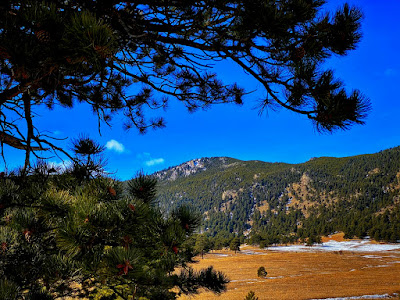 |
| A solemn monarch |
 |
| Lonely sentinels |
 |
| Ponderosa pine |
In the Forest, Fillius Ridge - Colored Pencil Drawing
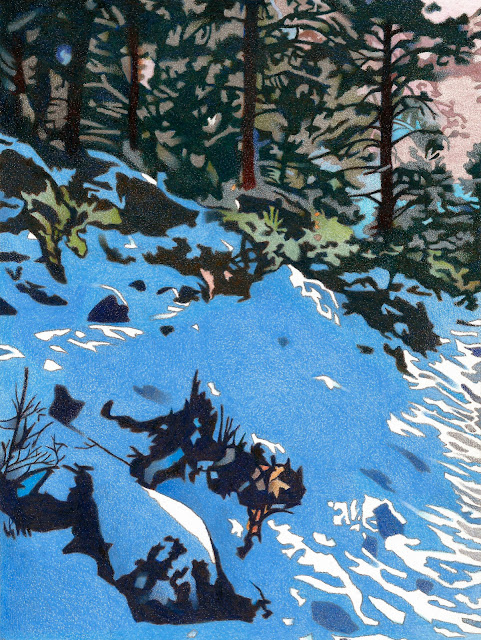 |
| "In the Forest, Fillius Ridge" Colored Pencil |
It is the middle of winter in the Colorado foothills and Fillius Ridge is the spiny crest of a steep, forested hillside. The rugged scene is another study in contrast involving opposing shapes, edges and values.
The forest interior during the winter is one of the most austere places on earth erecting a severe barrier from the rock, ice and fallen lumber found in a forbidding wilderness. Life is a struggle on the lofty rim where plants, trees and animals struggle to survive this season of gloom.
The flickering landscape makes a gradual transition towards abstraction as the indistinct edges of the lodgepole pine melt into the morning sky. The dark mood is alleviated by a trickle of pink light that gradually seeps through a web of tangled branches and needled foliage.
It is a natural patchwork of analogous colors where white highlights streak across the cliff’s snowy surface. The sharp angles of the deep, blue shadows convey action and dynamic movement that spread across this unique drawing.
The murky silhouette of pine trees suggests the impenetrable fortress of a dense woodland. The somber palette is layered over a warm undertone that permeates throughout the entire piece, unifying the intricate composition.
The depiction of this coarse environment is meant to express the stern beauty of a snowstorm’s aftermath. Just like the sun’s first rays breaking through the black of a long night so will the forest’s icy tones surrender to the fiery mosaic of summer.
Winter Storm Gage - An Artistic Effect
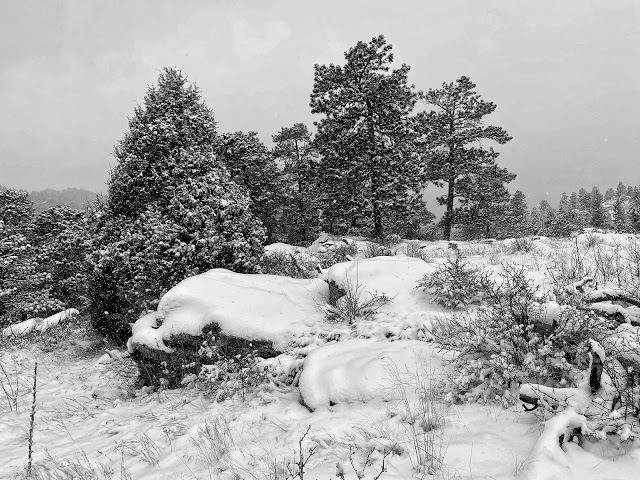 |
| Winter Storm Gage |
Right at the start of another decade, a named storm descended onto the foothills, dumping heavy amounts of more snowfall. Winter Storm Gage cruised down through the corridor, eliminating any hint of color while leaving behind a landscape converted to gray.
Trudging up a steep hill was a struggle but I did witness white flakes falling against the black trees, creating a soft, artistic effect. There was so much contrast between the two values, I felt like I was walking through a pointillistic painting.
A few snags and fallen logs were representative of the rough life endured by the trees and animals that survive on Elk Ridge. From a high overlook, most of the valley was visible but the horizon line was lost due to the dense atmosphere.
Working my way back down was a bit dicey because the trail was broken by rock, slush and ice. Back down at the bottom, a miserable wind made everything cold and uncomfortable but despite the bad weather, I can’t think of a better way to celebrate the hopeful beginning of a new year.
 |
| Heavy amounts of snowfall |
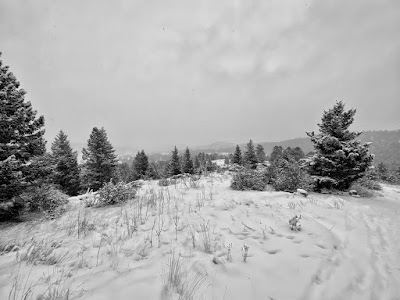 |
| The valley was visible |
 |
| A rough life |
 |
| A gray landscape |
 |
| White flakes and black trees |
 |
| A pointillistic painting |
 |
| The beginning of a new year |
 |
| An artistic effect |
Christmas in Western Nebraska - Calm Before the Storm
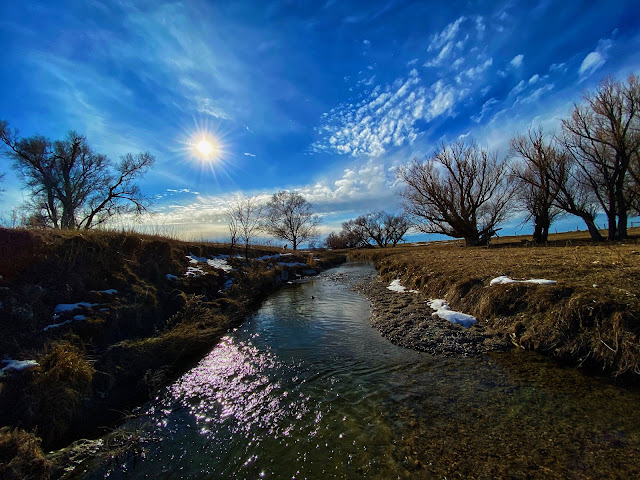 |
| Christmas in Western Nebraska |
Christmas in Western Nebraska is a bittersweet holiday because the temperatures are always brutally cold. The northern plains normally get pounded by winter storms and a ferocious wind blows snow across the grassland, creating whiteout conditions that make travel impossible.
During our stay at my parents’ Little House on the Prairie, the weird weather was unseasonably warm. This December, the usually frozen creek was found to be ice-free and flowing smoothly through a semi-frosted pasture.
The cattle had been put out on the corn where the longhorns formed an imposing silhouette against an early sunset. The barren trees stood in stark contrast to the fading, orange light as the entire scene was faithfully reflected on the water’s glassy surface.
Our good fortune only lasted for a few days before the peaceful setting was disappointingly shattered. The forecast turned ominous and just as we were leaving town, a surprise storm appeared out of nowhere and charged down the valley enveloping Chimney Rock.
The fast-moving system buried the Sandhills under a blanket of deep snow. I should have known that fragile window of fine weather at the farm was only a mirage. Those few nice days were really just an anomaly - they were the calm before the storm.
 |
| The creek was ice-free |
 |
| Sorghum bales |
 |
| Longhorn cattle |
 |
| A peaceful setting |
 |
| Faithful reflections |
 |
| Chimney Rock |
 |
| Little House on the Prairie |
Mount Evans Christmas - Watercolor
 |
| "Mount Evans Christmas" Watercolor |
It is a cold and windy day in a spectacular basin known as Upper Bear Creek. Buried under a blanket of fresh snow, Mount Evans is a lofty landmark that imposes it’s iron will on the local weather patterns.
Tethered to the foreground, sturdy evergreens are built to withstand the brutal storms that wreak havoc on this hidden valley. Here, heavy snow clings to the blue spruce creating an intricate pattern of dark and light.
This time of year, the landscape can only be expressed with mostly cool colors like blue and green. Surprisingly, there is also a few touches of pink and yellow scrubbed into this wintery composition.
Such a difficult medium to work with, watercolor painting demands that you relinquish control. Most of the fluid brushstrokes are allowed to flow freely as they encourage you to let your imagination run wild.
Strokes of pale color are washed across the smooth surface, giving a loose suggestion of the vast wonderland. Cerulean skies set the ominous tone that permeates the arctic atmosphere, instilling the inhabitants with a sense of dread.
It’s an uncomfortable morning devoted to tramping around on treacherous terrain. The risk involved in such an undertaking is worth it though because being immersed in such pristine surroundings is an unforgettable reward.
The Dedisse Bridge - Into the Wild
 |
| The Dedisse Bridge |
Hidden discreetly in Bear Creek Canyon, the Dedisse Park Bridge is an arched gateway into the remote shadowlands concealing the north face of the Three Sisters Peaks. The structure easily spans Bear Creek and its simplicity in form and color enable it to blend smoothly into the riparian environment.
Despite its close proximity to the crowded Evergreen Lake, the quiet swale remains relatively unknown to most local citizens. During the summer, bright sunlight streams through the abode and explodes into shattered bits of color, reflecting the excitement and energy found in a vibrant forest.
Wintertime is a much different story as the chilly atmosphere is expressed by a scheme of blues and grays. Big storms stall out over the mountains and fill the narrow gorge with extraordinary amounts of snow.
The lower, clear light still finds a way through the dense foliage creating irregular shadows that perfectly trace the deep, undulating drifts. Composed from a diverse array of boulders, branches and brush, the rugged landscape is completely blanketed in the purest white.
Bear Creek is a powerful force born in the big mountains so even during the harshest winters, it becomes only partially frozen. The frigid water flows persistently through a maze of turquoise ice sheets and sheer black rock.
Descending the gentle, southern slopes, a series of switchbacks is a slippery trail leading down to the stream and its modest crossing. Here, the Dedisse Bridge is a symbolic connection offering passage from civilization into the wild.
 |
| Hidden discreetly |
 |
| The swale remains relatively unknown |
 |
| A gateway to the shadowlands |
 |
| Southern slopes lead down to the stream |
 |
| The creek is partially frozen |
 |
| A chilly atmosphere |
 |
| The frigid water is persistent |
 |
| A rugged landscape |
 |
| Into the wild |
Mtn Muhly Trail - An Aura of Forbidding Mystery
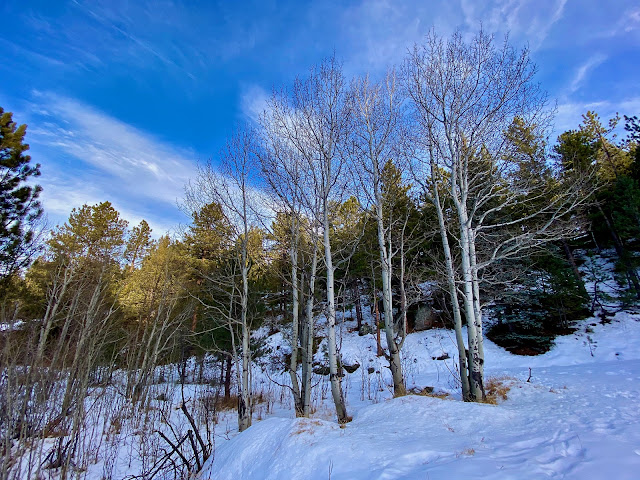 |
| Mtn Muhly Trail |
Starting in a quiet corner of Alderfer Park, Mtn Muhly Trail descends into a steep gulch gouged by a little stream called Coneflower Creek. A grove of aspen sparkles in the late light as its long shadows tumble over the embankment and disappear into a ribbon of black water.
During winter, the cup-shaped valley is a barren landscape steeped in an aura of forbidding mystery. The confusion of branches and brush makes for a messy scene but there is a certain charm to be found in nature’s tangle of wild forms.
The slim ravine stretches easily through a dense forest of fir and spruce where only the tips of the tallest trees are lit by the golden ambiance of a setting sun. Climbing up and out of the chasm isn’t too much of a problem as the path empties into a rugged stand of lodgepole pine.
Weaving its way through a maze of old growth, a rocky route traverses the steep western slopes set below the Three Sister Peaks. Just as it begins to get dark, the ominous woodland gives way to a wide open meadow and a pink sky floods into the field of vision.
Once the dark curtain of a winter’s long night finally falls, the mountains get incredibly cold. There’s nothing left to be done outside except wait patiently for the dawning of a new day and hope that it will be warmer than the last one.
 |
| Starting in a quiet corner of the park |
 |
| A steep gulch |
 |
| Forbidding mystery |
 |
| Confusion of branches and brush |
 |
| A slim ravine |
 |
| A golden ambiance |
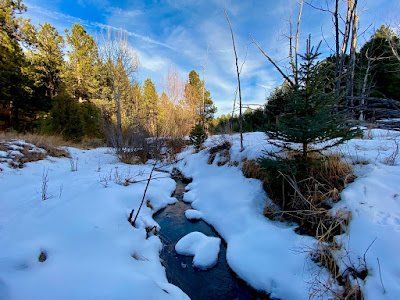 |
| Coneflower creek |
 |
| A setting sun |
 |
| Slope below the Three Sisters |
 |
| A wide open meadow |
 |
| Winter's long night |
Big Snowmelt - A Burst of Mild Weather
 |
| Big snowmelt |
In between winter storms, there are short periods of warm sunshine that result in big snowmelt. The snow slides down off of the tree branches dousing the wanderer with a shower of cold water.
During these fleeting bursts of mild weather, treacherous trails into the lonely forest are packed with rocks and ice. If you dare to venture out during this muddy interlude, tread with caution and expect to get wet.
It may not be the most beautiful time of the year but there is a certain elegance inherent to the dull color scheme. The ochres, browns and grays sparkle in the clear light, contrasting sharply with the morning’s dark shadows.
The meadow has been swept clean by a strong, west wind blowing down from the highest peaks. It has been nice to receive a respite from the repeating cycle of historic storms because it gives us some time to document their impact and prepare for the ones still on the way.
 |
| In between snowstorms |
 |
| Morning's dark shadows |
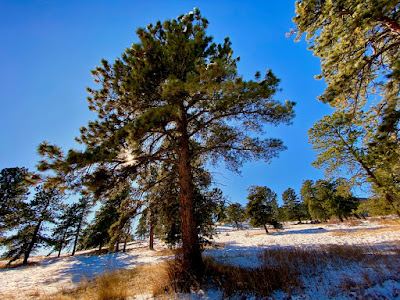 |
| A fleeting burst of mild weather |
 |
| A muddy interlude |
 |
| A certain elegance |
 |
| Short periods of warm sunshine |
 |
| The meadow is windswept |
 |
| A nice respite |
 |
| Snow slides off of the branches |
 |
| Sparkling, clear light |
 |
| Preparing for more snow |
Winter Storms - A White November
 |
| Winter Storms |
This year we have skipped fall and descended directly into the dark season as winter storms Aubrey, Bessie, Caleb, Dorothy and Ezekiel have already pounded the foothills with heavy snow. It is generally during the month of March that we receive most of our moisture but the amounts dumped this autumn have been historic.
It is not just the excessive precipitation that is remarkable but also the arctic cold as the deep snow is piled into drifts of feathery powder. The mountains are cloaked in a robe of glittering gray while the limber pine are bent by the weight of thick frost, creating an arched pathway into the frozen, forest kingdom.
When ploughing across the pale meadow, your footsteps make a distinct crunching sound that can only be heard when walking on soft snowpack. December is usually dry so it is unpredictable as to whether we will awaken to a classic Christmas Day but I know one thing for certain - dreams of a White November have already come true.
 |
| We have skipped fall |
 |
| Storms have pounded the foothills |
 |
| Descended into the dark season |
 |
| Arctic cold |
 |
| Historic snow this fall |
 |
| Deep snow |
 |
| The mountains are a glittering gray |
 |
| Winter Storm Caleb |
 |
| A pale meadow |
 |
| Excessive precipitation |
 |
| A frozen, forest kingdom |
 |
| A White November |
Sheep Lakes - Eternal Shades of Pastel Blue
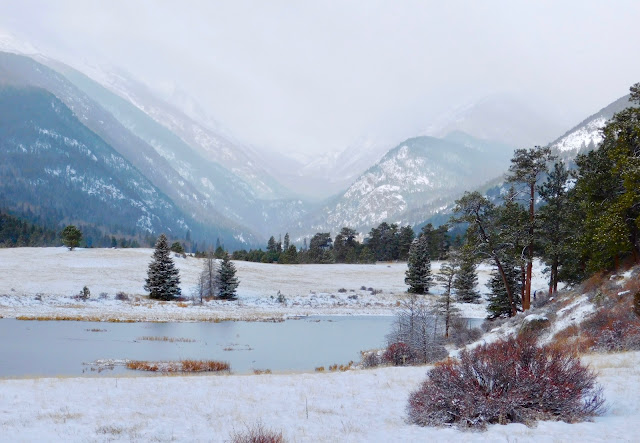 |
| Sheep Lakes |
A bitterly cold wind sweeps down through Fall River Canyon and the frigid air settles in a scenic gorge named Horseshoe Park. Scientists call this place a glacial outwash terrace, I call it a glorious gateway to one of the most beautiful areas in Colorado.
Ensconced in Rocky Mountain National Park, the gorgeous meadow was sculpted by a 500-foot-thick glacier during the last ice age. That glacier crept down the valley and reached its maximum extent about 15,000 years ago.
The powerful force of nature gradually retreated and as it did, the glacier released sizable chunks of ice and rubble. The dynamic combination of melting ice and strewn debris wreaked havoc on the thawed earth, creating cavities in the soft ground.
When the deep depressions, resulting from the event’s epic aftermath, are filled with water - they are called kettle lakes. These ponds are special because they have no surface drainage and the land surrounding them has been transformed into a natural salt lick.
Locals call this place Sheep Lakes because Bighorn Sheep, attracted by salt deposits in the ground, congregate here during the summer. They come down from the Mummy Range in order to graze on grass and eat the soil, obtaining minerals not available in their alpine habitat.
Horseshoe is a paradise for all kinds of wildlife during the summer but the winters are brutal as the park is laid to rest in a snow-covered tomb buried below picturesque peaks. At this time of year, the forbidding landscape can only be described by dead quiet and eternal shades of pastel blue.
 |
| One of the most beautiful areas |
 |
| A glorious gateway |
 |
| Winters are brutal |
 |
| Horseshoe Park |
 |
| A glacial outwash terrace |
 |
| A snow-covered tomb |
 |
| Picturesque peaks |
 |
| Eternal shades of blue |
American Bison Trail - A Secret Passage
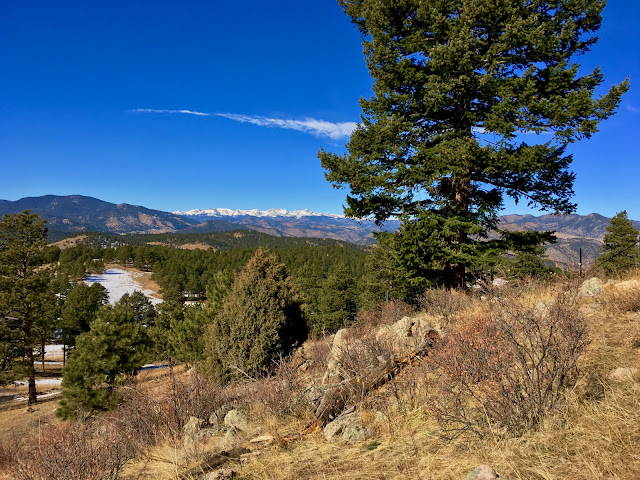 |
| American Bison Trail |
Tucked away in the Front Range Foothills, a discreet meadow is home to Colorado’s treasured herd of buffalo. Broken by rocks and ice, a muddy pathway circumnavigates the sturdy enclosure while offering unobstructed views of the Continental Divide.
The American Bison Trail traverses the lower slopes of Genesee Mountain, winding its way through an old-growth forest of ponderosa pine. The morning sun has just slipped over the ridge so bright light floods into the open woodland.
Sequestered in the backwoods, the trail is a secret passage through the wilderness that even the locals don’t know exists. One of the most common inhabitants in this netherworld is the cautious mule deer but encounters with this shy creature are transient.
It is pretty quiet in the deep interior but if you listen closely, you’ll hear a whole chorus of resident birds. Crows drift across the treetops as woodpeckers and nuthatches tap tree bark while Stellar’s jays squawk noisily, disrupting the peaceful ambiance.
Tiny, black specks graze in a golden grassland unfurled below an impressive expanse of blue mountains and big white peaks. The hardy beasts are settled in the center of the pasture so a long camera lens is required to reach out and capture their shaggy silhouettes.
Sweeping down from the high country, an autumn chinook eats through the frost still drifted in the dark shadows. It is a clear day and the calendar says it is fall but down in this secluded valley, the deep snow and bitter cold make it feel like the dead of winter.
 |
| The Continental Divide |
 |
| An expanse of mountains and white peaks |
 |
| A ponderosa pine forest |
 |
| A discreet valley |
 |
| Shaggy silhouettes |
 |
| The wilderness |
 |
| An open woodland |
 |
| A secret passage |
 |
| The sun has slipped over the ridge |
 |
| The deep interior |
 |
| Feels like the dead of winter |
In the Forest, Bear Creek - Colored Pencil Drawing
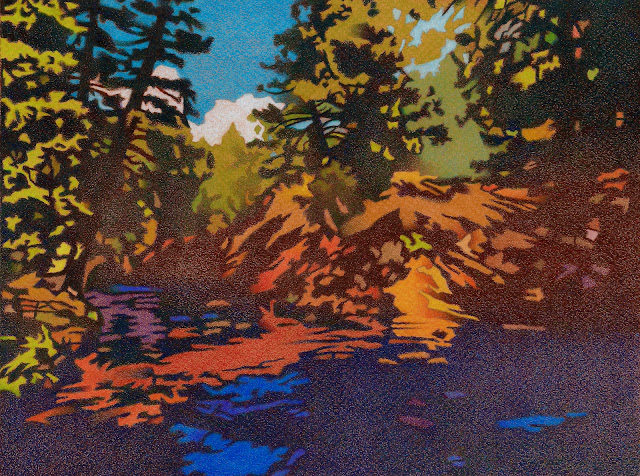 |
| "In the Forest, Bear Creek" Colored Pencil |
It is late summer in the Colorado foothills and Bear Creek is flowing steadily through a narrow, forest-filled canyon. The pastoral scene is a study in contrast involving shapes, edges, values and color.
The forest interior is one of the most alluring places on earth providing asylum from the cold steel, glass and pavement found in the city. Life slows down along the creek where earth, trees, water and air create a comforting atmosphere.
The flickering landscape makes a gradual transition towards abstraction as the indistinct edges of the riverbank melt into the rushing water. The calm ambiance is disrupted by an explosion of streaming light that shatters into small shards of pure color.
It is a natural patchwork of opposing pigments where a warm highlight streaks across the creek’s cool surface. The rock cliff’s sharp angles convey action and dynamic movement that spreads across the unusual drawing.
A murky silhouette of pine trees suggests the tangled canopy of a dense woodland. The vibrant palette is scumbled over an orange-toned paper that permeates throughout the entire piece, unifying the intricate composition.
The depiction of this splendid niche in the planet is meant to express the mystery of an untamed wilderness. Just like the white cloud drifting into the background so will the forest’s fiery mosaic fade into the icy tones of winter.
Rocky Mountain Columbine - A Vivid Buttercup
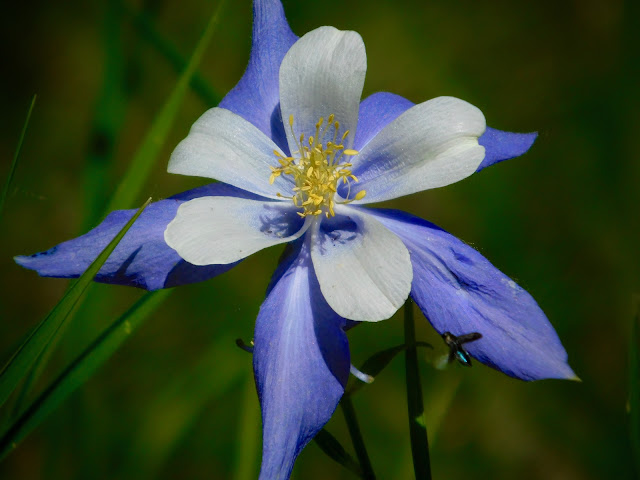 |
| Colorado Blue Columbine |
Winter is here now but not so long ago, the snow-covered meadows were blanketed with colorful blossoms that attracted bees, hummingbirds, butterflies and the artist’s eye. The most revered of these lovely wildflowers is the iconic Rocky Mountain Columbine which blooms from mid-May through July.
An avid hiker named Edwin James first discovered the blue columbine while scaling the steep slopes of Pikes Peak. This hardy perennial thrives at high altitude in the mountain west from the foothills up to the alpine.
Because of its magnificent display of blue-violet petals, white cup and yellow center, the Rocky Mountain Columbine was designated Colorado’s official state flower in 1899. The elegant, triadic, color scheme is a perfect fit because the blue symbolizes the sky, white our eternal snow and yellow our rich gold mining history.
Reclusive despite its beauty, the lovely flower favors moist, rocky soil and it prefers to hide along small streams, near an aspen grove or in the shade of a ponderosa pine tree. After an especially wet spring, I find them more showy in the damp gulches where they sway gently in the warm, summer breeze.
Even though the columbine is successfully adapted to growing here, every fall is must still succumb obediently to the natural rhythm of life. We may be descending into the dark season when the fields are barren but I have bittersweet memories of last summer and those vivid buttercups clinging so delicately to the edges of a dusty trail.
 |
| Along the edges of a dusty trail |
 |
| They thrive at high altitude |
 |
| A magnificent display |
 |
| Colorado's state flower |
 |
| Reclusive despite its beauty |
 |
| A revered wildflower |
 |
| Showy in a damp gulch |
 |
| They favor moist, rocky soil |
 |
| Bittersweet memories |
 |
| Prefers to hide in the shade |
Deep Snow - Beauty Beyond Comprehension
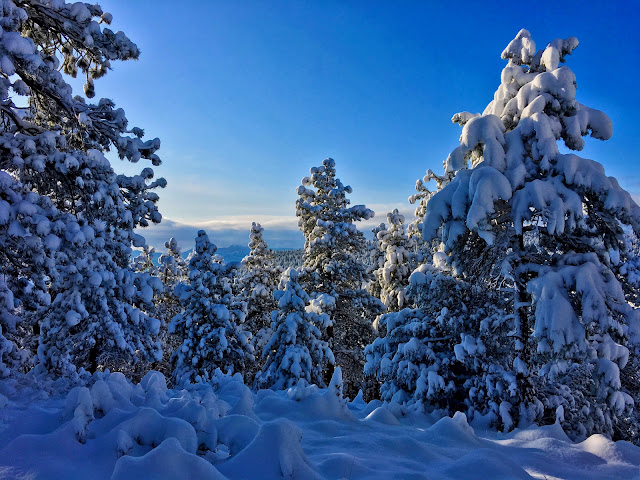 |
| Deep Snow |
On an early-autumn evening, another weather system entombed the valley in blizzard conditions. The precipitation poured down out of the dark sky in a waterfall of huge, white flakes that accumulated indiscriminately onto all exterior surfaces.
A torturous wind whipped down through the meadow, making the intolerable matters much worse. The temperatures crashed to well below freezing and crystallized the foothills into a frozen land of enchantment.
By the next morning, the Rocky Mountains were buried in deep snow while radiating beauty beyond comprehension. Overcast early, the normally rich-hued forest was pared down to black and white.
Ascending the mountain through knee-deep powder was a breath-taking, heart-pounding, sweat-breaking struggle. Upon reaching the summit, blue skies burst through the last remnants of soft cloud cover exposing the storms gorgeous aftermath.
Deep inside the woodland, unavoidable confusion was defined by a wintry mix of strong shadows and filtered sunlight. As the lodgepole pine shook free from their white robes, I got soaked by a cold shower.
From a secluded clearing on the steep hillside, an apparition of gray peaks began to reappear in the vast expanse. The most striking thing about being in the wilderness after a storm is the perfect stillness that exudes an eerie calm.
Going out on a day like that may seem crazy but if I’m going to create honest expressions of the local landscape with pencil and paper, I feel like I have to experience everything the mountains have to offer during the good weather and bad.
While appraising my artwork one day, my college art professor told me that in order to paint the mountains properly, you have to live in the mountains. I took his advice to heart and moved to Colorado, searching for a more personal way to express my passion for the American West.
I’ve lived in the mountains for 30 years now where I’m out in the field every single day no matter what because I want to better understand how snow drapes over the high summits, how rivers shape the lush meadows and how sunlight streams through the deep forests.
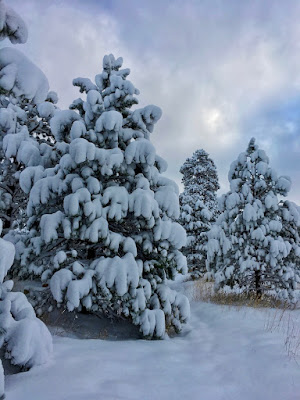 |
| A frozen land |
 |
| Buried in deep snow |
 |
| Radiating beauty |
 |
| Inside the woodland |
 |
| The wilderness after a storm |
 |
| Good weather and bad |
 |
| A gorgeous aftermath |
 |
| The foothills were crystalized |
 |
| Strong shadows and filtered sunlight |
 |
| An eerie calm |
 |
| Blue skies burst through |
 |
| The gray peaks reappear |
 |
| Perfect stillness |
 |
| A passion for the west |
Winter Storm Aubrey - Fall's First Snow
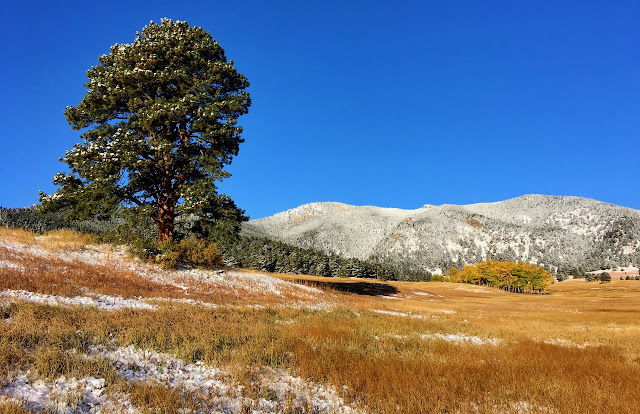 |
| Elk Meadow and Bergen Peak |
This year’s first snow was right on schedule as the Front Range Foothills were laid on the fringe of a freak winter storm named Aubrey. It was remarkable because of the precipitous temperature plunge that accompanied the autumnal weather event.
The arctic-cold air bottomed out at a breathtaking seven degrees Fahrenheit while heavy snow fell hard from a steel-gray sky. The flakes were more like icy pellets that piled up on the ground in drifts of gritty powder.
Fortunately, the wind was not a factor as a battle against the north breeze was something that never developed. Blurred edges were an eerie effect produced by the diffused light, exaggerating the atmospheric perspective so prevalent from the apex of a rugged ridgeline.
On the morning after, clear skies unveiled a vision of the countryside in its finest form. Most of the accumulation in the meadow had melted into the warm earth but the big peaks were still plastered with a frosty glaze.
The fleeting mirage was a rare phenomenon that only occurs in late fall when the orange fields, yellow trees, blue foothills and white summits combine to create a sublime kaleidoscope of fading color.
Within a few weeks, the woodland will be abandoned by most visitors but I enjoy spending time in the empty forest during the dark season. Winter in the deserted wilderness is a sanctuary for absorbing nature’s finest details while tramping in a solemn environment of peace and solitude.
 |
| First snow was on schedule |
 |
| A remarkable temperature plunge |
 |
| The flakes were like pellets |
 |
| Arctic, cold air |
 |
| Heavy snowfall |
 |
| Blurred edges and diffused light |
 |
| Drifts of powder |
 |
| Clear skies unveiled a vision |
 |
| Most of the snow in the meadow had melted |
 |
| The big peaks had a frosty glaze |
 |
| A fleeting mirage |
 |
| A kaleidoscope of color |
 |
| The wilderness is a sanctuary |
Riverbend Ponds - An Idyllic Locale
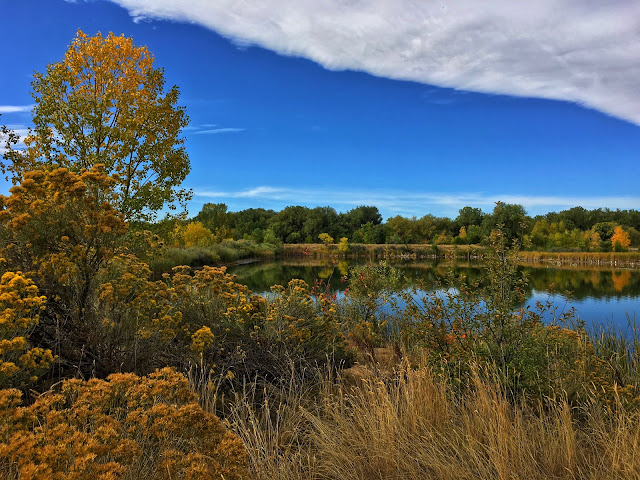 |
| Riverbend Ponds in Fort Collins |
Nestled below the northern Front Range, Riverbend Ponds is a natural area located on the outskirts of Fort Collins, Colorado. It’s absolutely beautiful this time of year because the surrounding forest is an artist’s palette of autumn colors.
The Poudre River and its nearby collection of crystal-clear ponds is a haven for the 200 different species of birds that pass through this wetlands paradise. Dirt pathways criss-cross between the different lakes offering the spectator a delightful perspective from almost anywhere in the park.
During a quick hike along the looping, main trail there are white pelicans, blue herons, snowy egrets, Canada geese and mallard ducks. The prettiest part of the marshy ecosystem is the razor-sharp reflections that decorate the water’s smooth surface.
The peaceful preserve is an idyllic locale where Longs Peak looms over the picturesque valley. A north wind, characterized by its cold bite, blows down from the big peaks carrying with it a premonition concerning a change in the mild weather - the coming of this fall’s first snow.
 |
| A palette of autumn colors |
 |
| An idyllic locale |
 |
| The Powder River |
 |
| A wetlands paradise |
 |
| Razor-sharp reflections |
 |
| Fall's first snow is coming |
River Landscape - Colored Pencil Drawing
 |
| "River Landscape" Colored Pencil |
High in the northern mountains, a slow-moving storm has settled in a secluded river valley. Heavy, low-hanging clouds are beginning to consume the purple peaks and it won’t be long before the entire landscape is devoured by a snowy whiteout.
Down below the disappearing mountains, the dark woodland is a menacing border enclosing the billowy moraine. The meadow is a verdant field during the summer but here it’s gradually turning golden brown.
In an aggressive prelude to the drama that is about to unfold, the red willows are portrayed as separate sections of simplified form. The fallen grasses droop forlornly over the muddy riverbank, reinforcing the picture’s already melancholy mood.
You can feel the spirit of freedom in this wild country where the unpredictable elements are beyond your control. Some of the most spectacular scenes occur in the ethereal light characterized by bad weather conditions.
I admire the resiliency of the immoveable boulders that have been polished smooth by the powerful current of a mighty river. The glistening rocks somehow manage to survive even while trapped in the midst of troubled water.
An Autumn Excursion - The Season of Change
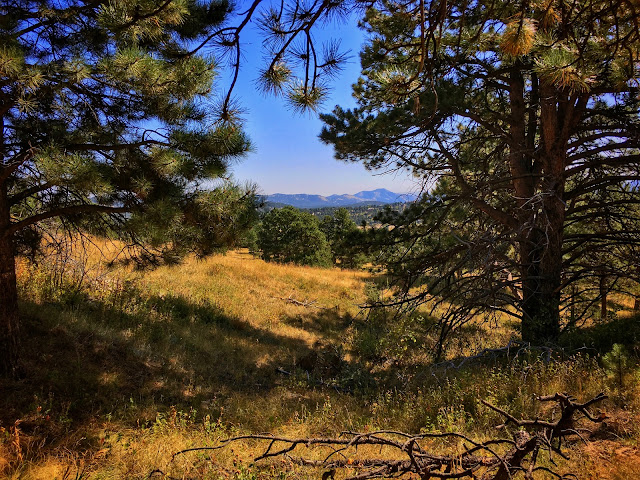 |
| An autumn excursion |
September is an unpredictable month that is sometimes warm and sunny, sometimes cold and windy. It’s that slice of the year when the people, plants and wildlife and are in an urgent transition as they prepare for the inevitable winter hardships.
The weather this fall in the foothills has been mild so the dried grasses are a warm mixture of orange and brown. Most of the aspen trees are just beginning to change but in the deepest, darkest drainages, the groves are glowing bright yellow.
During our last excursion, along the forest’s edge, we watched as a herd of elk grazed heartily while the bull bugled theatrically. A family of Abert’s squirrels gathered food furiously and horded it safely in the heights of a ponderosa pine.
Most of the birds are gone but a few will stay through the cold including the hardy red-tailed hawk who will extract voles directly out of the snow. It must be the finches’ favorite time of the year as they feed on the seed-bearing thistle that thrives in the meadowlands below.
In the low light of a morning’s unblemished blue sky, the harvest moon still hovers over the mountain landscape. The structured ridge line is an idyllic setting that has served as the main subject for many pictures.
After such a short summer, I want everything to stay the same but I know that it’s just wishful thinking. I’m a rigid creature of consistency, stability and routine so I don’t deal very well with this - The Season of Change.
 |
| Seed-bearing thistle |
 |
| Mild weather in the foothills |
 |
| Along the forest's edge |
 |
| The moon hovers over the mountains |
 |
| Most of the aspen are beginning to change |
 |
| Some groves are glowing |
 |
| A short summer |
 |
| The season of change |
 |
| Abert's squirrel |
 |
| Elk herd |
 |
| Red-tailed hawk |
After the Storm - An Exquisite Setting
 |
| Evergreen Lake after the Storm |
A solemn-gray Sunday morning started out with light showers and escalated into a severe thunderstorm that kept everyone shut in. Dark and cold, the slow moving system was characterized by heavy rain, marble-sized hail and scary lightning strikes.
After a few hours, the dramatic weather drifted to the east and the broken clouds allowed shafts of low light to confirm the event’s conclusion. Under such unusual conditions Evergreen Lake was awash with a sheen of surreal color.
After the storm everything was calm and quiet as the drenched landscape was completely devoid of another living soul. The mountain scenery was reflected, with stunning precision, across the water’s smooth surface.
What made the evening so extraordinary was the impressive cloud formation that dwarfed the foothills landscape. The evening’s celestial dispersion eased the tension generated by earlier, threatening tones.
A muddy trail led to the wooden boardwalk that skirted across the boggy wetland of ripened cattails. From that transitional platform, separating land and sea, one was able to truly perceive our fragile existence while soaking in the atmosphere of such an exquisite setting.
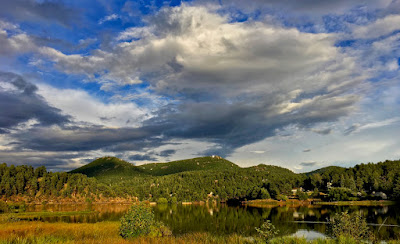 |
| Dispersing clouds |
 |
| A sheen of surreal color |
 |
| Reflected with precision |
 |
| Everything was calm and quiet |
 |
| A celestial dispersion |
 |
| Soaking in the atmosphere |
Upper Bear Creek - Fall is Here
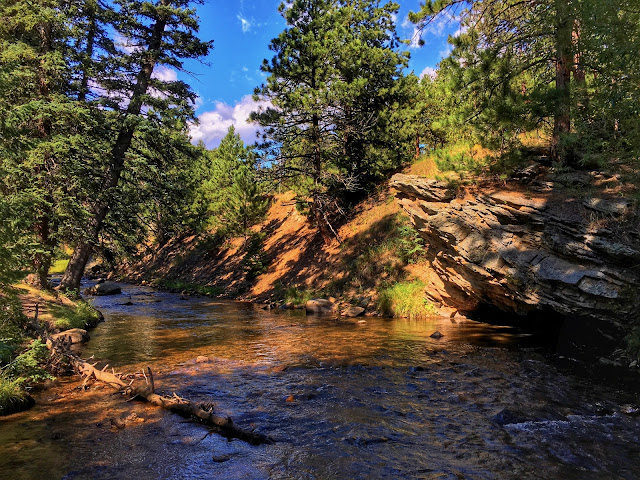 |
| Upper Bear Creek |
Bear Creek begins its incredible journey at Summit Lake just below Mount Evans. The picturesque tributary flows all the way down through the foothills to its terminus in Denver.
In the town of Evergreen, Upper Bear Creek is restrained by a stalwart dam where it’s transformed into a charming lake nestled in the mountains. A couple of miles upstream from the barrier, Dedisse Trail follows the winding path of the wild waterway.
Before drifting into the wetlands delta, the persistent stream cuts through a narrow, forest-filled canyon. Even though the water is running at its lowest level of the year, the rocks and boulders generate whitewater rapids that still exhibit some impressive force.
Down in the dark underworld of lush vegetation, giant conifer trees grow straight up from the water’s edge. It’s a lively habitat where a red squirrel scolds any stranger bold enough to enter its domain and a blue heron moves in a graceful manner while hunting for fresh fish.
The summer season is as fleeting as the flickering light that shines through the dense woodland, creating white sparkles across the water’s turbulent surface. The blooms are spent, the birds are gone, the elk are back, the days are short and the nights are cold - Fall is here.
 |
| A picturesque tributary |
 |
| A wild waterway |
 |
| A lively habitat |
 |
| Trees grow up from the water's edge |
 |
| A persistent stream |
 |
| Flickering light |
 |
| Whitewater rapids |
 |
| Fall is here |
 |
| Graceful Great Blue Heron |
 |
| Temperamental Red Squirrel |
The Rocks and a River - Just Another Day in the Panhandle
 |
| The stormy summit of Courthouse Rock |
Rising prominently out of the low prairie, Courthouse and Jail Rocks are historical landmarks that, once upon a time, guided wagon trains across western Nebraska. Today, the twin towers still loom over the Great Plains and after all these years, they’ve evolved into a formidable challenge to all free climbers.
As Jail’s sheer rock wall is virtually impossible to ascend, we attempted to scale Court on a stormy, Saturday morning this past summer. A careful approach to the base of the beast was necessary because it traversed a rugged grassland rife with deadly rattlesnakes.
We negotiated the lower sections of the imposing ziggurat without much concern as the sticky sandstone offered generous hand and foot holds. To reach the top, the crux of the climb was just below the final tier where we had to overcome the fear and physics of an unimaginable overhang.
While we rested on the slender summit, we enjoyed a panoramic view that ranged from the North Platte River all the way to Chimney Rock. The rapid descent was a little bit dicey because a light rain fell down making the clay crags and chutes extremely slippery.
The ensuing adventure took place on flat land but it traced the contour of a fast-flowing river and it was not less exhilarating. The muddy creek rushed through a flower-filled pasture inhabited by a few horses and a multitude of black cows.
The riparian environment was a haven for all kinds of insects but mostly we saw dragonflies, bumblebees and a profusion of colorful butterflies. A pair of pups led us on the expedition and after the clouds burned off it got hot so they spent most of the time wading in the shallow stream.
The long trek came to a sudden stop when we stumbled into a bog of stinking, sopping mud where we sank as deep as our shins with every step. It was an irreversible dilemma but we slowly sloshed our way out and it wasn’t too long before we found ourselves back on terra firma.
In order to return to the ranch, our final march required us to follow the loud call coming from the flock of peacocks that make our farm home. As we passed through the last gate, we were happy to be greeted by the braying of a little burro.
This annual excursion began on top of the rocks and ended in a soggy bottomland by the river. In our minds this summer’s gathering may have been another misadventure while in reality, it was probably just another day in the panhandle of western Nebraska.
 |
| A riparian environment |
 |
| A fast flowing river |
 |
| The pups led us on the expedition |
 |
| A flower-filled pasture |
 |
| Wading in the shallows |
 |
| A stormy, Saturday morning |
 |
| Jail from the Summit of Courthouse Rock |
 |
| An imposing ziggurat |
 |
| Jail is impossible to ascend |
 |
| Historical Courthouse Rock |
 |
| Just another day in western Nebraska |
Pikes Peak Winter - Colored Pencil Drawing
 |
| "Pikes Peak Winter" Colored Pencil |
Dominating the skyline at Colorado Springs, Pikes Peak has been inspiring explorers, gold seekers and artists for over 200 years. It’s named after the adventurer Zebulon Pike who first beheld the majestic mountain in 1806.
Rising out of rugged terrain, Garden of the Gods is a glorious gateway to the remarkable peak. During the winter Pikes Peak is speckled with white snow as much of the powder has been whisked away by a ferocious wind.
The dramatic scenery features red sandstone slabs that stand out sharply against the dark greenery flourishing below. In this drawing, the white of the paper is the lightest end of the value scale while the foreground shadows are the darkest end.
Shading the bushes is an effective way to create variety in tone, describe forms and imply detail while generating interest in the foreground elements. The subtle gradations clearly define the separate sections of brush.
The composition’s warm undertone is a base layer that forms a foundation upon which to build the rest of the colors. The underdrawing also acts as a neutralizer for the cooler blues and greens that come later.
Toning down those brighter colors results in a more naturalistic drawing. The warm undertone continues to permeate through the finished piece, unifying the composition’s overall color scheme.
The soft shading in the snow gives a hint of the golden granite that’s exposed beneath the peak’s fresh powder. The sky, as it is here, is usually the lightest part of any given landscape because it’s the earth’s light source.
Displaying a simple sky in this composition works because it doesn’t distract from the featured elements - the snowy peak and the dramatic rock formation.
The rock line is a focal point of this drawing because it’s such a unique geologic feature. The backlit rocks display reflected light from the grassland so by shading them from left to right, a warm glow appears along their backside thus replicating an intriguing visual phenomenon.
The middle values are reserved for the middle ground elements. The colors have been subdued by the warm undertone and the details eliminated because that area is a transition zone. It links the two focal points - the red rocks with the white peak.
The green mountain contrasts a bit with the sandstone slabs while the far, blue peaks appear more distant. The snow shadows are a nice violet because of the pink undertone.
Adding yellow to the lower part of the landscape brings that area forward, organizing the illusion of distance as the viewer’s eye moves up the page. The delicate layer of Blue Slate slightly cools and neutralizes the Light Umber, producing a subtle gray in the snow caps.
Shading Indigo Blue into the bushes deepens their color and makes them the darkest objects in the drawing, placing them firmly in the foreground. Introducing Crimson Red into the rock formation directs attention there and being surrounded by contrasting green foliage, that important element becomes even more fiery.
Working Ultramarine Blue into the ashen rocks produces some of the drawing’s darkest values and sharpest contrast. The extra detailing also makes that area one of the more prominent parts of the composition.
The summit of Pikes Peak is intentionally positioned in a compositional sweet spot but the addition of Ultramarine Blue to its shadow also attracts attention. The high contrast between the blue pigment and the white paper pulls the viewer’s eye towards that part of the drawing.
Applying a single layer of Yellow Orange to the rock’s highlights prevents them from being bleached out by the bright sunlight. The soft application still allows for strong contrast but also offers a hint of color, leaving the white snow as the only part of the drawing untouched.
For detailed, step-by-step instructions on how to draw this mountain landscape with colored pencils, please check out the September issue of Ann Kullberg’s Color Magazine
Beaver Brook Canyon - A Chasm of Chaos
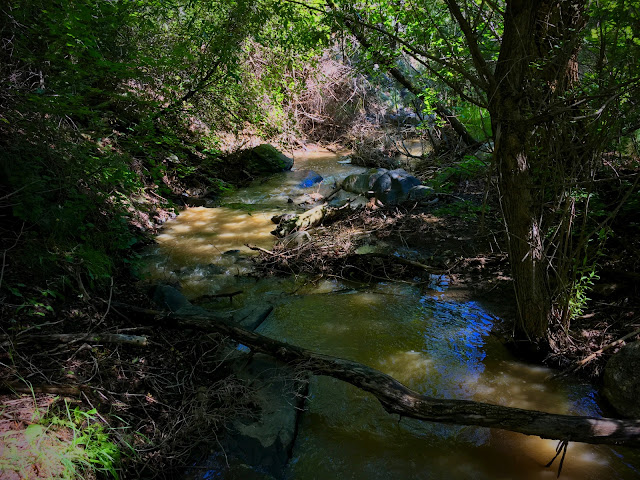 |
| Beaver Brook Canyon |
Beaver Brook is a lovely, little stream flowing through a deep gorge gouged out of the forested foothills. A trail to the water follows a series of dark and steamy switchbacks descending the north wall.
On the way down, pockets of lush wildflowers grow discretely in the dark shadows. At the bottom, where the sun doesn’t shine, a broken trail criss-crosses the cold brook by way of several wooden bridges.
Flickering through the dense foliage, the fleeting light is fractured by summer leaves and brush. Like a beast’s lair, the confusion caused by several caves, caverns and rockfalls forms an imposing impediment.
Somehow, the stubborn creek continues to carve its way through the ancient chasm of chaos. Nothing stops its relentless course as a number of nice waterfalls slices through the entanglement of natural debris.
Ascending out of the deep rock well is a chore but slow and steady is the best way to climb the steep stairway back to the rim. It’s not long before the entire perspective changes and views across the ravine extend for miles.
Luckily, the way back up is made in the cool shade. You’ll know you’re out when the sunlight starts streaming into the scattering of ponderosa pine that clings to the cliff’s sudden drop off.
Before long the woodland breaks into an open grassland where buffalo roam. The strenuous return in sweltering heat requires some physical exertion but the gratifying payback is a lonely plateau full of peace and quiet.
 |
| Discrete wildflowers |
 |
| A lovely stream |
 |
| A chasm of confusion |
 |
| Slice through the entanglement |
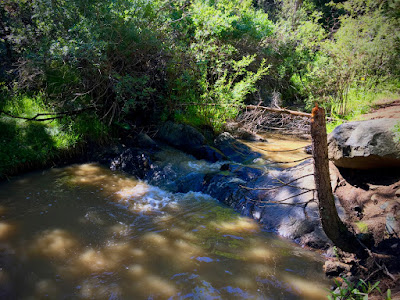 |
| Numerous waterfalls |
 |
| Fleeting light at the bottom |
 |
| An imposing impediment |
 |
| A beast's lair |
 |
| A stubborn creek |
 |
| A relentless course |
 |
| Looking across the ravine |
 |
| A lonely plateau |
Meadow View Trail - Etched in My Mind
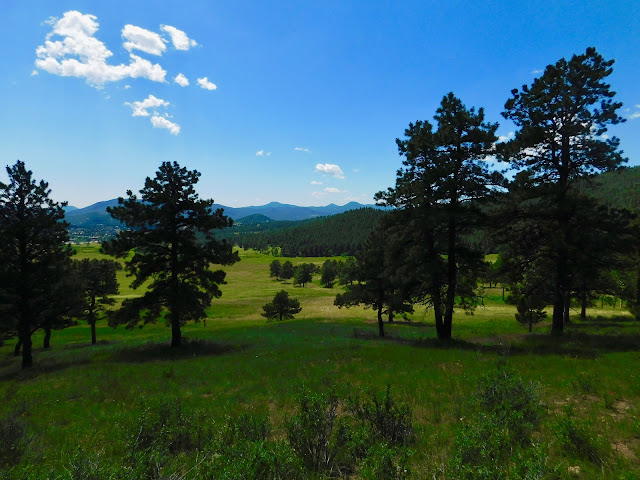 |
| Meadow View Trail |
Meadow View Trail in the middle of summer is the perfect place for peaceful meditation. A small pond situated at the start is the undisputed domain of the double-crested cormorant.
The beaten track traces the forest edge, traversing the broad flank of Bergen Peak. A number of natural overlooks offers the visitor spectacular views of the expansive valley.
The pretty pathway continues to follow the woodland contour while shafts of yellow sunlight penetrate through the scattering of ponderosa pine.
The luminous atmosphere is defined by a cascade of dark shadows that create pockets of sharp contrast throughout the brilliant countryside.
Fragile wildflowers and small stands of aspen flourish in the deep ravines that flow down from the summit. Elk Ridge is the excursion’s highest point where the unobstructed vista unveils the full splendor of the Front Range Foothills.
A careful descent empties the explorer into a vast grassland enclosed by a ring of volcanic peaks. From this lower perspective, the sky becomes a dominant force dwarfing all other elements of the landscape.
As I gaze into the wilderness, I hope the next time I touch pencil to paper this picture etched in my mind will remain as sharp as when I was actually there.
 |
| A small pond at the start |
 |
| Double-crested Cormorants |
 |
| A pretty pathway |
 |
| Flowers flourish in a ravine |
 |
| Shafts of sunlight and shade |
 |
| Broad flank of Bergen Peak |
 |
| A luminous atmosphere |
 |
| Fragile wildflowers |
 |
| An expansive valley |
 |
| Elk Ridge is the high point |
 |
| A vast grassland |
The National Mall - Museums, Monuments and Memorials
 |
| The National Mall |
A few weeks ago I taught a colored pencil drawing class in Harpers Ferry, West Virginia. My family tagged along so after the weekend-long workshop, we decided to extend our stay and visit the National Mall in Washington, DC.
Early Monday morning, during a severe thunderstorm that produced heavy rain and terrible flooding, we headed to Alexandria, Virginia. Upon arriving at our hotel, we hopped on the shuttle bound for Ronald Reagan Airport.
From there we boarded a subway train that carried us into the metropolis. We emerged from the darkness of the Smithsonian Stop and stumbled on a concrete jungle that was choked with chaos and confusion.
Still soaking wet from the persistent downpour, we went into the Natural History Museum first and were impressed by the lavish displays that filled the enormous halls. We examined hundreds of animal species, ancient fossils and impressive meteorites but the highlight of the collection was the astonishing Hope Diamond.
Our second stop was next door at the American History Museum where some of our country’s most compelling memorabilia is stored. The most sobering artifact we saw was the black, top hat worn by Abraham Lincoln on the night he was assassinated.
After the weather cleared, we walked over to and mingled with the crowd located just across from the White House Lawn. Things got wild when a disgruntled citizen jumped over a concrete barrier and attempted to scale the big fence before a force of armed guards, police cars, motorcycle cops and horse-mounted officers appeared on the scene to take him down.
The next morning was more peaceful since we began the day at the National Gallery of Art. Once there, it didn’t take long to realize how special the collection really is as many of the world’s most famous artists are represented inside the spectacular salon.
Some unforgettable highlights from the incredible institution of art was the American Pre-Raphaelites Show, the Rembrandt Room, enormous paintings by Albert Bierstadt and an extraordinary portrait by Leonardo da Vinci.
The different galleries were arranged chronologically so by the time you walked into the Impressionism Room, that movement’s revolutionary way of painting was a radical departure from the earlier works shown in the West Building.
A short stroll across the park took us to the Air and Space Museum where the magnitude of impressive exhibits was overwhelming. The massive building housed rockets, spaceships, airplanes and scientific discoveries that inspired contemplation of the mysteries of our universe.
A strenuous trek was required to reach the base of the Washington Monument which was an imposing structure that rose straight up into the sky. Over the hill and the World War II Memorial was a wonderful, fountain-filled tribute to all veterans who fought in that war.
We continued our hike through sweltering heat and ascended the steep steps to the summit of the Lincoln Memorial where we were rewarded with breathtaking views that extended the entire length of the Mall. The reflecting pool mirrored the beautiful park of patriotism laid out below.
The Korean War Veterans Memorial was especially heartrending because my father-in-law fought in that war and after he made it home, he refused to speak about his experiences over there. The statues depicting a platoon of American soldiers wearing raincoats while marching through dense vegetation was a powerful expression of courage under fire.
Although we covered lots of ground during our vacation, two days just wasn’t enough time as we didn’t see the Jefferson Memorial, the Roosevelt Memorial or the Martin Luther King Memorial. We also missed Arlington National Cemetery and the East Building of the Art Gallery so I’m hoping that someday we’ll be able to return for another visit.
 |
| West Building of the National Art Gallery |
 |
| The White House |
 |
| Reflecting Pool |
 |
| The Washington Monument |
 |
| U.S. Grant Memorial in front of the U.S. Capitol |
 |
| Inside the Natural History Museum |
 |
| The World War II Memorial |
 |
| The Lincoln Memorial Reflecting Pool |
 |
| The Lincoln Memorial |
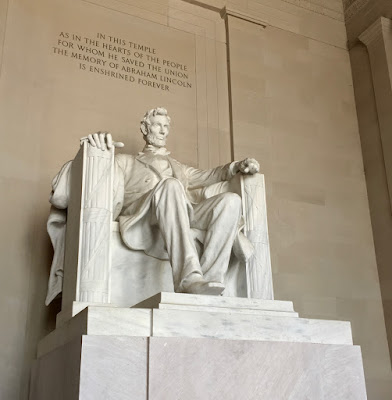 |
| Inside the Lincoln Memorial |
 |
| The Korean War Veterans Memorial was heartrending |
 |
| Statues of American Soldiers at Korean War Memorial |
 |
| A beautiful park of patriotism |
Harpers Ferry - The Epicenter of American History
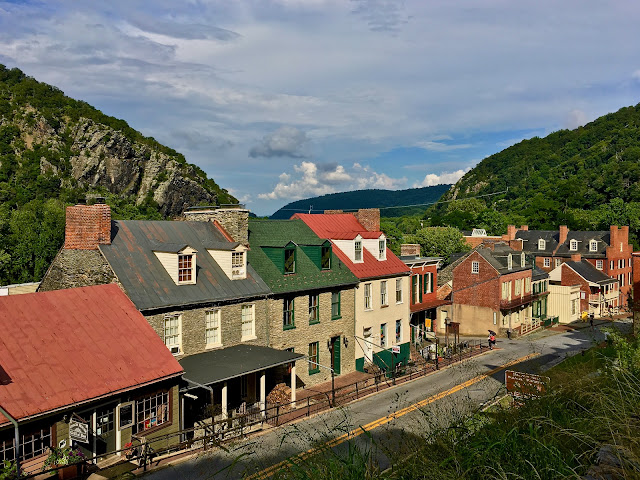 |
| Harpers Ferry, West Virginia |
Harpers Ferry, West Virginia is nestled in the Blue Ridge Mountains at the confluence of the Potomac and Shenandoah Rivers. Established in 1763, the town was a vital hub situated at the epicenter of American History concerning transportation, industry, slavery and the Civil War.
Thomas Jefferson visited the area in 1783 and upon seeing the dramatic gap in the mountains, he declared “the passage of the Potomac through the Blue Ridge is perhaps one of the most stupendous scenes in nature.” George Washington traveled there in 1794 and was impressed by the rugged beauty of the isolated outpost.
Washington eventually chose Harpers Ferry as the site for a new national armory and by 1796 the U.S. military arsenal was established. Merchants, mechanics and immigrants flocked to the western Virginia township because of the commerce generated by the machine shops and rifle works factories.
Probably the most famous event in the town’s rich history was abolitionist John Brown’s raid on the armory in 1859. Brown was vehemently opposed to slavery and armed with weapons taken from the federal arsenal, he intended to lead a slave revolt against the southern states.
Brown and his band of sympathizers took the fort by force but they weren’t able to hold it for long because a team of U.S. Marines, led by Lieutenant Colonel Robert E. Lee, stormed the compound and recaptured the facility. Brown was subsequently found guilty of treason and executed by hanging just up the road in Charles Town.
The raid and its tragic results captivated the nation while sparking a heated debate over the issue of slavery, catapulting the United States into a bloody Civil War. Once Virginia seceded from the Union, Confederate militia attacked the vulnerable armory.
Union troops stationed there were overwhelmed so they fled for Washington while burning the arsenal to the ground on the way out. Harpers Ferry sits on a low flood plain surrounded by towering heights so its position was impossible to defend and being on the line between North and South, the town was horribly ravaged by the conflict.
Possession of this strategic hotspot was difficult to maintain as opposing forces always bombarded it from the nearby mountaintops. Control of the town changed hands fourteen times and most of its homes and buildings were destroyed during the sieges.
The lone exception was Saint Peters Church which flew a British flag from its spire. Both sides respected this sign of neutrality so it survived the four years of war unscathed while serving as a field hospital and conducting Roman Catholic mass.
Today, echoes from the sleepy village’s violent past are barely audible but visual reminders are scattered everywhere down in the lower historic district. It’s fascinating to explore a place that’s shaped by such compelling stories and spectacular wilderness scenery.
The stoic landscape is brimming with lush greenery as lazy waterways meander through the melancholy mountains. While I enjoyed my visit to the East very much with its grand history, temperate climate and lush ecosystem, I still prefer to wander in the wide open West.
 |
| At the epicenter of American History |
 |
| The confluence of the Potomac and the Shenandoah |
 |
| Pedestrian bridge over the Potomac |
 |
| From the Appalachian Trail |
 |
| A fascinating place to explore |
 |
| Railroad bridge over the Potomac |
 |
| Saint Peters Roman Catholic Church |
 |
| Nestled in the Blue Ridge Mountains |
 |
| A sleepy village |
 |
| Most of the town was destroyed during the Civil War |
 |
| Saint Peters survived unscathed |
The Wild Animal Sanctuary - A Haven of Hope
 |
| The Wild Animal Sanctuary |
Out on Colorado’s eastern plains, lions, tigers, bears and wolves roam majestically across the rolling prairie. Viewing the wonderful setting from high ground is like discovering a peaceable kingdom located in the North American Serengeti.
The Wild Animal Sanctuary is an astonishing preserve that exists to rescue and provide a permanent home for wild animals that have been abused, abandoned, displaced or neglected. Most of the inhabitants were born in captivity and confiscated by law from people who tried to keep a large carnivore as a pet.
Because the refugees were confined to backyards, basements or garages, often in deplorable conditions, they can never be released into the wild again but this animal asylum is the next best thing. While visiting TWAS it becomes obvious that the animals’ welfare is the number one priority.
The Wild Animal Sanctuary in Colorado is the largest carnivore shelter in the world. The magnificent menagerie houses over 500 creatures in 80 separate enclosures built across 789 acres of open grassland.
This remarkable refuge currently includes 70 African lions, 85 tigers, 156 black bears, 43 grizzly bears, 20 wolves, 12 mountain lions, 5 leopards and 2 jaguars. The complex also cares for coyotes, bobcats, lynx, fox, porcupines, raccoons, ostriches, emus and a camel.
What makes TWAS different from traditional zoological facilities is its unique viewing platforms. An elevated walkway spans over the enclosures and all visitors are confined to the special bridge, leaving the animals undisturbed.
Animals are naturally territorial so when a stranger encroaches on their land, they react instinctively by either attacking the intruder or running away. This instinctive reaction is known as “Fight or Flight”.
Animals at a regular zoo have neither option as they can’t engage aggressively or get away. The captives are stressed from being sandwiched between crowds of onlookers and the backs of their enclosures.
That anxiety causes the animals to behave in agitated and unnatural ways but TWAS was designed to alleviate that pressure. Carnivores don’t consider the sky to be territory therefore people on the elevated walkways are not considered a threat.
The animals certainly seem at ease despite the visitor's presence looming above. They’re so content that it’s fascinating to observe them while they eat, sleep and play.
All of the habitats have manmade, underground dens that provide shelter from inclement weather. Most of the tunnels go back 30 to 50 feet and maintain a stable temperature of 60 degrees year-round so the animals love them.
If you make the trek out to this remote preserve hoping to see multitudes of exotic animals up close, you’ll be disappointed. Many of the enclosures appear vacant because the creatures are so reclusive, preferring to disappear into the tall grass or deep caves.
The Wild Animal Sanctuary wasn’t created to cater to the curious public. The Wild Animal Sanctuary was conceived as a haven of hope for mistreated animals where they can recover and rehabilitate in peace and comfort for the rest of their lives.
 |
| Marble fox |
 |
| Arctic fox |
 |
| A North American Serengeti |
 |
| African lion |
 |
| Grizzly bear |
 |
| A Peaceable Kingdom |
 |
| The animals seem at ease |
 |
| One of the Grizzly bear enclosures |
 |
| Tiger |
 |
| The largest carnivore shelter in the world |
 |
| Timber wolf |
 |
| Black bear |
 |
| A place to recover and rehabilitate |
 |
| An elevated walkway spans over the enclosures |
 |
| The Eurasian collared-dove is a symbol of peace and hope |
Wilson's Snipe - A Feathered Phantom
 |
| The Wilson's Snipe |
The reclusive Wilson’s snipe lives in North America but you'd be lucky to ever lay eyes on one. Because of his secretive nature, he’s most active around dusk and dawn while preferring to sleep much of the daytime.
When he's awake this plump, little shorebird uses his long, flexible bill to probe in the mud for larvae and earthworms. His unique mandible can move independently upwards allowing him to swallow small prey without having to pull his bill out of the dirt.
The Wilson’s snipe is mottled brown overall with a white belly and streaked breast. Dark stripes decorate his head and back. He makes his nest in the wetlands where his drab plumage blends perfectly into the dried, cattail willows.
His bill is outrageously long and his eyes are set so far back on his head that he can see not only in front and to the sides but also completely behind. He has short legs and massive flight muscles so when he’s flushed from his safe haven he can explode into the air at 60 miles per hour.
The Wilson’s snipe is a feathered phantom and during the breeding season his ghostly persona is further enhanced by a nighttime, courtship display. He circles high above his marshland territory and then suddenly dives straight towards the ground.
This spectacular, aerial maneuver creates a “winnowing” effect that vibrates in the wind creating an eerie sound. Scientists have discovered that this noise occurs when air streams across the bird’s specially designed outer tail feathers.
You may not be able to see this apparition during spring daylight but if you’re in the foothills after dark, keep your ears open because that’s when you’ll hear this common snipe’s haunting notes emanating through the thin, mountain air.
 |
| Active around dusk and dawn |
 |
| A feathered phantom |
 |
| A ghostly persona |
 |
| You'd be lucky to see one |
 |
| Eyes are set back on his head |
 |
| A plump shorebird |
 |
| An apparition |
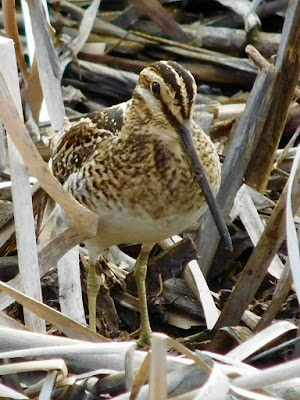 |
| An outrageously long bill |
Mount Rushmore - A Massive Memorial
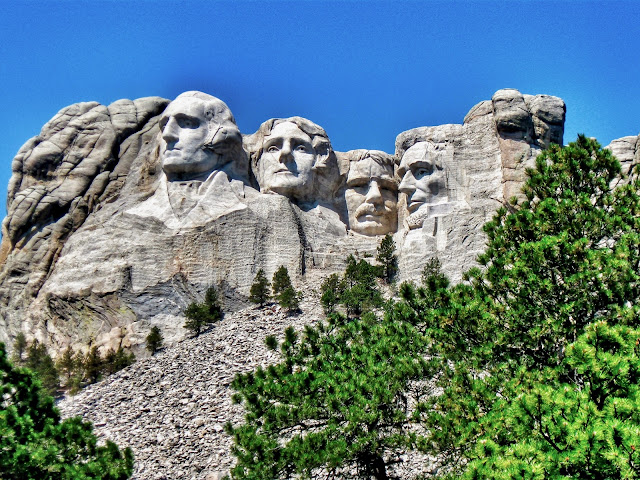 |
| Mount Rushmore |
Exhibited near Rapid City, South Dakota, Mount Rushmore is a magnificent monument sculpted from a granite mountain. The massive memorial is a group portrait featuring presidents George Washington, Thomas Jefferson, Abraham Lincoln and Theodore Roosevelt.
It took artist Gutzon Borglum 14 years to complete the government commission. Concealed in a sacred wilderness of rock and pine called the Black Hills, the creation looks unfinished but rough hewn edges give it a certain sketchiness that blends into the natural environment.
Upon entering the busy complex, a grand boulevard leads to an amphitheater where the sculpture can be closely contemplated. Mount Rushmore definitely exudes patriotism and as an attraction luring tourists to the remote Northern Plains, the astonishing work of art is certainly a success.
Utah - A Celebration of Diverse Scenery
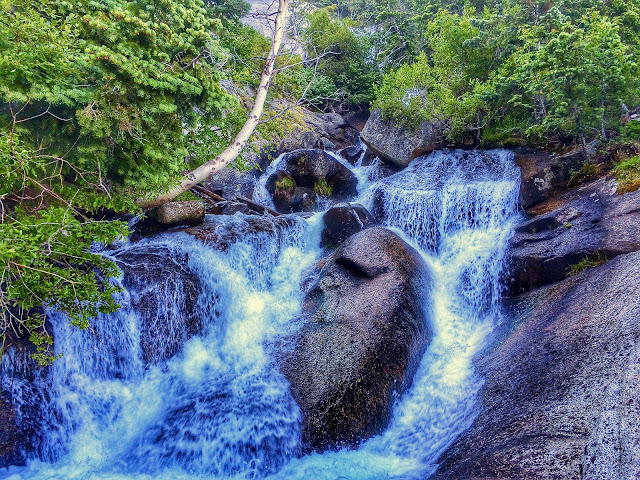 |
| Lower Bells Canyon Waterfall |
Blessed with untamed rivers, deep canyons and green mountains, the state of Utah is celebrated for its diverse scenery. Established on a painted desert, the topography transitions dramatically up to the lofty Wasatch Mountain Range.
The winding waterways rush towards the southwest while carving surreal chasms out of an uplifted plateau. Heavily eroded by wind and water, the unique landscape is littered with an interesting array of arches, pinnacles and hoodoos.
I enjoy wandering around our local foothills and I could spend a lifetime exploring the vast Rocky Mountains. I must admit, though, that the territory to our west has definitely cast a spell. Our home is Colorado but my second favorite state is magical Utah.
 |
| San Rafael Swell |
 |
| Wasatch Mountains |
 |
| San Rafael Desert |
 |
| An untamed creek |
Square Top Lakes - A Wealth of Beauty
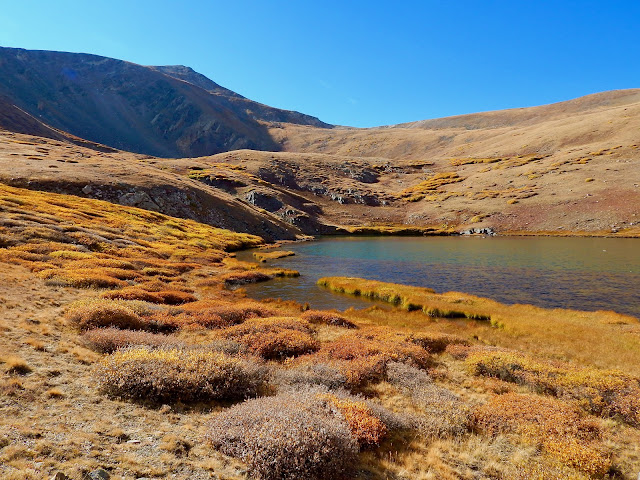 |
| Lower Square Top Lake |
Out of Georgetown up at the top of Guanella Pass there’s a faint trail heading west into the wilderness. Bushwhacking through muddy bogs and thickets of prickly willows, the alpine trek to Square Top Lakes is an uphill battle all the way.
Stair-stepped into the ochre grassland, the cobalt reservoirs are a striking study in color contrast. Twilight softens the landscape and radiates onto the jagged peaks in the distance as passing clouds cast peculiar shadows across Mount Bierstadt and the Sawtooth Ridge.
Spending an afternoon above tree line on a secluded thirteener is a precious experience. While tramping back across the tundra on a warm autumn evening, it’s obvious that the wealth of beauty amassed by these mountains can’t be measured in anything but gold.
 |
| Sawtooth Ridge |
 |
| Peculiar shadows |
 |
| An ochre grassland |
 |
| A wealth of beauty |
The Bay Window House - An Impressive Residence
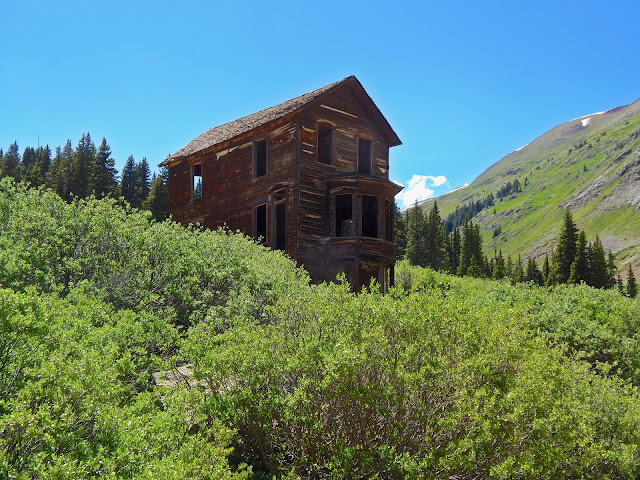 |
| The Bay Window House |
Animas Forks is a rickety ghost town teetering high in the San Juan Mountains just east of Silverton, Colorado. It used to be a bustling community during the silver boom of the late 1800s but today only the miner’s spirit permeates the cool, mountain air.
Pictured above is the best preserved building, an impressive residence known as The Bay Window House. Broken down and beaten after enduring years of nasty weather, the resilient structure rises defiantly out of a dense thicket of green willows.
I can’t imagine how people lived up here all year long, extracting precious minerals from the generous earth. There’s no debate that they enjoyed breathtaking views of the surrounding peaks but struggling to survive the harsh winters must have been absolutely brutal.
 |
| Cool mountain air |
 |
| The best preserved building |
 |
| An impressive residence |
 |
| Rising out of the willows |
 |
| High in the San Juan Mountains |
 |
| A miner's spirit |
 |
| A rickety ghost town |
 |
| Breathtaking views of surrounding peaks |
 |
| A resilient structure |
Alderfer Park - Where Spring has Barely Begun
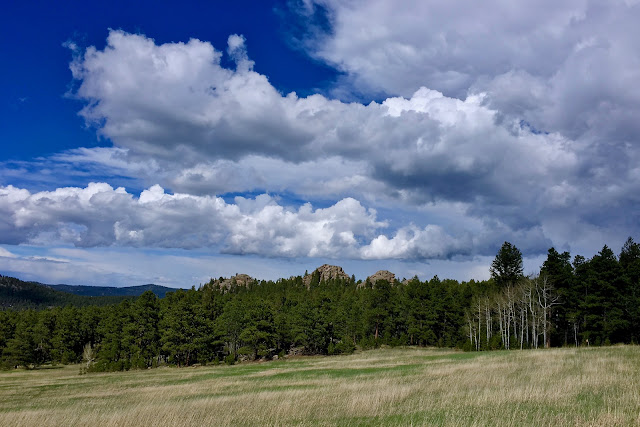 |
| Alderfer Park |
A obscure trail in Alderfer Park descends into a quiet drainage called Coneflower Creek. It’s a fascinating experience wandering deep inside this lost valley where springtime has barely begun.
Its banks crowded by stands of barren aspen, the shallow stream is slow moving because the big peaks that fill it are still locked in a fierce battle with snow and ice.
Blending beautifully into the rocky mountainside, an abandoned homestead and its historical outbuildings are a tangible record of our region’s earliest settlers.
It’s interesting to observe how the wildlife reacts to our sudden appearance. Mule deer are activated into a state of heightened alert and a cottontail becomes frozen solid while a downy woodpecker ignores our very existence.
The gray clouds don’t mean snow but they do suggest the possibility of a dramatic weather effect. Almost every afternoon during the monsoon the sky unleashes a torrent of heavy rain, thunder and lightning.
At the end of the excursion as the evening light shines through a veil of transparent clouds, the ambiance creates a solemn atmosphere that complements the peaceful solitude of an isolated wilderness.
 |
| Mule deer on full alert |
 |
| The big peaks are locked in battle |
 |
| Ice and snow |
 |
| A frozen cottontail |
 |
| A historical record of early settlement |
 |
| Spring has barely begun |
 |
| Coneflower Creek |
 |
| The wildlife is interesting |
 |
| A solemn atmosphere |
 |
| The woodpecker ignored us |
 |
| Peaceful solitude |
Three Mountain Passes - The Crest of a Continent
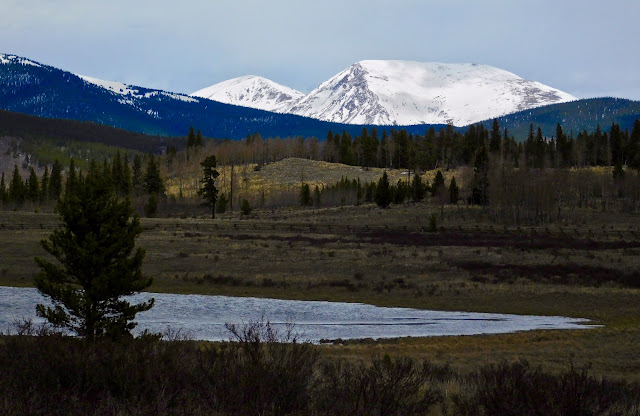 |
| Kenosha Pass |
Recently, we explored three mountain passes that traverse the crest of a continent. It may be spring in the foothills but after a looping excursion through Colorado’s Front Range, we discovered that winter is still lingering in the high country.
Kenosha Pass (10,000 feet) is a wide open space famous for its charming aspen grove and being bisected by the untamed Colorado Trail. The centerpiece of this grassy plateau has to be the sparkling blue lake that reflects the ring of white peaks that surrounds it.
As it’s early spring here, the cool temperatures create persistent snow drifts that are scattered across the muddy earth. Kenosha Pass descends abruptly while forming the steep eastern boundary of the spectacular South Park meadow.
Hoosier Pass (11,500 feet) is a narrow gateway to the town of Breckenridge renowned for its cluster of big mountains and rich mining history. The beautiful landscape is forested with a picturesque combination of subalpine fir and Englemann spruce.
It’s late winter in the raven’s domain where rock, snow and ice dominate this harsh environment. Hoosier Pass rises sharply below steel-blue skies while a steady breeze pours down through the forbidding quagmire of dark peaks.
Loveland Pass (12,000 feet) is an arduous, winding thoroughfare looming over the I-70 corridor while linking some of Colorado’s most popular ski resorts. Positioned well above tree line, it’s celebrated for crossing over the Continental Divide.
Winter is dug in deep here where a ferocious wind blasts your entire being with jagged pellets of ice and snow. Loveland Pass is a harsh environment blessed with panoramic views that include several, legendary mountain summits.
 |
| Kenosha Pass is wide open |
 |
| A lake is the centerpiece |
 |
| White peaks surround it |
 |
| Spectacular South Park meadow |
 |
| Hoosier Pass is a beautiful landscape |
 |
| A quagmire of dark peaks |
 |
| A rich mining history |
 |
| Loveland Pass looms over the I-70 corridor |
 |
| Panoramic views |
 |
| A harsh environment |
The Endless Winter - Sublime Grandeur
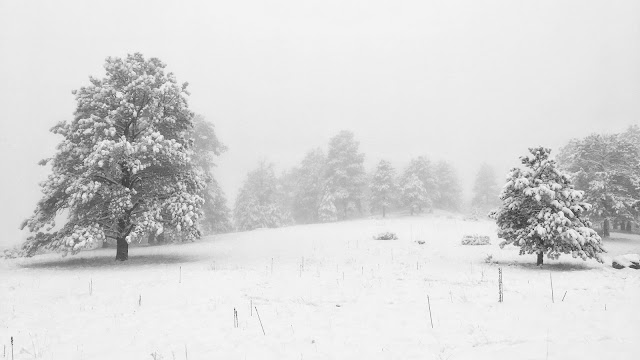 |
| Endless Winter |
The month of May is almost over and the Endless Winter continues to lay siege to Evergreen, Colorado. Day after day a merciless system of unyielding snow keeps falling heavy, wet and cold.
All that moisture combined with warm air creates a ghostly fog that circulates mysteriously through the white woodland. Even the most familiar places seem like strange land because the diminished visibility concocts an eerie atmosphere.
The unforgiving stream of storms has wreaked havoc on the plants, animals and people that inhabit this region. The limber pine trees rooted into the mountainsides are erected to withstand this kind of assault but the nesting birds are understandably distressed.
We’re all accustomed to enduring the long winters that dig in at this altitude and these delayed storms are not unheard of. In all my time living here, the latest date on which I’ve witnessed a substantial amount of snow is June 24th.
What appears like a disaster now will be a godsend tomorrow as the luxuriant grasses will host a profusion of wildflowers and the saturated earth will negate the threat of fire. I guess when viewed from that perspective, we should just sit back and enjoy the sublime grandeur that accompanies slow-moving storms like these.
 |
| The Endless Winter continues |
 |
| Unforgiving storms |
 |
| A strange land |
 |
| A long winter |
 |
| Late storms are not unheard of |
 |
| A merciless system |
 |
| Erected to withstand an assault |
 |
| A substantial amount of snow |
 |
| An eerie atmosphere |
 |
| A ghostly fog |
 |
| A white woodland |
 |
| Sublime grandeur |
Song Sparrow - A Distinguished Neighbor
 |
| Song Sparrow |
In the soggy marshland surrounding Evergreen Lake he sings his heart out. His sweet music includes twenty different tunes and at least 1,000 improvised variations so it’s no wonder they call him the song sparrow.
Full of complex rhythm and emotion, his colorful vocalizations are used to attract females and defend territory. His unique, prolonged melody distinguishes him as a neighbor rather than a stranger.
This common sparrow is an adaptable bird whose behavior and appearance is extremely variable and unpredictable. He is found throughout North America but individuals from different regions look completely different from each other.
In our neck of the woods, the song sparrow is described by brown, heavily streaked plumage, a mottled back and a white throat. His face is gray with a dark eye line and a white jaw line while his reddish crown has a neat gray stripe.
The female builds a nest that’s usually concealed somewhere near the ground but he does help collect the building material. An exposed nest is susceptible to being parasitized by brown-headed cowbirds as their eggs are nearly identical to the sparrows'.
Before being hammered by heavy snow, the sparrow heads down the hill in order to spend the winter at a more hospitable elevation. Another early migrant, he comes back in the spring feasting on insects, seeds and fruit and singing his symphonic song.
 |
| A common sparrow |
 |
| Distinguished as a neighbor |
 |
| An adaptable bird |
 |
| Extremely variable and unpredictable |
 |
| He collects building material |
 |
| Colorful vocalizations |
 |
| Streaked plumage and a reddish crown |
 |
| An early migrant |
 |
| He sings a symphonic song |
Barn Swallow - A Herald of Spring
 |
| Barn Swallow |
According to legend, the barn swallow got its forked tail because it stole fire from the gods to bring to humans. An angry deity hurled a fireball at the swallow, burning away it’s middle tail feathers.
It has distinguished itself as the most familiar swallow in North America and the most widespread swallow in the world. It’s a welcome neighbor as it eats insects and often builds its mud nest under the eaves of man-made structures.
The barn swallow is identified by that deeply forked tail, a vermillion throat and forehead, blue upper parts and ochre underparts. It prefers to live near a river, lake or marsh where it can find its favorite food - bugs.
A supreme aviator, the barn swallow displays a spectacular array of acrobatics in order to eat, drink and bathe while still on the wing. It’s truly a free bird whose daring flight is both delightful and unpredictable.
The barn swallow is a devoted parent who fiercely defends its young with relentless dive bombing. Its other defense strategy involves a surprisingly symbiotic relationship with an intimidating raptor - the osprey.
Sometimes a barn swallow will intentionally make its home just below an osprey’s nest. The swallow makes alarm calls that alerts the osprey to intruders and in return the osprey protects the swallows from all predatory threats.
The barn swallow winters all the way down in Central and South America but the long distance migrant is usually one of our first arrivals. It’s a proven herald of spring, a sign of summer’s approach and a symbol of the resurgence of life.
 |
| He stole fire and brought it to humans |
 |
| The world's most widespread swallow |
 |
| Blue upperparts |
 |
| A supreme aviator |
 |
| One of our first arrivals |
 |
| A devoted parent |
 |
| A symbol of life |
 |
| A truly free bird |
 |
| A herald of spring |
Blue Spring - Wild Weather
 |
| Blue Spring |
Coming into the month of May and our Blue Spring is distinguished by frosted pine, cool shadows and cobalt skies. Winter is gradually releasing its firm grip and after last week’s big storm maybe the Mad Season will finally let go.
The snow keeps pouring but it falls against mild temperatures, transforming flakes into cold water that tries to seep into the already saturated ground. Oh, it piles up during the dark night but by morning it begins to evaporate at the speed of light.
Walking up through the forest can be a calamity because of the wet, muddy trail and being drenched by a shower of snowmelt spraying down from the tall trees. Wandering back out of the wilderness you’ll find yourself, like the current state of the landscape, dirty and disheveled.
This time of year is marked by dust, wind and wild weather but don’t worry because it’s just a transitional period. Soon, the new leaves, lush grass and colorful wildflowers will make everything in the mountains look fresh and clean again.
 |
| Frosted pine, cool shadows and cobalt skies |
 |
| A big storm |
 |
| Melting at the speed of light |
 |
| The mountains will look fresh and clean |
 |
| The trees spray snowmelt |
 |
| Winter has not released its grip |
 |
| Wild weather |
 |
| It's a transitional period |
American Avocet - An Elegant Glow
 |
| American Avocet |
The name Avocet comes from the Italian avosetta, which means ‘graceful bird'. If your looking for the American version of this graceful bird, you’ll find him foraging in the shallow marshes scattered throughout the wide open west.
It’s easy to confirm his identity because of his distinctive features and striking colors. His sleek, white body is set upon a pair of long, blue legs and he has solid black wings broken by a broad, white bar.
The Avocet has an outrageously long, recurved, black bill but his exquisite coloring is what really sets him apart. During breeding season his head, neck and breast is shaded in soft peach while in the winter those same areas are filled gray.
He’s a common shore bird whose breeding grounds are often located along the lower fringes of the Rocky Mountains. He wades across the wetlands scything - sweeping his bill side to side through the water’s surface while feeding on tiny crustaceans and aquatic insects.
He and his mate prefer to live on an island where they scrape the ground, creating a saucer-shaped nest lined with grass, feathers and pebbles. Upon hatching, the chicks feed themselves as they’re never fed by their parents.
The little ones are precocial, moving around independently soon after they’re born. By just one day old, the nimble chicks have the ability to walk, swim and dive in order to escape threatening predators.
The parents are notoriously aggressive towards anything and anyone who approaches their nest or young. They make shrill alarm calls, create distraction displays and dive bomb unlucky intruders.
Come fall, the bird will migrate to a more hospitable environment usually along the California coastline. Before his inevitable departure, though, there’s still lots of time to bask in the elegant glow of the American Avocet.
 |
| A graceful bird |
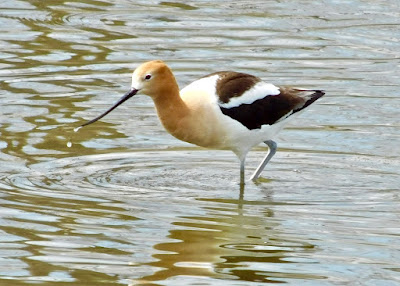 |
| A common shore bird |
 |
| A long, curved bill |
 |
| Distinctive features |
 |
| The head, neck and breast are peach |
 |
| Foraging in a shallow marsh |
 |
| Exquisite coloring |
 |
| Found in the wide open west |
 |
| Protective parents |
 |
| Scything through the water |
 |
| Wades across the wetlands |
 |
| An elegant glow |
Panorama of Winter Weather - Rough Seas
 |
| Winter Weather |
Winter weather has continued to pummel the foothills leaving behind a panorama of white meadows and black forests. The big peaks have all but vanished from the landscape as a layer of thick fog has erased them from view.
The animals are tired of contending with the everlasting cold and wet weather. We are all waiting patiently for Mother Nature’s palette of Spring colors to be painted across the gray environment.
Wide stretches of vast wilderness has become a desolate winter tract into which neither man nor beast wishes to go. Positioned on the Western Front, the region is mired in a rut of mud, muck and monochrome.
There is something hauntingly beautiful about the way the storms come crashing into the mountains. As the new season unfolds, the snow keeps falling in dense squalls that make the trees look like ghosts of the Great White North.
It’s not an ideal situation but battling the harsh elements is the type of adversity that makes us strong. We’ll bide our time while navigating rough seas because in just a few more weeks, we’ll enjoy a summer of smooth sailing.
 |
| A panorama of white meadows |
 |
| And black forests |
 |
| A gray environment |
 |
| Something hauntingly beautiful |
 |
| Everlasting cold and wet |
 |
| Ghosts of the Great White North |
 |
| A desolate winter tract |
 |
| Looking forward to a summer of smooth sailing |
Ushering in Spring - An Arctic Landscape
 |
| Ushering in Spring |
A classic seasonal storm swept across the foothills, lengthening an unending stretch of cold and wet. Dawn broke gray and murky as a thick vapor of fog permeated the pine forest, evoking an eerie atmosphere.
The illusion of great depth was exaggerated as trees in the distance were placid silhouettes while the nearer rocks revealed a rough texture. An abandoned homestead was barely visible as it melded into the haunted hillside.
When the turbulent episode finally hit, the snow came pouring down in sheets of freezing rain transforming the local wetlands into a white valley. Evergreen Lake with its black water, icy shoreline and invisible horizon looked like an Arctic landscape.
The only inhabitants to be found on that frigid evening were a few geese whose silent wake shattered the serene reflections. Although a shock to the system, the winter-like weather is not unusual for this time of year.
By the morning after, powder blue skies began to reappear and that same old cabin came into crystal clear view. The deep forest was a dazzling display of dappled light and silvery shadows.
The trail’s edges were blurred by drifts of melted slush. The wet snow was smothered over everything creating an encrusted shell that can only be cracked by another attempt to usher in Spring.
 |
| Rocks revealed a rough texture |
 |
| Dawn broke gray and murky |
 |
| An abandoned homestead |
 |
| A silent wake shattered reflections |
 |
| An Arctic landscape |
 |
| Snow came pouring down like rain |
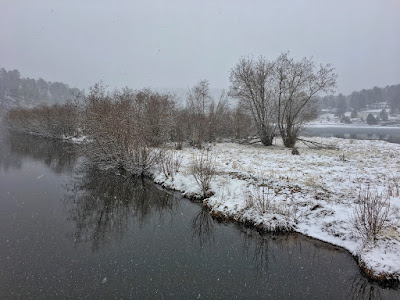 |
| A white valley |
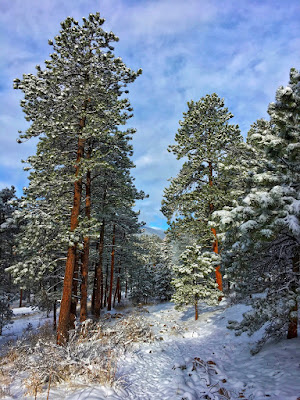 |
| Blue skies began to reappear |
 |
| The old cabin came into clear view |
Last Light on Bergen Peak - First Birds
 |
| Last Light on Bergen Peak |
Bergen Peak’s high summit has been streaked with eternal snow all year long and the mountain’s east face is displayed like a silver facade. Ribbons of gray clouds fill the sullen sky, creating a forbidding flyway.
During the transition between seasons, a mighty wind is funneled down through the foothills’ many drainages. It’s as if the powerful breeze banishes the current, lingering season and brings forth the stubborn, new one.
After such a cold and stormy winter, the still frozen lakes and ponds have delayed the arrival of our feathered migrants. Despite harsh conditions, the first birds I’ve seen were a flock of famished American robins.
The long flight apparently infused the red-breasted marauders with a voracious appetite. The birds were observed on the rocky slopes plucking blue berries from the fringes of a fresh juniper bush.
The robins’ signature calls betrayed their frantic activity that added some color and interest to an otherwise dull and lifeless landscape. I can tell it won’t be long now before the rest of the clan arrives and raises a raucous over nest construction and territory defense.
 |
| A feathered migrant |
 |
| Transition between seasons |
 |
| Wind is funneled through a drainage |
 |
| A cold and stormy winter |
 |
| A silver facade |
 |
| A forbidding flyway |
 |
| Streaked with white snow |
 |
| Robins were first to arrive |
 |
| A voracious appetite |
 |
| On the fringes of a juniper bush |
 |
| They added color to the landscape |
Forest Dwellers - Revealed by First Light
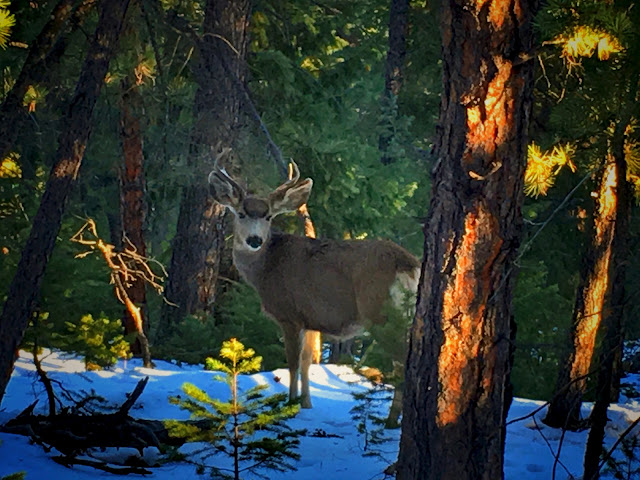 |
| Forest dweller |
On a cold, winter morning while traversing a snowy hillside, a couple of hidden creatures was revealed by the day’s first light. A young doe and buck were foraging so quietly in the shadows that they could have been easily missed.
As they must be used to human contact, they never became startled and seemed to be curious about my ability to maintain balance. The north facing slope is always more difficult to negotiate because the shadowed terrain is broken by rock, snow and ice.
The harsh conditions didn’t seem to bother the mule deer as they were completely at ease while grazing in the depths of a dark woodland. It’s a secretive environment described by dense foliage, damp atmosphere and cool temperatures but it’s a safe haven providing security and shelter to all of its forest dwellers.
 |
| Completely at ease |
 |
| Quiet in the shadows |
 |
| Revealed by first light |
 |
| A secretive environment |
Hooded Merganser - Positively Flamboyant
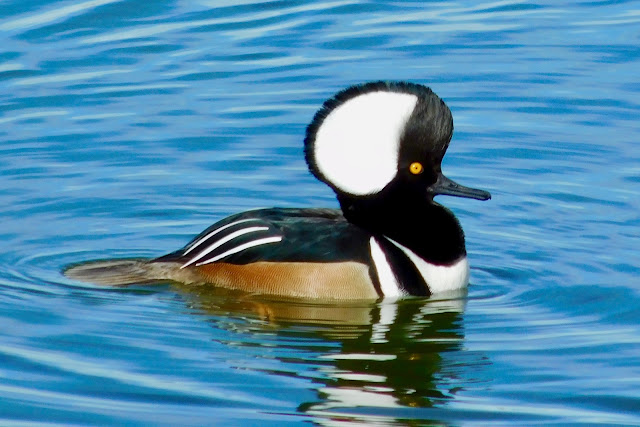 |
| Hooded Merganser |
The hooded merganser is a secretive creature that prefers to live in a secluded woodland somewhere near a small pond or stream. A mated pair nests in a cavity of either a live or dead tree where the female lays a clutch of seven to fifteen eggs.
Remarkably, the fuzzy hatchlings leave the nest within 24 hours after they hatch. Upon reaching open water, the tiny youngsters begin diving and foraging immediately but remain close to mom for warmth and protection.
The hooded merganser is a diving predator and the only duck that specializes in capturing fish. They’re able to track down food by sight because their eyes are specially adapted for unsurpassed underwater vision.
These speedy, little ducks are found almost exclusively in North America. They must like it here because even during the spring and fall their migration routes are usually just a short distance.
Perhaps the most distinguishing characteristic is their striking appearance as both male and female exude elegance in their own way. The gals take on a dusky look with a dark head, bill and chest but they display a fancy orange hairdo that can be raised and lowered at will.
The guys are quite spectacular with bright yellow eyes, chestnut flanks and a white chest that’s crossed by two black bars. Their crest is white with a black border and when fanned out in excitement, the presentation is positively flamboyant.
 |
| A secretive creature |
 |
| Lives in a secluded woodland |
 |
| A diving predator |
 |
| Found almost exclusively in North America |
 |
| Speedy, little ducks |
 |
| A striking appearance |
 |
| Quite spectacular |
 |
| They like it here |
 |
| Crest is fanned out in excitement |
 |
| Positively flamboyant |
 |
| The females exude elegance |
Winter Cyclone - A Blizzard's Aftermath
 |
| A winter cyclone |
Over the past month, the Front Range foothills have been battered by a series of severe storms. The latest of which has been appropriately deemed an historic weather event.
The winter cyclone came spinning into our state from the southwest, dumping buckets of heavy, wet snow. A vicious wind came blasting down through the valley at 70 miles an hour leaving 10 foot drifts in its wake.
The only saving grace during this unique system was the warm temps that pumped much needed precipitation into the parched landscape. After the blizzard subsided and daylight broke, Bergen Peak was a black mountain frosted with white dust.
The big mountain loomed solemnly over a barren meadow of smooth, polished snow. The fresh pack was about knee-deep and required a great amount of physical exertion in order to plow through.
The exposed ponderosa pine were blown clean of any pale lace but in the more protected pockets, the trees were plastered with snow. The silence was eerie as no one else was crazy enough to venture into the frozen woodland.
While it’s much more enjoyable to tramp through the mountains on a warm, summer day there’s something invigorating about experiencing the wilderness after such a fierce snowstorm.
 |
| The foothills have been battered by storms |
 |
| A barren meadow of snow |
 |
| The cyclone was an historic event |
 |
| A black peak frosted with snow |
 |
| Ponderosa pine |
 |
| The big mountain looms solemnly |
 |
| The silence was eerie |
 |
| Drifts were left in the wake |
 |
| Trees were plastered with snow |
 |
| Much needed precipitation |
 |
| After the blizzard subsided |
 |
| The fresh pack was knee-deep |
 |
| A fierce snowstorm |
 |
| A frozen woodland |
 |
| An invigorating experience |
Fillius Loop Trail - A Fortress of Solitude
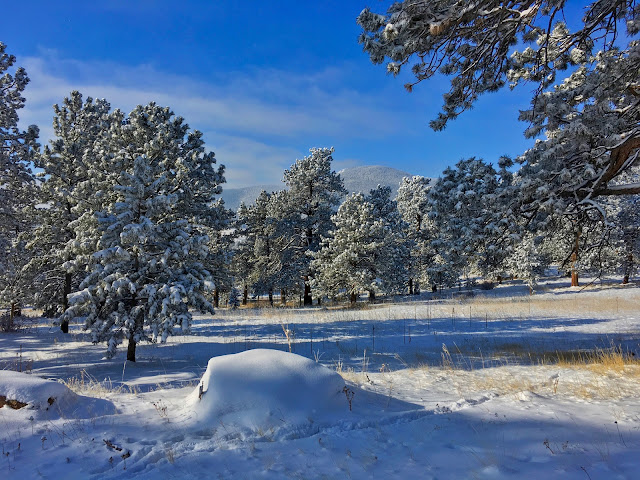 |
| Fillius Loop Trail |
March has arrived like a lion and exerted it’s ferocious nature by unleashing a storm distinguished by heavy snow and sub-zero temperatures. The foothills resemble an arctic landscape reminiscent of the last ice age.
The lower Fillius Loop Trail is in a secluded setting located near the edge of town. The park seems to be not well known so whenever I’m there, I usually don’t see another living soul.
The old-growth, ponderosa pine forest is a steadfast fortress of solitude. The uncultivated woodland is a barrier between an urban environment and the vast Rocky Mountain wilderness beyond.
Last week, the morning after the storm, the trees were glazed with scumbled swatches of fresh snow. Their cobalt shadows crept quietly across the smooth drifts.
Bright sunlight beamed through the clear, thin air while thawing the bone-chilling cold. The distant mountains were dusted white and set against that pale landscape, the sky was the deepest blue imaginable.
Trudging through the deep snowpack was especially difficult as the uneven terrain was broken by rocks, mud and ice. Deep inside the dark forest, traversing a steep, slippery hillside required cautious negotiation.
It was a surreal situation in which the fresh powder sparkled like cut diamonds and the thicket was encrusted with a silvery sheen. March is always our snowiest month so I guess I have more of this fairytale-like scenery to look forward to.
 |
| March has arrived like a lion |
 |
| Trees are glazed with fresh snow |
 |
| A pale landscape |
 |
| Ponderosa pine |
 |
| Trudging through deep snowpack |
 |
| Reminiscent of the last ice age |
 |
| Sub-zero temperatures |
 |
| Cobalt shadows |
 |
| Fresh powder sparkled like diamonds |
 |
| A fortress of solitude |
 |
| An uncultivated woodland |
 |
| March is our snowiest month |
 |
| Deep inside the dark forest |
Urad Lake - Colored Pencil Drawing
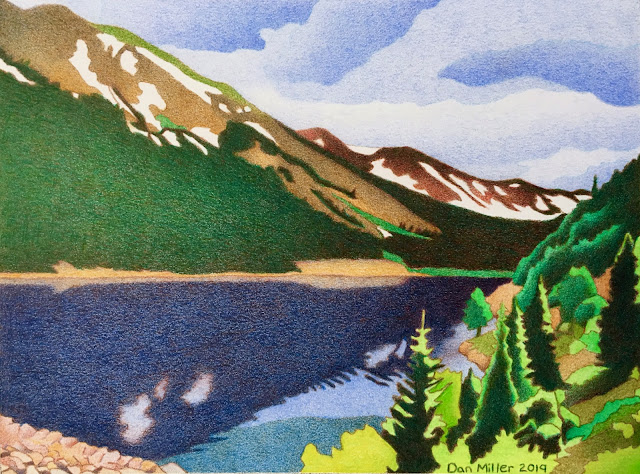 |
| "Urad Lake" Colored Pencil |
“Through art we can change the world.” ~ #twitterartexhibit
It’s a warm, summer evening at Urad Lake with skies of steel blue in the low, fading light. Situated at tree-line below the Continental Divide, the high basin is enclosed by a black forest and dense willows.
An aggressive creek and its lively tributaries come roaring down from the high peaks, spilling into the bottom of a narrow valley while forming a fan-shaped reservoir. Filled with this frigid snowmelt, the water is ice cold.
Patches of resilient snow still cling to the red mountainside and the steep, grassy slopes are dotted with tundra wildflowers. Shapes and colors from the surrounding landscape tint the reservoir with shimmering reflections.
The peaceful haven for wildlife is found off the beaten path just past the outskirts of Empire, Colorado. Flush with fresh air and bountiful fish, the tranquil setting is undeniably therapeutic.
Through trial and error, I try to express my admiration for the great outdoors through art with hopes that others will approve of the final product. I want to inspire people to appreciate the same beauty in nature that I do.
Urad Lake is my contribution to the upcoming Twitter Art Exhibit: Scotland. This unique event is an international exhibition of original postcard art supporting Art in Healthcare.
It is well known that art can have a positive impact on an individual’s health and well being. Art in Healthcare is an Edinburgh based charity whose core aim is to have “a Scotland in which visual art improves health and keeps people well”.
Art in Healthcare works closely with a broad cross section of healthcare providers in hospitals, GP surgeries, community care groups, hospices, healthcare centres and other bodies involved in the provision of healthcare to run a series of carefully tailored art workshops throughout the year.
The programme of art workshops which is led by professional artists and aided by volunteers have grown steadily since 2011 enabling Art in Healthcare to reach a broader cross section of patient groups. In addition the Charity has a large collection of contemporary artwork which is displayed in healthcare premises across Scotland.
Funds raised by TAE19 will enable Art in Healthcare to develop and extend their workshop programme to benefit more people within the healthcare system. All Art In Healthcare’s workshops bring the power of creativity to people in times of need whether in a hospital, care home, community health centre, hospice or any other healthcare setting.
Twitter Art Exhibit: Scotland is the ninth installment of this open international exhibition of handmade postcard art for charity, donated by artists from around the world.
Social media plays a major role in the Twitter Art Exhibit. It is their intention to tweet, share and promote contributing artists to thank them for their participation, and to make this event a success for all involved.
The event will be highly publicized and well attended by art buyers and enthusiasts, members of the press, local artists and the TAE community.
For more information, please check out this link: #twitterartexhibit
Ponderosa Pine - At Home in the Mountains
 |
| Ponderosa Pine |
This week's post is written by my uncle, Jerry Covault. Jerry is a retired United States Forest Service Ranger. During his 33 years spent working on National Forests in Oregon, Colorado, Wyoming and Montana, he has learned about the relationships between mountains, forests, soils, weather, fire, animals and people.
Jerry shares some of his unique experiences in his new book "About Forests and People". He resolves to stimulate interest and curiosity about trees and forests and how people use them both through the ages and at present time. Jerry also discusses the problems our forests and environment have today and he suggests a few things that can help.
The following essay by Jerry Covault is taken from his book "About Forests and People".
Ponderosa pine is handsome and it gets big. To be in a stand (a foresters’ term) of big ponderosa with their orange plates of thick bark shining in the sun is akin to being in a grand cathedral - better. Ponderosa pines have long dark needles wrapped in bundles of twos and threes. Those dark green needles get even darker in winter. They are the source of the name for the Black Hills of South Dakota. It’s a good thing ponderosa is so striking to see because its name sure doesn’t give any hint of what it’s about.
These beauties like to show off so they like to be in the lower mountain elevations where people can see them. That hasn’t been a great strategy for the biggest trees because it made them the first ones cut by early loggers in the West. The stories of driving a team of horses pulling a wagon for miles though valleys forested with big ponderosa are pretty much all we have left of those times, see the book, "Following Old Trails" by Arthur L. Stone, Missoulian Editor, 1913. Those beautiful ponderosa pine stands were the result of management policies by Native Americans over long periods of time. They set fire to the forests - often. That meant the flame lengths were only four, eight, or maybe twelve feet because of the frequent burns there wasn’t much fuel on the ground to carry a hot fire. These “cool” fires would not kill the bigger trees because their thick bark insulates the phloem and cambium, but the "cool" fires would stimulate the growth of grass and shrubs the following year, providing excellent feed for deer, elk, and buffalo the people relied on for food. This forest management policy served the people well for over four hundreds of generations.
These fires would certainly kill any small trees in the way of the flames, but fire in the forest doesn’t burn uniformly. There will be many spots within a fire’s general perimeter that are not burned or burned very lightly. It may be that there was not enough ground fuel to carry the fire, or the humidity came up, or the wind changed, or night came, whatever the reasons, some areas within a fire are left unburned. Small trees survive in these spots. In the next fire cycle, these small trees may have grown their bark thick enough to survive a cool fire and they are on their way to becoming a 250 year old big beautiful orange barked ponderosa - that smells like vanilla, or butterscotch if you smell the bark up close. These trees are somewhat shade tolerant, but not total shade. That characteristic causes the trees to be spaced out so everyone gets some sun and trees of various size and age are growing near one another. These factors make for what is called a “park-like” forest. We can visualize that. So when the early settlers came, there were beautiful park-like ponderosa pine forests, provided by the First People’s management and time - hundreds of years.
The fire management strategy that created the mature ponderosa pine forest in the valleys was really designed to stimulate the grasses and shrubs for the grazing and browsing animals the people needed to survive. If a change in weather caused a fire that had been burning for several weeks to become a threat to their village, the people could simply take the cover off the lodgepoles and move their homes out of the way.
When settlers came to the valleys it was a different story, they built permanent homes, barns, fences, etc.. These structures needed boards, the big pines were cut to make those boards. Fires could not be tolerated because if a fire burned freely it could burn homesteads - and that was before insurance was invented. A new policy would evolve for managing ponderosa pine forests, the policy we are living with today. It doesn’t include allowing trees to become 250 years old, we can make use of their wood long before they reach that mature age. Today there aren’t many of these magnificent old growth ponderosa pine forests, the few exist in specially protected areas such as Wilderness, special study areas on public lands and a few places here and there where a continuum of people who simply appreciate beauty have said, "no we won’t cut these pines, at least not now."
Favorite
What’s your favorite -----,
Grampa?
A fair question.
One way a young boy divines
His own preferences, and the World.
“What’s your favorite tree?”
No one-line answer for that one!
A beautiful question,
Deserving an answer from
Head and heart.
Alpine Larch, an evergreen that speckles the mountains yellow in fall,
Rocky Mountain Juniper, resident of the dry foothills,
Western White Pine, simply regal and beautiful,
Aspen, Kelly green in spring and flaming candles in fall,
Alpine Fir, sharp pointed top, high on the mountain,
Cottonwood, companion to rivers,
Ponderosa Pine, its trunk a puzzle of orange plates,
Red Cedar, mysterious, where gnomes live,
White Bark Pine, artful, high on the mountain,
Mountain Hemlock, always bowing at its top,
Lodgepole Pine, straight as an arrow, except when they’re not,
Good reasons for each:
Beauty, dominance,
Fast growing,
Inspiring, populace, persistent,
Long lived, interesting.
I think it has to be ----,
Ponderosa.
It is at home in the mountains
Where snow comes in November,
Goes in April.
It shares space with grass,
Brush, wild critters
And,
When they let it,
People.
Common looking when young,
At maturity it’s
Beauty comes together,
Color, size, shape, and quiet
welcoming presence.
Ponderosa shows experience
and balance.
It is adapting, persisting,
Sharing.
It knows how to occupy space
In time and on the land.
Allowed to, ponderosa pine will,
With earth, fire, wind, rain
And time,
Form a beautiful community.
People need to think about that.
I guess Ponderosa Pine is my
Favorite.
That’s a good question Sam.
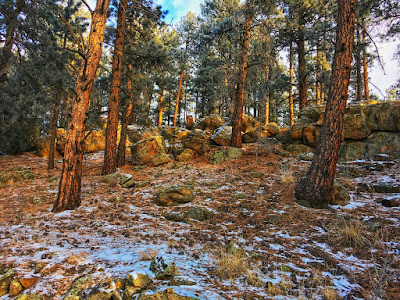 |
| These beauties show off |
 |
| A Grand Cathedral |
 |
| A quiet, welcoming presence |
 |
| A park-like forest |
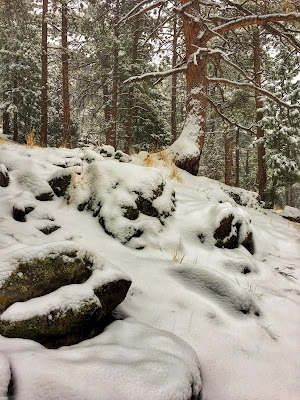 |
| A magnificent forest |
 |
| A beautiful community |
 |
| It shares space |
 |
| Handsome and big |
 |
| At home in the mountains |
 |
| Adaptable and persistent |
 |
| Striking beauty |
 |
| Ponderosa Pine is my favorite |
Moraine Park - Where Alpine Beauty Begins
 |
| "Moraine Park" |
During the early winter, ice chips are sprayed down from the Great Divide into the Moraine Park Valley. Heavy clouds lurk towards the horizon erasing from view the big peaks that confine the isolated meadow.
The glacial gorge was gradually created by the corrosive forces of ice, wind and rain. One of the eroded land’s last dynamic remnants is a wild, winding river known as the Big Thompson.
At this point in its course, the creek meanders lazily through the gentle grassland. Some of the most distinguishing features are the protruding boulders that seem to stand upright during the season’s low tide.
The yellow-ochre field is gouged by muddy, black banks that slide into the sandbars of rocky rubble. Tangled rows of red-violet willows adorn the deep fringes of this gorgeous waterway.
It’s a heavenly region tucked away high in the northern Rockies where Colorado’s alpine beauty begins. As the grandeur continues to sprawl south, there are innumerable nooks and crannies that are going to take more than a lifetime to explore.
 |
| Early winter |
 |
| Moraine Park Valley |
 |
| Heavy clouds lurk |
 |
| Big peaks confine the meadow |
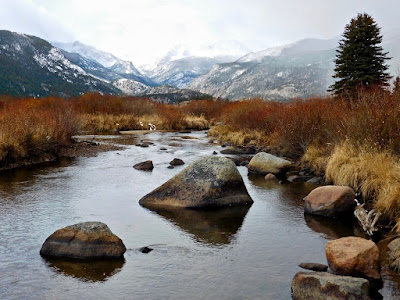 |
| A dynamic remnant |
 |
| A wild river |
 |
| Alpine beauty |
 |
| Ice chips |
 |
| Big Thompson River |
 |
| Meandering lazily |
 |
| Sandbars of rocky rubble |
 |
| Gouged through an ochre field |
 |
| Muddy, black river bank |
 |
| A heavenly region |
 |
| A lifetime to explore |
Mount Evans Snowscape - Mixed Media
 |
| "Mount Evans Snowscape" Mixed Media |
It's a cold and windy day in a spectacular basin known as Upper Bear Creek. Buried under a blanket of fresh snow, Mount Evans is a lofty landmark that imposes it’s iron will on the local weather patterns.
Tethered to the foreground, sturdy evergreens are built to withstand the brutal storms that wreak havoc on this hidden valley. Here, heavy snow clings to the blue spruce creating an intricate pattern of dark and light.
This time of year, the landscape can only be expressed with mostly cool colors like blue and green. Surprisingly, there’s also some pink and yellow washed into the high peaks looming above the white glen.
Such a difficult medium to work with, watercolor painting demands that you relinquish control. Most of the fluid brushstrokes are allowed to flow freely as they encourage you to let your imagination run wild.
Strokes of colored pencil are scribbled across the textured surface, giving a loose suggestion of the vast wonderland. Icy skies set the ominous tone that permeates the arctic atmosphere, instilling the inhabitants with a sense of dread.
It’s an uncomfortable morning devoted to tramping around on treacherous terrain. The risk involved in such an undertaking is worth it though because being immersed in such pristine surroundings is an unforgettable reward.
Swainson's Hawk - A Graceful Buteo
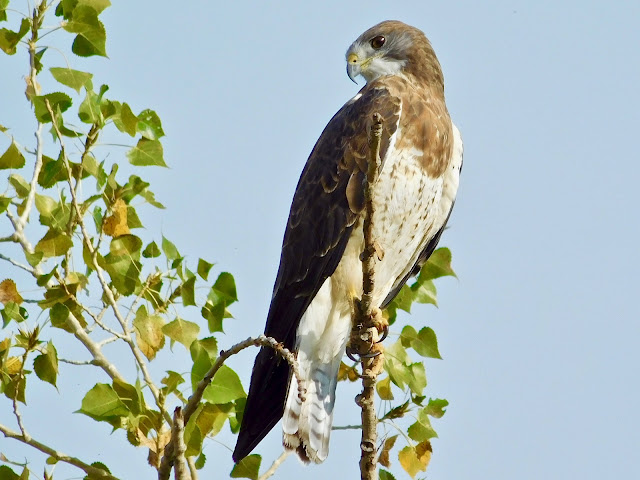 |
| Swainson's Hawk |
Soaring majestically on summer thermals, the Swainson’s Hawk is a graceful buteo of the Great Plains. It gets its name from an early 19th century illustrator of natural history, Englishman William Swainson.
Found mostly east of the Continental Divide, the species’ light phase is quite elegant. This narrow-winged hawk has dark flight feathers, white underwings and belly, a finely barred tail and a handsome rufous bib.
Once a mated pair finds a site near the top of a solitary tree, they build a large stick nest and aggressively defend their isolated home. They feed the chicks a steady diet of rodents, rabbits and reptiles.
When not in breeding season they voraciously eat a large amount of insects. They devour so many that in some rural regions of North America they are referred to as a grasshopper hawk or a locust hawk.
The most remarkable behavior displayed by this amazing raptor is the astonishing, yearly migration to Argentina. In late summer they flock up by the thousands and the entire population flys to South America en masse.
As the birds make their incredible journey they’re funneled through Central America and by the time they reach Panama City, the sky becomes darkened by the feathered horde. I’ve never witnessed such an event so I can only imagine what a surreal sight it must be.
 |
| A graceful buteo |
 |
| Named after William Swainson |
 |
| The light phase is elegant |
 |
| Grasshopper of Locust Hawk |
 |
| An amazing raptor |
 |
| The birds make an incredible migration |
Teton Wildflowers - Watercolor
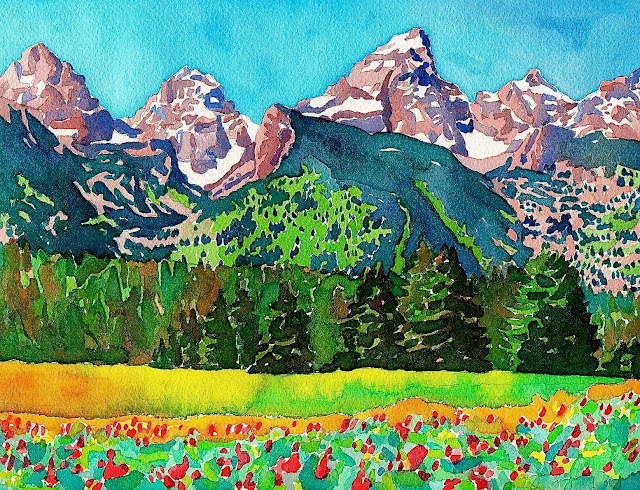 |
| "Teton Wildflowers" Watercolor |
During the dead of winter, I start yearning for the sound of birds and the scent of wildflowers. What better way to spend some down time than daydreaming about warmer weather while sketching with brushes and watercolor.
The Tetons are an impenetrable domain of jagged alps straddling Wyoming’s western frontier. Filled with flora and fauna, this rugged wilderness erupts with surreal beauty during the fleeting summer.
Blue trees cascade down into the forest meadows where fresh prairie grass is dotted with a profusion of Indian paintbrush. Looming above this American Arcadia, the spectacular peaks take on a tinge of pink during the peaceful mornings.
The geography is situated at a unique geologic junction. An extraordinary place where the northern plains were folded, buckled and exploded, creating the youngest mountain range in the Rockies.
There are no foothills as the outrageously steep pinnacles span over the surrounding landscape. It may be hard to believe but after spending time in the Teewinot, the natural charm found there might rival the grandeur of colorful Colorado.
Frozen Foothills - The Beauty of Snow
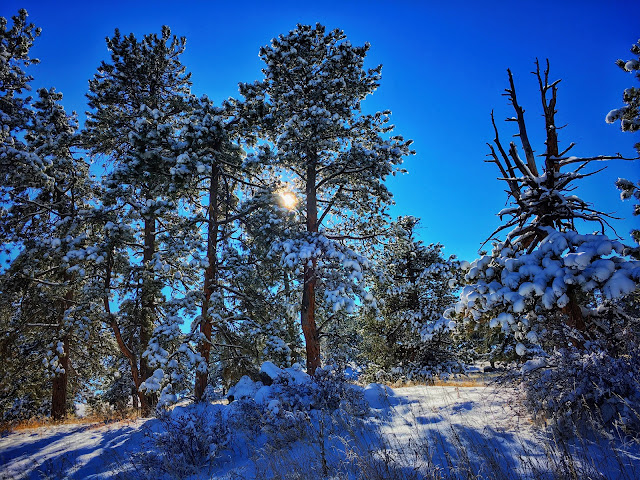 |
| Beauty of snow |
Deprived of sunlight, January is a dark month defined by brown meadows, black forests and gray brush. This forbidding time of year is exacerbated by isolation, solitude and endless waves of bad weather.
The storms come steamrolling down from the divide, dumping incredible amounts snow in a short amount of time. The wind-driven event shrouds the valley in a ghostly rampart that erases everything from view.
The next morning as cloud cover dissipates, warmer air is released into the atmosphere allowing an arctic chill to settle over the frozen foothills. The glistening, fresh powder instantly transforms the dreary landscape into a winter wonderland.
Pure, white snow brightens the area’s muddy palette as the trees appear greener, the grasses more yellow and the bushes more violet. The sparkling sky is a smooth gradient blended from cerulean to cobalt blue.
The forest is decorated with laced pine whose needle clumps collect drifts of plastered snow. The limber warriors are built to withstand the burden of heavy weight as they bend into impossible angles without breaking.
Making a trail through the park’s hard pack is a bear but the glorious scenery is worth the slog. The place is completely quiet except for the crunching of boots and the lively caws of a few hardy crows.
Springtime in the Rockies reinvigorates the soul while the summers are short and sweet. Fall is a magical time of year but there’s nothing in the mountains that compares to the beauty of snow.
 |
| Frozen foothills |
 |
| Glistening, fresh powder |
 |
| Winter wonderland |
 |
| A brightened palette |
 |
| Decorated with laced pine |
 |
| Needle clumps collect snow |
 |
| Limber pine are built to withstand weight |
 |
| Glorious scenery |
Kountze Lake - Teeming with Waterfowl
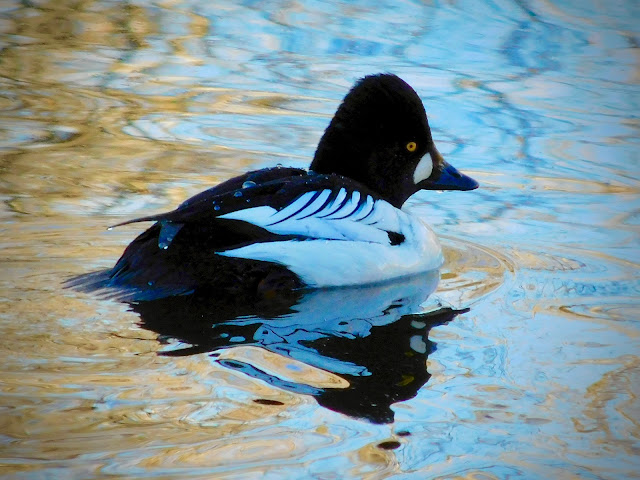 |
| Common Goldeneye |
Kountze Lake is a man-made reservoir located in the middle of the city of Lakewood. During spring and summer, the central oasis is a hotbed of activity for both birds and animals but it seems to be busy this time of year too.
Upon entering the preserve, a vacant woodland was sparse with inhabitants save for a few fox squirrels. At the waterfront from out on the pier, the partially frozen pond was teeming with babbling waterfowl.
Canada Geese were shown in force, far outnumbering the rest of the birds. Conspicuous amongst the herd, a few white-headed floaters must have been hybrids of the Canada and the snow with their speckled plummage glittering in the evening sun.
Also basking in the warm sunlight, a male mallard’s already iridescent coloring sparkled even more brilliantly. The shovelers segregated themselves from the rest of the pack, staying close to shore on the rocks while forming a striking silhouette.
Most active of the bunch was a goldeneye that kept diving into the frigid water, disappearing for several seconds at a time. We weren’t expecting to see much wildlife on such a cold, winter day so we were surprised to encounter so many birds at such a small, urban lake.
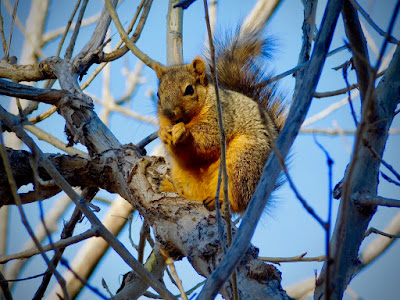 |
| Eastern fox squirrel |
 |
| Conspicuous amongst the herd |
 |
| Canada Goose x Snow Goose hybrid |
 |
| Iridescent mallard |
 |
| Northern shoveler |
 |
| A striking silhouette |
 |
| An active goldeneye |
 |
| Disappeared under the water |
Bald Eagle - A Regal Bird of Prey
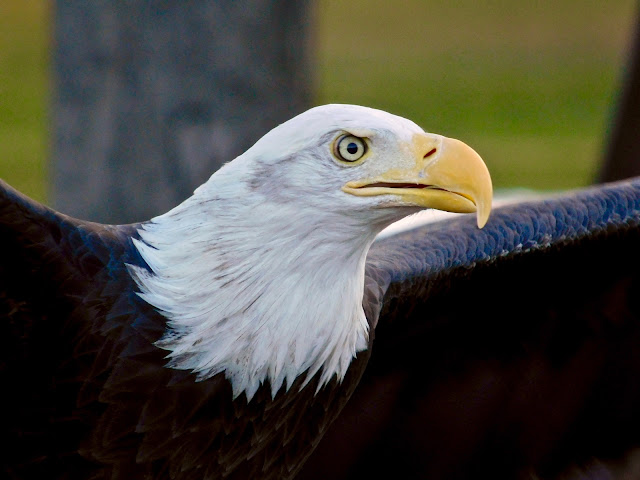 |
| Bald Eagle |
Back in 1872, Benjamin Franklin argued against the Bald Eagle’s nomination as the United States national symbol. The shifty bird’s frequent thievery prompted him to write that the bald eagle “is a bird of bad moral character”.
Franklin believed the wild turkey was a better selection because it was “a much more respectable bird”. While it’s true the bald eagle is an opportunistic feeder that will scavenge carrion and steal prey from other raptors, it’s also a fearsome hunter.
This huge, dark-bodied bird, with a seven foot wingspan, white head and tail, razor sharp beak, deadly talons and extraordinary yellow eyes is a fish’s worst nightmare. Although seafood is it’s favorite meal, the bald eagle will also strike turtles, snakes, ducks, geese, muskrats and rabbits.
The regal bird of prey can only be observed in North America but you can find them just about anywhere on the continent. They build some of the largest stick nests on earth with some measuring eight foot across and weighing up to two tons.
They prefer to make their home near an aquatic habitat such as lakes, rivers, reservoirs or oceans. If the local water source stays thawed during the winter, the cold tolerant eagles will reside in their territory all year long.
Mated bald eagles are paired for life and share all domestics tasks from nest building to hunting to caring for the young. They are devoted parents who faithfully safeguard the yearly clutch of two eggs and dutifully teach fledglings how to fly.
During the mid-to-late 1900s, the bald eagle population was decimated by hunting and poison, necessitating urgent conservation and a ban on DDT pesticide. The maligned bird became a national symbol despite support for awarding that honor to a turkey and now the resilient raptor has fully recovered from the brink of extinction.
 |
| A fish's worst nightmare |
 |
| A regal bird of prey |
 |
| Cold tolerant |
 |
| A national symbol |
 |
| Back from the brink |
Western Slope Winter - Colored Pencil Drawing
 |
| "Western Slope Winter" Colored Pencil |
It seems like there’s always more snow on the other side of the Great Divide especially in the bottom of the Blue River Valley. During January deep drifts occur in the long shadows of giant peaks.
Bad weather usually wreaks havoc at night but often breaks just before daylight. A clear sky in the morning means transparent light with a sun glare that stings the eyes and a frigid temperature that burns the skin.
In this snowscape, a jagged range exhibits sharp features while thin clouds whisk across a pale sky. The forest’s edge is a conglomeration of strange shapes creating a wind break separating the white slopes from the arctic plain.
The sparkling hues are a phenomenon that can only be seen in the mountains the morning after a storm. The pointillistic image is like a mirage broken by bits of pure color that, from a distance, fuse in the viewer’s eyes.
Even in winter, the foreground of brush, twigs and branches is described with predominantly warm tones. It’s the dawn of not only an unspoiled day but the thoughtful unveiling of a pristine new year.
Sprague Lake - An Unforgiving Environment
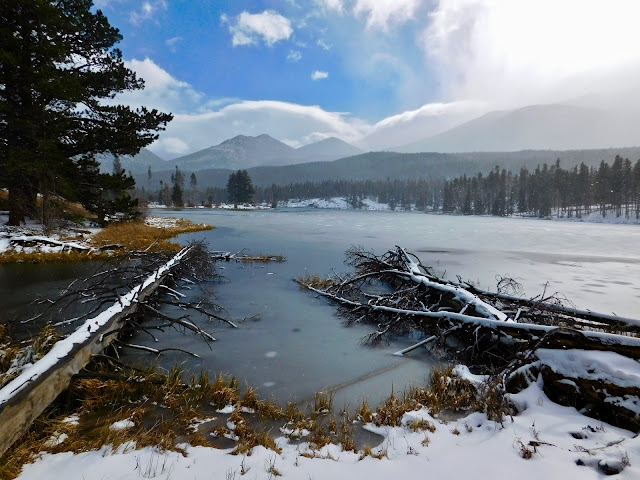 |
| Sprague Lake |
In 1874 Abner Sprague was the first person to homestead in Moraine Park, one of Colorado’s most scenic valleys. Further up in Glacier Basin he established a lodge that outfitted guests for hiking, hunting and fishing.
The resort sat on the banks of Boulder Brook and just downstream Abner dammed the creek, creating a lovely lake brimming with big trout. Today, all traces of human encroachment have been reclaimed but the reservoir, beaver and moose still remain.
This time of year Sprague Lake’s shiny green water is about half frozen and the fallen timber is partially submerged in cold slush. The hazy light is filtered by moisture produced by a high country snow squall.
Still set deep in an emerald forest below powder blue skies, the reservoir is surrounded by a crunchy, snow-packed trail trimmed with boardwalks and bridges. On this day a biting wind sprays pellets of ice against your face making the big mountain views virtually invisible.
Situated at an elevation of 8700 feet, the sub-alpine lake is confined to an unforgiving environment. By the calendar it may have just turned to winter but up here it’s been winter for a while and it will continue to be so for a long time to come.
 |
| A scenic valley |
 |
| A lovely lake |
 |
| The green water is frozen |
 |
| Fallen timber is submerged |
 |
| Hazy light |
 |
| Snow squall |
 |
| Powder blue skies |
 |
| An unforgiving environment |
 |
| A long winter |
DePoorter Lake - A Beautiful Landscape
 |
| DePoorter Lake |
During Wild West times, Julesburg was a dangerous place to live as it was a stomping ground for outlaws, gunslingers and Cheyenne Indians. Nearby Fort Sedgwick was an important military base protecting the Overland Trail and Colorado’s only Pony Express Home Station.
Today, the once notoriously rowdy town is known for it’s colorful history, clean living and peaceful atmosphere. One of the more tranquil locations is an icy jewel set between the city and the South Platte River.
DePoorter Lake is a lonely oasis concealed in Colorado’s forsaken, eastern plains. Dug out of the open prairie in 1988 when fill dirt was needed for a construction project, the picturesque pond was transformed into a fishery and stocked with sunfish, catfish, bluegill and rainbow trout.
The charming lake is bordered on the east by a coniferous windbreak that impedes the countryside’s brutal chinook. Fringing the cobalt reservoir, bare cottonwood trees are twisted into painfully distorted silhouettes.
Circumnavigating the clear water on a cold November morning is an exhilarating activity that rouses the soul. Broken light streams sporadically through drifting clouds inspiring thankfulness to be bound to such a beautiful landscape.
 |
| A tranquil location |
 |
| Set between the city and the South Platte |
 |
| A lonely oasis |
 |
| A picturesque pond |
 |
| A charming lake |
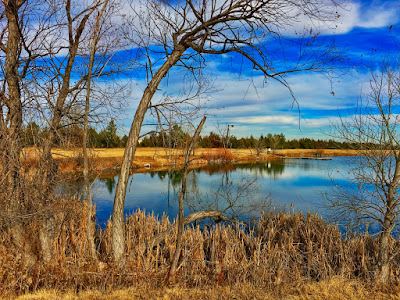 |
| The trees are painfully twisted |
Chapel on the Rock - An Indestructible Shrine
 |
| Chapel on the Rock |
"Upon this rock I'll build my church, and the gates of hell shall not prevail against it."
~ Matthew 16:18
On a pitch black night in 1916, Monsignor Joseph Bosetti was lured deep into the Rocky Mountains by the fiery afterglow of a falling star. Bosetti was unable to locate the meteor’s impact but he did find divine inspiration.
Bosetti stumbled upon a dramatic rock formation that filled his spirit with visions of grandeur. He became obsessed with building a remote church balanced right on top of those rugged crags.
Of course money or a lack thereof was an issue so without any funding, the construction project was delayed for twenty years. Bosetti’s dream came true after Mr. and Mrs. Oscar Malo donated land and architect Jacques Benedict finalized the design.
The chapel was built from native stone that was hauled in from the surrounding area by mule-drawn carts. This natural material allows the structure to blend perfectly into the environment, offering a seamless transition between earth and heaven.
Entrenched below the impressive Mount Meeker, the wilderness setting is absolutely breathtaking. As for the sanctuary, it’s detailed with elaborate stonework, adorned with statues and the windows are fitted with stained-glass.
The church was completed in 1936 and officially christened as the Saint Catherine of Siena Chapel. Other structures were added and by 1987 the meadow was transformed into the Saint Malo Religious Retreat and Conference Center.
Pope John Paul II hiked through the area, prayed in the chapel and blessed the site during World Youth Day. Since that remarkable visit in 1993, the hardened house of worship has been virtually indestructible.
In 1911, a devastating fire roared through the neighboring forest spewing flames that licked the church’s edge. The conference center was completely destroyed but miraculously, the stone structure survived unscathed.
Two years later, torrential rains produced devastating mudslides that flowed down from the high peaks into the valley just missing Saint Catherine’s by the slimmest of margins. Once again the sacred rock persevered in a pristine state.
Despite the wrath incurred by such natural catastrophes, the holy shrine has managed to hold its rocky ground. Still perched precariously today, the resilient Chapel on the Rock has become an obvious symbol of hope during the midst of disaster.
 |
| A remote church in the mountains |
 |
| Built from native stone |
 |
| It blends into the environment |
 |
| Impressive Mount Meeker |
 |
| The wilderness setting is breathtaking |
 |
| Elaborate stonework, statues and stained-glass |
 |
| A hardened house of worship |
 |
| A holy shrine |
 |
| Hope during the midst of disaster |
Animal Portraits - A Day at the Denver Zoo
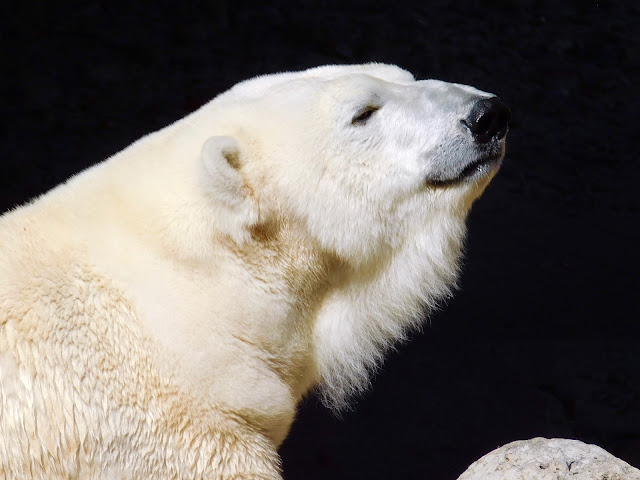 |
| Picturesque Polar Bear |
While taking animal pictures down in the city during the early fall, it was a delightful day at the Denver Zoo. In the cool weather and clear light the animals appeared active and contented, inspiring our creativity.
Sometimes it’s difficult to look at creatures confined to cages but during our five hour trek in the open air park, we were able to observe some exotic species that we’d never be able to see in the wild.
While strolling in such a controlled setting, it was the perfect place to practice shooting with a digital camera. Rather than just click, the challenge was to compose interesting portraits that captured the mood and personality of the engaging subjects.
Just like the spotted hyena, many of the creatures were content to bask lazily in the warm sunshine. A Dall sheep ram seemed happy while holding the high ground just above a cud-chewing, reticulated giraffe.
A banded mongoose was an innocent observer of the goings on around him while a northern white-cheeked gibbon proved his athleticism and appeared as curious about the crowds as they were of him.
As for the birds, the rainbow lorikeet was a riot of saturated color befitting his outrageous behavior. On the other end of the spectrum, the red-breasted Goose was shy and reticent but not less beautiful.
One of the more elegant waterfowl was the striking ruddy shelduck that spent most of its time out for a swim. The cinereous vulture was the lord of his domain and held his pose in a stately manner while the regal secretary bird strutted around like pure royalty.
My favorite shot was probably a picturesque polar bear who was basking peacefully along the edge of his turquoise pool. The only apparent dissenter was an armor-plated beast called black rhino as he seemed resigned to the fact of living life in captivity.
 |
| Spotted Hyena |
 |
| Dall Sheep |
 |
| Reticulated Giraffe |
 |
| Banded Mongoose |
 |
| Northern White-cheeked Gibbon |
 |
| Rainbow Lorikeet |
 |
| Red-breasted Goose |
 |
| Ruddy Shellduck |
 |
| Cinereous Vulture |
 |
| Secretary Bird |
 |
| Black Rhino |
Gore Range - The Shining Mountains
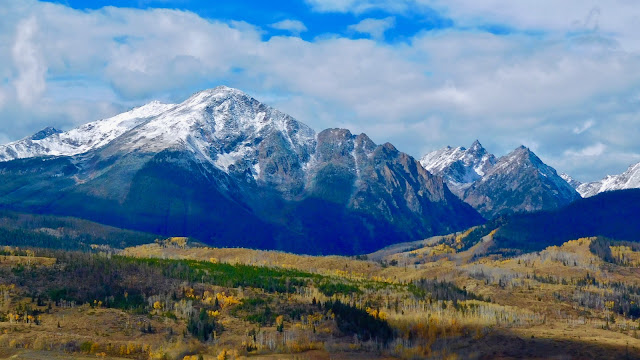 |
| Gore Mountain Range |
If one studies a map of central Colorado, you’ll discover an assortment of topographic features that share a common nomenclature. The different landmarks are called Gore Wilderness Area, Gore Creek, Gore Canyon, Gore Pass and the spectacular Gore Mountain Range.
I’ve always thought that was a cool title for a chain of craggy peaks because it evokes rugged imagery that makes me think of a shaggy buffalo bull or a pair of rutting elk. Losing yourself in those remote mountains has a therapeutic value that can restore your health but if you learn the true story behind the naming of that range - it will make you sick.
During the first half of the 19th century, the northern plains were an isolated region inhabited by Native Americans but encroached upon by a few white mountain men and fur traders. And then in 1854, in a tragic preview of things to come, a wealthy European began tramping across what is now Colorado, Wyoming, Montana and the Dakotas, wreaking absolute havoc on the fragile environment.
Sir St. George Gore was an Irish nobleman who sailed across the pond and barged into America for a three year hunting expedition. He traveled west with a special passport from the superintendent of Indian Affairs granting him permission, as a foreign dignitary, to visit Indian Country unimpeded.
With Jim Bridger hired as chief guide, Gore began his destructive odyssey into the wild followed by an entourage of 40 men, 32 greyhounds and 18 foxhounds. Riding roughshod over the unspoiled grassland, the outrageous caravan consisted of 27 wagons, 100 horses, 20 oxen and three milk cows.
St. George camped in a spacious green and white linen tent accessorized with an ornamental brass bed, a steel bathtub bearing the Gore coat-of-arms, a portable iron table and wash stand, a complete set of pewterware, a few stoves, a campaign chest and trunks filled with appropriate seasonal wardrobes and of course a fur-lined commode with removable chamber pot. This guy’s personal arsenal included 75 rifles, 12 shotguns, several revolver pistols and two wagon loads of fishing equipment.
On a typical day, Gore slept in until 11 in the morning then took a bath, ate breakfast and set out for the day’s hunt, returning after dark. He usually brought seven companions on his daily hunting foray but George was the only shooter. He never loaded his own gun because after firing he passed it on to an attendant who gave him another already loaded.
Gore shot at anything and everything that moved but not very well so because of his poor marksmanship, he wounded more animals than he actually killed. He often bragged about killing 2,000 buffalo, 1,600 antelope, deer and elk and 105 bears while leaving the carcasses to rot, infuriating the Indians who resented the senseless slaughter of animals on their land.
The plains tribes complained bitterly to the government about the white stranger who killed buffalo for sheer pleasure. When Gore’s wrath dipped into northern Colorado, the Yampas pleaded with him not to invade farther into their territory because of the toll his weapons had taken. St. George stubbornly ignored all complaints.
After three years of obliterating the local animal population, Gore decide to return home so he offered all of his expedition equipment for sale at a reasonable price. When a scrupulous trader tried to take advantage of his situation, Gore became upset and spitefully burned everything in a giant bonfire, keeping only a few wagon loads of buffalo robes, hides, pelts, antlers and trophy heads.
After Sir St. George departed, the natural landmarks at places he visited and some he never came near were for some bizarre reason named after him. Nobody seems to know for sure who, how or why these decisions were made but unfortunately, the names have permanently stuck.
In recent years as people have become more aware of Gore’s disgusting rampage, they believe anything that bears his name should be changed to something more appropriate. Understandably, a radical proposal such as that would require cutting through endless layers of red tape.
When the Ute Indians crossed over the Continental Divide and first laid eyes on the snowy peaks rising from the far side of the Blue River Valley, they called them the shining mountains. That certainly has a nice ring to it. Just imagine how great it would be if those places were renamed Shining Pass, Shining Canyon, Shining Lake, Shining Creek and the Shining Mountains.
 |
| Cool, craggy peaks |
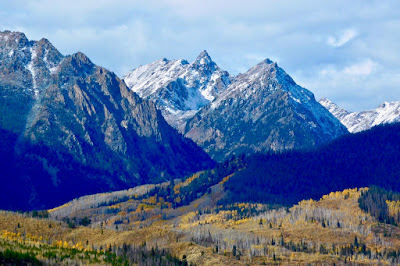 |
| Rugged imagery |
 |
| Lose yourself in remote mountains |
 |
| This was an isolated region |
 |
| A tragic preview |
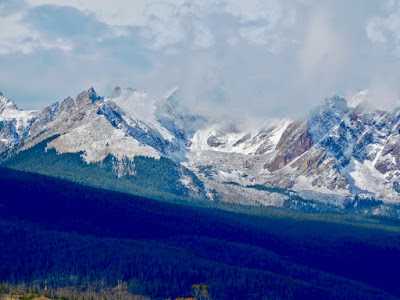 |
| Sir St. George wreaked absolute havoc |
 |
| A fragile environment |
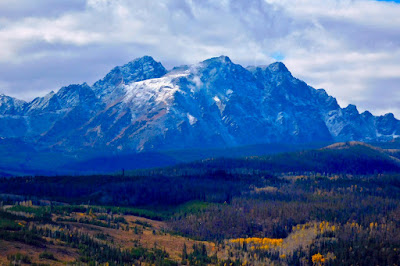 |
| Gore hunted for three years on the northern plains |
 |
| Some believe the name should be changed |
 |
| Snowy peaks |
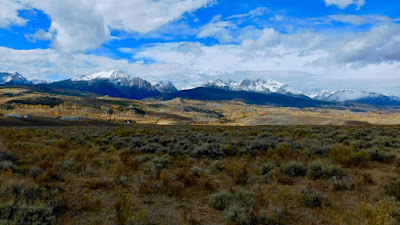 |
| The Shining Mountains |
Courthouse and Jail Rocks - Watercolor
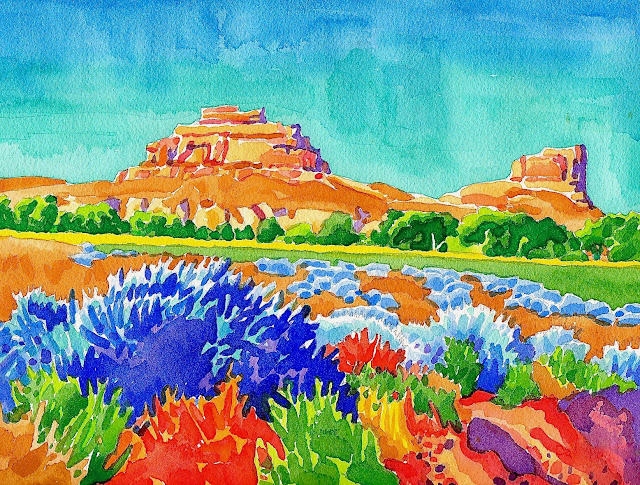 |
| Courthouse and Jail Rocks - Watercolor |
It's a breezy, spring day in Western Nebraska. Courthouse and Jail Rocks tower above the open prairie. A row of stately cottonwoods traces the winding course of Pumpkin Creek while a field of fresh hay slices through rugged pastureland. The fiery foreground is accented by glittering, silver sagebrush.
The cloudless sky is a deep blue as the unusual formation appears golden in the evening light and dark shadows define the bold geography. The steep south face is terraced like a Sumerian ziggurat and descends into a labyrinth of mysterious corridors, caves, tunnels and rattlesnake pits.
Composed of Brule clay, Gering sandstone and ash, the rocks are erosional remnants of an ancient plateau formed by volcanic activity thousands of years ago. Later, they became an unforgettable natural landmark that guided emigrants during the 19th century's Westward Expansion.
Back then, just passing near the monument offered hope to weary pioneers struggling to find a better life in this strange, new land. Even today, the mere sight of the eternal peaks provides inspiration to those determined to overcome life's ever-changing obstacles.
Elk Ridge Twilight - Colored Pencil Drawing
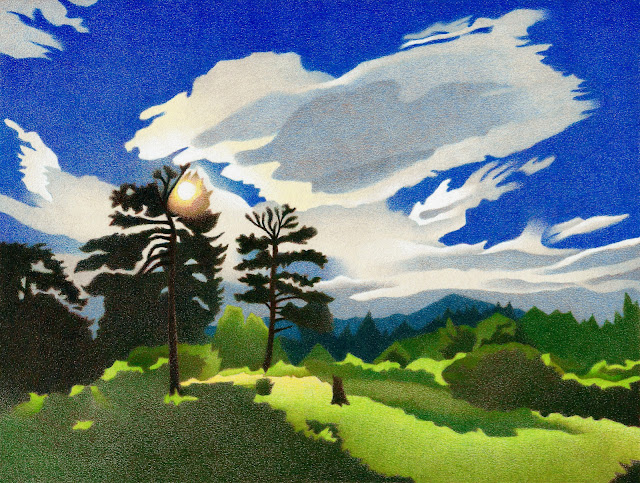 |
| "Elk Ridge Twilight" Colored Pencil |
It’s early summer in Evergreen and a collection of evening clouds drifts quietly over a broad ridge. The steep-sloping meadow, renowned for its high concentration of Rocky Mountain elk, is a haven for all wildlife.
The field of lush grasses undulates towards a forest silhouette and the blue mountains beyond. The shadowy hillside is splintered with streaks of pure color that flood the foreground and fleck highlights onto the dark brush.
This drawing is mostly about the setting sun’s fading light as it explodes through a temporary breach in the cloud-covered sky. The rays spread across the landscape resulting in an arresting impression that seems surreal.
Described by fleeting effects, the tranquil setting instills the admirer with awe. It’s an artist’s statement exclaiming there’s nothing more spectacular in the state of Colorado than twilight on Elk Ridge.
Mount Vernon Towne - Gateway to the Rockies
 |
| Mount Vernon townsite |
Just south of where Interstate 70 curves west and begins its climb up into the Rockies, Matthews/Winters Park preserves a splendid plateau and a fascinating past. It’s a unique location because it’s the exact point where the high plains meets the mountains.
The place was first settled in 1859 by an entrepreneurial clergyman named Joseph Casto who hoped to make a profit from the burgeoning gold rush. Second to arrive was a lawyer from Nebraska named Robert Williamson Steele who called the area Mount Vernon after George Washington’s estate in Virginia.
Casto platted the hillside and encouraged development of the small village that became known as Mount Vernon Towne. Casto also started the Denver, Auraria, and Colorado Wagon Road Company, which built a toll road from Denver through Mount Vernon and up the canyon to the gold fields at what is now Central City and Blackhawk.
Almost overnight Mount Vernon was transformed into a thriving transportation hub as the fledgling community swelled to over 200 souls. In 1859 the region was considered Kansas’ western frontier where there was a lack of government and lawlessness reigned.
Frustrated citizens decided to take matters into their own hands and voted Robert W. Steele as governor of a new district named Jefferson Territory after our third president, Thomas Jefferson. As the territorial capital with an endless stream of wagons passing through on their way to the mining camps, Mount Vernon enjoyed immense prosperity.
Unfortunately, the town’s string of good luck only lasted for about two years and after that it suffered from a gradual decline. In 1861, Steele was forced to give up his post because Congress created Colorado Territory and Abraham Lincoln installed William Gilpin as its first governor.
After Steele’s house burned down, he moved a few miles north to Apex and invested in another toll road that ascended Apex Gulch. Travelers also discovered a couple of gentler, alternate routes through the foothills via Platte Canyon or Clear Creek Canyon so in 1864, Casto bolted before things bottomed out.
Once the stage traffic ceased, Mount Vernon’s status as a political and transportation center was dissolved. While Mount Vernon experienced hardship, nearby cities like Golden and Denver rose to prominence, turning the lovely hamlet into a virtual ghost town.
Interestingly, in the twentieth century Mount Vernon Canyon re-emerged as an important traffic artery. In 1937, U.S. Highway 40 was routed along the north side of the gorge and during the 1960s, I-70 was built right over the top of the old toll road.
Because of the extinct township’s historical significance, it was saved from the destruction of modern development. Thanks to the Matthews family, Winters family and Jeffco Open Space, the area has been preserved and has become a paradise for hiking, running and mountain biking.
If you visit the site today the only thing left standing is a few grave markers set in one of Colorado’s oldest cemeteries. When you’re there it feels like a fitting tribute to the tiny boomtown that once billed itself as “The Gateway to the Rockies”.
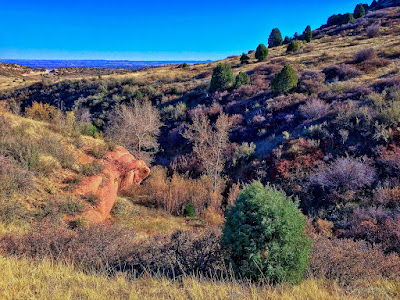 |
| A splendid plateau |
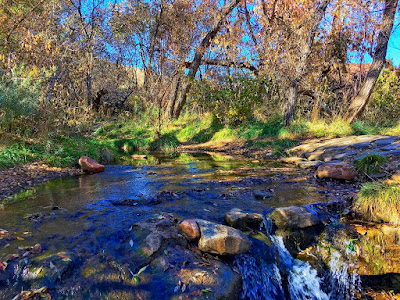 |
| A unique location |
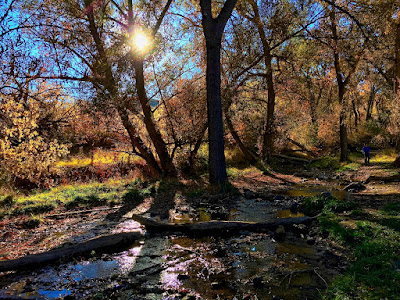 |
| The territorial capital |
 |
| Mount Vernon enjoyed immense prosperity |
 |
| Historical significance |
 |
| A paradise for hikers |
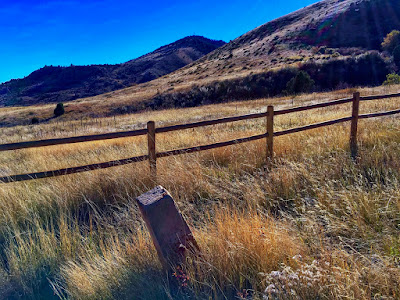 |
| One of the oldest cemeteries in Colorado |
Clearing Storm - Fleeting Utopia
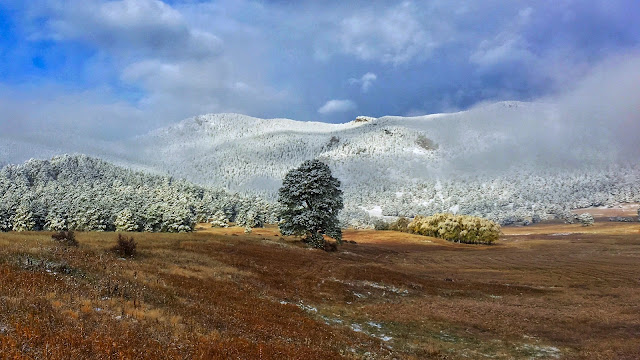 |
| A fleeting utopia |
The morning after our first snow and the clearing storm revealed an absolutely pristine landscape. Glittering in the soft light, a pair of ponderosa pine were glazed with fresh, white powder, creating a pointillistic effect.
The gathering of dense clouds dispersed, unveiling a cold mountain that was frosted from field to summit. Gradually the white peak came into focus, crowning the autumn landscape with a staggering beauty that can only be witnessed this time of year.
Sprawling below a new-blue sky, snow-spackled trees were scattered across an orange grassland. The slow-moving system had finally dispersed leaving the colorful landscape in a state of fleeting utopia.
 |
| A pristine landscape |
 |
| A pair of ponderosa pine |
 |
| Unveiling a cold mountain |
 |
| A staggering beauty |
 |
| Snow-spackled trees |
 |
| A colorful landscape |
Snowstorm at the Lake - A Scintillating Prelude
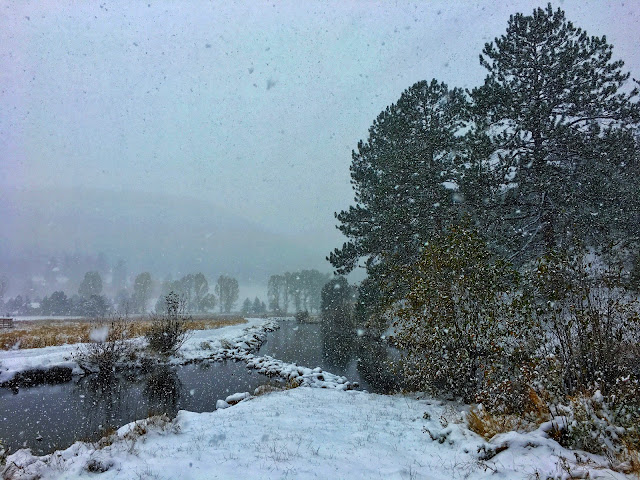 |
| Snowstorm at the lake |
It was an awesome autumn morning last Sunday as the storm packed a final punch and piled six inches of snow at Evergreen Lake. Giant flakes rained down from the firmament erasing the normally distinctive mountain backdrop.
Too early for winter’s unyielding chill, the water was still fluid and leaves still firmly attached. The ochre marshland wilted under pressure from heavy accumulation, sending songbirds to seek shelter beneath the boardwalk.
Despite gray weather, the dark reservoir was painted with rigid reflections that decorated the smooth surface. After such a scintillating prelude to the somber season, the slow moving storm suddenly cleared leaving behind a pristine landscape.
 |
| Awesome autumn morning |
 |
| Giant flakes rained down |
 |
| Leaves were firmly attached |
 |
| An ochre marshland |
 |
| A dark reservoir |
 |
| A pristine landscape |
First Snow - A Soft-Spoken Storm
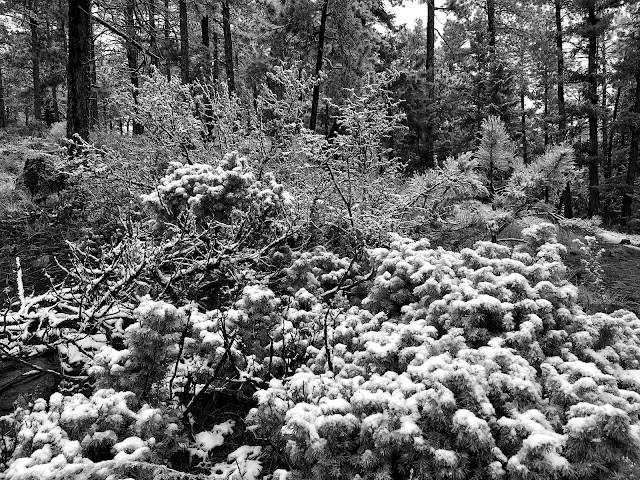 |
| First Snow |
On an early October morn, the first snow in the golden foothills could only be described in a soft monochrome. Rooted into a rocky hillside, an elegant forest of lodgepole pine was distinguished by a silvery tone.
The soft-spoken storm snuck onto the scene and enveloped our area with dreary weather for quite some time. At the beginning, most of the moisture mixed with warm air and soaked into the parched ground.
After dark when the temperatures went down, a couple of inches of wet snow accumulated on the grass, bushes and branches. By the next day, the meadow was glistening with termination dust in a picture reminiscent of winter.
 |
| A soft monochrome |
 |
| An elegant forest |
 |
| Dreary weather |
 |
| The parched ground was soaked |
 |
| Snow on the grass and bushes |
 |
| Reminiscent of winter |
Elk Meadow - A Tranquil Autumn Evening
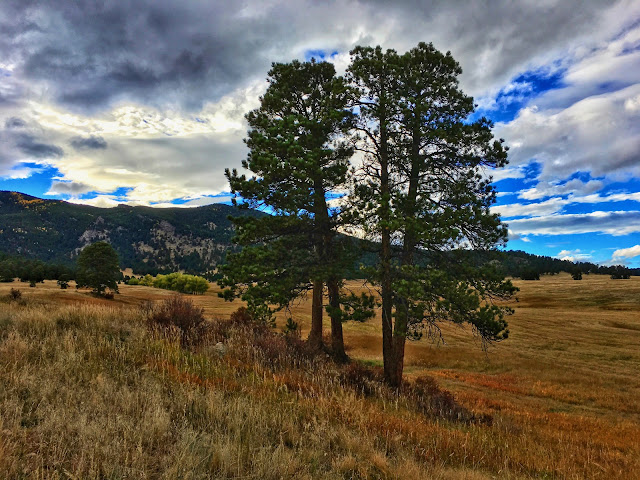 |
| A cluster of backlit pine |
On a tranquil autumn evening, the entry into Elk Meadow is ablaze with a carpet of fiery grasses. A cluster of backlit pine clings to a rocky hillside while broken clouds stream across the powder blue.
Sprawling below the surreal sky, an orange countryside rises steadily to the fringe of a dark behemoth named Bergen Peak. Further up the rocky trail and a patch of aspen makes its last stand before winter as its leaves are just now starting to turn.
From the shallow recess of a secluded hollow, a solitary pine extends its tangled branches in a wooded embrace. On the brink of a broad ridge there’s a lofty overlook where you can watch the last of the day’s light disappear and our colorful season come to an end.
 |
| Ablaze with fiery grasses |
 |
| Bergen Peak is a dark behemoth |
 |
| Patch of turning aspen |
 |
| A secluded hollow |
 |
| The evening's last light disappears |
Beaver Brook Loop - A Heart-pounding Misadventure
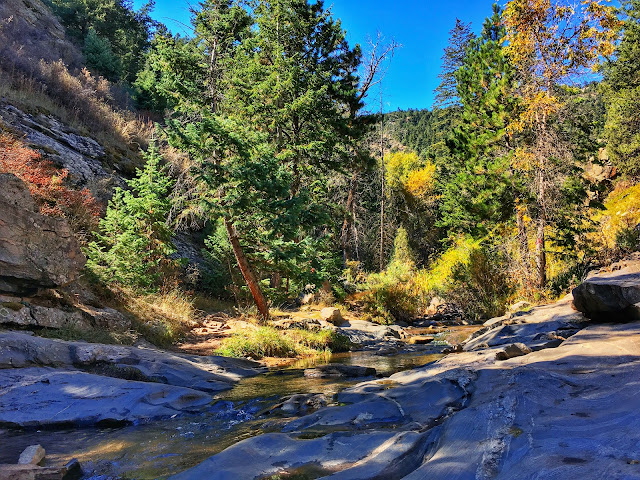 |
| Beaver Brook |
On a steamy autumn day, the casual descent into a deep gorge was suddenly transformed into a lesson about underestimation. It began along a pine studded rim, towering above the mysterious depths of a jagged ravine.
Carved by a fast-flowing creek called Beaver Brook, the narrow gulch was a fantastical place where sea serpents swam. The farthest reaches of this Front Range wilderness felt just as remote, rugged and awe-inspiring as any piece of land in Colorado.
Down at the extreme bottom, a series of twenty footbridges criss-crossed the blue stream while transporting the hemmed in hiker through a picturesque portal. Down there the problems began because the thrilling scenery and ease of passage were short-lived.
The steep escape from such a fiery dungeon was a heart-pounding misadventure that was as brutal as climbing any fourteener. The way out was littered with thin ledges, vast drop offs and rock-cut stairwells.
A more thoughtful approach was required in order to preserve precious oxygen while attaining such dizzying height. The endless struggle became a strategic combination of rest and roll while reeling in the mountaintop, step by step.
A final charge through the last leg of the arduous trek finally achieved admittance into a receptive forest. With the danger zone left in the dust, a shaft of filtered light, shining through a grove of aspen, guided the weary traveler to the glorious finish line.
 |
| A steamy, autumn day |
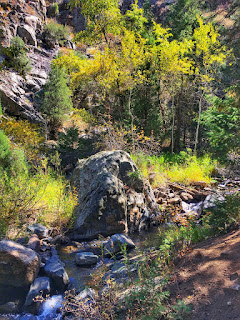 |
| A deep gorge |
 |
| A jagged ravine |
 |
| A fast-flowing creek |
 |
| A fantastical place |
 |
| Where sea serpents swam |
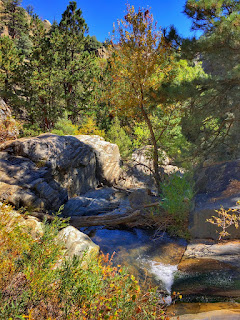 |
| Remote and rugged |
 |
| Footbridge crosses the stream |
 |
| A picturesque portal |
 |
| Thrilling scenery |
 |
| A steep escape |
 |
| A glorious finish line |
Cedar Waxwing - A Silky Bandit
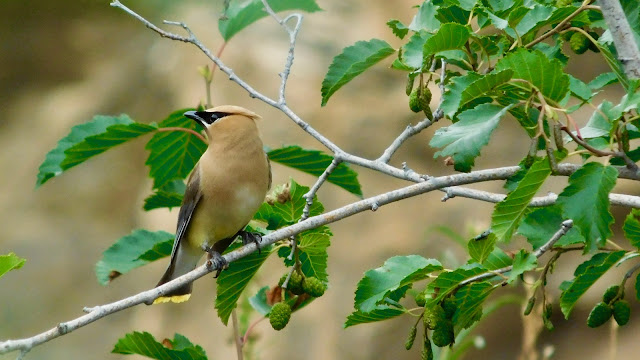 |
| Cedar Waxwing |
We are in the middle of fall so most of the local birds have left for the season but some interesting species that we don’t normally see are currently passing through on their way south. Last week we watched as a flock of silky bandits raided fruit from the bushes that surround Evergreen Lake.
The Cedar Waxwing is a beautiful bird painted with a shiny palette of brown, gray and lemon-yellow. It’s most striking characteristics are the regal crown, yellow-tipped tail, a devious black mask outlined in white and the brilliant-red wax droplets accenting the wing feathers.
The happy, little gang of marauders gorged themselves on berries and other sugary fruit to the point of intoxication. A few of the birds ventured out over the water in order to capture tasty insects while still on the wing.
They flitted about from branch to branch while calling to each other with a thin whistle and they took great delight in splashing around the shallow creek. Unfortunately, the late travelers didn’t stay for long as the weather is starting to turn.
I’m sad to see all of our colorful, summer visitors pack up and leave but I’m happy to have the quiet, rocky trails back to myself. It won’t be long now and this place will become a deserted sanctuary for the snow.
 |
| A silky bandit |
 |
| A beautiful bird |
 |
| Colored with a shiny palette |
 |
| Yellow-tipped tail |
 |
| A black mask |
 |
| They eat fruit and berries |
 |
| They flitted from branch to branch |
 |
| They didn't stay for long |
Spotted Towhee - A Hefty Sparrow
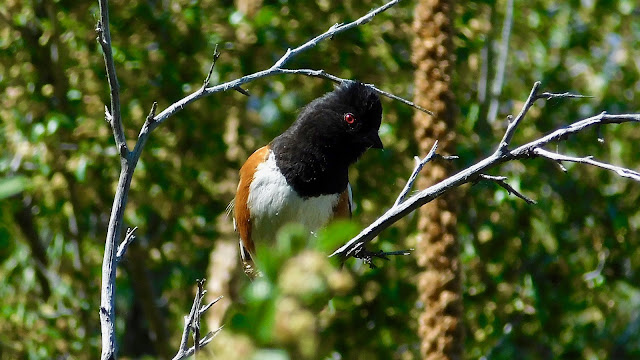 |
| Spotted Towhee |
Rustling through the leaf litter below the dry scrub brush that laces the steep, Colorado foothills is where you’ll find a hefty sparrow known as the spotted towhee. Such beautiful birds, the males have a white belly, orange sides and a black head, throat and upper parts. The back and wings are flecked with white spots while the red eyes are the defining characteristic.
During the early spring, those males creep up to the top of the thicket and sing all day long while trying to attract a mate. In the breeding season they eat mostly insects but they’ll also dine on acorns, berries and seeds. They’re nest cup is built deep inside a sharp briar and usually concealed somewhere near the base of the shrub.
A close cousin, the eastern towhee, used to be considered the same bird as the spotted towhee and in the past they were called the rufous-sided towhee. During the last ice age large ice sheets split the continent down the middle, isolating the separate birds into eastern and western populations. Today, scientists classify the spotted and the eastern as two completely different species.
 |
| Rustling through leaf litter |
 |
| Dry scrub brush |
 |
| A hefty sparrow |
 |
| A beautiful bird |
 |
| Orange sides, black head and white spots |
 |
| The red eye is a defining characteristic |
 |
| Singing all day |
 |
| A different species |
Golden Foothills - The First Hint of Fall
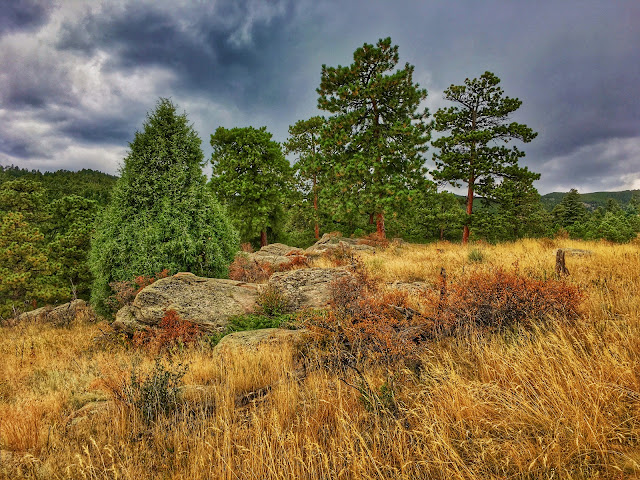 |
| Golden Foothills |
Framed by wildflowers, a big, violet boulder marks the beginning of the way up into golden foothills. Around the bend, a slope of mixed vegetation leads to a broken ridge and the blue storm clouds beyond.
The first hint of fall is a surreal splattering of yellow leaves below a pine bough of arched and broken branches. In the low light, a grove of turning aspen seems to glow when set against the coniferous forest.
Their white trunks undulate like wispy ghosts disappearing into the darkness. Under threatening clouds, some must stand alone engulfed by a sea of black trees while we get drenched by a deluge of freezing rain.
 |
| A boulder marks the beginning |
 |
| Slope of mixed vegetation |
 |
| A surreal splattering |
 |
| Glowing aspen grove |
 |
| Wispy ghosts |
 |
| Some must stand alone |
Berthoud Pass - A Mountain Landscape
 |
| Berthoud Pass |
While wandering below Berthoud Pass on a warm summer evening, the wilderness scenery was a sight to behold. It was Classic Colorado as a blue creek, born in the big peaks beyond, came crashing down through a thicket of tangled willows.
A giant, yellow pine captured my attention and led my eyes back up to the snowy mountains whereupon the ribbon of cold water carried my gaze back down. This complex arrangement occurred in a narrow valley enclosed by a forest of dark pine, forming a visual barrier that precluded retreat.
That carefully observed composition has become the centerpiece for a new colored pencil workshop I’ll begin teaching this fall. The two day, ten hour clinic will start with warmup exercises, progress to a simple step-by-step and then finish with the main demonstration - drawing the mountain landscape above.
My friend and fellow artist, Ann Kullberg, is internationally know for her exceptional portrait workshops. Her class has become so popular that she can’t keep up with the demand so she has invited thirteen of us to help in her crusade extolling the virtues of colored pencil.
I’ve been working closely with Ann in order to develop a certified curriculum that features my own style and subject matter. Now, after months of intensive construction, she has unveiled her Soar Workshop Network where she’ll be sending us out across the US and Canada presenting our unique techniques to anyone who wants to attend a class.
My first scheduled workshop is not until February at Keizer, Oregon but I believe a couple more may happen before then once the details are worked out. In the meantime, I’m toiling feverishly to finish an illustrated, step-by-step booklet that will be included in a packet that’s handed out to all students who take the class.
I’ve been working with colored pencils for 40 years so I’m hoping it will be a gratifying experience to share my knowledge and philosophy with other artists who wish to learn more about this wonderful medium. In my class, we will simplify the scene, learn how to build layers of color and do some basic shading.
If you’d like to know more about the Soar Workshop Network, please click here: Soar
If you’d like to host a Soar Workshop in your hometown, please fill out this short application form: Soar Application
 |
| Warmup Exercises |
 |
| Line drawing for the main demo |
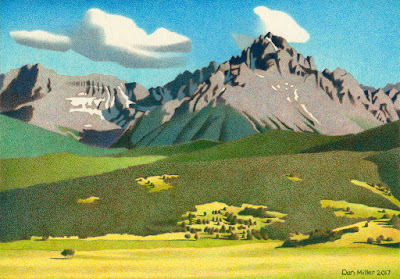 |
| My own style and subject matter |
 |
| Keizer, Oregon |
Birding at Evergreen Lake - A Kingdom in the Cattails
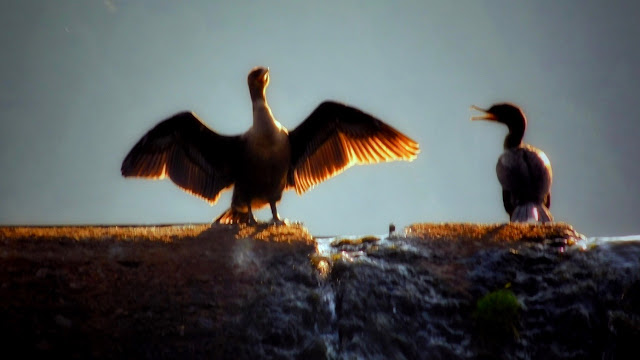 |
| Birding at Evergreen Lake |
Spread out below Mount Evans, the Front Range foothills are an exquisite parcel in Colorado. There are dark forests, clear creeks, deep canyons and wide open meadows that support a diverse variety of wildlife but if it’s birds you’re looking for, Evergreen Lake is the place to be.
Formed when Bear Creek was dammed, the lake is a birder’s heaven centered around a riparian ecosystem that hosts a vast array of feathered friends. Red-winged blackbirds appears to rule the roost from their kingdom in the cattails while barn swallows are masters of flight that own the airspace just above the water’s surface.
Of course you’ll see some of the stereotypical waterfowl like Canada geese, crows, mallard ducks and prehistoric cormorants. There are also some more exotic species so on any given day you might see a great blue heron, a rufous hummingbird or a gang of masked bandits called cedar waxwings.
At the pond, we’ve also seen a hooded merganser, American dipper and dazzling goldfinches. I’ve never been able to get a pic of some of the majestic visitors like an osprey, bald eagle or belted kingfisher but I do take the time to observe one of the wetlands most unassuming creatures - the common muskrat.
 |
| Red-winged Blackbird |
 |
| Barn Swallow |
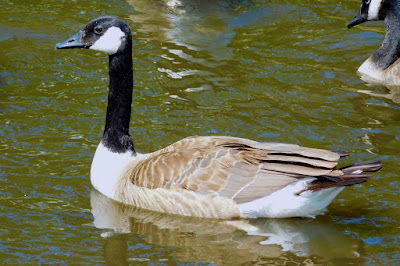 |
| Canada Goose |
 |
| American Crow |
 |
| Mallard Duck |
 |
| Double-crested Cormorant |
 |
| Great Blue Heron |
 |
| Rufous Humminbird |
 |
| Cedar Waxwing |
 |
| Hooded Merganser |
 |
| Common Muskrat |
The Cedar River - A Blue Deluge
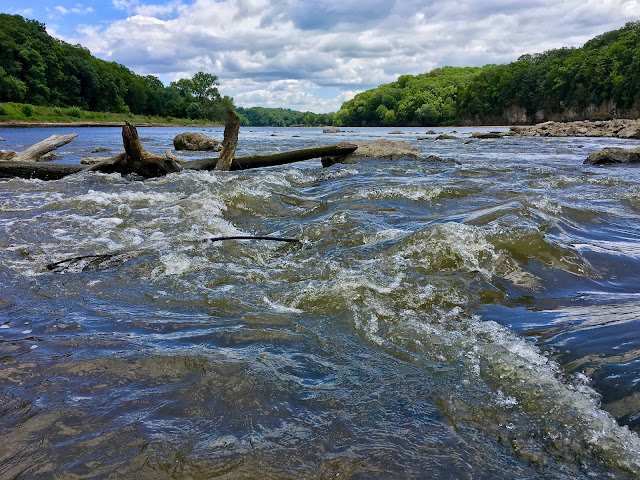 |
| A blue deluge |
Flowing down from the wilds of Minnesota, the Cedar River winds its way through central Iowa and joins the Iowa River just before emptying into the mighty Mississip. The voluminous waterway streams through the heartland at a fairly fast clip as the swift current is not something you want to underestimate.
The adjacent, fertile valley is distinguished by dark-forested hills and vast fields of corn. Back in the old days they called it the Red Cedar River because of the abundance of those junipers that thrive on the limestone cliffs overlooking the blue deluge.
One evening while we were up in Waverly, we walked along the Cedar and were astonished by the diverse variety of colorful wildflowers that decorated the pathway. At Mount Vernon, a steep stairwell escorted the explorers down to the water’s edge where the Cedar’s true power was revealed.
The American Midwest is a fascinating region to visit, characterized by high humidity, verdant hues and afternoons embroiled in severe thunderstorms. It was a peaceful change of pace that I’ll never forget with memories of down-to-earth people, vibrant arts and a beautiful landscape but still, it’s good to be home.
 |
| A voluminous waterway |
 |
| Streaming through the heartland |
 |
| Colorful wildflowers |
 |
| Decorating the pathway |
 |
| A steep stairwell |
 |
| A fascinating region |
 |
| Verdant hues |
Alderfer Park - A Steamy Wilderness
 |
| Alderfer Park |
On a warm morning at Alderfer Park, a wave of clouds streaks across the sky, painting the landscape with blue shadows. The shallow ravine is running dry so yellow grasses have taken over the high ground.
The golden meadow is absolutely bursting with a profusion of pink and purple perennials. As I continue to wander, a grove of aspen offers some cool relief while that field of wildflowers thrives in the mid-summer sun.
Now in the forest, the light becomes dappled as it barely shines through a fresh canopy of transparent leaves. Even during an afternoon thundershower, descent from the steamy wilderness is a sweaty withdrawal.
 |
| A wave of clouds |
 |
| The ravine is running dry |
 |
| Golden Meadow |
 |
| Field of wildflowers |
 |
| Dappled light |
 |
| A steamy wilderness |
Mount Vernon, Iowa - America's Coolest Small Town
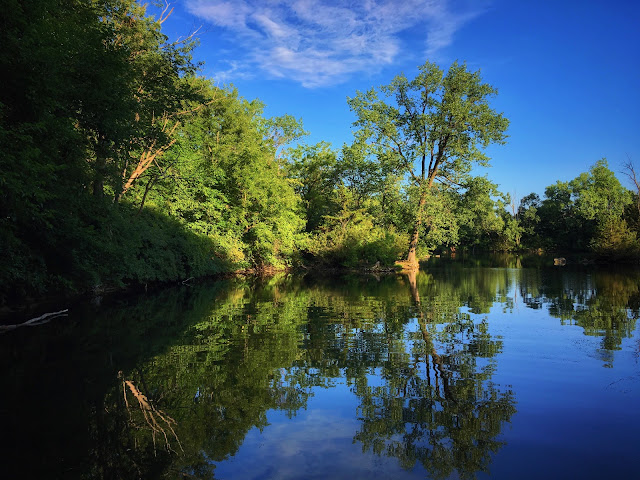 |
| A midwestern oasis |
Upon arriving at Mount Vernon, Iowa, numerous banners proclaim it as being America’s Coolest Small Town and after spending a few days there, I’m inclined to believe it. Artist Grant Wood immortalized the region through his landscape paintings and American Gothic, his most famous work, has been reproduced on a barn just outside of town.
One of my favorite places is a small nature park that is just bursting with wildflowers and outstretched trees that are a shady refuge from the sweltering heat. The most striking element is the profusion of sunlit tiger lillies that contrast so sharply with the dark-green forest.
Along the edge of Mount Vernon, the Cedar River sloughs patiently through ripe cornfields and the billowy, green hills. Despite its peaceful personality, the Cedar has a swift current so beware as it could definitely sweep an unsuspecting swimmer a long ways downstream.
The centerpiece of this midwestern oasis is a small pond where the reflections are so sharp that the placid pool seems like a mirror. As the day comes to an end, a window of lime green leaves is struck by late light while framing a simple composition of blue water and black trees.
 |
| America's Coolest Small Town |
 |
| American Gothic Barn |
 |
| Bursting with wildflowers |
 |
| Sunlit tiger lillies |
 |
| The Cedar River |
 |
| Lime green leaves |
Cedar Bend Park - A Midwestern Swampland
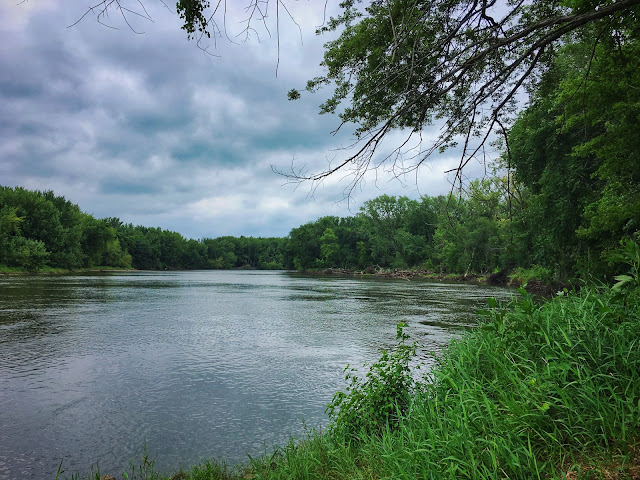 |
| Cedar River Bend |
Just outside of Waverly, Iowa, a muddy trail descends into a dark passageway that whisks you to a bend in the Cedar River. A winding, wooden boardwalk emerges from the dense cover and expels the foreigner onto a sand dune beach.
The wide waterway snakes it’s way through the midwestern swampland while moving at a fairly fast clip. Connecting separate segments of the jungle trek, lofty bridges are built into the steep, broken hillside.
The damp woodland is overgrown with plants and teeming with reptiles and bird life but the occasional snag is spot-lit by the filtered light. The finish line is decorated with a bouquet of blue wildflowers that so eloquently bid the visitor a fond farewell.
 |
| A dark passageway |
 |
| A wooden boardwalk |
 |
| A wide waterway |
 |
| Lofty bridges |
 |
| A dead tree snag |
 |
| A bouquet of wildflowers |
Beaver Brook Reservoir - A Dark Inkwell
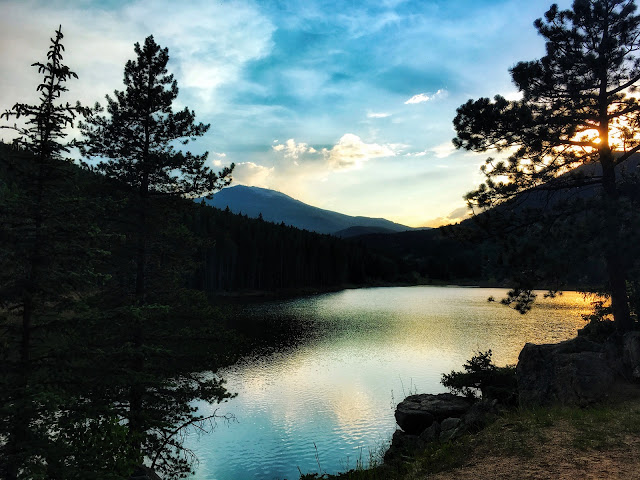 |
| Beaver Brook Reservoir |
Along the trail to Beaver Brook and a grove of aspen is awash in golden ambiance while wavering in a warm, summer breeze. The sun is just beginning to set so the pine trees are backlit, making for a strange silhouette.
Glowing mountains brood over the water’s edge where tall grasses flicker in the fading light. Around the bend it’s blue hour and a rocky, forest outcrop is dipped precariously into the dark inkwell.
The Beaver Brook Watershed is a rugged ravine that has carved its niche into this remote wilderness. At the eastern edge during an unceremonious exit, the evening’s last light floods a soggy bog of orange woodland.
 |
| Awash in golden ambiance |
 |
| Pine trees are backlit |
 |
| Tall grasses flicker |
 |
| A forest outcrop |
 |
| Rugged ravine |
 |
| Orange woodland |
Courthouse and Jail Rocks - Offering Inspiration
 |
| Courthouse and Jail Rocks |
“We came in sight early this morning of the "Courthouse," a hill, or immense mound, which strongly resembles such a building, with wings; it rests imposingly on a bluff; the sides are near a cream color, with apparently, a black roof.” ~ Phillip St. George Cooke (1845)
Composed of Brule clay, Gering sandstone and ash, Courthouse and Jail Rocks are erosional remnants of an ancient plateau. They were formed by intense volcanic activity that happened thousands of years ago.
The Rocks are located just south of Bridgeport, in the Nebraska panhandle, at the eastern terminus of the Wildcat Hills. The impressive landmark ascends 400 feet above the nearby North Platte River Valley.
They’re an enduring symbol of the pioneer spirit, hope and home. During Westward Expansion, they were a famous benchmark as the Pony Express, Oregon, California and Mormon trails all passed by the geographic marvels.
The formation was first noted by Robert Stuart, in 1812, who from a far distance observed a solitary tower rising out of the open prairie. Only upon closer inspection did he discover that there were actually two.
Stuart thought the larger feature looked like a courthouse, while the smaller a jail. Locals originally began calling the place McFarlan's Castle while passerbys referred to them as the Lonely Tower, the Castle or the Capitol but by 1837, the name Courthouse and Jail Rocks had stuck.
During the 19th century, settlers on the trail relied on natural markers to guide them in the right direction. To emigrants from the European coast who had never seen a mountain or even a bluff, Courthouse and Jail Rocks were described as stunning, geologic features.
Being the first of several impressive monuments in western Nebraska, Courthouse and Jail are a proud palace of solitude. They’re a vanguard of unforgettable scenic wonders that travelers would encounter further west.
Fascinated by the strange peaks and because they knew they would never see them again, many people climbed to the summit and carved their names in the soft clay. Some of those signatures can still be seen today.
The Rocks provided confidence that the party was on the right track and encouraged optimism that everything was going to be okay. When feeling a bit under the weather, a powerful tonic can sometimes be a sliver of hope.
Back then, just passing near the monument gave comfort to weary pioneers struggling to find a better life in this strange, new land. Even today, the mere sight of the eternal peaks offers inspiration to those determined to overcome life's difficult obstacles.
 |
| The rocks are erosional remnants |
 |
| An impressive landmark |
 |
| Courthouse Rock |
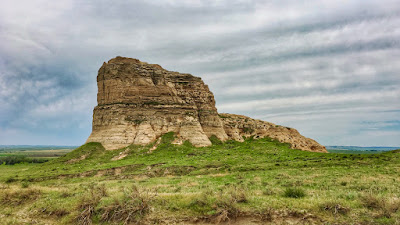 |
| And Jail |
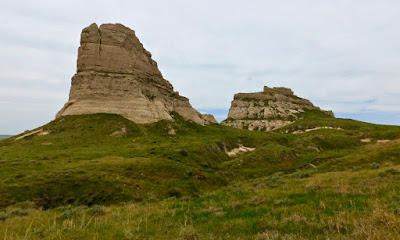 |
| A stunning geologic feature |
 |
| The peaks offer inspiration |
Elk Ridge - A Stormy Afternoon
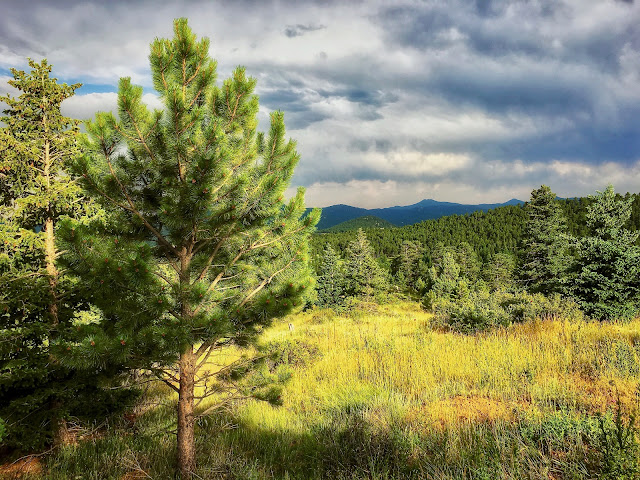 |
| A stormy afternoon on Elk Ridge |
It’s another stormy afternoon as Bergen Peak looms over a lush meadow of tall grass. A fantastically-shaped, red pine is a picturesque sentry marking the beginning of a grueling uphill climb.
Halfway there and a patch of rugged vegetation sways wildly in the midst of a midsummer squall. Up at the top of the ridge, a setting sun strains to spread it’s last rays through a murky atmosphere.
During the trek back down, a spiraling spruce writhes towards the sky like a van Gogh painting come to life. Upon return to the bottom lands as the storm drifts away, a last bit of golden light sweeps triumphantly across the grateful land.
 |
| Bergen Peak looms over a lush meadow |
 |
| A picturesque sentry |
 |
| A patch of rugged vegetation |
 |
| A murky atmosphere |
 |
| Like a van Gogh painting |
 |
| Golden light sweeps across the land |
Urad Lake - A Successful Reclaimation
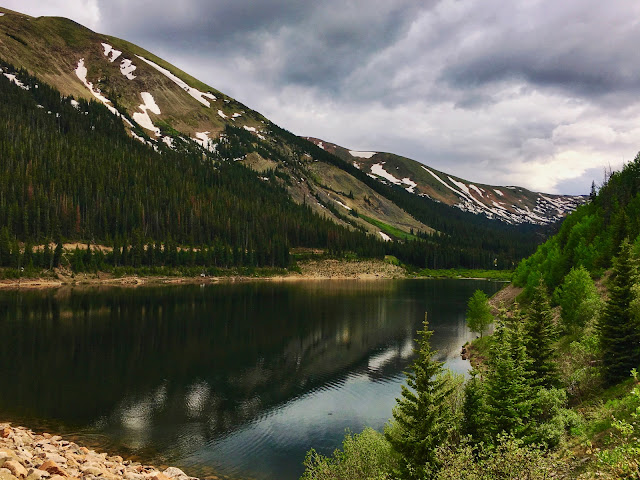 |
| Urad Lake, Colorado |
With help from the Henderson Mine and some concerned humans, nature has successfully reclaimed the Woods Creek Valley. The centerpiece of this spectacular area is a slender reservoir called Urad Lake.
This new State Wildlife Area is teeming with, well, wildlife. Deer, elk, moose, black bear, red fox, pikas and golden-mantled ground squirrels have all been seen frequenting this high altitude habitat.
At almost 11,000 feet, it’s one of the only places in the world that offers a suitable territory for the critically endangered boreal toad. They eat insects and depend on shallow ponds with warm water in which to breed and underground dens in which to hibernate.
At the far west end, a few streams come rushing in, bringing even more fish into an already well-stocked pond. A fisherman’s paradise, the lake is chock full of small brook trout, pretty rainbows and plenty of cutbows.
As for the lake, it’s pinched into a steep, forested gorge where the water is deep, dark and freezing cold. A rugged trail traces it’s contour allowing one to fully inspect the indigo blue lagoon.
Reaching this subalpine environment requires negotiating a dangerous four-wheel-drive-only road. Off of the radar for most travelers heading to the mountains, Urad Lake is truly a peaceful sanctuary hidden within a realm of high peaks.
 |
| Woods Creek Valley has been reclaimed |
 |
| The centerpiece |
 |
| A slender reservoir |
 |
| A high altitude habitat |
 |
| The west end |
 |
| Streams come rushing in |
 |
| A fisherman's paradise |
 |
| A forested gorge |
 |
| An indigo blue lagoon |
 |
| A subalpine environment |
 |
| A peaceful sanctuary |
Loveland Pass Lakes - Colored Pencil Drawing
 |
| "Loveland Pass Lakes" Colored Pencil |
"Nothing is less real than realism. Details are confusing. It is only by selection, by elimination, by emphasis, that we get at the real meaning of things." ~ Georgia O'Keeffe
Situated above timberline, a pair of high mountain tarns are pure blue under a late-summer sun. Known as Loveland Pass Lakes, the shimmering jewels are set just below the Continental Divide.
Looming majestically in the background, a ring of rugged peaks encloses the isolated valley. Dark patches of far away forest cling to the steep mountainside and fade away as they reach ever higher.
The rolling hills of rough terrain around the reservoirs are covered with rows of pine that follow closely the contour of the land. The water is calm, clear and cold with the larger lake reflecting trees in its upper left corner.
Sweeping across the foreground, tundra grasses are ablaze in fiery colors. Conveying the sure sign that seasons are changing, an assortment of flushed vermillion hues are dragged across the textured surface.
Anchoring the right side of the page is a giant, gray rock that’s shaded with strong contrast. Balancing the composition on the other side is a thicket of brush and willows that come streaming in at an angle.
This drawing is not a rigidly faithful representation of the actual scene. It’s more an experiment that blends abstraction with realism, producing a work that emphasizes the primary forms of the mountain landscape.
Nonessential details have been removed in order to focus on the most important elements. The intense observation of nature results in a sensitivity to her dramatic scale and subtle nuances, culminating in a more real portrayal of this Colorado landscape.
Red-sided Garter Snake - A Docile Nature
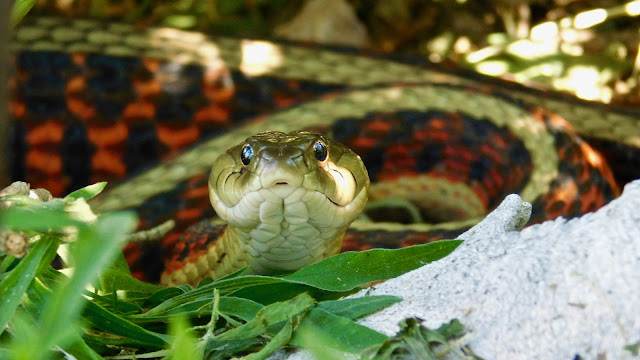 |
| Red-sided Garter Snake |
Speaking of serpents, with summer in full swing, the reptiles are out searching for sun. Slithering out from the depths of his crowded winter den, a red-sided garter snake spends the afternoon in a shady patch of tall grass.
The red-sided garter snake rises early in order to begin regulating his body temperature. He’s warmed up by solar rays and becomes most active in the morning before it gets too hot.
He spends much of his time near water because that’s where he finds his favorite foods. This common snake eats earthworms, amphibians, leeches, slugs, snails, insects, crayfish, small fish and other snakes.
He’s uniquely immune to the toxic secretions of toads and can eat them without harm. While hunting, the red-sided garter snake uses his superb sense of smell and vision in order to capture prey.
He strikes with precision using sharp teeth and quick reflexes thus immobilizing his unfortunate victim. Harmless to humans, his saliva is slightly toxic to smaller animals making it easier for him to manage his meal.
A data-collecting tongue emerges from an imposing head that looks like its been constructed from fitted bits of chiseled stone. The perfectly circular eyes are razor sharp and shimmer with metallic hues.
The red-sided is a beautiful snake distinguished by his geometric symmetry. He’s cream-colored with two red stripes running the length of his body that are overlaid by a black checkerboard pattern.
Despite his undisputed beauty and docile nature the garter snake is often persecuted by people. In reality he plays a vital role in the ecosystem and when confronted by a human, he’ll hastily retreat.
If he’s backed into a corner, he’ll coil, hiss and flare into a dramatic display of self-defense. Truthfully, though, he’s not much different from most of us because I believe he’d rather be left alone to live his life in peace and harmony.
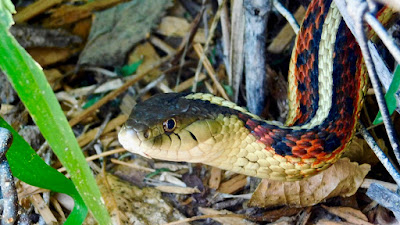 |
| Slithering out from the depths |
 |
| A superb sense of smell and vision |
 |
| A chiseled head |
 |
| And metallic eyes |
 |
| Red stripes run the length of his body |
 |
| A docile nature |
 |
| Live his life in peace |
Sandhills Summer - Fraught with Beauty
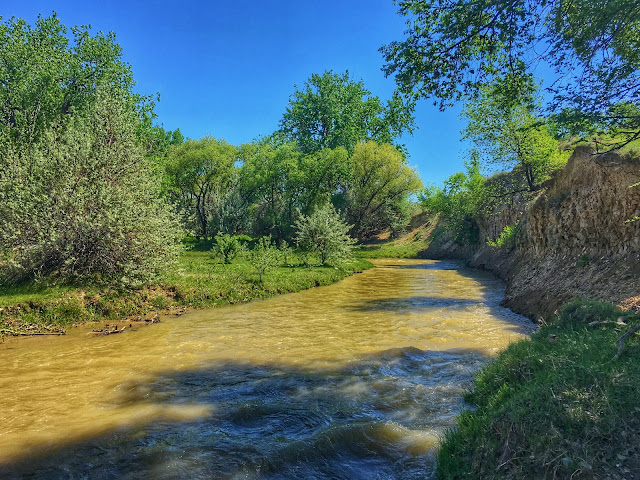 |
| Dugout Creek, Nebraska |
So far this summer, the Nebraska sandhills have been hit with heavy rain and sizzling temperatures. The combination of heat and moisture has the heavy air dripping with humidity.
Fortunately, just north of the farm there’s a shady oasis offering cold water, a cool breeze and infinite solitude. It’s a happy place where cattle, birds and wildlife congregate in order to escape the hostility of the Great American Desert.
The centerpiece of such paradise is a muddy creek that winds its way through a cottonwood forest. This year it’s more of a deluge as the water is rampaging through the canyon like a wild bull, making a crossing inconceivable.
Staying safely on one side of the torrent was still a satisfying experience as I saw wood ducks, woodpeckers and wild turkeys. The trees were topped with a fresh canopy of dense foliage that cast blue shadows across the lush grass.
This precious swath of verdant green is a unique environment fraught with beauty and peril. You can’t let your guard down while exploring this serene habitat because even in such an idyllic landscape as this, you have to be careful.
This time of year the prairie can be a dangerous place susceptible to fire, flooding and rattlesnakes. Somehow, though, no serpents were seen so the withdrawal from this Garden of Eden was a matter of free will.
 |
| The Nebraska sandhills |
 |
| A shady oasis |
 |
| A happy place |
 |
| A muddy creek is the centerpiece |
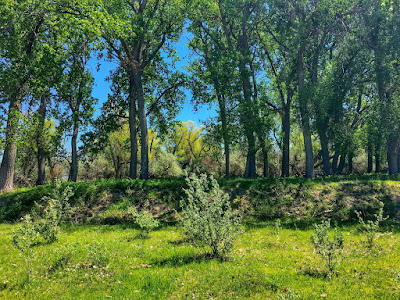 |
| Dense foliage |
 |
| Blue shadows |
 |
| A unique environment |
 |
| A serene habitat |
 |
| A matter of free will |
Evergreen Lake - A Washed Landscape
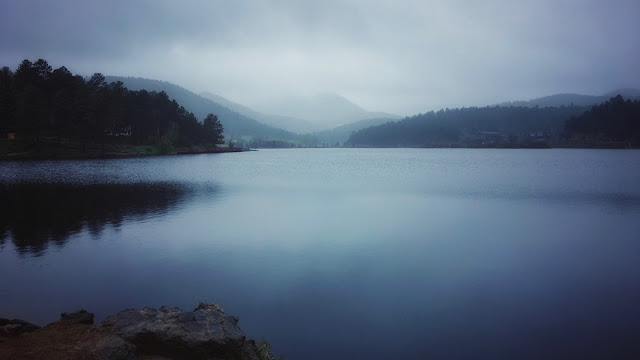 |
| A washed landscape |
On a soggy, spring morning at Evergreen Lake, a steady rain came pouring down out of the slate-blue sky. The relentless drizzle soaked anyone resolved enough to stray outside in the drenched domain.
The surrounding mountains were shrouded in a dense mist that blocked the early morning sunlight. The water’s smooth surface was broken by raindrops that created small ripples in the silky reflections.
The pleasant reservoir was formed 90 years ago when Bear Creek was dammed just above the old downtown. This time of year there’s a furious deluge that flows over the modest spillway.
On such a dreary day there wasn’t much wildlife to be seen but there were some bird species that seemed to thrive in the wet weather. Red-winged blackbirds didn’t miss a beat and the Canada geese were out in full force.
Near the shoreline, a few fat goslings tried to stay dry by nestling under their mother’s outstretched wing. A colorful kingfisher buzzed about while a hooded merganser swam in the narrow inlet.
Walking around the lake in less than perfect conditions was a wonderful start to the weekend. There was peace to be found in the middle of a storm that washed the landscape and cleansed the soul.
 |
| A soggy spring morning |
 |
| A drenched domain |
 |
| Shrouded in mist |
 |
| A pleasant reservoir |
 |
| A modest spillway |
 |
| Red-winged blackbird |
 |
| Canada geese |
 |
| Goslings under the wing |
 |
| A cleansed soul |
Dinosaur Ridge - An Earthen Hogback
 |
| Mount Morrison from Dinosaur Ridge |
Down around Morrison, ancient crags are uplifted and thrust into the sky creating a dynamic landscape. Since the 1800s, this area has been a hotbed for fossil hunters as bones and footprints from all sorts of dinosaurs have been discovered here.
A thin slice of mountainside spans across this Jurassic Park offering magnificent views of Red Rocks and the sheer foothills. Called Dinosaur Ridge, this earthen hogback requires a steep ascent to reach the narrow crest.
Traversing the knife’s edge is a dizzying endeavor as the cliffs fall away precipitously on both sides. At the summit, a few pine trees have been sculpted into interesting shapes by a relentless west wind.
The lofty heights of this rugged escarpment is a prime place to watch for migrating raptors riding the powerful thermals. Unfortunately, I didn’t see a single bird of prey but I did see a mule deer, magpie and a few spotted towhees.
Up on the rim, the sun sears through thin air causing the climber to sweat with profusion. After the snowy spring, it seems like the heat has been turned on with a switch so I don’t have any reservation in saying I believe the warmer weather is here to stay.
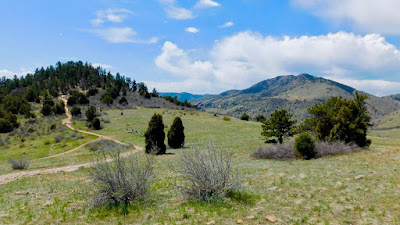 |
| A slice of mountainside |
 |
| Magnificent views of Red Rocks Park |
 |
| A knife-edged ridge |
 |
| Sculpted pine trees |
 |
| A rugged escarpment |
 |
| Mule deer |
 |
| And magpies |
Evergreen Overlook - Colored Pencil Drawing
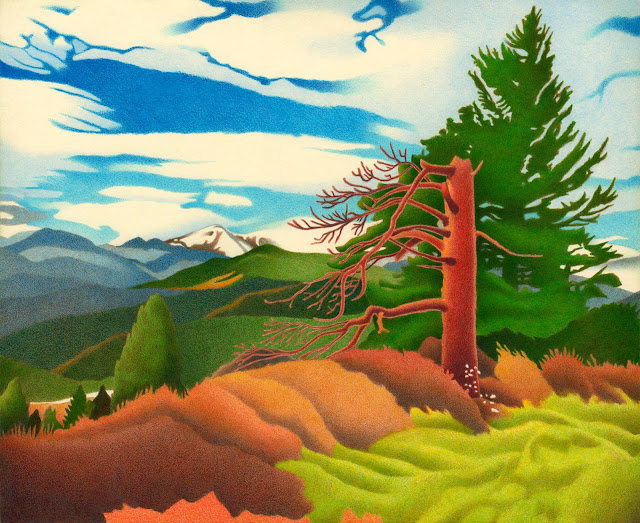 |
| "Evergreen Overlook" Colored Pencil |
Out of all of the drawings I’ve ever done, this is one of my favorites. An ambitious project, the composition is larger than usual for me so it took a tremendous amount of time and patience to complete.
It was deeply influenced by master artists such as Benton, Kent and O’Keeffe. The arrangement was thoughtfully simplified in order to capture the essence of our mountain corridor called Evergreen, Colorado.
From the southern slopes of Genesee Mountain, the Front Range foothills are carefully unfurled. Filled with smooth gradations, the billowing landscape is shaded like a piece of wrinkled clothing.
The verdant mountains get gradually lighter and bluer as they recede into the distance. Crowning the rugged skyline, the snowy Mount Evans Massive is partially obscured by low-lying clouds.
The dead ponderosa pine is the focal point as a halo of reflected light glows against the darkest passage. The skeletal structure of the red snag is shown in striking contrast to the lively, green tree that stands behind.
In front, the golden shrubs are overlapping elements that are arranged across the page in an orderly fashion. The row of brush encloses a swath of swirling grasses that lay in all different directions.
Above, a scattering of soft, white clouds stretches thinly across the vibrant blue sky. The upper atmosphere is darker at the top and gradually lightens as it approaches the rugged horizon line.
From such an incredible vantage point the lonesome wilderness yearns for the visitor’s undivided attention. Landmarks like Bergen Peak, Black Mountain and Elephant Butte can be discerned upon close inspection.
The vast expanse of meadows, trees and mountains unfolds before your eyes. This part of Colorado is beautiful countryside brimming with water, wildlife and wildflowers. I’m lucky to call this countryside home.
Bergen Park - A Shaded Retreat
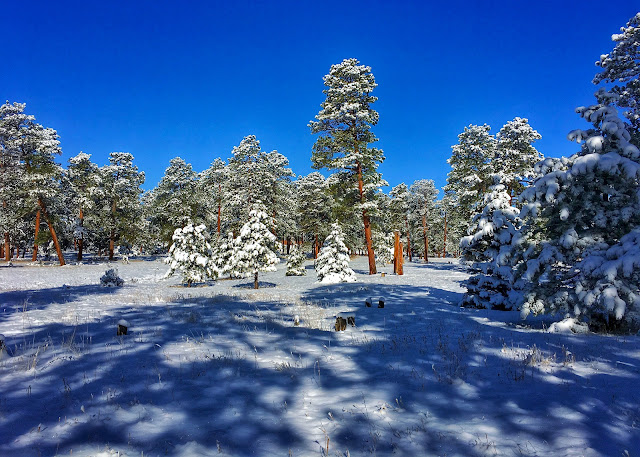 |
| Bergen Park, Colorado |
A sweet little preserve located just north of Evergreen, Bergen Park is an often overlooked stretch of ponderosa pine. The mature forest towers above its immediate surroundings, creating an eternally shaded retreat.
Thomas Bergen was the first to settle on the land when he built a log cabin here in 1859, calling it Elk Park. Soon after, a mining camp sprang up and the bustling community earned a stagecoach stop.
By 1915 the area was accessible by automobile, providing views of the Rockies, and situated on gentle hills well-suited for recreational use. That same year the site was donated to the City of Denver and Bergen Park was officially established.
Today, during the spring, wet snow blankets the woodland but the great trees are a study in resilience. Heavy pressure from all of the moisture bends the limber branches into impossible angles.
Morning after a big storm and the blue sky sparkles behind the crystallized conifers. During the melting process, the place becomes a robin’s playground where the birds pluck fat worms out of the black soil.
Paved trails cross-cross through the pleasant maze of red wood. It’s not a rugged wilderness whose beauty beckons but this park offers you a chance to escape from the urban environment and reconnect with the wonders of nature.
 |
| A towering forest |
 |
| Snow blankets the woodland |
 |
| A study in resilience |
 |
| Impossible angles |
 |
| Morning after the storm |
 |
| Reconnect with nature |
April Snow Showers - A Drenched Landscape
 |
| April snow showers |
The wind finally finished whipping through the foothills but now the local climate has become a monsoon. A disruptive rain/snow mix is settled over the Front Range but the much needed moisture has been a godsend.
The warmer temps create a heavy slush that pours down out of the gray sky. Day after day, the thirsty landscape is drenched and the dry gullies transformed into a deluge of cold runoff.
A blurry curtain of drizzled atmosphere has softened nature’s edges and the big mountains have all but disappeared. Not as monochrome as during a winter storm, the forest still sparkles with a bit of spring color.
The birds don’t like the dreary weather so many of them have retreated into comfortable seclusion. I still see robins as they seem to tolerate the cold by fluffing up while hunting for worms.
There is one animal up here that thrives under such miserable conditions. Elk are built for the harsh elements so they happily graze, gallop and buck across the soggy meadows.
On a more positive note, all the moisture from the last couple of weeks should green up the countryside and reduce the risk of fire. Also, I’m hoping these April snow showers will ignite a profusion of May wildflowers.
 |
| A rain/snow mix |
 |
| The landscape is drenched |
 |
| A blurry curtain of drizzled atmosphere |
 |
| The forest sparkles with color |
 |
| Elk are built for the harsh elements |
 |
| They gallop across the meadow |
Evergreen Lake Spring - Watercolor
 |
| "Evergreen Lake Spring" Watercolor |
After a tiresome winter, it's finally spring at Evergreen Lake where everything appears back in perfect order. The trout are jumping, ducks are quacking and dippers are dipping.
Rushing out of the rugged Front Range, Bear Creek becomes a lazy river as it enters the wide reservoir. The painting’s foreground features sparkling highlights that flicker across the pond’s icy inlet.
On land, the variety of fresh vegetation displays a rich diversity of size, shape and color. Known as Elephant, the big, gray butte concludes the background while wispy, white clouds sweep across a cerulean sky.
An arched footbridge transports the ambler to a winding boardwalk through a marsh of soggy cattails. The yellow reeds are a place where red-wings make a ruckus over food, relationships and intrusion.
Despite the blackbirds' protestations, most creatures consider the warmer weather a Godsend. Pressed beneath an arctic crush, we welcome spring as an uplifting prelude before the way-too-short summer season.
Noble Meadow Loop - The Windy Season
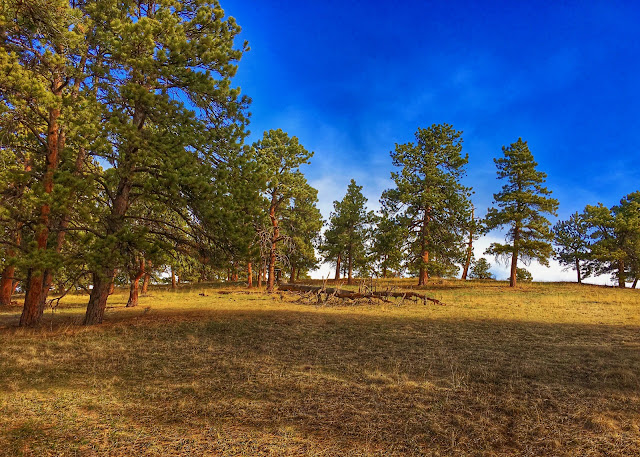 |
| Noble Meadow |
I’m enjoying our warmer temperatures but if it gets too hot, I feel uncomfortable. I actually don’t mind the wet and cold so I savor being out in stormy weather observing the wonderful lighting effects.
I can stand the heat and certainly the chill but there’s one annoying element that drives me crazy and indoors. It’s the ferocious west wind that whips down from the white mountains and batters the foothills.
The raging mistral is making its annual appearance as its the driving force ushering in spring. The windy season usually lasts for a couple of weeks but this year it seems to have been blowing for more than a month.
Every morning the early light is blemished by a murky haze that veils the normally blue sky. The relentless gale has disrupted the peaceful atmosphere causing the local wildlife to be constantly on edge.
The unstoppable breeze is born in the big peaks and funneled down through Noble Meadow like a runaway locomotive. You can find some relief by rerouting through a calm sanctuary of protective pine trees.
The tempest does serve a purpose, though, by removing dried grasses and broken branches while preparing the earth for new growth. I get that it’s an integral part of nature as it plays a crucial role in sculpting the landscape but I’m getting pretty tired of the wind.
 |
| The windy season |
 |
| A murky haze |
 |
| The peaceful atmosphere is disrupted |
 |
| The local wildlife is on edge |
 |
| The breeze is funneled through the meadow |
 |
| Protective pine trees |
Easter Snowstorm - A Bad Dream
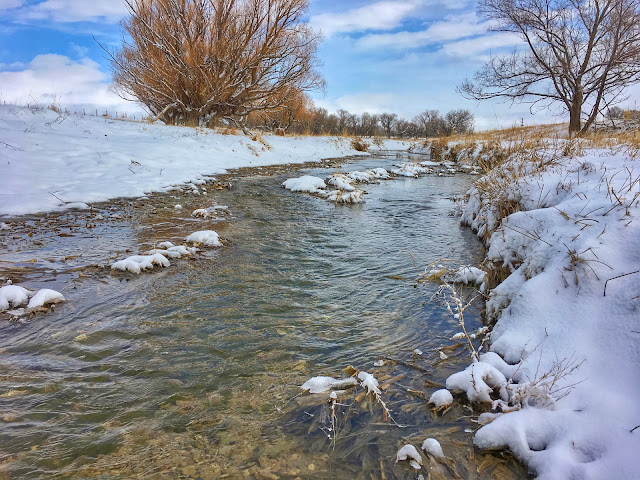 |
| Easter snowfall |
After a few weeks of beautiful weather in Bridgeport, Nebraska, things turned ugly in a hurry. Mother Nature made a fool out of anyone who thought spring was here for good.
Saturday night was no joke as the Great Plains was buried under six inches of heavy, wet snow. The flakes came down like rain and covered the hills, trees and corn.
The west pasture was completely white except for a swath of blue creek that wound its way through the prairie. The stream flowed freely until reaching a fresh beaver dam that diverted the water, flooding nearby fields.
The migrating birds were stunned by such drastic weather changes but the bucket calves seemed perfectly content. So much moisture will give a big boost to the farmer’s first crops being planted this season.
By Sunday afternoon, the sky cleared and a warm sun melted most of the accumulation. For a few days there will be a bit of ice and lots of mud but by the end of the week, the landscape will reawaken and this event will be remembered as nothing but a bad dream.
 |
| Buried under snow |
 |
| Snow covered the hills, trees and corn |
 |
| The pasture was white |
 |
| A winding creek |
 |
| The stream flows freely |
 |
| Contented bucket calves |
 |
| The moisture will boost crops |
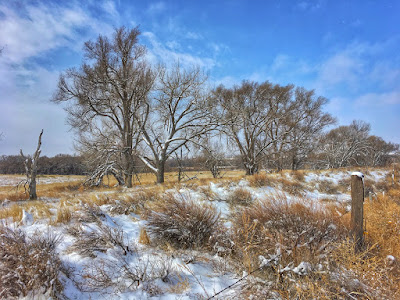 |
| The landscape will reawaken |
Early Birds - Bringing the Mountains Back to Life
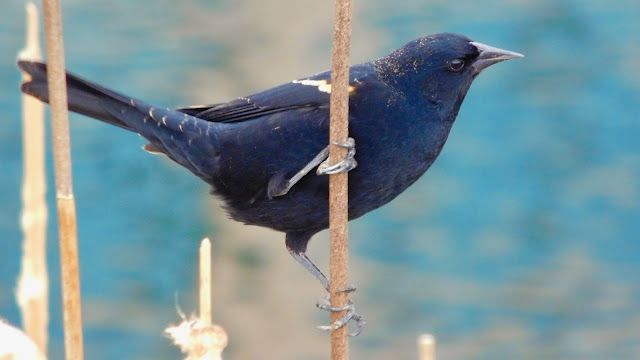 |
| Early Birds |
After a long, dark winter, the mud season is upon us and the bleak landscape is taking on a more encouraging atmosphere. Elk are on the move and our feathered friends are beginning to make their presence known.
The predictable arrival time of some of our most common birds is a trustworthy indicator of the upcoming seasonal transition. The availability of fresh water seems to coincide with the appearance of these early birds.
The first to show are male red-winged blackbirds as they begin establishing territory at the local wetlands in February. Dressed in formal black with a red and yellow wing patch, their familiar call breaks winter’s long silence.
The robin’s evening song betrays his presence as these surprisingly hearty birds seem to tolerate early spring’s cold and snow as well as anyone. They spend most of their day hunting for insects in the dried meadow grasses.
Canada geese come next as they arrive in pairs and land on the lake’s shimmering surface. They float about the ice-cold water with ease, creating picturesque reflections that are shattered by wind-driven waves.
By mid-March, mountain bluebirds burst onto the scene as they suddenly occur in droves and takeover the foothill’s grasslands. This time of year, during the breeding season, their blue coloring is so saturated it seems unreal.
Just the other day, we saw a few mallard ducks peddling cautiously across the pond as they seemed uneasy in new surroundings. The male was particularly striking with his green head sparkling iridescently.
There are many more species on the way as we’re expecting to see flickers, finches, sparrows and meadowlarks very soon. It’s an exciting time of year with flashes of color and continual chirping gradually bringing the dormant mountains back to life.
 |
| An encouraging atmosphere |
 |
| Elk are on the move |
 |
| Red-winged blackbirds show up first |
 |
| Robins are surprisingly hearty |
 |
| Shattered reflections |
 |
| Bluebirds take over the foothills |
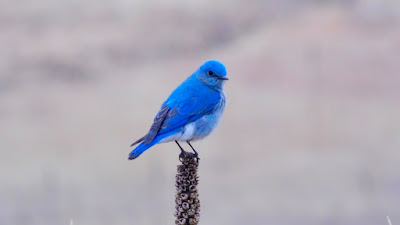 |
| The blue coloring is unreal |
 |
| Mallard Duck |
 |
| An exciting time of year |
 |
| The mountains are coming back to life |
Winter's Last Stand - A New Beginning
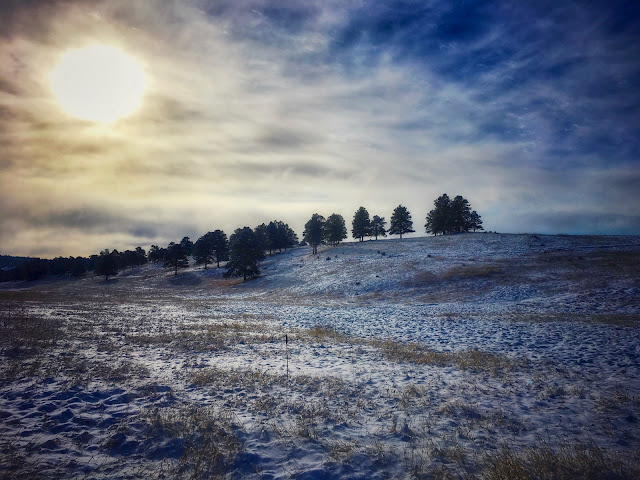 |
| Winter's Last Stand |
After such an unusual season distinguished by sparse moisture and frigid temps, a blustery weather system arrived the day before the first day of spring. With time dwindling down, winter decided it wasn’t going out with a whimper.
Blowing in from the north, the storm didn’t unleash a tremendous amount of snow but the ferocious winds were brutal. About six inches of white powder coated the landscape, falling through cold air that plunged to nearly zero degrees.
The dark morning spawned a sinister gale that stole your breath and spattered your face with tiny bits of ice. Crunching beneath boots through a near whiteout, the windswept trail was almost impossible to perceive.
The stiff breeze was funneled down through the gulch, creating deep drifts in some places and patches of bare ground in others. Troublesome Creek was thawed and the ribbon of blue flowed freely into a pair of stair-stepped ponds.
The turbulent skies cleared, offering symbolic hope for a new beginning and a brighter future ahead. We shall proceed with caution because spring is our snowiest season so we’re not necessarily out of the woods just yet.
 |
| A blustery weather system |
 |
| Not a tremendous amount of snow |
 |
| A dark morning |
 |
| Troublesome Creek was a blue ribbon |
 |
| Turbulent skies cleared |
 |
| A brighter future ahead |
Wild Iris Meadow - Watercolor
 |
| "Wild Iris Meadow" Watercolor |
Wild Iris Meadow is a wonderful park located just beyond Evergreen, Colorado. It’s a warm Spring day but the weather is about to change as storm clouds have gathered over the snowbound Mount Evans Massive.
The black guidelines are scribbled in with a felt-tipped pen, setting the tone for the simplification of the pretty scene. The bright colors are derived from a palette of pure yellow, green and blue.
The loose brushwork is a difficult technique because it’s uncomfortable to let the fluid medium flow with uncontrolled freedom. Soft passages of warmer pigment spread unchecked across the painting’s lower foreground.
Working in this way provokes great difficulty while dealing with the immediacy of an unforgiving medium. Despite its challenges, hopefully, this quick sketch captures the surreal beauty of a pristine wilderness.
Northern Flicker - A Unique Woodpecker
 |
| Northern Flicker |
We’re starting to see some unmistakable signs of an early spring. The daylight is lasting much longer, the snow is melting quickly and the lonely, winter trails are beginning to burst with new birdlife.
First to arrive this year were the red-winged blackbirds, then house finches appeared and then flocks of Canada geese searching for open water. I’ve also seen several mountain bluebirds as they’re decorating our brown meadow with a splash of bright color.
I like to observe the gradual changes that occur in the mountains during the seasonal transitions. I enjoy watching the birds come in and begin nesting but one of my favorites won’t show up here until it gets a bit warmer.
The northern flicker is a unique woodpecker that spends much his day on the ground, poking his beak into the ground while searching for insects. He announces his presence by establishing territory with a familiar call that echoes loudly throughout the pine forest.
These elegant birds are colored brown with a barred back and wings, spotted underparts, black bib and a white rump. The ones we see here are called ‘red-shafted’ because of the red wing and tail linings and the males sport a red ‘mustache’.
Because he spends so much time down in the dirt, the northern flicker engages in an unusual preening activity. Dust particles picked up by the flicker absorb oils and bacteria that are harmful to the bird’s feathers.
To clean himself thoroughly, the flicker squishes ants and then preens himself with the remains. Ants contain formic acid, which kills small parasites embedded in the flicker’s skin and feathers.
While hiking the summer trails, the flicker is flushed from the grasses and flashes white as he flies for the safety of a higher perch. Despite their off-beat hygiene and raucous call, I’m looking forward to encountering the northern flicker once the weather gets warmer.
 |
| One of my favorites |
 |
| A unique woodpecker |
 |
| A familiar call |
 |
| An elegant bird |
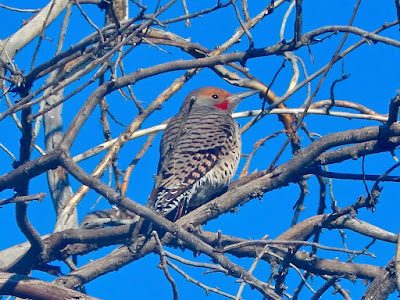 |
| Bars, spots and a red mustache |
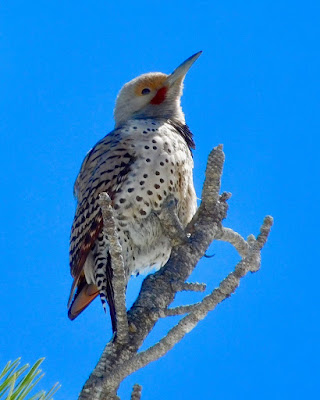 |
| A higher perch |
 |
| I'm looking forward to encountering the flicker |
Pikes Peak - A Soulful Mountain
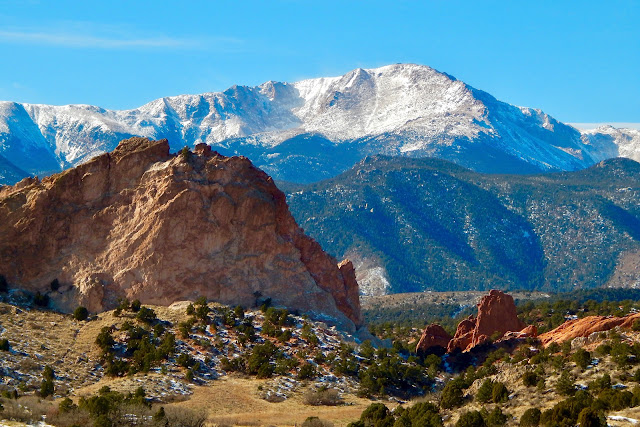 |
| Pikes Peak |
Traveling south through the heart of Colorado, the Rocky Mountains form an almost impenetrable barrier to the west. Rolling away to the east a broken forest clings to the numerous buttes and bluffs that are a prelude to the big peaks.
This time of year the southern mountains are speckled with white snow as much of the powder has been whisked away by a relentless breeze. The frigid wind blows down across the corridor making outdoor activities utterly miserable.
Rising out of the rugged terrain, Garden of the Gods is a glorious gateway to the soulful Pikes Peak. The unforgettable scenery features red sandstone slabs that stand out sharply against the dark greenery growing below.
Dominating the view at Colorado Springs, Pikes Peak has been inspiring explorers, gold seekers and artists for over 200 years. It’s named after the accomplished adventurer Zebulon Pike who first beheld the majestic, purple mountain in 1806.
When gold rushing 59ers set out for Denver in a quest for mineral riches, they emblazoned their wagons in fresh paint with the famous words "Pikes Peak or Bust!" The rocky monolith still commands the southern skyline and has become a lasting symbol for the entire Front Range.
American songwriter Katharine Lee Bates was so influenced by the extraordinary vista from the summit that she wrote the lyrics to America the Beautiful. The popular anthem is actually a superb tribute to the unique beauty and vastness of the Colorado landscape.
 |
| An impenetrable barrier |
 |
| Speckled with white snow |
 |
| Garden of the Gods is a gateway |
 |
| Soulful Pikes Peak |
 |
| Red sandstone slabs stand out |
 |
| Dominating the view at Colorado Springs |
 |
| A majestic mountain |
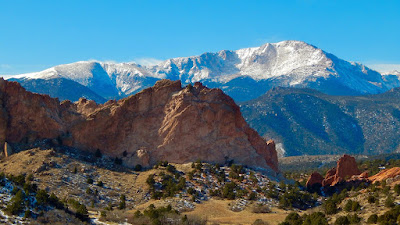 |
| A rocky monolith |
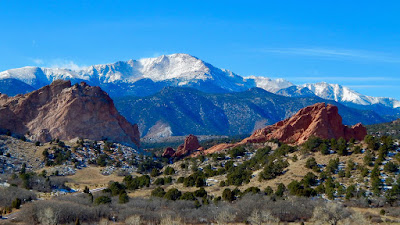 |
| A symbol of the Front Range |
 |
| An extraordinary vista |
 |
| Unique beauty of the Colorado landscape |
American Robin - A Cold Weather Inhabitant
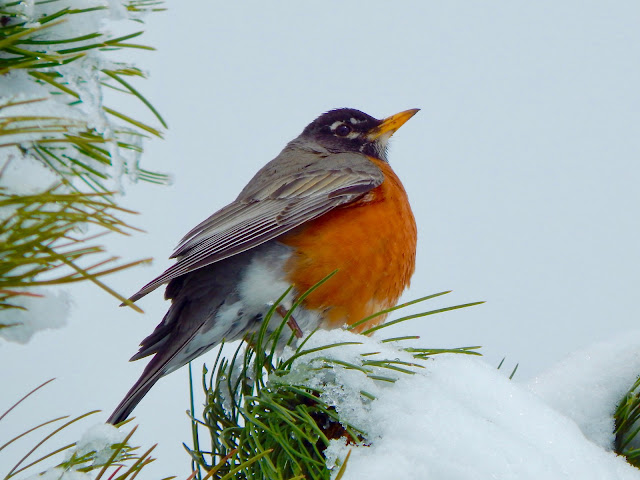 |
| American Robin |
The American Robin has become so common that his classical beauty is often overlooked and his mere presence taken for granted. By the end of February, males of this species show up here looking to establish territory.
The identity of this Proclaimer of Spring is unmistakable with his bursting, brick-red chest, gray-brown back, charcoal head and pale throat with dark streaks. The bird’s sharp eyes are ringed with white and the yellow bill is tipped with black.
He prefers to nest up high in the bough of a healthy ponderosa pine but he spends most of his day scampering about the meadow searching for insects and earthworms. While on the ground, he’s ever cautious as he keeps a wary eye out for any approaching birds of prey.
He is an industrious bird that is first to rise in the morning and last to roost in the evening all the while singing a cheerful song. During the summer, his nightly lullaby serenades the forest dwellers with a peaceful melody.
There are a few hardy individuals who attempt to overwinter here. Somehow these cold weather inhabitants survive by plucking berries from shrubs and trees while hydrating from tiny slivers of open water.
He’s more tempestuous than the suburban stereotype his personality invokes. When romping around in Colorado’s wild backcountry, though, there is something comforting about catching a glimpse of this familiar fellow when straying so far from home.
 |
| The American Robin is common |
 |
| They show up in late February |
 |
| Proclaimer of Spring |
 |
| A bursting, brick-red chest |
 |
| A gray-brown back and charcoal head |
 |
| Scampering about the meadow |
 |
| An industrious bird |
 |
| They serenade the forest to sleep |
 |
| Some attempt to overwinter here |
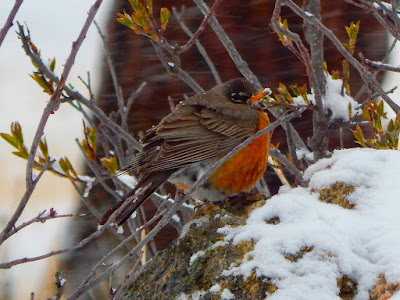 |
| Somehow they survive |
 |
| A suburban stereotype |
 |
| Something comforting about this fellow |
La Plata Peak - Watercolor
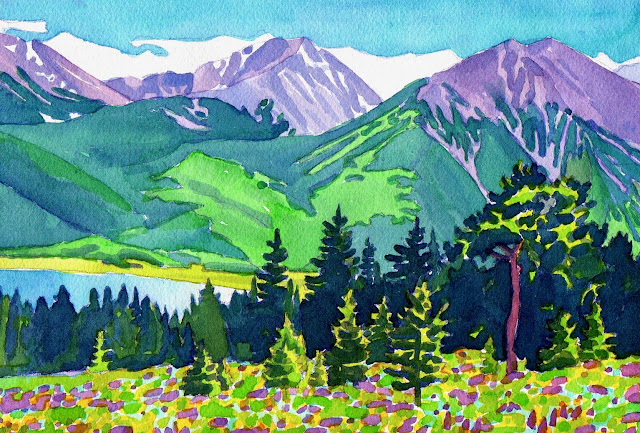 |
| "La Plata Peak" Watercolor |
At this time of year during the dark days of winter, dreams are filled with idyllic images of the picturesque high country. The presence of a monochrome landscape is replaced by a sleepy vision of vibrant color.
Majestic, purple peaks are robed in slopes of fresh green and they loom above a sliver of shimmering, blue lake. Stretched across the page, an indigo forest of fragrant pine is a beautiful buffer zone.
The immediate foreground is an alpine meadow filled with an absolute riot of dazzling wildflowers. It’s hard to imagine now but in just a few months, this impossibly-summery scene will become a virtual reality.
Grazing Horses, Nebraska - Colored Pencil
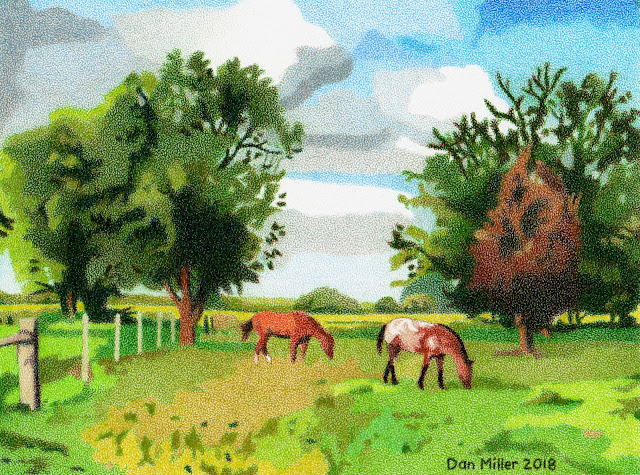 |
| "Grazing Horses, Nebraska" Colored Pencil |
“Through art we can change the world.” ~ #twitterartexhibit
It’s a warm summer day in Bridgeport, Nebraska and a pair of horses is grazing peacefully in a prairie paradise. The grasses carpeting this Garden of Eden are a patchwork quilt of verdant colors.
A few cottonwood trees are topped with a full canopy of dense foliage, casting blue shadows that offer some cool relief from the oppressive heat. Hopefully the gathering of bulbous clouds will result in an afternoon rain shower.
Colored pencil is applied over a stipple-textured paper, portraying a fleeting impression of this pastoral scene. Flecks of white paper show through even the darkest passages, creating a pointillistic effect that sparkles with light.
The optimism expressed by this picture is derived from the beauty of the two animals on display. An Appaloosa and a Red Dunn Quarterhorse, they reveal a perfect harmony that can only be found when immersed in nature.
During this digital age, the world has become much smaller. People can connect internationally with a single touch of the keypad. There seems to be an insane lust for speed, technology and profit.
Despite the demands of a modern lifestyle, we must continue to search for a healthy balance between the artificial and the organic. Working with an animal naturally can therapeutically restore your sanity because it requires patience, trust and sympathy.
Grazing Horses, Nebraska is my contribution to the upcoming Twitter Art Exhibit: Canberra, Australia. This unique event is an international exhibition of original postcard art benefiting Pegasus Riding for the Disabled of the ACT Inc.
Pegasus Riding for the Disabled of the ACT Inc. provides horse facilitated therapy programs and activities for people living with a disability. Their vision is a world that sees the ability in people with a disability and they are the only Riding for the Disabled Centre in the Canberra region.
Pegasus ACT provides over 2000 sessions a year to more than 100 people living with a disability. They provide mounted (riding) and unmounted programs, Hippotherapy (physiotherapy on horseback), school holiday, garden and early intervention goal-based programs – all according to ability and need.
All proceeds from sales will support Pegasus ACT’s horse facilitated therapy programs that are developed in collaboration with qualified coaches, therapists and families.
Twitter Art Exhibit: Canberra, Australia is the eighth installment of this open international exhibition of handmade postcard art for charity, donated by artists from around the world.
Social media plays a major role in the Twitter Art Exhibit. It is their intention to tweet, share and promote contributing artists to thank them for their participation, and to make this event a success for all involved.
The event will be highly publicized and well attended by art buyers and enthusiasts, members of the press, local artists and the TAE community.
For more information, please check out this link: #twitterartexhibit
Dillon Reservoir - Centerpiece of Summit County
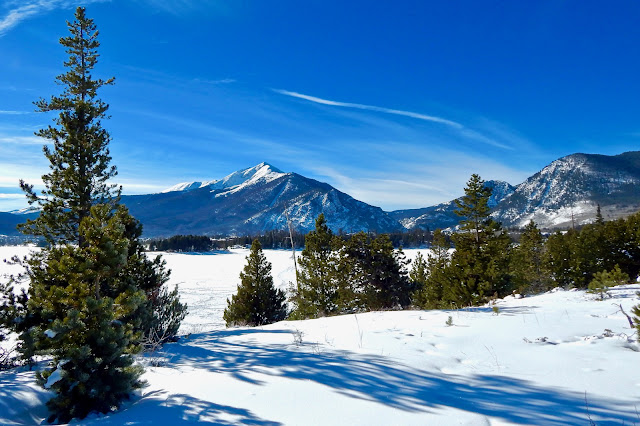 |
| Snowy Dillon Reservoir |
In 1883, during the height of Colorado’s gold rush, the town of Dillon was established at the confluence of three remarkable rivers. Ten Mile Creek, the Snake and the Blue came together, creating a natural finger lake in a basin of unsurpassed beauty.
After the mines played out, Dillon’s population dwindled while other towns in the area began to thrive thanks to the booming ski industry. Denver’s population exploded and folks in that dusty, old cowtown were thirsting for more fresh water.
The Denver Water Board came up with an idea to dam the Blue River and divert water via an underground pipeline dug through the Continental Divide. The board acquired the land and water rights needed to construct the reservoir while residents and businesses were notified that they must sell and leave by September 15, 1961.
The earth-filled dam was completed in 1963 and it sends water gushing from the Blue River Basin through the 23.3 mile Harold D. Roberts Tunnel into the South Platte River which then flows right through Denver. A few buildings were flooded but most of the Dillon townsite and its cemetery was relocated to the northeast edge of the reservoir.
Today the sparkling lake is the centerpiece of Summit County and it’s a fluid hub for almost any outdoor, recreational activity you can imagine. Hordes of people flock to this destination looking to hike, climb, bike, boat, fish, ski, snowmobile and bird watch.
The setting for such excursions is absolutely spectacular as gigantic, snow-capped peaks surround the broad valley. The scenery is gorgeous any time of the year but it’s especially dramatic when experienced during changing weather conditions.
Tremendous snowstorms lay siege to this area as dense clouds become socked into the basin, filtering out most of the light. The surreal atmosphere spawns a fantastic landscape of mountains and water that you’ve probably only seen in a dream.
It’s during such dreary times that one can find solitude along the shores of this magnificent preserve. I’ve spent hours exploring and photographing this special place and I hope to find more time in the future to enjoy everything this park has to offer.
 |
| Unsurpassed beauty |
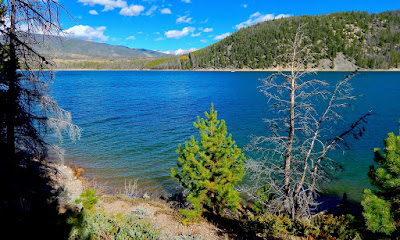 |
| The sparkling lake is a centerpiece |
 |
| A fluid hub for outdoor recreation |
 |
| People flock to this destination |
 |
| Snow-capped peaks |
 |
| A broad valley |
 |
| Gorgeous scenery |
 |
| Changing weather conditions |
 |
| Tremendous snowstorms lay siege |
 |
| A surreal atmosphere |
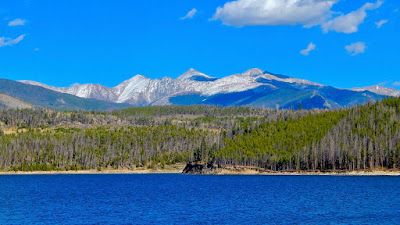 |
| A fantastic landscape of mountains and water |
 |
| Snowy solitude |
 |
| A special place to explore |
 |
| Find more time in the future |
Winter's Arrival - A Shocked Landscape
 |
| Winter's arrival |
After a month of unseasonably warm weather, a ferocious blizzard last Sunday proclaimed winter’s arrival. The snow fell as fast as the temperature dropped, coating the shocked landscape in sparkling crystals.
A misty atmosphere shrouded the mountains in a palette of monochrome color. With the absence of light, aerial perspective was exaggerated as scattered pine trees seemed to recede and disappear into the distance.
The morning after, clear skies sent bitterly cold air seeping into aching bones. Breaking trail through deep drifts while trudging through the frozen wilderness was an almost impossible endeavor.
The worst part about being out during that frigid sunrise was the howling wind that unleashed a ruthless beatdown. A tremendous gale force was funneled down into the valley taking your breath away.
Granules of powdered snow sprinkled across the meadow were shaped in writhing patterns that resembled the shifting sands of a great, white desert. Sharp pebbles of ice spattered my face producing tears that made it difficult to distinguish any progress gained.
After the turnaround with the wind at my back, the gradual descent over unstable terrain quickened to a faster pace. A cautious approach with respect to the harrowing elements prevented any problems from occurring at the finish.
Experiencing the full fury of an awesome storm by placing one’s self in duress is the only way to truly understand the mountains' merciless nature. I must say, though, I was pretty content to get back into a cozy home and spend the rest of the day watching Netflix.
 |
| A ferocious blizzard |
 |
| Coated in crystals |
 |
| Monochrome mountain landscape |
 |
| Scattered pine trees |
 |
| A frozen wilderness |
 |
| Snow sprinkled across the meadow |
 |
| Understanding the mountains |
Abundant Wildlife - A Mild Winter
 |
| Hooded Merganser at Crown Hill Lake |
On a warm, winter day at Crown Hill Park in Wheat Ridge, Colorado there was abundant wildlife to watch. The inconspicuous refuge is embedded into the outskirts of a bustling, urban corridor.
Upon entering the preserve, a coyote was seen pouncing for voles in the wide swath of grassland that encircles the main lake. The stealthy predator was a beautiful canine that has adapted well to life in the big city.
Out of the sky, a steady stream of Canada Geese made a noisy landing at the surface’s icy edge. Some of them slid into the open water where they floated freely while others stayed on shore and tucked their beaks into a wing, taking a quick nap.
On that Saturday morning a strange looking bird was a surprise visitor that appeared suddenly onto the scene. I was lucky to observe a group of hooded mergansers, four males and one female, fishing in the frigid reservoir.
Such striking birds, the males sported white crests that were fanned out in all their glory while the female flaunted an outrageous tuft of orange head-feathers. They kept submerging under the water only to reappear a few moments later, croaking like chorus frogs the whole time.
Around the next bend, I saw four northern shovelers gleaning the water’s surface for tiny, edible organisms. Their species has developed an enormous, scooped bill that allows them to strain their favorite foods from the shallow wetlands.
On land an eastern fox squirrel was out and about searching for something to eat during such a fine morning. Wary of strangers, he scampered up a barren tree and from a secure niche glared down at me with an annoyed scorn.
Just as I was preparing to depart, a few emanating ripples caught my attention, leading me to believe that there was another creature present. I peaked through some tangled brush and glimpsed a foraging muskrat but as soon as he detected me, he was off in a splash.
Even though it was time to go, I didn’t want to leave because I wanted to discover what else might be out there. The last thing I saw was a kestrel perched high in the woods and sitting perfectly still while watching over a field of wilted grasses.
I undertook the journey with low expectations because I usually don’t see much activity during January as it’s always been too cold. This year, however, it’s completely different with the temperatures being so warm.
Sometimes when Nature doesn’t appear to act the way she’s supposed to, it fills me with great concern. On that day I tried not to worry about the changing climate and instead - I just enjoyed the nice weather.
 |
| Crown Hill Lake |
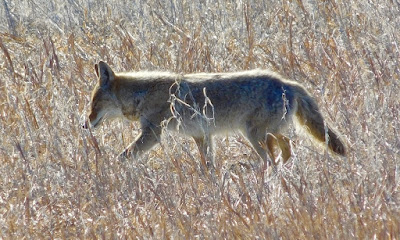 |
| Hunting for voles |
 |
| A beautiful canine |
 |
| Canada goose at the icy edge |
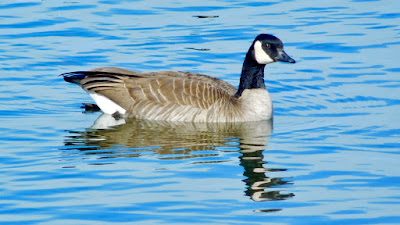 |
| Floating freely |
 |
| Hooded mergansers |
 |
| White-crested male and an orange-crested female |
 |
| Northern shovelers gleaning for food |
 |
| An enormous, scooped bill |
 |
| Fox squirrel out and about |
 |
| Glaring with scorn |
Bergen Peak Summer - Watercolor
 |
| "Bergen Peak Summer" Watercolor |
It’s a warm, summer day in Evergreen, Colorado where Elk Meadow is dry and yellow. Weathered ranch structures provide contrast with the profusion of fresh wildflowers.
The imposing Bergen Peak serves as a darkened background while low clouds drift across the shimmering, blue sky. At 9,200 feet, its lofty summit is a regional landmark.
People don't describe this mountain as awe-inspiring but the views from the top are. Bergen doesn't attain the same status as a fourteener and some even dismiss it as just another foothill.
The lovely crag is just down the street so I’ve spent lots of time on its steep slopes. Over the years I've learned not to underestimate the gentle giant because it can become quite surly.
The easy accessibility and excellent trail system make this park a local hot spot. During the summer, the paths are flooded with hikers, trail runners, mountain bikers and horseback riders.
The resilient mountain takes a beating from heavy usage but if you're not careful it’ll bite back. I've gotten sick from racing to the summit and taken some nasty falls while descending steep switchbacks.
I've gotten caught in the meadow by thunderstorms and have been nearly struck by lightning. One morning during the fall rut, I got chased off by a herd of irritable elk.
I now understand that when I'm on Bergen Peak the unstable terrain, abundant wildlife and unpredictable weather can transform an ordinary stroll into an exhilarating adventure.
Bergen Peak may not be the most beautiful mountain in Colorado but I always bring my camera. It's not the toughest to climb either but I always get my heart pounding.
Despite the chaos and crowds, if you know when and where to look, peace and solitude can always be found. Bergen Peak is definitely one of my favorite places in the Front Range to go hiking.
Christmas Blizzard - A New Beginning
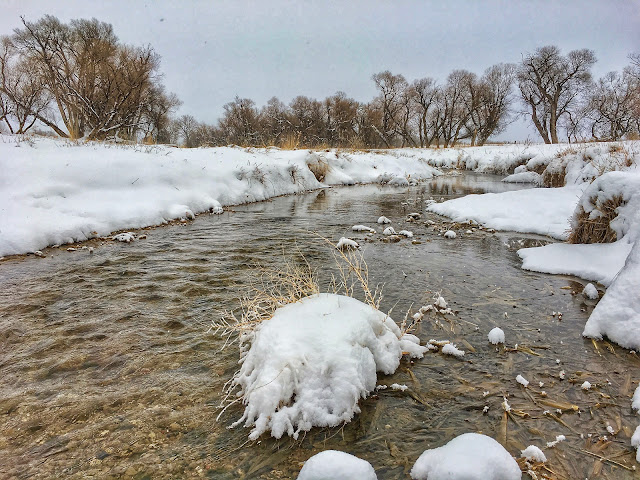 |
| White Christmas at Bridgeport, Nebraska |
After a long spell of unseasonably warm weather, an unexpected snowstorm slammed into Bridgeport with a vengeance. Western Nebraska was transformed into a winter landscape of dark woodlands set against the white sandhills.
During an expedition to document the blizzard’s dramatic effects, I was guided by a pack of friendly farm dogs. An Australian Shepherd and two Schnorgies plowed through eight inches of snow, blazing a trail along the banks of a winding, black creek.
I followed them closely but I missed the shot when they flushed a flock of migrating mallards. Further on as we approached a particularly fine looking tree, a great-horned owl took flight and flapped quietly across the frozen prairie.
Throughout the day, bitterly cold temperatures continued to drop and a band of heavy snow kept falling. From an overlook above the valley, the normally far-reaching views were condensed into a blur of powdered forest fused with the milky sky.
Trudging through deep drifts far from home we found ourselves right in the middle of a windy whiteout. Even in such harsh conditions, the pups were delighted to pounce and play as I struggled to keep up while crossing a dormant cornfield.
By dusk on the last day of the storm, a spectacular sunset spread a sense of relief across the land. Warm rays emanating from the horizon seemed to signify December’s end and symbolized an inspiring hope for the new year’s beginning.
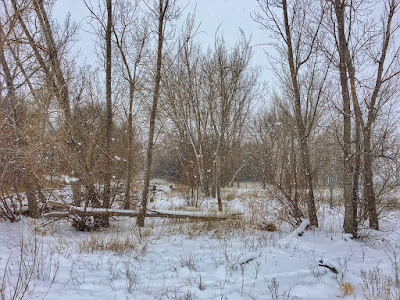 |
| Dark woodlands |
 |
| Guided by an Australian Shepherd |
 |
| Plowing through snow |
 |
| A winding, black creek |
 |
| A fine looking tree |
 |
| Bitterly cold temperatures |
 |
| A blur of powdered forest |
 |
| The pups were delighted |
 |
| A spectacular sunset |
Goliath Peak - Colored Pencil Drawing
 |
| "Goliath Peak" Colored Pencil |
Indiscriminate with its wrath, Goliath Peak is a ferocious summit controlling entry into the Mount Evans Massive. Expressed in the composition above, a casual climb is transfigured into a crippling circumstance of chaos and confusion.
And so it begins just below tree line where sinister, black pine are guardians of the gateway to Gehenna. Jumbled across the foreground, patches of muted color are arranged in strange, interlocking shapes.
At the far end of the earth, blue mountains are an impenetrable barrier compressing the space into a suffocating picture plane. Silvery green in the summer, the hulking behemoth looms above but it’s not quite as close as it appears.
Gnarled, gray snags are twisted in front of the darkest darks as their pale presence is a painful reminder of our certain mortality. Hopefully, the most recent storm has passed as promised by broken clouds that disperse across the steel-blue sky.
Reaching the top is a back busting, breathtaking endeavor but the ramifications of exerting such effort results in a horrendous heart break. Seemingly secure for now, the mental adversity is the biggest obstacle.
There’s still plenty of time and lots to be done so this landscape is just another step in the healing process. Maybe this drawing will be therapeutic in alleviating the anxiety that has been so difficult to overcome.
Mount Evans Winter - Watercolor
 |
| "Mount Evans Winter" Watercolor |
It's a cold and windy day in a spectacular basin known as Upper Bear Creek. Buried under a blanket of fresh snow, Mount Evans is a lofty landmark that imposes it’s iron will on the local weather patterns.
Tethered to the foreground, sturdy evergreens are built to withstand the brutal storms that wreak havoc on this hidden valley. Here, heavy snow clings to the blue spruce creating an intricate pattern of dark and light.
This time of year, the landscape can only be expressed with mostly cool colors like blue and green. Surprisingly, there’s also some pink and yellow washed into the drifts that are angled across the foreground.
Such a difficult medium to work with, watercolor painting demands that you relinquish control. Most of the fluid brushstrokes are allowed to flow freely as they encourage you to let your imagination run wild.
Strokes of pale color are scrubbed across the textured surface, giving a loose suggestion of the vast wonderland. Dark skies set the ominous tone that permeates the arctic atmosphere, instilling the inhabitants with a sense of dread.
It’s an uncomfortable morning devoted to tramping around on treacherous terrain. The risk involved in such an undertaking is worth it though because being immersed in such pristine surroundings is an unforgettable reward.
Elk Meadow Loop - A Brown Christmas
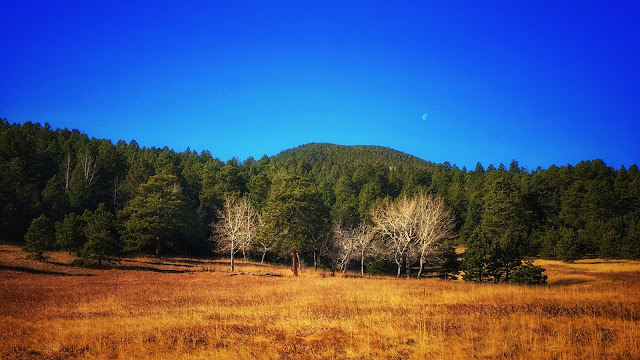 |
| Elk Meadow, Colorado |
It looks like it’s going to be a brown Christmas because the local weather forecast doesn’t call for any moisture in the near future. Usually by now there’s a bit of snow on the ground but this year the fall has been warm and dry.
Every day we awake to clear, sunny skies that delay winter’s arrival, keeping even the smallest ponds from becoming frozen. Most people are enjoying the unusual conditions but the photographer must use curious techniques in order to document the dull scenery.
Last week while looping around Elk Meadow, I found myself looking for creative ways to portray the barren landscape. At one of my favorite places overlooking the park, I took to shooting straight into the dazzling sun.
Further on, a lone rock is described with strong contrast as it’s settled on a bed of soft grass. Along the dusty trail and down into a damp drainage, a ghostly grove of aspen are an eerie niche in the dark forest.
Out on the open ridge, a flood of yellow light streams through the atmosphere as if it were still summer. Back down on the golden plain, there’s a gradual elevation gain that can become a grind as the long hike comes to an end.
This area is beautiful during any time of the year but it definitely gets more exciting when the weather takes a turn for the worse. It’s been a nice break so far but hopefully things will get back to normal, meaning frigid temps and fresh powder.
 |
| Curious techniques |
 |
| Shooting straight into the sun |
 |
| A lone rock |
 |
| A ghostly grove |
 |
| Yellow light on the ridge |
 |
| Beautiful any time of the year |
 |
| Waiting for worse weather |
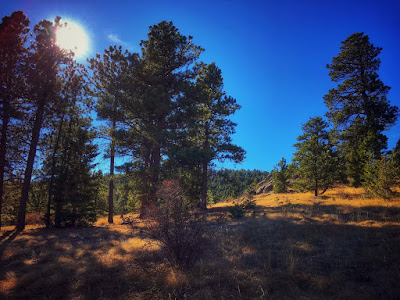 |
| Hopefully things will get back to normal |
Mule Deer Moment - A Dramatic Effect
 |
| Mule Deer Moment |
On a dreary, early-autumn morning in the Front Range foothills, swollen, gray clouds have descended to the earth. The colorless curtain shrouds the countryside with an air of mystery and eerie silence.
There’s no reason to carry a camera because the low light makes it impossible to even conceive of documenting this unique weather phenomena. In the cold and wet there’s plenty of solitude as there’s not another living soul in sight.
A steady drizzle of much needed moisture causes the outline of all elements in the landscape to soften and become blurred. Despite the absence of light, the fall color is more vibrant when the grasses, trees and brush are coated with a vaporous sheen.
The soggy jaunt comes with no expectations of anything special as it’s just a chance to soak up the surroundings. Suddenly, up over the crest of a broad ridge a trio of gentle animals is grazing right at the forest’s edge.
It’s a mule deer moment that’s just too irresistible to disregard. Grab your camera, line it up, try to focus and maybe you’ll get a lucky shot but be quick because these cautious creatures will be off in a flash.
Fortunately, the young bucks seem unconcerned by the visitor’s presence and continue to proceed with their feeding. The stable situation allows the photographer to fire off a few shots with hopes of getting something worth saving.
Surprisingly, some of pictures turned out so now you don’t have to rely totally on memory to recall such a wonderful, wildlife encounter. After taking some time to reflect, I guess that murky sunrise wasn’t so bad because it definitely enhanced the photos with a dramatic effect.
 |
| A dreary morning in the foothills |
 |
| A unique weather phenomena |
 |
| The fall color is vibrant |
 |
| Gentle animals |
 |
| A lucky shot |
 |
| Unconcerned by visitors |
 |
| A stable situation |
 |
| Dramatic effect |
Mount Sneffels Summer - Colored Pencil Drawing
 |
| "Mount Sneffels Summer" Colored Pencil |
Situated in southwestern Colorado, Mount Sneffels is a spectacular precipice rising out of the San Juan Mountain Range. Looming above a field of vigorous dandelions and rolling foothills, the solemn monarch prevails over all comers.
It's a pleasant summer evening and the setting sun bathes the scene in a peaceful ambiance that seems to permeate the entire area. Low, evening light floods in from the west creating strong shadows that define the rugged portrait of this beautiful peak.
The picturesque scenery is lit by a golden hearth that burns from within so a warm undertone continues to show through even after successive layers of color are added. The result is a landscape drawing that glows with cheerful optimism.
The lower section is bursting with bright yellow while blue shadows define the rigid structure of the impressive Rocky Mountains. The thoughtful design is influenced by the fact that elements filled with warm colors appear closer to the eye than those elements filled with cooler colors.
By taking advantage of this principle, the drawing is instilled with a nice sense of space. Warm colors are used in the foreground and gradually cooler colors as the picture recedes into the distance, creating an illusion of depth that captures the vast expanse of this special place.
Mount Sneffels and its range of rugged peaks pierce a smooth, summer sky while a few soft clouds occupy the infinite airspace as they slowly drift past. Blue tones from above are carried down below, unifying the entire composition with common hues.
Several different pigments have been layered over the top of each other creating a vibrant tapestry of deeper, more interesting color. When viewed from a distance, the jumbled mosaic fuses together in the viewer's eye.
Dominating the rugged skyline, Mount Sneffels is the undisputed focal point of the composition. Aesthetically, the apex of this pretty peak is placed in the compositional sweet spot according to the guidelines laid out by the golden ratio.
The complex arrangement of peaks has been transformed into austere forms of light and shade. This intentional simplification gives Mount Sneffels an imposing presence and the heightened contrast at it's summit will hopefully catch hold of the viewer's attention.
If you’re interested in learning more about the step-by-step process involved in drawing landscapes with colored pencil, please check out this link: Draw Landscapes
Evergreen Lake - Wonderful Waterfowl
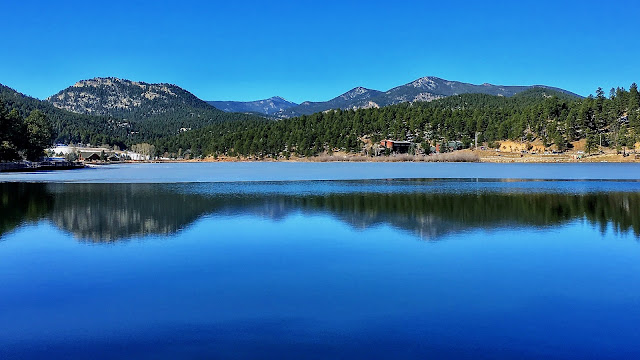 |
| Evergreen Lake |
On an exceptionally beautiful morning at Evergreen Lake, a dusting of fresh snow was hard evidence of a cold night. As the transition to winter gradually occurs, the last bit of open water was vanishing beneath a veil of thin ice.
Clouds of moist air began to disperse but they diffused the low light, resulting in an effect of milky atmosphere. Usually during the quiet season, you won’t glimpse a single soul in the vacant wetlands but on that day we observed a pair of wonderful waterfowl.
Perched on a rocky outcrop, a double-crested cormorant was drying its wings down below the dam’s spillway. Distinguished by piercing blue eyes, this prehistoric-looking creature was probably just passing through while on his way to a much warmer place.
Around on the far end of the blue reservoir, we encountered one of my favorite species, the American dipper. It was a pleasant surprise because I normally see this chunky, little bird farther downstream feeding in the fast-flowing current.
This incredible year-round resident spends its entire life on the water and it has the fortitude to withstand the coldest temperatures nature can conceive. The outgoing ouzel danced a bobbing jig on the rocky shoreline before completely submerging into the frigid pond.
It had been a while since we visited the preserve but we found the lake displaying its full splendor. Fortunately, the entire morning’s events were faithfully reflected on a fluid canvas which allowed me to record a few frozen moments in time.
 |
| A beautiful morning at Evergreen Lake |
 |
| The transition to winter |
 |
| A veil of thin ice |
 |
| Vacant Wetlands |
 |
| Double-crested cormorant |
 |
| Piercing blue eyes |
 |
| A prehistoric looking creature |
 |
| Just passing through |
 |
| A chunky, little bird |
 |
| Spends most of its life on water |
 |
| A bobbing dance |
 |
| A frozen moment in time |
Chief Hosa Trail - Peaceful and Beautiful
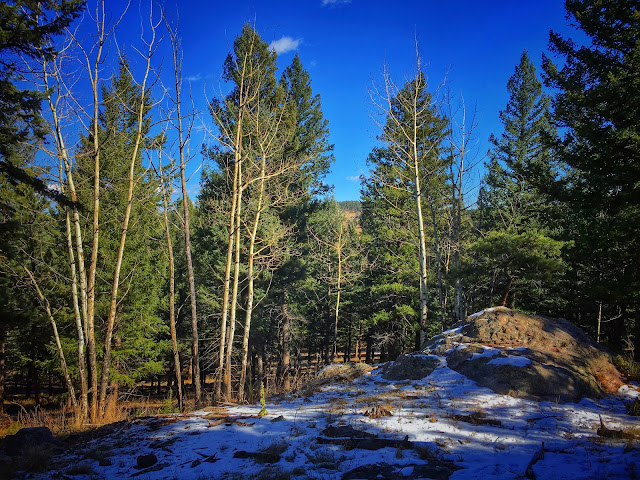 |
| A study in contrast |
Looping casually behind a historic chalet, Chief Hosa Trail is a hardened pathway that passes through forests of Douglas fir, lodgepole and ponderosa pine. Devoid of much activity during this season, autumn is a fine time to bask in nature’s glory.
The enlightened track circumnavigates a broad ridge that knifes through the wilderness, sharing with the keen observer a study in sharp contrast. By traversing the hillside, you’ll encounter two distinctly different ecosystems.
The north-facing slope is mired in an eternal shadow where giant fir and spruce trees envelope the lush undergrowth of glossy ferns. Once inside you’ll discover that deep snow is ever-present and white aspen glow against the dark backdrop.
The south-facing slope is flooded with bright sunlight where the ponderosa pine are twisted above an open scrubland of yellow grasses. Out there the rocky terrain is wide open with far-reaching views that extend all the way to the Continental Divide.
Mule deer favor the damp seclusion provided by the murky backside while small birds seem to prefer the sunny front where they cheerfully flit about. Passing through such diverse life zones sparks a curiosity to learn more about the plants and animals that inhabit this special place.
Chief Hosa Lodge opened in 1918 on the far west side of the circular setting. Named after the Southern Arapaho leader Little Raven, also known as Chief Hosa, the rustic retreat was made from local stone and logs so that it would blend seamlessly into its natural surroundings.
Back in its day, it provided shelter and amenities to Denverites escaping the bustling city for a few days in the tranquil foothills. If you come to visit, you’ll see that Hosa is a fitting name as that word comes to us from the Ute Indian tribe and it means peaceful and beautiful.
 |
| Mired in shadow |
 |
| Flooded with sunlight |
 |
| Pine above a yellow grassland |
 |
| Rocky terrain |
 |
| Views extend to the Continental Divide |
 |
| Chief Hosa Lodge opened in 1918 |
 |
| Peaceful and beautiful |
Little Bighorn Valley - Colored Pencil Drawing
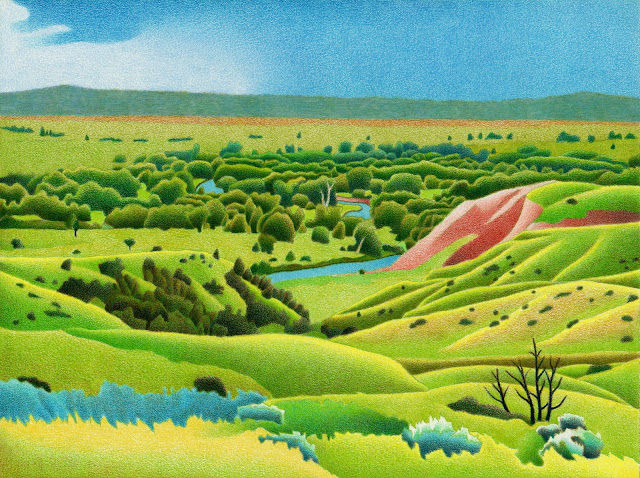 |
| "Little Bighorn Valley" Colored Pencil |
It’s springtime on the northern plains and the Little Bighorn Valley is a kaleidoscope of lively colors. From the rim of this lonely overlook, one can review Montana’s remarkable landscape.
Carving a rugged valley within the vast prairie, a winding river comes rushing down out of the big, gray mountains. You can barely catch a glimpse of the water as its concealed by a sprawling forest of cottonwood.
The lush treetops form wavy bands of foliage that are highlighted with lemon yellow. The trees are mostly green and modeled with dark shadows that appear more blue as they recede into the distance.
The sweeping hillside is steeper than it looks as it blends smoothly into the canyon floor. Just below the summit, a small patch of scrubby woodland has found its niche in a crease of earth called a coulee.
Blemishes of sagebrush are stippled randomly throughout the countryside’s quilted patchwork of fresh growth. Flowing across the picture’s foreground, lush grasses steal their color from the rest of the composition.
The approaching storm is nothing compared to the historical drama that haunts this ground’s turbulent past. Once the scene of a bloody battle, this place has healed itself into a peaceful refuge for solemn contemplation.
Genesee Mountain - Bursting with Beauty
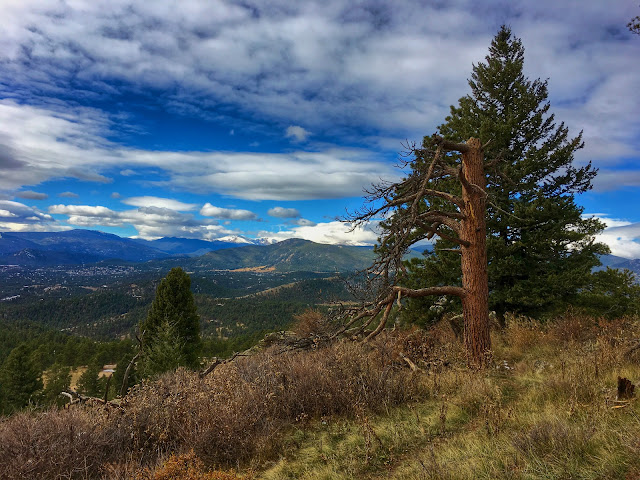 |
| Genesee Mountain trail |
When heading up out of Denver, the first big peak you’ll encounter is the wonderful Genesee Mountain. A network of well-worn trails spirals around its flanks, taking you all the way to the top.
On a cold November morning the colors are dull and gray but the spectacular setting is classic Colorado foothills. The steep, grassy slopes are golden ochre and covered by an old-growth forest of ponderosa pine.
Erected at the precipice, a sturdy flagpole flys an American flag that’s tattered from the constant barrage of blowing wind. The historic guidon is a beacon of national pride and it’s determined flight is a symbol of the pioneer spirit.
Every Flag Day since 1911, an organization called the Daughters of the American Revolution has replaced the shredded banner with a new recruit. Off towards the west a patriotic path, inspired by the Stars and Stripes, descends gradually into a wide open meadow.
After you break out of the woodland, you can get right up close to a fence that encloses another western icon, the buffalo. A large herd of these impressive creatures roams majestically all over the pasture’s rolling hills.
Just a few miles from home, it’s interesting to view the town of Evergreen from such a unique perspective. You can see all the recognizable landmarks but mighty Bergen Peak is surprisingly dwarfed by the snow-capped Mount Evans Massive.
Genesee Mountain Park is often overlooked by those traveling I-70 to the Rockies’ more exotic locales. The truth is, though, that this underrated area bursts with just as much beauty as almost anywhere else in the state.
 |
| Wonderful Genesee Mountain |
 |
| A spectacular setting |
 |
| Classic Colorado |
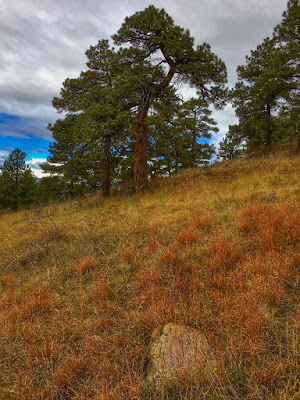 |
| Steep, ochre slopes |
 |
| An old-growth forest |
 |
| American flag at the summit |
 |
| Buffalo roam these hills |
 |
| Bergen Peak and Mount Evans |
 |
| Bursting with beauty |
Red Rocks Park - Garden of the Angels
 |
| Garden of the Angels |
By the end of October in the Colorado foothills, the birds have slipped away, the first snow has loosened and most of the leaves have fallen. Luckily, lower down near Morrison there’s still enough color to brighten your day.
On a gorgeous, golden morning at the Garden of the Angels, autumn’s palette is composed from red, yellow and orange. The little creek that flows gently through this geologic wonderland is still lined with lush cottonwoods.
With the world famous amphitheater set as its centerpiece, this unique state park is currently known as Red Rocks. It’s a surreal place where sandstone slabs are tilted precariously, thrusting upwards towards a deep, blue sky.
Stair-stepped trails weave through the preserve, offering a fresh viewpoint at every turn. If you’re able to position yourself at just the right angle, you’ll see pale foliage set against dark shadows, creating a striking contrast of color and tone.
The search for a last bit of this year’s vibrant hues has ended in the transitional zone where the plains meet the mountains. Historically a sacred spot revered by native peoples, this heavenly hillside still feels like hallowed ground.
This year the temperatures are warmer than usual but a cool breeze blowing down from the white peaks gives you a chilly forewarning. Each successive day is supplied with gradually less light so now it’s time to start preparing for that dreaded season of darkness.
 |
| Color to brighten your day |
 |
| Autumn's palette |
 |
| A geologic wonderland |
 |
| Cottonwoods line the creek |
 |
| Sandstone slabs are thrust upwards |
 |
| A fresh viewpoint |
 |
| Pale foliage set against dark shadows |
 |
| A transitional zone |
 |
| Hallowed ground |
 |
| Prepare for the season of darkness |
American Kestrel - Heart over Height
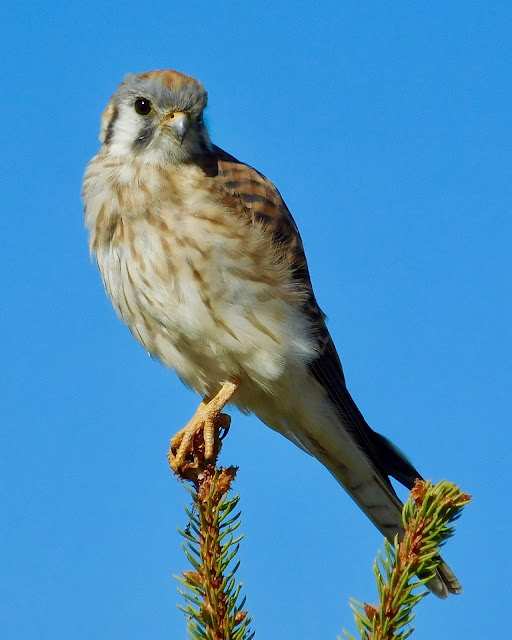 |
| American Kestrel |
The American Kestrel is North America’s smallest and most widespread falcon. This pocket-sized bird of prey is extremely adaptable as she can be found anywhere in the Western Hemisphere from Alaska to the tip of Tierra del Fuego, Argentina.
The most colorful of all the raptors, she is distinguished by brown wings as opposed to the male’s beautiful slate blue. Perceiving her identity is practically unmistakable while she’s perched on a small pine scanning the grassland for her favorite food; grasshoppers.
She owes much of her success to a broad diet that includes almost any insect, lizards, snakes, mice and voles. She’s a ferocious predator that has the ability to take red squirrels and small birds especially sparrows while still on the wing.
She’s the fearless matriarch of a tight-knit group as both parents are equally active in rearing the young. Often, the whole family will go out on a hunting foray as it’s an effective way to teach the fledglings how to stalk prey.
American Kestrels nest in cavities but they lack the ability to excavate their own. They rely on old woodpecker holes, natural tree hollows, rock crevices, and nooks in buildings and other human-built structures.
With plenty of available resources, this sparrow hawk is a permanent resident of the Rocky Mountains. Colorado is her home and she’ll spend her entire life here, flourishing happily even during the region’s cold and snowy winter.
Despite her small size, this little bird is a courageous warrior so don’t dismiss her diminutive nature. When it comes to the physical attributes necessary to survive in this crazy world, I’d take her heart over height any day.
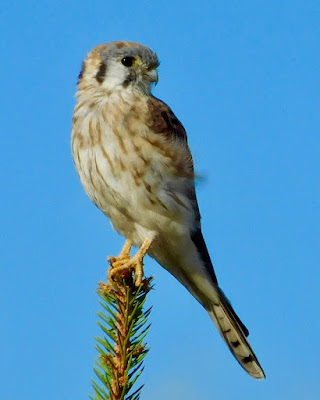 |
| The smallest and most widespread falcon |
 |
| A colorful raptor |
 |
| Scanning the grassland |
 |
| A ferocious predator |
 |
| A fearless matriarch |
 |
| The sparrow hawk |
 |
| A permanent resident |
 |
| Flourishing happily |
 |
| A courageous warrior |
 |
| Heart over height |
Bear Gulch - A Dragon's Den
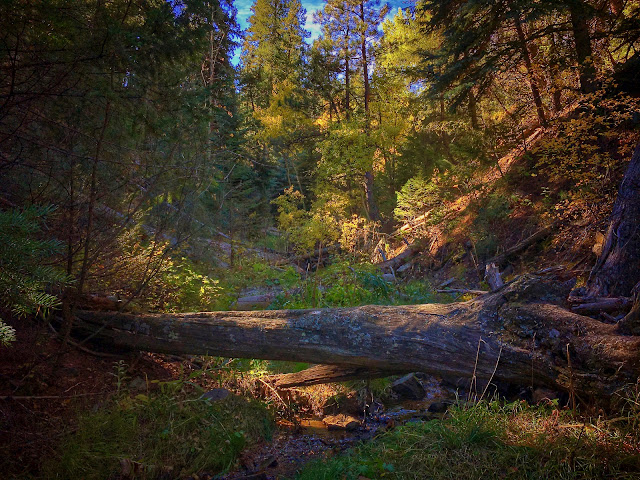 |
| Bear Gulch |
Bear Gulch is a steep ravine knifing through the forested foothills of Genesee Park, Colorado. Once you enter into the forbidding chasm, a rocky trail goes downhill all the way.
Upon leaving the land of brilliant light, this seedy underworld is thick with thorny brush and tangled trees. A murky creek cascades quietly through the secluded gorge.
Further in, the trek heads down a slippery slope where every step must be taken with extreme caution. A misstep at this position could result in a fall filled with painful repercussions.
At the soggy bottom, water falls over black boulders and broken logs. The sun’s rays barely make it to the base of the canyon but where they do, autumn bushes glow with yellow when set against the somber shadows.
Closed in by rock and mud, the narrow crevasse is cold and damp. You’re separated from the sky and sunny topland but there’s still a bright side to being stuck inside this complicated scenery.
The consolation garnered from descending so far into the dark depths of this smoldering dragon’s den - there’s nowhere else to go but up.
 |
| Forested foothills |
 |
| A seedy underworld |
 |
| A murky creek |
 |
| A slippery slope |
 |
| Water falls over black boulders |
 |
| A narrow crevasse |
 |
| The sunny topland |
 |
| Complicated scenery |
 |
| A smoldering dragon's den |
 |
| Nowhere else to go but up |
Butterflies and Bison - Beauty and the Beast
 |
| Painted Lady Butterflies |
During a sunny Saturday while searching for the elusive Genesee bison, a seemingly insignificant insect stole the show. In one day, we must have seen a thousand painted lady butterflies perched on purple thistle and yellow rabbitbrush.
The painted lady prefers the warmer climate associated with the desert southwest and Mexico but after an especially wet winter, they have migrated north en masse. During the hurried return south this fall, their population has exploded.
Fueled by favorable weather conditions and abundant food, they are churning across the American landscape like a cloud of orange smoke. This rare phenomenon is one of nature’s great spectacles, containing an air of mystery and unparalleled beauty.
As for the beasts, we found the buffalo grazing peacefully on a steep hillside near the forest’s edge. At one time, more than a million of these impressive animals roamed without hinderance across the vast Great Plains.
With their numbers greatly reduced, the bison are now confined to public preserves or private ranches. On the other hand, the painted ladies are currently prospering as they can cover 100 miles per day while traveling freely across the entire continent.
These small creatures look fragile but they’re actually quite resilient as the race across our rugged foothills at nearly 30 miles per hour. They don’t have much time to waste because their brief lifespan only lasts for about fourteen days.
During their short existence on this earth, the painted lady butterflies flutter about with a joyful enthusiasm. When contemplating the impending future, take your cue from these fun-loving insects and always try to live your life to the fullest.
 |
| The Genesee Bison |
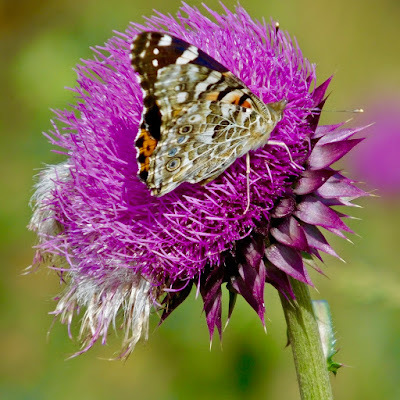 |
| Perched on a purple thistle |
 |
| They've migrated en masse |
 |
| The population has exploded |
 |
| Unparalleled beauty |
 |
| Grazing peacefully |
 |
| An impressive animal |
 |
| Painted ladies are prospering |
 |
| They travel freely |
 |
| They look fragile |
 |
| They're quite resilient |
 |
| They don't have time to waste |
 |
| A joyful enthusiasm |
 |
| Live life to the fullest |
Cub Creek Park - A Quaint Woodland
 |
| Cub Creek Park |
Drifting down out of Brook Forest, Cub Creek is a docile stream graced with a friendly disposition. Cut through a quaint woodland, the usually lively stream has been constrained to a trickle this time of year.
Sitting still in the crook of a wide s-curve, the shallow ravine is more like a reflecting pool than a restless torrent. The smooth pond of clear water mirrors the local arrangement with surprising clarity.
A discreet canyon covered with towering pine and spruce encompasses the winding waterway. While wandering along the wide rim, the setting sun's warm rays penetrate the forest's dark interior.
The quiet countryside is suffused with peaceful solitude so it's the perfect place to escape from a chaotic life. Adding to the ambiance, a solitary mule deer has secured a secluded break in the hillside where he grazes with a purpose.
Wishing this belt of paradise would never end, the excursion concludes at the tributary's terminus where it joins Bear Creek just above town. I'm already looking forward to a return to this wilderness where next time maybe I'll get lost and never be found.
 |
| A quaint woodland |
 |
| A reflecting pool |
 |
| Towering spruce and pine |
 |
| A discreet canyon |
 |
| The setting sun |
 |
| A quiet countryside |
 |
| Mule deer |
 |
| I could get lost here |
Founders Trail - A Gradual Transition
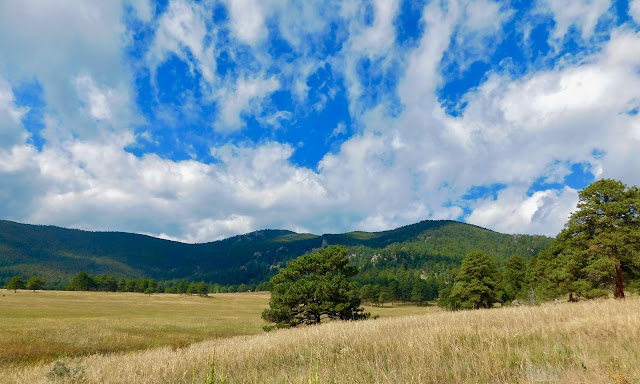 |
| Dispersing clouds over Bergen Peak |
On an early morning in Colorado's Front Range foothills, Founders Trail was blurred in a haze of smokey fog. Dawn broke dark and cold because the sun's warm rays struggled to reach the earth's shrouded surface.
As the day progressed, a west wind was funneled through the pass, dispersing the clouds into tufts of transparent mist. The bleak atmosphere was fractured and translucent beams created a curious pattern of dark and light across the orange meadow.
With the low-lying areas swept clean, only the mountains were embroiled in a tussle with overcast weather. Big peaks braced for action as they pierced the gray blanket while crowning a landscape reminiscent of the Lord of the Rings.
Look closely and you'll see that Mother Nature is making slight changes that are fueled by the rhythm of shifting seasons. Autumn is approaching just as gradually as the last storm that has now receded.
About the same time that the cyan sky broke clear, bluebirds and butterflies appeared en masse during their remarkable migration. As far as the winged travelers are concerned, it's a worrisome transition - I hope they make it home safely.
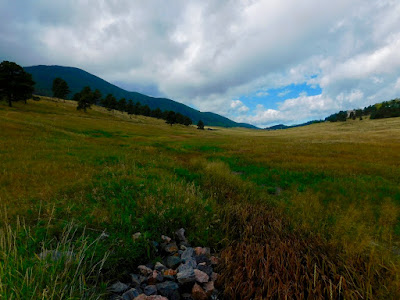 |
| Dawn broke dark and cold |
 |
| Wind was funneled through the pass |
 |
| The clouds were dispersed |
 |
| Curious patterns of dark and light |
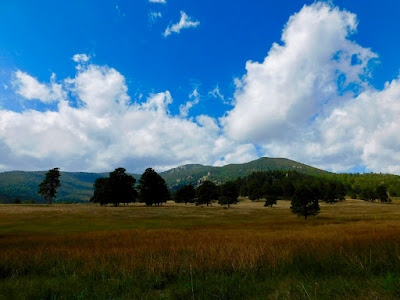 |
| An orange meadow |
 |
| A Lord of the Rings landscape |
 |
| Shifting seasons |
 |
| Autumn is approaching gradually |
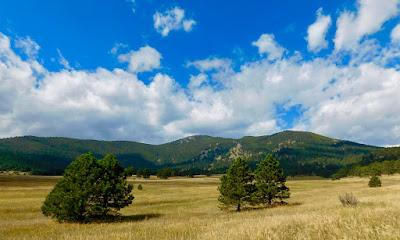 |
| A cyan sky broke clear |
 |
| Bluebirds |
 |
| and butterflies |
Pass Lakes - A Picture of Perfection
 |
| Pass Lakes, Colorado |
The ascent begins in the foothills and gradually transforms into an alpine environment where only the strong can survive. Ultimately, the wide open wilderness emerges from a dense woodland called Arapaho National Forest.
High on the Continental Divide, a trio of cobalt-colored lakes dot the tundra landscape. The shimmering, blue jewels are set in a spectacular, flower-filled basin just below the summit of Loveland Pass.
Taking place above tree line, a ring of purple peaks towers over the scenic cirque. Fixed boulders have cascaded onto the plain in a random arrangement, forming a nice foreground for a picture of Colorado perfection.
As beautiful as anywhere in the state, the convenient locale sits smack in the middle between bustling ski resorts. A persistent jaunt will lead you away from the pack and into a paradise of mountainous proportions.
After spending such a glorious day so close to the sun, it's hard to imagine that in a couple of months this place will be buried under deep snow. It's still summer in the lowlands but up here the cool air and swept grasses indicate that a drastic change is blowing in the wind.
 |
| Arapahoe National Forest |
 |
| Cobalt lakes dot the tundra landscape |
 |
| A flower-filled basin |
 |
| Just below Loveland Pass |
 |
| Purple peaks |
 |
| A scenic cirque |
 |
| A cascade of boulders |
 |
| Colorado perfection |
 |
| A beautiful locale |
 |
| Mountainous paradise |
 |
| Windswept grasses |
The Old Stone House - A Crumbling Reminder
 |
| The old, stone house |
Deep in the sandhills of western Nebraska, the old stone house is ruined. It's settled in a secluded valley, serving as a crumbling reminder of days gone by.
One can only imagine what it must have been like during its heyday. Maybe a peaceful retreat far from the bustle of city life as the nearest town was across the river bridge some ten miles away.
It was probably a difficult life dominated by the region's circulation of seasonal weather patterns. The summer sun was searing and the winter storms were brutal.
Raising cattle was the only way to make a living with lush prairie grasses supplying the perfect subsistence for the grazing herd. A deep well was dug and capped with a windmill that poured precious water into a rock-hewn tank.
Wooden planks and posts are scattered across the yard, indicating where the horses were once corralled. Out back in a ravine filled with purple wildflowers, a now rusted pickup would have been a more modern mode of transportation.
There's not another living soul in sight but the dilapidated homestead is haunted by more than just ghosts. Real-life creatures that have learned how to survive in the high plains are still thriving.
The eerie cry of coyotes, echoes through the canyon and prairie rattlesnakes wind their way through spiked yucca. The white-tailed deer moves cautiously through a dry creek while a gray jackrabbit leaves you in his dust.
The mountains are where I like to be but it's always nice to get back home because here, the world's a simpler place. At the end of the day, it’s fitting to watch as that humble box turtle so eloquently expresses this land's slower pace of life.
 |
| Deep in the sandhills |
 |
| The old, stone house is ruined |
 |
| Settled in a secluded valley |
 |
| A crumbling reminder |
 |
| A broken windmill |
 |
| Horses were corralled here |
 |
| A rusted pickup truck |
 |
| A dilapidated homestead |
 |
| Snakes wind through the yucca |
A Talk with the Woods - Learn How to Listen
 |
| A Talk with the Woods |
“Go sit under a tree and listen and think.” ~ Walt Whitman
This week's post is written by my uncle, Jerry Covault. Jerry is a retired United States Forest Service Ranger. During his 33 years spent working on National Forests in Oregon, Colorado, Wyoming and Montana, he has learned about the relationships between mountains, forests, soils, weather, fire, animals and people.
Jerry shares some of his unique experiences in his new book "About Forests and People". He resolves to stimulate interest and curiosity about trees and forests and how people use them both through the ages and at present time. Jerry also discusses the problems our forests and environment have today and he suggests a few things that can help.
The following essay by Jerry Covault is taken from his book "About Forests and People".
A Talk with the Woods
Fragment: From the Alfoxden Notebook (I)
And never for each other shall we feel
As we may feel, till we have sympathy
With nature in her forms inanimate,
With objects such as have no power to hold
Articulate language. In all forms of things
There is a mind
~ William Wordsworth
The forests’ brilliant colors, spring wildflowers of many kind, is how urgency looks. There’s growing to do! And only a short time to do it. Every plant, from the tallest tree to the smallest forb has to gather “food” and energy to itself and convert that into leaves, stem, roots and flowers. Each flower competes with every other flower in the neighborhood to attract a bee, a wasp, or other bug or breeze to do the pollination so a seed can grow. The motivation for all this activity is nothing less than the life for the individual and perpetuation of the species. That is purposeful action.
But, I’m here in the fall, the season of intensity is over for what we people call “this year”. The growing during the intense season is done, the flowers have done their job, or not. The grass has turned brown, the leaves of the mountain maple and the nine-bark are red, the pine needles are getting a deeper green and the larch needles are beginning to turn yellow, soon they will fall away. On this day the woods are very quiet, here-and-there is the skeleton of a gentian, spring beauty, balsamroot, or any other plant that was green a few weeks earlier. The seeds they produced are tucked into the small spaces between fallen pine needles, grass stems, shallow roots and bodies of insects that made their living eating such stuff. It’s a quiet time. And the woods will tell you that, -- if you listen.
“Listen?” “Listen to what?” “Trees and forbs can’t talk.”
True. But, there is tremendous pleasure in listening, feeling, seeking what the poets know about nature. For millennia those special people have talked about a “consciousness” that exists throughout nature.
“Consciousness?” “What’s that about?”
Start with us, we are conscious beings, that is, we are aware of ourselves and what’s going on around us, and, we have a subconscious somewhere deep within us. If we listen, that subconscious can guide us, more or less, to our own good. It lets us know what we should do and it may provide premonitions. Also, we people have a big, powerful, “what’s happen’en and what to do now” brain that can, and often does, override our subconscious mind. All this is pretty much common knowledge (wives tales) that is now being backed up by the scientists studying the human brain, mind and behavior.
Let’s take that “consciousness” thing into the forest. Every individual there performs certain actions at certain times to perpetuate its individual life and its species. That would seem to qualify as a consciousness, even if there is no big powerful brain to override it (as far as we know). The poets “feel” that consciousness in nature, and so do a lot of non-poets. American Indian stories are about people being “plugged into the natural world” and so are the stories of other cultures. With the fall of a waring and cruel Assyrian king, (700 BCE) the prophet Isaiah wrote about the earth’s reaction saying, “The whole earth is at rest, and is quiet: they break forth into singing. Yea the fir trees rejoice at thee, and the cedars of Lebanon, saying, Since thou art laid down, no feller is come up against us” (Isaiah 14: 7 and 8).
War takes a huge toll on forests, Isaiah is making it clear that forests have a consciousness and awareness of abuse.
Try this. Go to a natural place, leave your troubles, leave economics (not the national debt stuff, the “I want --” stuff - whether it’s catching a fish today, or getting rich), leave science, leave political stuff, leave religion in the rig. Get out and walk on the land -- mountain, plain, forest, grassland, wherever, with your mind like a clean erased blackboard. Be in the now. Really see beauty and feel what there is to feel, let nature write on your blackboard. Sense what’s going on in this place, how it’s doing. What is right and good for this place will start to seep into your mind. You’re becoming aware of the consciousness of that place. The sense of urgency in spring, the sense of quietness in fall, a sense of deep concern when there are threats (fire, disease, human impact), or, if the ecosystem is ill. This is the place’s consciousness.
OK, that sounds like knowing the science of nature, and it is, but science is about collecting and analyzing data to draw conclusions. This is different, if you walk quietly and let awareness rather than facts seep in, that awareness is about the place’s consciousness, that place’s capabilities, purpose, health and susceptibility.
So what? Will all that make anyone any money? Will it help write a paper that will be accepted in a peer reviewed scientific journal?
Probably not. But, it’s a tool that we have never tried to used. We make decisions concerning using natural resources based on economics, laws (influenced by economics), political power (influenced by economics), and (hopefully) science. By now we should be figuring out that there is another player in this equation, NATURE. We need to be consulting nature. What we’ve been doing is like the health insurance company and the doctor deciding to operate without ever consulting the patient. Seeking nature’s consciousness is outside science, outside economics, outside politics, outside man-made laws, and we don’t know how to determine what it is or how to take it seriously in our decision making. We need to learn. We’re facing some big questions that could use some insight - and input - from Nature.
Should we genetically alter animals to grow more food? Have we done right by genetically altering plants to produce more insecticides within their bodies, or resist certain herbicides? Should we be deep drilling for oil in the oceans? Are we right to bring back wolves? If so, where? What do the elk think about that (what’s their consciousness)? What do the aspen forests think about wolves? How many people can our Earth support? At what life style? Global Warming - human caused or not - is telling us something. How can we listen beyond science and economics? How can we use what we and nature “feel” in decision making? How can we use what the poets have been telling us? You can fill in other big questions, and small ones.
Understanding Nature’s consciousness can be the next big tool to help people live better with one another and with our home, Earth. That kind of knowing is beyond science and it is not the pure faith that religion requires. It is an area of knowledge we haven’t developed the tools to investigate, we need to get to work on it, because this Earth is talking to us.
The Tables Turned
Come forth into the light of things,
Let Nature be your Teacher.
She has a world of ready wealth,
Our minds ands hearts to bless --
Spontaneous wisdom breathed by health,
Truth breathed by cheerfulness.
One impulse from a vernal wood
May teach you more of man,
Of moral evil and of good,
Than all the sages can.
~ William Wordsworth
There is a real good chance all this will illicit the response, “This is just nuts.” “This would cost us money.” OK, -- Assume that NATURE has no consciousness, no purpose, and we will just forget the whole thing and keep doing things the way we’ve always done them. But, WHOA, do we really think that’s working all that well? Will the way we’re doing things sustain the Earth and us people for the next 400 generations, 10,000 years, and help us to live in harmony with each other and nature? Our present performance isn’t that reassuring.
It’s clear, if we will listen, Nature is not without its own purpose - not without “being” (as in “to have or to be”) - and, she has a lot to say. We can benefit by learning how to listen.
The Logos is Eternal
One must talk about everything according to its nature,
how it comes to be and how it grows.
Men have talked about the world without paying attention
to the world or to their own minds,
as if they were asleep or absent-minded
~ Herakleitos (5th century B.C.)
If you're interested in exploring more about the relationship between people and our forests, please check out this link: About Forests and People
 |
| Trees and forbs can't talk |
 |
| Do trees have a conscience? |
 |
| Go to a natural place |
 |
| Go out and walk on the land |
 |
| Walk quietly |
 |
| Understanding nature |
 |
| Let nature be your teacher |
 |
| Live in harmony with nature |
 |
| Nature has a lot to say |
The Old Stump, Elk Ridge - Colored Pencil Drawing
 |
| "The Old Stump, Elk Ridge" Colored Pencil |
The morning after a spring storm, Elk Ridge is buried under a blanket of fresh snow. Irregular shapes undulate across the drift's smooth surface as blue shadows exaggerate the billowy folds in the landscape's white tapestry.
Scattered across the high ground, a few resilient evergreens call this hostile place home. The subalpine zone is a harsh environment where few organisms are adapted to survive.
A single cloud, floating just above the horizon, is a last remnant of the passing storm. The sun's warm rays stream through the brilliant, blue sky inspiring hope that better days lay ahead.
Twisted by ferocious winds, the old stump is a weather-beaten warrior that fought until the bitter end. The bare tree trunk symbolizing the strength and perseverance required to survive at such a high altitude.
A fantastic Englemann Spruce forms a dark halo around the poor tree snag. In the background, smaller spruce are a new generation eager to fill their role in this extraordinary ecosystem.
As these long-lived conifers reach maturity, their individual traits imbue each of them with a unique personality. Their will to survive and perpetuate the species seems almost superhuman.
Do trees have a conscience, a spirit or soul? I don't know but if we take the time to listen, I believe the forest speaks to us in ways that we can comprehend.
Their verbal testimony, though, would be of priceless value to anyone investigating nature's great, unsolved mysteries. If only trees could talk.
Mule Deer Buck - The Crown Prince
 |
| Mule Deer Buck |
While hiking up Elk Ridge on a blue, summer evening, the mountainside is drenched and surprisingly cold. Colorful wildflowers hug close to the muddy trail as the crackle of rolling thunder echoes from down in the meadow below.
Around the bend, occupying a nook in the forest, a young mule deer buck grazes on shoots of lush grass. His orange coat is glistening wet from the downpour of steady rain that seems to develop every afternoon.
If the bull elk is the undisputed monarch of the Rocky Mountains then the mule deer buck is the crown prince. This time of year, these regal animals are bestowed with an extraordinary rack of velvet antlers.
He moves gracefully across the rugged terrain that characterizes the Front Range foothills. The elegant creature seems undisturbed by my presence as he’s become accustomed to sharing his territory with our strange kind.
The new weather pattern tells us that the seasons are changing so this lone deer is feeding with a purpose. He’s going to need all the strength he can muster because the annual rut is just around the corner and soon after that - another harsh winter.
 |
| A blue, summer evening |
 |
| Thunder echoes across the meadow |
 |
| Grazing on lush grass |
 |
| The crown prince |
 |
| Extraordinary antlers |
 |
| They move gracefully |
 |
| Undisturbed by my presence |
 |
| Seasons are changing |
The Pacific Ocean - A Peaceful Sea
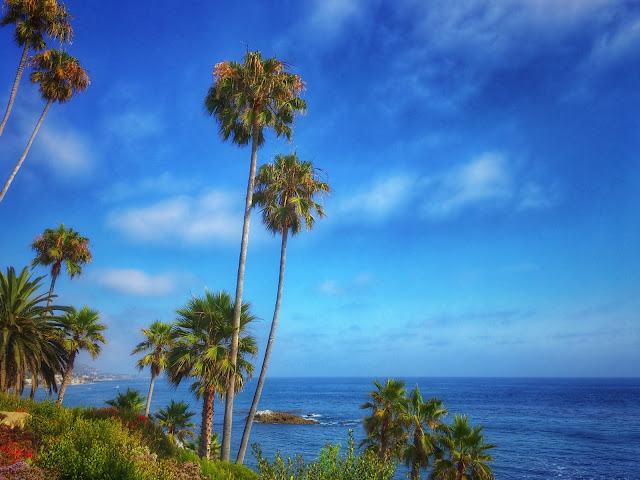 |
| Palm trees on the Pacific |
Our blue planet is dominated by the five great seas from which the Pacific is the biggest, deepest and most inhabited. The vast ocean fills the gap between the Americas on the east and Asia and Australia on the west.
The massive body of salt water is an astonishing 64 million square miles and it's spread across one-third of the earth's surface. In the northwest section there's an incredible chasm known as the Mariana Trench. At 35,797 feet down, it's the deepest point in the world.
The ocean's current name was given by Portuguese explorer Ferdinand Magellan during the Spanish circumnavigation of the globe in 1521. He called it Mar Pacifico or the Peaceful Sea because after sailing around the treacherous Cape Horn, the expedition entered into much calmer waters.
The place is hardly peaceful, though. Enclosing the ocean, the volatile land that forms the Pacific Rim is known as the Ring of Fire because of all the volcanos and earthquakes. Tsunamis born from underwater earthquakes have taken a devastating toll on countless inhabited islands.
I've only experienced the Pacific while in southern California where a blue-green surf smashes into the rocks and cliffs, sculpting a coastline of unsurpassed beauty. The exotic foliage of palm trees and colorful wildflowers enlivens the laid back atmosphere.
Since the very beginning, powerful waves have pounded the land in a therapeutic rhythm while shaping the malleable earth. Today, eternal waters continue to churn with relentless force in a graceful sequence sure to last until the end of time.
 |
| The biggest, deepest and most inhabited |
 |
| Mar Pacifico |
 |
| The peaceful sea |
 |
| Hardly peaceful |
 |
| Southern California coastline |
 |
| Unsurpassed beauty |
 |
| Exotic palm trees |
 |
| Colorful flowers |
 |
| Powerful waves |
 |
| The waters continue to churn |
 |
| Until the end of time |
Broad-tailed Hummingbird - An Energetic Visitor
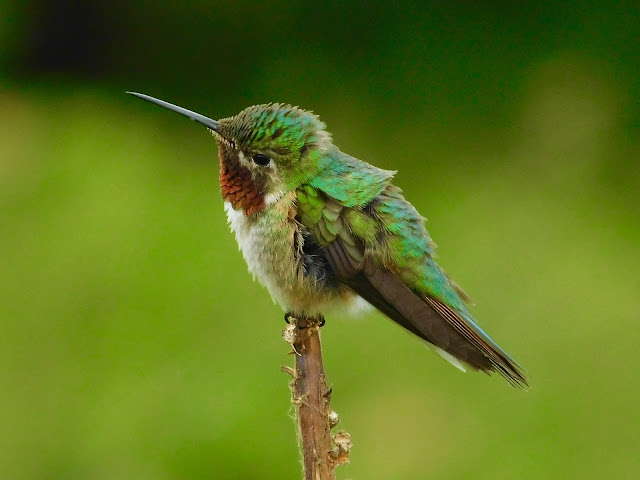 |
| Broad-tailed Hummingbird |
Rocky Mountain summers are distinguished by warmer temps, colorful wildflowers and the metallic trill of thin air whistling through the wings of tiny migrants. Zooming through our high meadows, the broad-tailed hummingbird is an energetic visitor.
Bursting onto the scene around May, they arrive from their sun-drenched homeland situated south of the border. These hearty birds have developed a unique characteristic that allows them to survive the harsh conditions present at such a high altitude.
Broad-tailed hummingbirds save enough energy to survive the bitterly cold nights by lowering their internal thermostat, becoming hypothermic. This reduced physiological state is an evolutionary adaptation that is referred to as torpor.
Torpor is a type of deep sleep where a bird's heart rate drops, breathing slows and its metabolic rate lowers by as much as 95%. By doing so, a torpid hummingbird can save up to 60% of its available energy as opposed to when it's awake.
Their diminutive nature is complimented by an elegant palette of iridescent colors that sparkle in bright sunlight. Adult males are described by a dazzling ruby-red throat, green crown and back and white underparts with green flanks.
The females are single parents burdened with the domestic tasks of nest building, incubating the eggs and feeding the brood. The promiscuous males flit about on a quest for the foothill's sweetest nectar while defending their territory with considerable zeal.
These little dynamos perform an impressive array of arial maneuvers when hunting for spiders, small insects and sugar water feeders. Propelled by powerful muscles and a limber shoulder joint, they can flap their wings at an astonishing 50 beats per minute.
By late August these forest jewels begin making their way back to the Mexican highlands where they will spend the winter. Their sudden disappearance is a sure sign of changing seasons and the start of a new school year.
 |
| An energetic visitor |
 |
| Bursting onto the scene |
 |
| Hearty birds |
 |
| A diminutive nature |
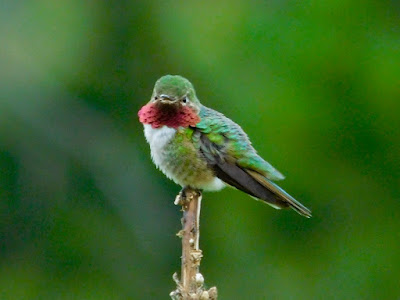 |
| Colors that sparkle |
 |
| A little dynamo |
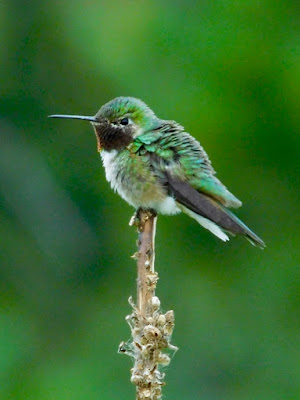 |
| A forest jewel |
Sneffels Range Spring - Watercolor
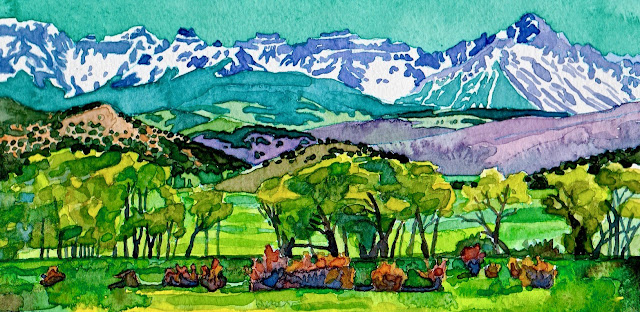 |
| "Sneffels Range Spring" Watercolor |
Tucked discretely below the Dallas Divide, the Sneffels is a scenic sub-range of the San Juan Mountains. The confusion of untidy crags is a rugged remnant of an ancient volcano. It's late spring but bare rock is beginning to emerge from a shroud of heavy, winter snow.
A row of crooked cottonwoods is an elaborate gateway into the Colorado wild. Patches of delicate dandelions are scattered throughout the lush meadow while an assembly of blazing brush complicates an already busy foreground.
As a gray sky drizzles the landscape with cold rain, receding into the distance, colors cool from violet to blue-green. A series of spectacular buttes is a scenic prelude to an awesome alpine environment where cautious strokes define the ragged peaks.
Composed from equal parts image, experience and memory, this painting was not meant to hang on a wall. It's more of a sketch than a showpiece. A little bit looser and fabricated with less concern, sometimes a simple study is more satisfactory than the final, finished work.
Goliath Peak - A Fighting Spirit
 |
| Mount Evans Wilderness |
Goliath Peak is a steep warmup to the withering heights encompassing the Mount Evans Wilderness. You receive a warm welcome as a carpet of colorful wildflowers is unfurled all the way to the top.
Stretching out in every direction, the distant views reach farther than even your wildest imagination. To the west, ice cold water in a glacier-filled cirque is ensnared by peaks of silver stone.
Even during the summer, white snow is slashed across the spectacular backdrop of surreal mountains. In the sky, milky clouds filter the sun, creating a moody atmosphere charged by the constantly changing stream of light.
Unfortunately, a perfect day was damaged by a heart-fluttering event. The Herculean effort may have induced an episode of mind-numbing paralysis that luckily spared my fighting spirit and eternally grateful soul.
 |
| Goliath Peak |
 |
| A steep warmup |
 |
| A warm welcome |
 |
| A carpet of wildflowers |
 |
| Distant Views |
 |
| Your wildest imagination |
 |
| A glacier-filled cirque |
 |
| Silver peaks |
 |
| A spectacular backdrop |
 |
| A moody atmosphere |
 |
| A fighting spirit |
Little Bighorn Battlefield - Part III
 |
| General Custer fell here |
After destroying Custer's entire battalion, the warriors raced south across the ridges to engage the last remnant of the Seventh Cavalry. Lying flat on the ground, the soldiers formed a perimeter of defense around a natural depression scooped out of the summit of their hilltop refuge.
They managed to hold off a determined siege throughout the evening and into the darkness. Many of the spooked men recalled how down in the Indian village there was a celebration of dancing and singing that lasted all night.
Desperate cries from captured soldiers who were being tortured below filtered eerily through the hills. Troopers who chose to hide in the timber rather than retreat, somehow worked their way back up to the relative safety of rejoining their comrades.
By first light the next morning, the conflict resumed and the remaining 300 or so soldiers continued to hold the high ground. Incredibly, a group of volunteers even snuck down a steep ravine all the way to the river, filled canteens and brought water back to the wounded.
The intensity of the battle gradually diminished throughout the day and by the evening of June 26th, the Indian camp had broke and scattered. The next morning army reinforcements arrived from the north, rescuing the beleaguered battalion.
Retracing the steps of their doomed brethren, the surviving soldiers were shocked to discover the tragic fate of Custer's command. After such a disheartening event, the demoralized men were anxious to get back home.
Before they could leave the field though, the gruesome task of burying the dead still had to be done. On June 28th they hastily dug shallow graves and covered the remains with loose dirt and sagebrush.
All of the mounded sites were punctuated with a stake, indicating where the fallen were found. In order to show where the officers lay, their names were written on a slip of paper, rolled up, placed in an empty cartridge shell and pounded into the top of the wooden marker.
In July of 1877, Lieutenant Colonel Michael Sheridan led a column of men charged with retrieving the officers remains from the battlefield. They made a careful survey of the area, reinterred exposed remains and marked the well-packed graves with cedar stakes.
The bones of Custer, 11 officers and 2 civilians were exhumed, placed in coffins and then transferred to eastern cemeteries. Over the next couple of years rainstorms, erosion and scavengers continued to scatter the remains across the hillside.
In 1879 Captain George Sanderson led a unit to the field and placed all exposed human remains in a grave dug on top of Last Stand Hill. A four foot cordwood monument was built over the mound and all the horse bones were placed in its center, creating the first monument.
Replacing that cordwood structure, a permanent granite monument was erected in 1881 by First Lieutenant Charles Roe. All of the soldiers remains were gathered and placed in a mass grave built around the base of the new monument.
Throughout the continued process of burials and reburials, whenever the remains of a man were found, a stake was planted so that future visitors could see where that man actually fell. Finally in 1890, Captain Owen Sweet arrived on the scene and replaced all wooden stakes with the 249 white, marble markers you see today.
The conspicuous headstones are dotted throughout the battlefield like ghostly spirits sweeping across the confusing purgatory of northern plains. While wandering down into Deep Ravine, thunder warns the visitor - the Little Bighorn is about to become the dramatic setting for another approaching storm.
 |
| Custer's command was destroyed here |
 |
| Retracing their steps |
 |
| A disheartening event |
 |
| The first graves were covered with dirt and sagebrush |
 |
| Remains were scattered years after the battle |
 |
| The granite monument was erected in 1881 |
 |
| Marble markers show where the men fell |
 |
| Ghostly spirits |
 |
| Wandering down into Deep Ravine |
Little Bighorn Battlefield - Part II
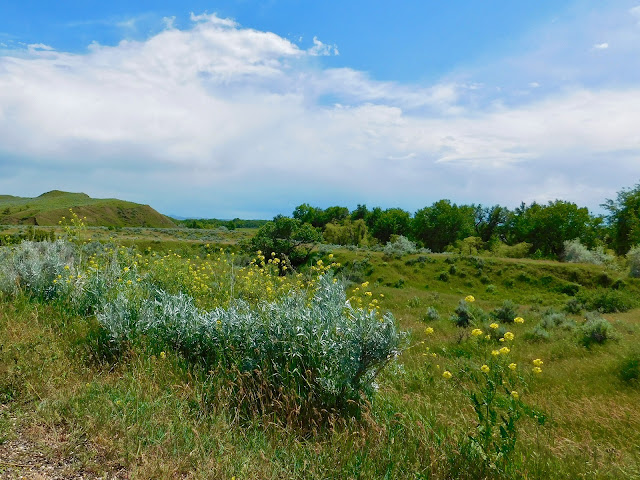 |
| Medicine Tail Coulee Ford |
What happened to General Custer after he separated from Major Reno is one of the great mysteries of the American West. Because there were no survivors from Custer's battalion, the truth will forever elude historians, fanning the flames of controversy that are sparked by the multitude of differing theories.
A wealth of information can be gathered from Native American oral history as circulated by the battle's victorious participants, documents containing eyewitness testimony from soldiers who surveyed the battlefield's aftermath and recent archaeological discoveries.
By combining the evidence from these three sources, we can get a pretty good feel for what happened concerning Custer's strategy, movement and ultimate demise. The following is how I believe the events of that fateful day may have transpired.
While Reno and his men were being chased back to high ground, Custer was dividing his battalion into two wings. Companies C, I and L stayed in the hills to the right while E and F began an offensive maneuver to the left.
Mounted on their magnificent gray horses, Company E led the left wing down a dry creek bed. Appearing like apparitions out of the mist, they attempted to cross the river at the mouth of Medicine Tail Coulee.
Being a gateway to the Indian's camp, the ford was defended fiercely by a small band of brave warriors. Using repeating rifles, the Indians rained bullets at the incoming threat, forcing the white soldiers to ascend back into the eastern bluffs.
The left wing reunited briefly with the right wing atop Calhoun Hill. With Companies I and C held in reserve, Company L deployed in a skirmish line and the engagement continued with light, long-range volleys exchanged between the two sides.
Custer, still on the offensive, descended from the smooth ridge and tried to ford the river north of the encampment but he was stopped again. As they returned, Company E spread out across a shallow ravine and fired at hostiles creeping up the western flats while Company F gravitated into the basin above.
Most of the Indians that had fought Reno arrived on the scene as the hills became saturated with angry warriors hidden in the gullies and ravines. After Lame White Man's aggressive charge from Greasy Grass Ridge, the clash escalated quickly.
Chiefs Gall and Crazy Horse took advantage of the ensuing chaos and led their followers as they decimated the troops retreating from Calhoun Hill. Most of the horses were killed or scattered so the soldiers fell back on foot across Battle Ridge in an attempt to link up with Custer and the left wing.
Finishing off the frightened, fleeing soldiers was easy pickings for the Indians because it was just like hunting buffalo on the run. Many of the inexperienced, young soldiers became panicked so all tactical cohesion was lost and the rout was on.
Meanwhile at the other end of Battle Ridge, Company E's line was destroyed by the 'Suicide Boys' who also stampeded the conspicuous gray horses. Custer's Headquarters Staff moved up the slope where they were joined by a few surviving refugees from the right wing.
Just below the summit of Custer Hill, about 40 soldiers from the Seventh Cavalry put down their mounts forming a horse-flesh barricade and made their desperate last stand. The men were completely surrounded as arrows sprayed into the center of their precarious position.
Eventually as the soldiers began to fall, the Indians initiated hand-to-hand combat and the tiny swatch of blue coats was completely overwhelmed. At the end, about 15 men tried to make a run for cover by sprinting towards the river but none of them escaped.
Once the last of the troopers were cut down, the process of ritualistic mutilation began. Most of the dead were stripped naked and their bodies mutilated because the Indians believed if they crippled the soldiers' bodies on earth, the soldiers wouldn't be able to harm them in the afterlife.
After they had defeated Custer, the warriors turned their attention back towards the secluded hilltop held by Reno and the recently arrived Captain Benteen. With seven companies dug in and holding the high ground, the soldiers prepared to ward off an impending attack.
 |
| What happened to Custer is a mystery |
 |
| Custer was in the hills during Reno's charge |
 |
| Custer tried to ford the river here |
 |
| A gateway to the Indian camp |
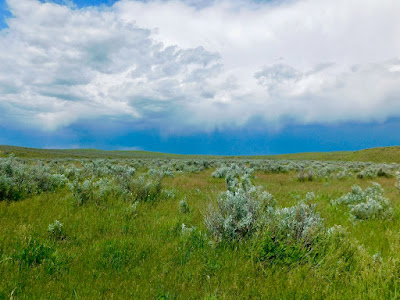 |
| Troops ascended this coulee to Calhoun Hill |
 |
| Warriors crept up these gullies and ravines |
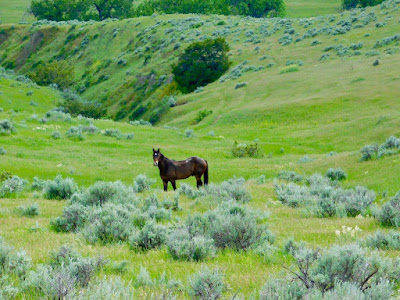 |
| Most of the horses were stampeded or killed |
 |
| At the end, soldiers dashed for this ravine |
 |
| Reno's troops dug into this secluded hilltop |
Little Bighorn Battlefield - Part I
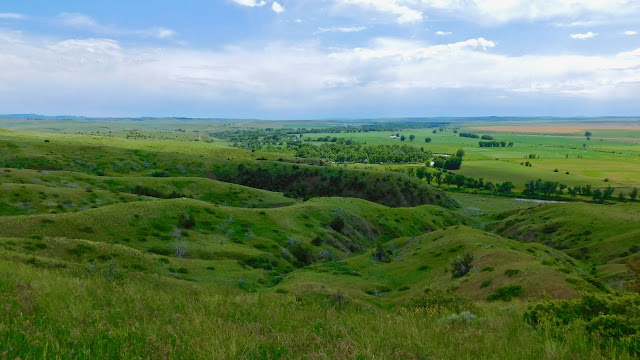 |
| The Little Bighorn River Valley |
Located in south central Montana, the Little Bighorn Battlefield is a remarkable monument preserving a fascinating piece of American History. Here, General Custer and his battalion of 210 soldiers were massacred by a combined fighting force of Lakota and Cheyenne warriors.
What makes this memorial so unique is the scattering of marble markers that pinpoint the exact location of where each of the soldiers were killed. The white headstones' seemingly random arrangement betrays the sobering story they have to tell.
Upon approaching the Little Bighorn in early June, the spectacular scenery is as beautiful as any place on earth. Tall, green grass is windswept across the vast prairie of rolling hills that at one time supported thousands of buffalo.
Upon reaching the river valley, the terrain becomes more rugged as high bluffs to the east are broken by deep ravines and wide coulees. The serpentine-shaped thread of silver water is narrow, cold and deep.
Indians called it the Greasy Grass and this is where they were camped on June 25th, 1876. Custer was ordered to bring in the hostiles and he found them here, resting in the shade of lovely cottonwoods.
Despite the federal government's mandate to confine Native Americans to reservations, the Lakota and Northern Cheyenne had remained defiant, refusing to give up their independence and nomadic way of life.
The Black Hills was their homeland and it was promised to be theirs forever by the Fort Laramie Treaty of 1868. After the Civil War, westward expansion escalated as settlers, trappers and fortune seekers illegally desecrated the Indian's sacred hunting grounds.
As it appeared that conflict was inevitable, the northern tribes united under their spiritual leader Sitting Bull and military leaders Crazy Horse and Gall. Their paradise on the high plains was something worth fighting for.
On that hot, summer morning, the Seventh Cavalry under Lieutenant Colonel George Armstrong Custer rode down into the valley from the southeast. Custer divided his regiment of nearly 700 men into three battalions as he expected the Indians to scatter and run.
Captain Frederick Benteen took three companies and swung northwest to scout for stragglers and prevent escape in that direction. Major Marcus Reno was given three companies and ordered to charge due north into the south end of the camp.
Custer took five companies and headed northeast into the hills above. He was hoping to circle around to the opposite end of the camp, cross the river and attack in a pincer movement.
Reno's aggression provoked an unexpected force of 2,000 well-armed warriors. The Indians repulsed the initial attack and sent the terror-stricken bluecoats scurrying for cover in the nearby timber.
Amidst the chaos and confusion of the onslaught, Reno initiated a disorganized retreat across the river and up onto a high bluff. The shell-shocked troopers dug in and began a fight for their lives but where in the hell was Custer?
To be continued...
 |
| A remarkable monument |
 |
| Spectacular scenery |
 |
| A vast prairie |
 |
| Lovely cottonwoods on the Greasy Grass |
 |
| Conflict was inevitable |
 |
| Paradise on the high plains |
 |
| The Seventh Cavalry rode in from the southeast |
 |
| Reno charged north down the valley |
 |
| Where was Custer? |
Red Rocks Park - Happy Days
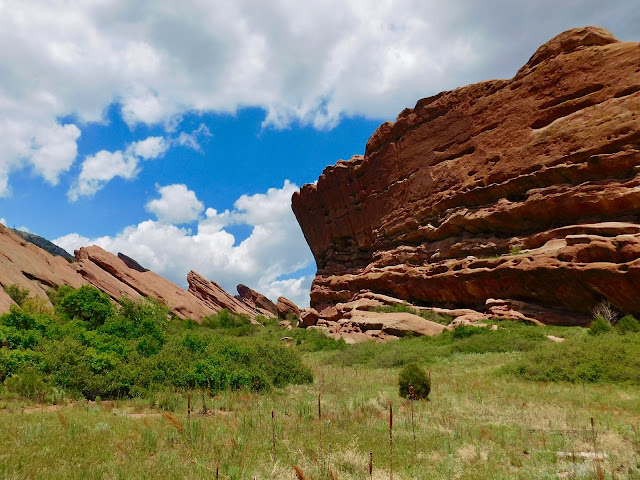 |
| Red Rocks Park, Colorado |
Up out of Mount Vernon Creek in the steep foothills west of Denver, an extraordinary arrangement of red rocks has shattered the western skyline. A network of dirt paths and sheer stairways are woven through the bustling venue.
Taking center stage in this natural backdrop is the unique amphitheater that hosts world-class performances by musical artists. The place is always warm during a summer dayhike while weekend shows heat up the night.
Looping around an ancient garden of sandstone, the Trading Post Trail is a favorite as it features lively songbirds above and yellow snakes below. Here, the park's colorful cliffs contrast sharply with the fresh, green foliage.
Down on the Dinosaur Ridge, seasons have changed but up in the high country there's still lots of snow. This time of year, the semi-arid environment that describes this region is the perfect place for a solitary sojourn.
After surviving a dark winter and a difficult spring, the longer light and fragrant wildflowers fill the air with a sense of guarded optimism. It’s been just a few weeks of subdued patience but now it appears as though happy days are here again.
 |
| Mount Vernon Creek |
 |
| An extraordinary arrangement of red rocks |
 |
| A summer dayhike |
 |
| Trading Post Trail |
 |
| Spotted Towhee |
 |
| Yellow bull snake |
 |
| Colorful cliffs |
 |
| Green foliage |
 |
| Seasons have changed |
 |
| A solitary sojourn |
 |
| Fragrant wildflowers |
 |
| Happy days are here |
Gore Range Sketch - Colored Pencil Drawing
 |
| "Gore Range Sketch" Colored Pencil |
It's summer in the high country and a blanket of wildflowers covers the steep slopes below Ute Pass. Looming over a slender valley, the Gore Range is composed from an array of incredibly jagged peaks.
Heaped on top of the purple mountains, deep snow still persists even until the end of June. Dark woodlands are curved hastily across the rolling foothills, creating a tapestry of verdant greens.
The beauty of Blue River Basin is an irresistible impression. Sketched quickly in plein air, this pencil drawing might sometime in the future provide the framework for creating a more finished piece of art.
Forest Edge - Colored Pencil Drawing
 |
| "Forest Edge" Colored Pencil |
It's an early Spring evening in the Front Range foothills as golden light streams through this quiet corridor. Waves of yellow grasses churn across the valley floor like a turbulent, yellow sea.
The shadows are violet and their strange shapes follow the contour of a rugged landscape. The centerpiece of the scenery is a pair of red bushes that inhabit this special domain.
The forest edge is a dark barrier of scattered pine trees set in the picture's background. Subtle shading helps define the individual forms while a few streaks of lemon break up the deepest greens.
A single Ponderosa seems to have captured the spotlight as it stretches vertically into a powder-blue sky. In the vast expanse a few clouds drift slowly out of the west with trail edges that disintegrate into the atmosphere.
Simplified shapes and exaggerated color are stippled onto the page in a pointillistic manner, recording an impression of a fleeting moment in time. This rendering may not be even remotely accurate but that's the way I see it.
Sneffels Range Spring - Acrylic
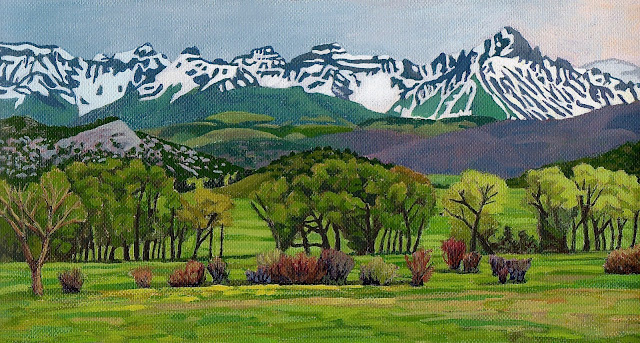 |
| "Sneffels Range Spring" Acrylic |
Tucked discretely below the Dallas Divide, the Sneffels is a scenic sub-range of the San Juan Mountains. The confusion of untidy crags is a rugged remnant of an ancient volcano. It's late spring but bare rock is beginning to emerge from a shroud of heavy, winter snow.
A row of crooked cottonwoods is an elaborate gateway into the Colorado wild. Patches of delicate dandelions are scattered throughout the lush meadow while an assembly of blazing brush complicates an already busy foreground.
As a gray sky drizzles the landscape with cold rain, receding into the distance, colors cool from violet to blue-green. A series of spectacular buttes is a scenic prelude to an awesome alpine environment where cautious strokes define the ragged peaks.
Composed from equal parts image, experience and memory, this painting was not meant to hang on a wall. It's more of a sketch than a showpiece. A little bit looser and fabricated with less concern, sometimes a simple study is more satisfactory than the final, finished work.
Elk Ridge - Scenic Splendor
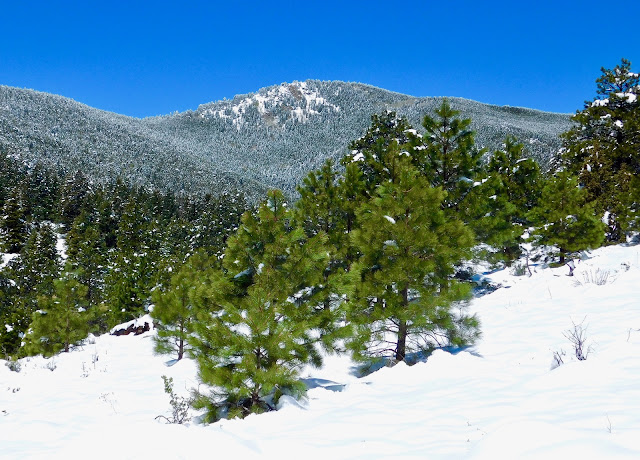 |
| Elk Ridge, Colorado |
The morning after a mid-May snowstorm, Elk Ridge is a pristine landscape rising above untouched territory. Breaking trail through drifts of deep snow impedes progress but on this day there is no rush to reach the top.
Frosted Bergen Peak looms over the white meadow where a grove of green aspen accentuates the scenic splendor. Blue shadows undulate across a frozen surface that blankets the rugged earth buried so far below.
While trudging along the edge of the dark woodland, tall pine trees release a deluge of icy snowmelt. Drenched from head to toe, the wanderer in this wilderness is bound to get wet and chilled to the bone.
By late afternoon, the warm sun has begun to release the foothills from the weakening grip of the season's last winter storm. Truly, it shouldn't come as a surprise because this unusual pattern has become an annual event.
It seems outrageous to be experiencing such inclement weather at this time but the snow will not last long. Believe it or not, in a couple of days you won't even be able to tell it snowed at all because it will have vanished into thin air.
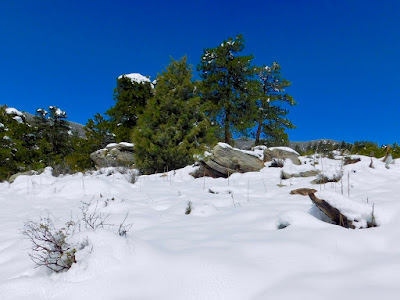 |
| A pristine landscape |
 |
| Deep snow |
 |
| Bergen Peak looms over the white meadow |
 |
| Blue shadows |
 |
| Along the edge of a dark woodland |
 |
| Tall pines release snowmelt |
 |
| Warm sun in the foothills |
 |
| An annual event |
Holladay Nature Preserve - Dreary Days
 |
| Wallace F Holladay Nature Preserve |
Occupying a rural greenbelt on the outskirts of Indianapolis, Holladay Nature Preserve features a diverse variety of trees and birdlife. Surrounded by a deciduous forest, a small pond is the sparkling centerpiece.
Continuous rainfall has cleansed the dense woodland, saturating the Spring landscape with a glossy sheen. During such a downpour, the brown creek rushes steadily through a rolling meadow.
In the field below a weathered, red barn and a broken-down silo, yellow flowers form a nice border. Nearby, the abundant foliage becomes a tangled mass that's tremendous in both height and width.
Despite being drenched during the remarkable deluge, resilient songbirds keep chirping with an infectious optimism. After a few, dreary days spent in the heartland of Indiana, it's nice to finally see the sun.
 |
| A diverse variety of trees |
 |
| A small pond is the centerpiece |
 |
| A cleansed woodland |
 |
| A Spring landscape |
 |
| A rolling meadow |
 |
| A red barn and a broken-down silo |
 |
| Abundant foliage |
 |
| Tremendous height and width |
 |
| It's nice to see the sun |
A Spring Storm - South Table Mountain
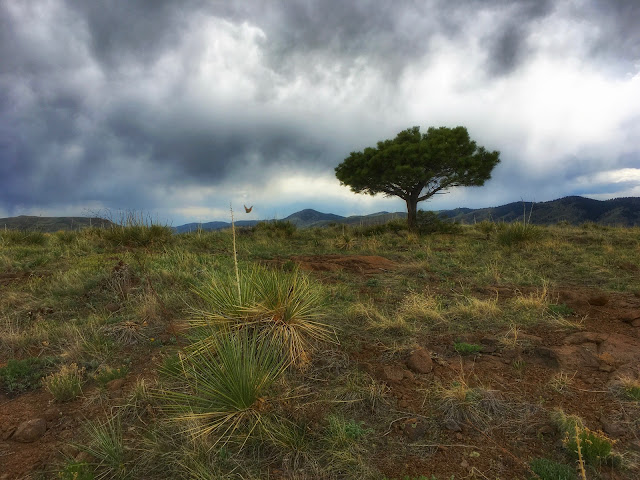 |
| South Table Mountain |
"You will bask in the sunlight one moment, be shattered on the rocks the next. What makes you a man is what you do when that storm comes." ~ Alexandre Dumas
The desolate landscape on top of South Table Mountain is a bleak outlook, troubled under a murky, Spring sky. On this great, windswept plateau, trees are scarce and the sting from abundant cactus is too painful to recount.
Dark skies unveil a curtain of cold rain that soaks all who dare to trespass on this depressing domain. The merciless breeze is a dogged companion that's unsympathetic to a yearning for more cheerful times.
The muddy road leading home is a lonely trek serenaded by the melancholy chorus of field crickets and meadow larks. Just like the turbulent weather experienced on this dismal day, life is a storm.
 |
| A desolate landscape |
 |
| A troubled sky |
 |
| Trees are scarce |
 |
| A painful sting |
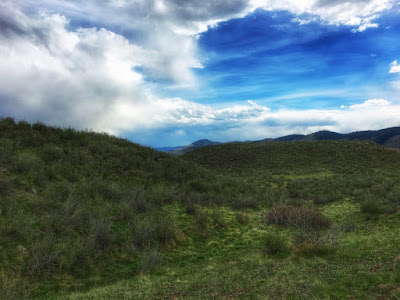 |
| Yearning for cheerful times |
 |
| A lonely trek |
 |
| Turbulent weather |
 |
| Life is a storm |
Warren Woods - A Fairytale Forest
 |
| Warren Woods, Indiana |
Situated in central Indiana, Warren Woods is a fairytale-like forest bursting with lush greenery and blue flowers. A little, brown creek flows peacefully through the heart of a deciduous bird dwelling.
An amazing variety of calls can be heard, sung by the canopy's unseen inhabitants. The noisy chatter is a bit comforting for the new visitor as the happy chorus permeates an eerie atmosphere.
Lingering gray skies are evidence of recent thunderstorms whose heavy rainfall has drenched the dark Woodland. The soggy trails are a flooded mess, splattering mud with every step.
Encamped in Eastern Territory for the first time, I'm inspired by the lovely landscape and all of the birds, trees and water. It’s a temperate climate with a humidity that’s as warm as a blanket.
After a few days exploring the flatlands, it’s time to leave. Upon our return to the high country West, we're welcomed by 15 inches of wet snow - it's great to be home.
 |
| A fairytale forest |
 |
| Lush greenery and blue flowers |
 |
| A little, brown creek |
 |
| An eerie atmosphere |
 |
| A dark woodland |
 |
| Birds, trees and water |
Colorado National Monument - Austere Beauty
 |
| Colorado National Monument |
Out in western Colorado, the steep, northern wall of the Uncompahgre Plateau falls away into the Grand Valley of the Colorado River. Erosion has shredded this leading edge of orange sandstone, designing a labyrinth of extraordinary canyons.
Wind, water, ice and an infinite amount of time have combined forces to create a natural sculpture garden in the high desert. From the lofty Grand View Overlook, the floor below is decorated with rock chimneys, arches, spires, towers and coke ovens.
Granted special status in 1911, Colorado National Monument preserves a unique piece of the American West and protects a surprising variety of wildlife. Desert bighorns, bobcats, coyotes, mountain lions, lizards, rattlesnakes and rock wrens are a few of the species who call this place home.
During an evening hike on the heels of a passing Spring storm, beams of soft light come streaming through the steel-gray clouds. While following a broken trail that skirts the chasm’s rim, Monument Canyon is the main attraction but the distant Book Cliffs and Grand Mesa are impressive as well.
Ute Canyon is a secluded tributary that offers plenty of peace and quiet. At this section of the park, the deep gorge narrows and sheer cliffs rise from a rugged thoroughfare of scrub greenery such as cacti, yucca, pinyon pine, Utah juniper and sagebrush.
The exquisite scenery found out here near Grand Junction is the perfect prelude to the surreal landscape that sits across the border in eastern Utah. Some may think this region is a desolate hell-on-earth but it has an austere beauty that can only be found in such a stark wilderness.
 |
| The plateau falls away |
 |
| Erosion has shredded the plateau's edge |
 |
| A labyrinth of canyons |
 |
| A natural sculpture garden |
 |
| Chimneys, towers and spires |
 |
| A unique piece of the West |
 |
| A passing storm |
 |
| Soft light streaming through gray clouds |
 |
| Broken trail on the chasm's rim |
 |
| Impressive views |
 |
| Secluded Ute Canyon |
 |
| A thoroughfare of scrub greenery |
 |
| Exquisite scenery |
 |
| Austere beauty |
Soldier Summit - A Ghostly Site
 |
| Soldier Summit, Utah |
Up out of Price, Utah as you head into the high country, there's an expansive meadow that's funneled into a natural passageway through the rugged Wasatch Mountains. Extreme weather shaped this beautiful landscape and provoked its tragic history.
In 1776, an expedition led by two Franciscan Priests stumbled upon this remarkable place and called it Grassy Pass. Fathers Dominguez and Escalante were searching for an overland route from Santa Fe to their Catholic Mission in Monterey, California.
The small party of Spanish explorers got as far as Utah Lake but travel hardships made it impossible to continue so they returned home to New Mexico. The attempt may have failed but their stories, maps and documentation would help guide future travelers as their route became part of the Old Spanish Trail.
In July of 1861 after the Civil War had begun, a group of 40 southern officers and enlisted men stationed at Camp Floyd, Utah were released from duty so they could join up with the Confederate Army in Texas. The soldiers lit out immediately and at the pinnacle of Grassy Pass, they got caught in a terrible Blizzard.
Unprepared to handle a mid-summer snowstorm, the troopers made a desperate camp near the natural, freshwater spring. As night fell, their precarious situation was soon plunged into a maelstrom of heavy snow and freezing temperatures.
By the next morning, exposure to such brutal elements had caused the deaths of eight men and several horses. The weary survivors hastily buried the deceased in shallow graves and promptly marched their way down out of that frozen hell.
Twenty years later when the Denver and Rio Grande Western Railroad was surveying a route over the pass, they rediscovered the graves and learned about the harrowing story. The Railroad officially named the high point Soldier Summit in honor of those who had perished during the disheartening storm.
Incredibly by the 1920s, a town had sprung up at Soldier Summit and was prospering due to Utah's mineral wealth. At its height, the population may have reached 2500 persons. After the mines played out and the harsh reality of life at 7,700 feet had set in, the community gradually disappeared.
Today, there's an open gas station, a couple of ramshackle cabins and the old, two-room jail. As a testament to how successful the town once was, you can still see the concrete foundations laid out in such an orderly fashion as to suggest the once bustling city blocks.
Last month as the cold wind swept down from white peaks, a locomotive chugged its way up the winding Price River. At the summit, most people drive right by but if you take the time to stop, you'll discover that this ghostly site is still haunted by the souls of eight, unlucky soldiers.
 |
| An expansive meadow |
 |
| Extreme weather has shaped the landscape |
 |
| A tragic history |
 |
| First called Grassy Pass |
 |
| Soldiers perished during a mid-summer storm |
 |
| Life at 7700 feet |
 |
| Ramshackle cabins |
 |
| The old jail |
 |
| Concrete foundations still exist |
 |
| The place is still haunted |
O'Kane Park - A Refuge of Greenery
 |
| Snowy O'Kane Park |
Smack in the middle of the city of Lakewood, O'Kane Park is a wedge of greenery offering refuge from the hectic pace of life. Settled by a family from Ireland in 1895, the open space was first developed as a sprawling dairy farm.
During a recent excursion around the park's perimeter, a Spring snowstorm enriched the already delightful ambiance. The color of the fresh blossoms became even more saturated by the much needed moisture.
Down on the far end of the block, a fountain-filled pond was inhabited by a flock of snow-covered geese. The smooth, dark water was like a mirror brimming with glossy reflections of the blurry landscape.
Before finishing a second lap, the weather had turned into a complete whiteout. I know I was just walking in a metropolitan suburb but on that night, it sure felt like I was trekking across the rural, Irish countryside.
 |
| In the middle of the city |
 |
| Offering refuge |
 |
| A Spring snowstorm |
 |
| Fresh blossoms |
 |
| A fountain-filled pond |
 |
| Canada Geese |
 |
| Blurry reflections |
 |
| A complete whiteout |
 |
| Trekking through a rural countryside |
Rio de las Animas - River of Lost Souls
 |
| The Animas River |
Brought forth in a ghost town above tree line, the Animas River comes streaming down through a spirited mountain range called the San Juans. On a recent Sunday during the dead of winter, the river was running shallow and slow while sparkling blue in the morning light.
Flowing solemnly through the vibrant community of Durango, el Rio de las Animas is a River of Lost Souls. The virtuous waterway is an innocent victim scarred by the legacy of Colorado's relentless mining activity.
Almost two years ago the EPA was mitigating pollutants from the closed Gold King Mine near Silverton. The workers accidentally destroyed a retainment plug, unleashing 3 million gallons of toxic wastewater into Cement Creek and the Animas River.
The waterway changed color almost instantly as a mustard yellow swell made its way to New Mexico and the San Juan River. The contaminants became more diluted as they moved farther downstream where some of the poison settled in the sludge at the bottom of Lake Powell.
Most of the heavy metals such as iron, arsenic and lead became stuck in the thick sediment of the riverbed. After a couple of weeks, the results from water quality tests indicated that everything seemed to be back to normal.
As for the animals, farm crops and drinking water, it's still uncertain as to exactly what damage was done. The disaster was a frightening wake up call concerning the complicated, environmental cleanup involving hundreds of acid-leaking mines in southwest Colorado.
As I walked along the water's edge during a remarkable evening, the Animas River couldn't have been more beautiful or serene. No one knows for sure what the long-lasting effects of the catastrophe may be so we can only hope that nature will find a way to heal itself from our history of destructive behavior.
 |
| Sparkling blue in the morning light |
 |
| Flowing through Durango |
 |
| River of Lost Souls |
 |
| An innocent victim |
 |
| Heavy metals are stuck in the riverbed |
 |
| Everything seems back to normal |
 |
| A remarkable evening |
 |
| Beautiful and serene |
 |
| Hopefully nature will find a way |
Dugout Creek - Colored Pencil Drawing
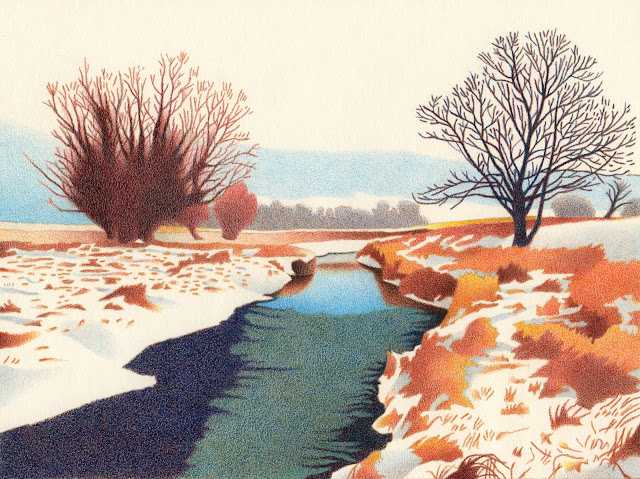 |
| "Dugout Creek" Colored Pencil |
Carved deep into a secluded cattle pasture, Dugout Creek rushes down out of the rugged Sandhills. The shallow stream is cold and blue as it meanders through the vast prairie.
A pair of framework trees creates an informal gateway into a golden grassland. Here and there, drifts of deep snow are defined by soft passages of cerulean blue.
A furious wind blows with blatant disregard while the white sky foretells that more winter weather is on the way. With all of the elements arrived in full force, it's just another winter day in western Nebraska.
San Juan National Forest - A Faraway Land
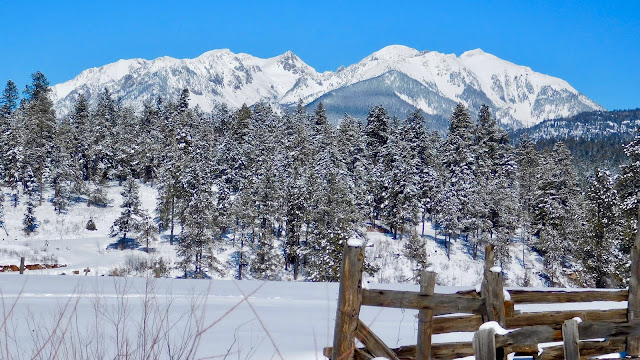 |
| San Juan National Forest |
Sprawling across the southwest corner of Colorado, the San Juan National Forest is a spectacular wilderness. Consumed by severe weather, it's a faraway land featuring towering pine trees and glistening, white peaks.
Buried under a blanket of deep snow, the blue forest is a sleepy dreamland. Still laying low in the cobalt sky, a yellow sun radiates golden rays that warm the frigid landscape.
Bright light comes streaming through the placid interior, creating strange shadows that follow a rugged contour. The wide trail is packed solid, offering evidence that many others have come before me.
This high country embraces the snug comfort of a nice, long winter. Despite the region beginning to wake from hibernation, I find myself mostly alone except for the reassuring company of a pair of fluffed up Stellar's Jays.
 |
| A spectacular wilderness |
 |
| Towering pine trees |
 |
| Glistening white peaks |
 |
| Buried under a blanket of snow |
 |
| A sleepy dreamland |
 |
| The yellow sun radiates golden rays |
 |
| A placid interior |
 |
| Strange shadows |
 |
| A rugged contour |
 |
| Others have come before me |
 |
| High country |
 |
| Snug comfort of a long winter |
 |
| Mostly alone |
 |
| Fluffed Stellar's jays |
Sisters Pass - Perfect Solitude
 |
| Sisters Trail |
West of Evergeen there’s a long ridge of rocky outcrops that divides Dedisse Park from Buffalo Park. The local landmark is known as the Three Sisters because of the prominent spires that rise out of the unique formation.
Scrambling the steep Sisters Trail all the way to the top of the pass is a breathtaking endeavor. During a recent evening-excursion, it was particularly dark and cold as a winter storm was approaching from the west.
Mired in deep snow, the forest was so gloomy that not even the groves of white aspen could brighten the way. Finally above tree line, a panorama of purple mountains and pink skies receded into the distance.
I was expecting to take an ordinary outing so I was surprised to confront such a dramatic twilight. Traipsing around the mountainside after dark is an eerie experience but if you can overcome your apprehension, you’ll discover that a certain solitude found only at night is perfect - just perfect.
 |
| Dedisse Park |
 |
| Scrambling the steep Sisters Trail |
 |
| A winter storm was approaching |
 |
| Mired in deep snow |
 |
| Not even aspen could brighten the way |
 |
| Purple mountains and a pink sky |
 |
| An ordinary outing |
 |
| Dramatic twilight |
 |
| An eerie experience |
 |
| Perfect Solitude |
Genesee Bison Herd - Majestic Animals
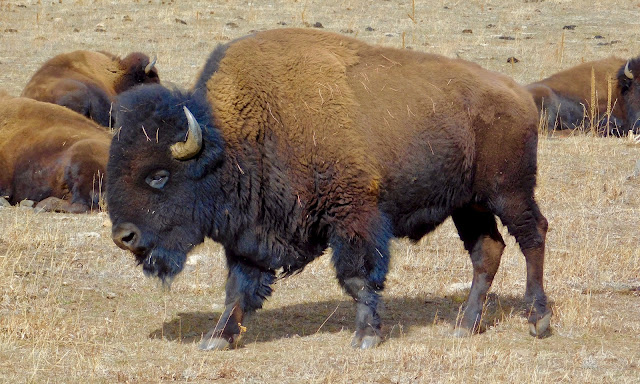 |
| American bison |
There's a new trail in the Front Range foothills tracing the high, chainlink fence that defines the Genesee Park boundary. Every so often, a red danger sign warns the curious visitor to stay back at least ten feet.
Inhabiting this extensive reserve, a herd of scraggly creatures must be contemplated with caution. They appear indifferent at first but an unpredictable charge launched by one of the massive beasts could do some serious damage.
In the year 1800, 35 million buffalo roamed across the vast grasslands of North America. After nearly a century of senseless slaughter committed by commercial hunters, only 500 of these majestic animals remained.
With the disastrous consequences becoming obvious, the resilient survivors were rounded up and placed, mercifully, within the protective confines of the world's first national park - Yellowstone.
At about the same time, Denver was building a series of mountain parks to offer citizens an escape from urban stress. In 1914, the city purchased two bulls and five cows from that beleaguered Wyoming herd and introduced them into the newly created preserve.
Casually grazing just west of town, the Genesee Bison Herd features about 60 purebred descendants of those original seven. It's a privilege to be able to observe, so close to home, such a rare and precious animal.
 |
| An extensive reserve |
 |
| A herd of scraggly creatures |
 |
| They appear indifferent |
 |
| This bull could do some serious damage |
 |
| Millions once roamed the vast grasslands |
 |
| Majestic animals |
 |
| Resilient survivors |
 |
| An escape from urban stress |
 |
| Casually grazing |
 |
| A rare and precious animal |
Blue Friday - A Subtle Thaw
 |
| Blue Friday |
The morning after a dusting of fresh snow, the cold air is filled with an eerie silence. Diffused sunbeams stream through the clearing sky, permeating the forest with an ethereal light.
After slogging through a long week surrounded by a dusky landscape, clouds have parted revealing a blue Friday. It's a wonderful time to be in the mountains enveloped by my favorite color cast.
Swirling, pale pine are scattered throughout the meadow offering a fine foreground below Bergen Peak. The cool tones are usually reserved for a more somber setting but on this day, they express a joyful mood.
A subtle thaw has occurred as songbirds gradually appear and ice-covered lakes start to crack open. Enjoy the white wilderness while you can because the mud season is about to begin.
 |
| Morning after a fresh snow |
 |
| Cold air |
 |
| An eerie silence |
 |
| Sunlight beams through a clearing sky |
 |
| An ethereal light |
 |
| Pale pine are scattered throughout the meadow |
 |
| A fine foreground below Bergen Peak |
 |
| Cool color tones |
 |
| A joyful mood |
 |
| A subtle thaw has occurred |
 |
| Enjoy the white wilderness |
Mule Deer Fawns - Innocent Creatures
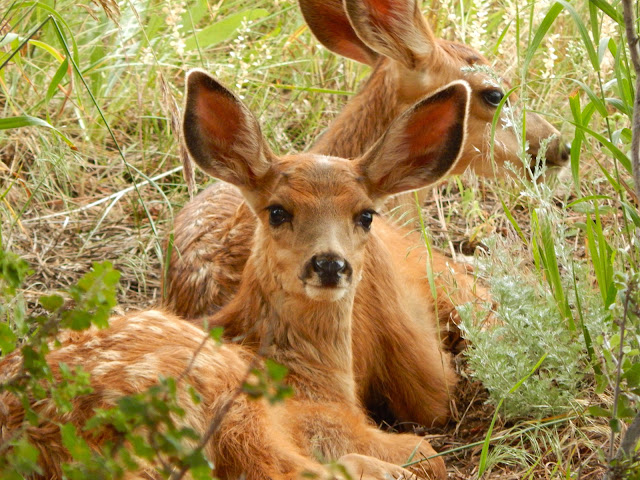 |
| Twin Mule Deer Fawns |
One of the things I love about living in the mountains is observing the abundant wildlife. We routinely see elk and mule deer grazing peacefully around the townsite.
The highlight of every spring is the same, mule deer doe that comes back to the yard and gives birth to twin fawns. They must feel safe in this locale because they stay all summer long.
The fawns are up and moving almost immediately as they follow closely behind their mother. If she leaves the area, the little ones are given strict orders to get down and remain still.
I've seen them lay and remain completely frozen for several hours. When mom returns, the curious fawns pop back up and continue to explore their surroundings.
At such an early age they are extremely vulnerable to numerous predators. Ochre color tones and white spots allow the fawns to blend perfectly into the mountainside.
The tiny creatures seem helpless at first but within a few days they're able to move around very quickly. Just don't let their innocent look fool you.
It won't be long before they're stirring up trouble in the neighborhood - eating flowers, running out in the street and just causing a general ruckus. They kind of remind me of my own, two kids.
 |
| The highlight of every Spring |
 |
| They stay all summer |
 |
| Following mother closely |
 |
| They remain still |
 |
| Exploring their surroundings |
 |
| They are vulnerable |
 |
| Ochre colored with white spots |
 |
| They can move around quickly |
 |
| Not as innocent as they look |
 |
| Causing a general ruckus |
Lake Isabelle Storm - Colored Pencil Drawing
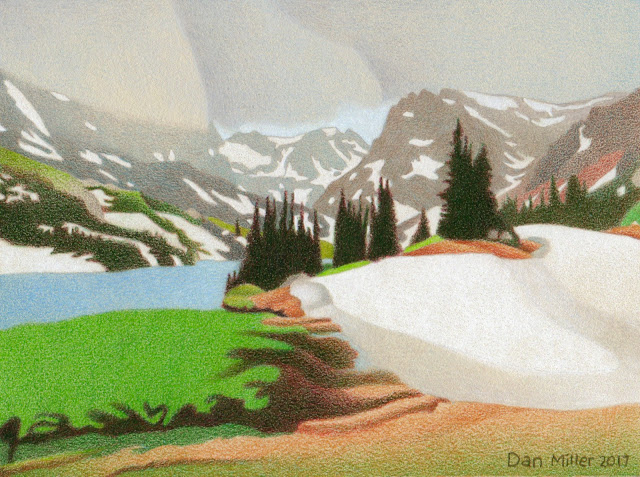 |
| "Lake Isabelle Storm" |
“Through art we can change the world.” ~ #twitterartexhibit
It's springtime in the Rockies as rain clouds rumble across the Great Divide. They descend into an isolated glacial cirque, signaling a soggy afternoon.
Throughout this season of optimism, fresh greenery is revealed during the annual snowmelt. A ring of gray mountains forms an impressive backdrop, looming over the icy reservoir.
The Indian Peaks Wilderness is known for its severe storms, rough trails and natural beauty. Attaining the turquoise tarn named Lake Isabelle can be a struggle, especially during bad weather.
Ascending this steep valley is an unforgettable experience because reaching the remote paradise under such harsh conditions requires great strength and courage.
Things will get tough on the rugged trail so stay positive, have faith that your being guided in the right direction and most importantly - don't give up, don't ever give up.
Lake Isabelle Storm is my contribution to the upcoming Twitter Art Exhibit: UK. This unique event is an international exhibition of original postcard art benefiting Molly Olly's Wishes, supporting children with terminal or life threatening illnesses and their families to help with their emotional wellbeing.
They grant individual wishes to children. This may be in the form of equipment, to help a child with day to day living with their condition, it may be an alternative therapy treatment to compliment traditional medicine, or a special occasion for a child that would otherwise be isolated from everyday events due to the restrictions of their illness.
They are professional and personal and never forget that those they help are going through extremely challenging times. They always strive to be empathetic and compassionate.
All proceeds from sales will support children aged 0-18, and their families, who need additional help to ease the burdens of living with a terminal or life threatening illness.
Twitter Art Exhibit: UK is the seventh installment of this open international exhibition of handmade postcard art for charity, donated by artists from around the world.
Social media plays a major role in Twitter Art Exhibit. It is their intention to tweet, share and promote contributing artists to thank them for their participation, and to make this event a success for all involved.
The event will be highly publicized and well attended by art buyers and enthusiasts, members of the press, local artists and the TAE community.
For more information, please check out this link: #twitterartexhibit
Morning in the Mountains - A Monochrome Monday
 |
| Morning in the mountains |
On a frigid morning in the mountains, the dark landscape is coated with a thin layer of sparkling ice. Tired and cold, it's difficult to get going on such a dreary, winter dawn.
By late January, the Front Range foothills are quiet and colorless. On this day things are different as a large herd of elk have gathered in the monochrome meadow.
Strung out along the crest of a wide ridge, cows, yearlings and bulls forage together in the ochre grass. Patches of broken snowpack slide into the narrow draw below.
After such an unusual weather event, the pure-white Evergreens look like crystallized Christmas Trees. In the low light, their grey shadows stretch across the watery gulch.
It's a melancholy Monday but the morning march is a therapeutic necessity. It looks like it's going to be another hectic few days, working for the weekend.
 |
| A frigid morning |
 |
| The dark landscape is covered with ice |
 |
| A dreary, winter dawn |
 |
| The foothills are quiet and colorless |
 |
| A large herd of elk |
 |
| A monochrome meadow |
 |
| Patches of broken snowpack |
 |
| Crystallized trees |
 |
| A watery gulch |
 |
| A melancholy Monday |
South Table Mountain - The True Frontier
 |
| South Table Mountain |
During a mid-winter morning on South Table Mountain, the treacherous trail was a muddy mess. Unusually tepid temperatures had triggered rapid snowmelt, softening the dark earth.
Rising out of an authentic western town called Golden, Colorado, the natural turret was a lovely landmark. The steep ascent was distinguished by long switchbacks that snaked across a dormant hillside.
Up on a rounded ridge, yellow grasses blew in a soft breeze and contrasted sharply with the clear, blue sky. Easy to imagine I'd stepped back in time, the peaceful approach was a true frontier experience.
Before reaching the top, a maze of rock spires was situated just below the mesa's wide rim. After a wild week of commitments and work, it was nice to find some free time for a warm, winter's day walk.
 |
| A mid-winter morning |
 |
| Golden, Colorado |
 |
| The natural turret is a landmark |
 |
| A dormant hillside |
 |
| A soft breeze |
 |
| A peaceful approach |
 |
| A frontier experience |
 |
| A maze of rock spires |
 |
| A warm, winter walk |
Cold Mountain - A Harsh Wilderness
 |
| Bergen Peak is a cold mountain |
It’s a frigid morning in Evergreen, Colorado and Bergen Peak forms a dark backdrop, brooding over a lonely meadow. A strange ambiance engulfs the landscape as morning light struggles to leak through the dense atmosphere.
Plastered with a coating of fresh snow, the pine trees are glittering white against the windswept grassland. After the frigid sunrise, lemon-colored clouds swirl ominously across the northern sky.
Ascending the icy slopes is a cautious endeavor achieved during the morning’s daybreak silence. The perilous trail leads seductively into a wonderfully crystallized forest.
I have great reverence for the harsh wilderness and I mostly enjoy being out in the thick of this dour season but today I can’t stop shivering as I gaze quietly upon that cold mountain.
 |
| A frigid morning in Evergreen |
 |
| Brooding over a lonely meadow |
 |
| A strange ambiance engulfs the landscape |
 |
| The pine trees are glittering white |
 |
| Yellow clouds swirl ominously |
 |
| Daybreak silence |
 |
| A crystallized forest |
 |
| Great reverence for a harsh wilderness |
 |
| A cold mountain |
Evergreen Mountain Summit - Watercolor
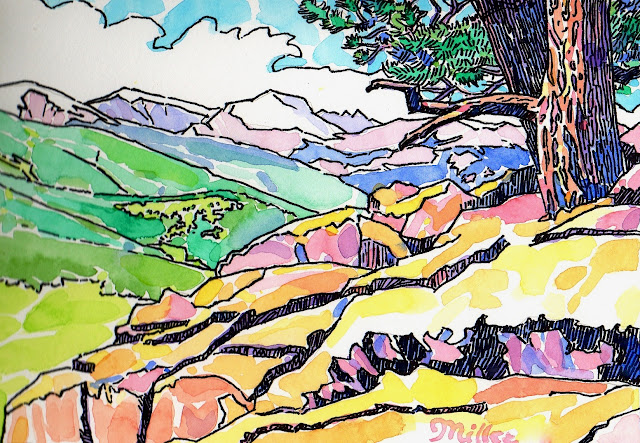 |
| Evergreen Mountain Summit |
It’s an early-summer morning at the summit of Evergreen Mountain and the thin air is clear and crisp. The strokes of pure color brushed loosely onto the page are confined by the black ink that traces the mountain landscape.
The yellow foreground is a jumble of rocks and tundra, gleaming gold in the bright sunlight. Clinging to the treacherous top, a limber pine is a textured tree with needled branches that splay into the brilliant, blue sky.
Across the valley below, Mount Evans Wilderness recedes into the distance through layers of pale green. Strung out across the skyline, a row of mighty peaks are still shimmering white with tons of packed snow.
Currently steeped in the depths of a dark-blue season, only our memories can summon the warmth of those sweet, summer days. With each new dawn, the light is lasting just a little bit longer offering hope that soon we’ll be enjoying nature moments just like this.
Hubbard Mesa - A Surprising Spectacle
 |
| Hubbard Mesa at Rifle, Colorado |
I’ve travelled all over the backroads of Colorado searching for beautiful places to photograph. Earlier this winter, I stumbled upon a remarkable area that really caught my attention.
If you head north out of Rifle, you’ll discover a unique landscape distinguished by enchanting sunsets. My experience below the staggered mesas of that region was nothing short of surreal.
After a gray day shrouded in mist, the clouds began to recede and the sun started to set. Warm tones mingled with cool tones, resulting in a broad spectrum of colorful twilight.
The muddy desert floor was decorated with patches of piñon pine and splashes of blue sagebrush. Up above, the dark peaks were laced with stripes of white snow.
As the curtain of darkness continued to descend, shafts of filtered light permeated the wide valley. The moist atmosphere hung over the canyon, washing it to a glossy sheen.
I was lucky to be rewarded with such a surprising spectacle after wandering into the wilderness that evening. Standing out there during dusk was a moment of solitude I’ll never forget.
 |
| A remarkable area |
 |
| Heading north out of Rifle |
 |
| A unique landscape |
 |
| An enchanting sunset |
 |
| Below staggered mesas |
 |
| The region was surreal |
 |
| The clouds began to recede |
 |
| Warm tones mingled with cool tones |
 |
| A colorful twilight |
 |
| Patches of piñon and sagebrush |
 |
| The canyon was washed clean |
 |
| Light was filtered through the valley |
 |
| A surprising spectacle |
 |
| Wandering into the wilderness |
 |
| An unforgettable moment of solitude |
Dugout Creek - Before and After the Storm
 |
| Dugout Creek, Nebraska |
On the day before the storm, the December weather was unusually warm. Dugout Creek meandered slowly through a golden pasture of prairie grassland.
By late afternoon, the sprawling sandhills were saturated with yellow sunshine. Along the curvy creek bank, a barren forest of twisted trees was glowing orange in the last light.
Just when it was beginning to look like a yellow Christmas, the sky turned ominous, temperatures dropped and a terrible blizzard ensued. The old homestead appeared divine while cloaked in the western Nebraska whiteout.
Morning after the storm and the place was covered with deep snow. The cold water creek was crystal clear as it faithfully reflected a broken blue sky.
After a surprising delay, winter has finally arrived on the Great Plains. The past year has been an unpredictable barrage of challenges and change so it’s nice to see that maybe things are starting to get back to normal.
 |
| The weather was unusually warm |
 |
| The creek meandered slowly |
 |
| Saturated with yellow sunshine |
 |
| Glowing orange in the last light |
 |
| The sky turned ominous |
 |
| Temperatures dropped |
 |
| The old homestead |
 |
| Covered in snow |
 |
| The creek is crystal clear |
 |
| Reflecting a broken blue sky |
 |
| Winter has arrived |
 |
| Maybe things are getting back to normal |
The Eagle River - Absolute Freedom
 |
| Eagle River at Edwards, Colorado |
Emerging out of the lofty Continental Divide, the Eagle River descends freely from the remote rooftop of the Rockies. There are no dams to impede its progress so the wild waterway rushes uninterrupted through Vail Valley’s western slope.
Early Native Americans observed that it had more tributaries than an Eagle has feathers, which is how the river got its appealing name. During the Eagle’s 60 mile journey to its confluence with the Colorado, as the number of tributaries increases so does the river’s size and speed.
I encountered the Eagle River at Edwards, Colorado the morning after a terrific snowstorm. Still dark and blurry under the cover of dense clouds, the vigorous creek wound its way into a black forest of frosted pine trees.
Treading lightly along the frozen riverbank, the thin ice cracked ominously with every footfall. During the dead of winter, the river runs at its shallowest so the rough edges of exposed boulders were softened by caps of fresh snow.
Blanketed in black and white, the Christmas Card setting was therapeutically serene. Just like its namesake nesting in the steep cliffs above, the Eagle River spreads its wings and glides quietly through the landscape, evoking feelings of absolute freedom.
 |
| A wild waterway |
 |
| Vail Valley |
 |
| After a terrific snowstorm |
 |
| Under dense cloud cover |
 |
| Winding through a black forest |
 |
| The river is at its shallowest |
 |
| Exposed boulders softened by snow |
 |
| A Christmas card setting |
 |
| Therapeutically serene |
 |
| Gliding quietly |
 |
| Absolute freedom |
Clearing Storm - A White Wilderness
 |
| A clearing storm |
The morning after a fresh snow, I’m first to enter the white wilderness. Propelled by cautious footsteps, I break a powdery trail through the silver forest.
A sharp breeze sends temperatures plummeting to ten below. My bare hands feel as if they’re frozen solid and my exhaled breath looks like gray smoke.
Around the bend, below a row of bleached aspen, cheerful elk have gathered into an energetic herd. These hardy beasts are built for the cold so they celebrate by bucking, playing and prancing around.
Blue skies begin to show through as the milky sun wrestles with gray clouds. The winner will determine who dominates the local weather forecast.
Winter is a long and difficult season but after the last few days being mired in a gloomy darkness, there’s something comforting about watching a clearing storm.
 |
| The morning after fresh snow |
 |
| A white wilderness |
 |
| A silver forest |
 |
| Temperatures plummet |
 |
| An energetic herd of elk |
 |
| Bucking and prancing around |
 |
| A milky sun and gray clouds |
 |
| Winter is a difficult season |
 |
| Something comforting about a clearing storm |
Silver Fox Trail - An Enchanting Moment
 |
| Silver Fox Trail Sunrise |
It’s a cold, autumn morning at Alderfer Ranch and the landscape is dark and blue. Suddenly, a crack of sunlight streaks across the foothills, permeating the web of tangled tree branches.
Shafts of that persistent light stream through a dense layer of clouds, illuminating the big peaks to the west. Due to the dearth of birds, the eerie silence is a noticeable side-effect of the changing seasons.
Draped over the rugged contour of rocky terrain, long shadows are in pursuit as I hike the Silver Fox Trail. I pass through a dormant grove of wiry aspen, glowing bright white against the dark woodland.
Slivers of low light continue to creep across the meadow until the valley is filled with a comforting warmth. During this first golden hour, fluorescent rays infuse the area with a tinge of orange.
Despite being an industrious night owl, the pre-dawn excursion is worth the chilling discomfort. The November sunrise is an enchanting moment, radiating encouragement and inspiration. It’s time to seize the day.
 |
| The landscape is cold, dark and blue |
 |
| Sunlight streaks across the foothills |
 |
| Shafts of persistent light |
 |
| A dense layer of clouds |
 |
| Big peaks to the west |
 |
| An eerie silence |
 |
| Long shadows pursue the hiker |
 |
| A wiry grove of aspen |
 |
| A dark woodland |
 |
| Slivers of light creep across the meadow |
 |
| Infused with a tinge of orange |
 |
| An enchanting moment |
 |
| Seize the day |
Stellar's Jay Summer - Colored Pencil Drawing
 |
| "Stellar's Jay Summer" Colored Pencil |
Perched within a coniferous forest, a solitary Stellar's Jay contemplates its familiar surroundings. Unassuming and reticent near home, this intelligent bird takes on a much different public persona.
When on the quest for food, it reveals itself by squawking boisterously. Now bold and confident, the Stellar's Jay will bully the smaller birds away from its favorite feeding areas.
This bird can become one of the forest's more raucous, year-round residents. While hiking through its territory, I've often found myself on the receiving end of an unprovoked scolding.
The Stellar’s Jay’s striking appearance reflects its obnoxious behavior. Its blue plumage is accented by dark bars of color, creating an interesting pattern on the wings and tail.
An unkempt tussle of feathers adorns the bird's head. From this distinct crest, a beautiful gradient of indigo blue blends down through the crown and chest into the cerulean coloring of the body.
This Rocky Mountain native shows a great deal of regional variation throughout its range. The jays in our foothills are distinguished by white facial steaks that define the black eyes and beak.
Stellar's Jays have found their niche in the Subalpine zone between 6,000 and 8,000 feet. I frequently see them in the trees on Bergen Peak, especially in the transition area where forest meets meadow.
These birds symbolize intelligence and because it is thought that they mate for life, fidelity. Christian tradition also uses the bird to symbolize the human soul representing joy and goodness.
